
| Homepage > The Work of the Assembly > Committees > Regional Development > Reports > Report on the Department for Regional Development’s Draft Budget 2011-2015 | |||||||||||||||||||||||||||||||||||||||||||||||||||||||||||||||||||||||||||||||||||||||||||||||||||||||||||||||||||||||||||||||||||||||||||||||||||||||||||||||||||||||||||||||||||||||||||||||||||||||||||||||||||||||||||||||||||||||||||||||||||||||||||||||||||||||||||||||||||||||||||||||||||||||||||||||||||||||||||||||||||||||||||||||||||||||||||||||||||||||||||||||||||||||||||||||||||||||||||||||||||||||||||||||||||||||||||||||||||||||||||||||||||||||||||||||||||||||||||||||||||||||||||||||||||||||||||||||||||||||||||||||||||||||||||||||||||||||||||||||||||||||||||||||||||||||||||||||||||||||||||||||||||||||||||||||||||||||||||||||||||||||||||||||||||||||||||||||||||||||||||||||||||||||||||||||||||||||||||||||||||||||||||||||||||||||||||||||||||||||||||||||||||||||||||||||||||||||||||||||||||||||||||||||||||||||||||||||||||||||||||||||||||||||||||||||||||||||||||||||||||||||||||||||||||||||||||||||||||||||||||||||||||||||||||||||||||||||||||||||||||||||||||||||||||||||||||||||||||||||
|
|||||||||||||||||||||||||||||||||||||||||||||||||||||||||||||||||||||||||||||||||||||||||||||||||||||||||||||||||||||||||||||||||||||||||||||||||||||||||||||||||||||||||||||||||||||||||||||||||||||||||||||||||||||||||||||||||||||||||||||||||||||||||||||||||||||||||||||||||||||||||||||||||||||||||||||||||||||||||||||||||||||||||||||||||||||||||||||||||||||||||||||||||||||||||||||||||||||||||||||||||||||||||||||||||||||||||||||||||||||||||||||||||||||||||||||||||||||||||||||||||||||||||||||||||||||||||||||||||||||||||||||||||||||||||||||||||||||||||||||||||||||||||||||||||||||||||||||||||||||||||||||||||||||||||||||||||||||||||||||||||||||||||||||||||||||||||||||||||||||||||||||||||||||||||||||||||||||||||||||||||||||||||||||||||||||||||||||||||||||||||||||||||||||||||||||||||||||||||||||||||||||||||||||||||||||||||||||||||||||||||||||||||||||||||||||||||||||||||||||||||||||||||||||||||||||||||||||||||||||||||||||||||||||||||||||||||||||||||||||||||||||||||||||||||||||||||||||||||||||||
| PC 10 Final Determination (PE terms) | Budget 2007/ Draft Budget 2010 | Difference | Difference | |
|---|---|---|---|---|
| £m | £m | £m | % | |
2010/11 |
194.2 |
201.00 |
7.7 |
4.0% |
2011/12 |
188.4 |
202.00 |
14.1 |
7.5% |
2012/13 |
195.9 |
145.0 |
-50.9 |
-26.0% |
PC10 Total |
578.5 |
549.0 |
-29.1 |
-5.0% |
2013/14 |
-- |
140.0 |
-- |
-- |
2014/15 |
-- |
180.0 |
-- |
-- |
Draft Budget Total |
667.5 |
-- |
-- |
Source: Letter from NIAUR, 26 January 2011 and DALO 489 12 January 2011.
33. The Committee notes that in year one of the Draft Budget (year two of the PC10 period) there is an indicative capital investment allocation some 7.5% in excess of the level recommended in the agreed PC10 determination, however this is followed by an allocation which is £50million (26%) lower than the level agreed in PC10. Members recognise the constraints facing Northern Ireland Water, particularly in the current economic climate, however they were concerned about the impact this may have on Northern Ireland Water’s ability to deliver the investment in infrastructure which was agreed as necessary during the PC10 process.
34. Looking at the profile of capital expenditure for water and sewerage services in the Draft Budget, it begins at a level, has a significant dip in years two and three, and increases again in year four. This “u-shape" profile is the opposite of what might be expected for relatively large scale infrastructure investment programmes carried out over a number of years. In profile, such projects tend to have lower expenditures in the early years, with an expenditure peak at the mid-point and slightly beyond (an “inverted u-shape").
35. Briefing from the Utility Regulator identifies the potential implications of the Draft Budget profile for capital expenditure in Northern Ireland Water (NIW) as:
36. Members wish to highlight the factors driving the need for capital investment in NIW.
| % Capital Investment | Driven by: |
|---|---|
44.4% |
Need to maintain the asset base and sustain current level of performance and service. |
29.3% |
Need to meet quality compliance / EU directives |
18.9% |
Need to facilitate growth or development needs |
7.3% |
Enhancing the level of performance |
Source: Letter from NIAUR, 26 January 2011
37. The Committee understands that work is ongoing to identify and investigate options for re-profiling the capital investment programme, however Members are concerned. As can be seen above, the majority of capital investment, almost 74% is driven by the need to maintain current levels of service and performance and to meet compliance standards. A reduction of 26% in the level of capital investment in year two, with a further reduction in year three of the Draft Budget period, cannot but have an impact on the levels of service and compliance currently provided by NIW. There could be little or no room for service or performance improvements or development over the coming years.
38. Again, the Committee hopes to explore this issue with the Department the budget period.
39. The Committee heard from representatives of Belfast Harbour on the inclusion in the Department’s spending and saving proposals of revenue of £15m in year three and £15m in year four of the Draft Budget period. In correspondence, noted at the Committee meeting of 16 February 2011, clarification was provided by the Department on how this element was incorporated into the Department’s draft budget allocation. This letter states that the £30m was reflected in the DRD Draft Budget allocation arising from “a commitment given by the DRD Minister to the Finance Minister on 14 December 2010 that he was recommending changes to the current Ports legislation to allow the Executive to introduce an additional funding stream on up to £125 million over the budget period; and that this would also allow for an ongoing dividend from the Ports."
40. The Committee is disappointed that this was not made clear in the briefings provided to the Committee on the Department’s spending and saving proposals, particularly as it had taken a keen interest in the development of ports legislation. The Committee also understood that the Minister had withdrawn the legislation on Ports Policy from the legislative programme, in June 2010, and was not aware that other changes to ports legislation were being considered.
41. The Committee held a stakeholder engagement event on Wednesday 26 January 2011 on the impact of the Department’s spending and savings delivery plans. Whilst the Committee has not had a chance to consider the feedback received during this event in detail, the following paragraphs are not exhaustive but they provide a flavour of the contributions made during the event. These are organised under the headings of social, economic and environmental impacts, however the Committee is keenly aware that these are interlinked and cross-cutting categories.
42. There was a significant amount of discussion of the social impacts of the Department’s spending and savings delivery plans. Contributions were received from organisations that included the Consumer Council, the Community Transport Association (CTA), Disability Action, the Inclusive Mobility Transport Advisory Committee (IMTAC), Shopmobility, and Translink.
43. There was agreement among many of the stakeholders at the Committee’s event that the proposals in the Department’s spending and savings delivery plans would have a disproportionately negative impact on older people, people with disabilities, and people reliant on public transport, especially in rural areas.
44. The Committee heard from IMTAC that restrictions in the door-to-door service to core hours will limit the ability of older people and people with disabilities to go out in the evening and at weekends: an impact also identified by Disability Action. IMTAC stated that the combination of measures in the draft budget proposals will limit Shopmobility schemes; reduce support for rural and group travel schemes; reduce subsidy for rural public transport; reduce the number of Rural Community Transport Partnerships; and reduce the level of subsidy to Translink. The cumulative impact of these proposals will be to reduce the supports available to many vulnerable people, and in IMTAC’s view this will cause social exclusion, isolate many people in their homes and reverse the dramatic progress Northern Ireland has made in the past 15-20 years for disabled people, young people, older people and those who have no access to a car.
45. The CTA was also of the view that reductions in the rural transport fund and transport programme for people with disabilities will have significant impact on communities by 2015, with increased problems in terms of rural isolation, exclusion and access for the most vulnerable in society. Reductions in the Rural Community Transport Network would mean that 25%-30% of people in rural areas will not be able to access transport solutions, CTA said.
46. CTA also stressed the need to consider the linkages between community transport provision and reductions to Translink’s budget. The impact of potential reductions in rural routes and service frequencies, together with the possibility of increasing fares, will place further pressures on community transport to deliver the alternative access solution.
47. The impact on those older people, people with disabilities, people with mobility difficulties and their families, arising from the proposed reductions in support for Shopmobility schemes was also discussed. Shopmobility highlighted its success in generating much of its own funding, and emphasised that the trips taken as a result of Shopmobility schemes put money back into the economy. This local economic benefit would be lost, as well as the obvious benefits to the vulnerable members of society who make use of the schemes, should the proposals go ahead as they currently stand.
48. IMTAC stated that millions of pounds have been spent in the past on providing accessible public transport infrastructure, but this will be lost if people cannot get to the public transport network to use the accessible buses and trains. IMTAC called for a creative re-examination of alternative approaches based on evidence of usage patterns, rather than an across the board approach. The CTA was of the view that transport should receive priority if further monies became available during the budget period. It also highlighted the need to look for joined-up solutions, to share costs and savings across departments including health and education.
49. Translink made a number of points on the social impacts of the spending and savings proposals. It stressed that it wanted to minimise any negative impacts in terms of services and jobs. In contributions, Translink stressed it was cognisant of its social and sustainability objectives and the need to provide for the travel requirements of older people, people with disabilities and those living in rural communities – at an individual level and also at a community level.
50. Translink stated that it was trying to protect the geographical coverage of the network as far as possible and indicated that connectivity and integration were important considerations. As it makes changes, it has to ensure that people still have access and connections to the main network. However, Translink explained that it was duty bound to examine the poorest performing parts of the network and that, ultimately, is down to passenger numbers, services that are unnecessary or those that can be covered through a combination of other services. It also stated that it would be looking at parts of the network where it thought services could be improved or enhanced to grow passenger numbers.
51. NILGA welcomes proposals to secure a better deal for the supply of street lighting energy but was very concerned to note that one of the contingencies, if this doesn’t happen, is dimming or removal of street lights or introducing shorter burning hours. In NILGLA’s view, there is a paradox in this proposal in terms of DRD’s commitment to contributing to the health and well being of the community. Better street lighting helps improve road safety, as well as reducing crime and the fear of crime. It also helps to create happy and healthier communities by promoting social inclusion and sustainable transport patterns by encouraging people to walk or cycle.
52. Again, there was wide ranging discussion on the economic impacts of the Department’s spending and savings proposals. The Confederation of British Industry (CBI), the Quarry Products Association Northern Ireland (QPANI), the Federation of Small Businesses (FSB), the Northern Ireland Local Government Association (NILGA) and the Freight Transport Association (FTA) all made contributions on this aspect of the Draft Budget proposals.
53. CBI welcomed the broad approach taken and the investment commitment set out in the Draft Budget. Continuing to invest in the strategic road network and public transport are high priorities for the CBI, and it supports the schemes to upgrade the A5 and A8. QPANI also welcomed the commitment to capital spending on the A5 and A8. However, it was of the opinion that if the contribution from the Republic of Ireland government was not forthcoming following the general election, that the planned capital allocations in DRD’s budget should be reallocated to strategic programmes and schemes across Northern Ireland that will positively maximise the impact on jobs.
54. CBI expressed its disappointment that other key roads, which it saw as priority schemes, particularly the A6 Randalstown-Castledawson and the York Street flyover, were not to proceed.
55. CBI welcomed the commitments to proceed with investment in transport, including Rapid Transit, but sought clarification on the need for another train maintenance facility. Translink provided clarification on this issue, stating that the need for a new train maintenance facility is a reflection of the substantial increase in the capacity of the railways as the new trains are brought in. Maintenance is required to optimise that additional rail capacity and to physically maintain the trains.
56. The FTA highlighted the importance of freight to the economy. It stated that freight deliveries must be cost efficient as margins are low and times are hard for business. The freight industry needs to work smarter to make best use of its existing assets, and with high fuel costs, a good infrastructure is a key requirement for the FTA’s members to meet their goals but also to encourage inward investment to Northern Ireland.
57. By way of example, the FTA identified that Belfast Harbour handles 60% of seaborne trade. Congestion on the roads serving that hub needs to be addressed and fixed quickly. In its view, proposals for Belfast on the move and rapid transit would reduce lane space and would force traffic out onto the Westlink. In its view, the York Street flyover and the Westlink junction were priorities for action to improve inward investment, improve journey times, reduce congestion and to improve air quality in that area. Briefly, the FTA welcomed the work proposed for the A8, highlighted the very heavy daily traffic on the A6/ M22, the need to dual the M1/A1 at Sprucefield to accommodate the 42,000 vehicles travelling daily into Belfast, and questioned the daily vehicle numbers (13,500) on the A5 relative to the cost of the scheme proposed for that route.
58. On the issue of the savings delivery plans, QPANI welcomes a more focused approach on minor maintenance activities and would suggest that many maintenance activities should be outsourced to the private sector. QPANI also welcomed the rationalisation of Roads Service depots and section offices and would urge Roads Service to continue to identify opportunities for savings that can be delivered to front line services.
59. FSB expressed its disappointment that options, such as privatisation, were not considered. In its view, this limited the discussion and the scope for going forward, not least because in its absence there would have to be a myriad of ways of raising revenue throughout the economy. Its concern was that these other revenue raising options would effectively add stealth charges to the cost of living and doing business in Northern Ireland, whilst ignoring one of the key ways that the gap in funding could have been closed. FSB also encouraged more innovative thinking about how our existing infrastructure is used, such as using technology for reversing the direction of roads at certain times of the day so as to make better use of the existing infrastructure.
60. The CBI stated that the savings identified in the Department’s consultation document have been set out in detail. In its view, a number of these will clearly impact on service provision but from a broad strategic economic perspective, it did not believe that any of them would undermine economic recovery.
61. It did, however, express its surprise that in a key area such as delivering savings, it could see no evidence of administrative savings being identified or prioritised by the Department or of how DRD will improve its productivity and manage its pay bill over the budget period. Neither could it see proposals for what, in its view, would be ambitious reforms such as process reengineering or outsourcing. It was disappointed at proposals to transfer £6m from capital to revenue funding and challenged this move asking why administrative savings were not looked for instead.
62. FSB questioned how planned increases in parking charges would fit with the Department for Social Development’s plans for town centre regeneration. From the FSB point of view, the two do not appear to mesh cohesively. On a related point, NILGA was of the view that on-street car parking charges could potentially increase illegal parking in towns which would exacerbate town centre congestion. This would put people off shopping in towns and would encourage the use of out-of-town shopping outlets where parking is free. NILGA stated that local businesses need as much help as they can get if they are going to survive the current economic difficulties. In contrast, CBI was of the view that proposals to raise revenue from increased car parking charges were proportionate and sensible.
63. Opinion was somewhat varied on the issue of raising revenue from Belfast Harbour. FSB had concerns over the taking of a dividend from the port in terms of the cost of doing business and its impact on both importing and exporting costs. QPANI welcomed the proposed release of £15 million for two years from Belfast Harbour, and CBI welcomed this approach to revenue raising as proportionate and sensible.
64. Investment in water and sewerage services also arose during a number of contributions to the Committee’s draft budget event. For the CBI, it was vital that we continue to invest in water and sewerage services at a high level, and it was concerned that allocations in years two and three of the budget were below those recommended in the PC10 final determination. Concerns in relation to the allocations below those set out in PC10 were also identified by the Consumer Council. QPANI also underlined the need for continued investment in the water and sewerage network in order to comply with European quality standards and to ensure that the network can cope with severe winter weather. In its contribution, CBI expressed the view that deferring water and sewerage charges was making funding more difficult, not just for transport and water and sewerage infrastructure, but also for the broader package. QPANI also called for the reintroduction of water charges to pay for our water and sewerage services network.
65. For the FSB, infrastructure is one of the keys to businesses leading the economic recovery, not just the infrastructure itself but the perception of the quality and reliability of the infrastructure. In its view, recent problems with water sent a very poor signal to investors and damaged consumer confidence.
66. NILGA also expressed concerns that the planned reduction in subsidy to the Rathlin Ferry Service would increase costs for islanders and have a negative impact on tourism in the area.
67. In response to a comment from the Chairperson that the Committee’s concern was to take cars off the roads, and that there were no incentives in the budget to do this, Translink stated that the solution lay in integrated travel solutions that are attractive, sustainable and good value, but that sustainability was key.
68. The Consumer Council shared the view that there was little in the budget to create a modal shift from car to public transport, and in many ways it goes against what consumer research demonstrated consumers wanted from public transport, which was value for money, more frequent services and a wider network.
69. The Consumer Council also stressed that in many areas of Northern Ireland the choice to use public transport as a more sustainable travel option was not available. Its contribution reflected that ambitious plans and strategies are in place to support public transport, cycling and walking but these are often lost when it comes to delivery. By way of example, it was stated that the Regional Transportation Strategy (RTS) in 2002 suggested a spending ratio for roads to public transport (including walking and cycling) of 65% and 35%, and that this has never been achieved. In addition, there is a very strong sustainability message throughout the revised RDS but it will be very difficult to achieve this and the modal shift, against the backdrop of this budget. The funding profile for rapid transit, and other reductions in investment in integrated transport, means that the traffic management improvements identified in the Belfast on the move initiative may not be optimised.
70. The Consumer Council identified that the Enterprise service is also likely to be affected as there will be speed restrictions on the line, again providing more encouragement to move away from public transport and into the car.
71. QPANI recognised and supported the need to reduce carbon emissions but argued that it is not roads that create carbon emissions, but the vehicles using then. It does not believe that Northern Ireland has the population to support and finance a profitable and efficient train network but was of the view that a well funded, bus-based park and ride, integrated public transport network fuelled on low carbon fuels was the solution to sustainable transport. QPANI expressed its support for rapid transit for Belfast and government incentives to encourage the use of low carbon fuels. QPANI also stressed that it had made representations to Roads Service on the need to look to lower carbon products, and that some progress had been achieved with more sustainable bitumen products and processes. On balance, QPANI did not think that sustainability would be achieved because of constraints on the budget, but that a balance needed to be struck. QPANI expressed the view that the economy needs to be prioritised because the only way we can be in a position to offer better services in the future is by increasing the tax take from the economy and growing the private sector.
72. The CBI view was that sustainability clearly covers economic, social and environmental issues. CBI welcomed the investment in the rapid transit system and believes it will help achieve the modal shift in transport. It was CBI’s view that the focus of public transport should be on the high traffic volume routes, and on building on the investment made in recent years in the Metro service to improve connectivity.
73. Addressing congestion through investment in roads projects was also identified by the CBI and the M22 at Castledawson was identified as a priority. The FTA also identified the junction at Dee Street, Belfast, as an example of where relatively small changes in the roundabout could ease congestion and thus address air quality and particulates levels.
74. In its contribution, Sustrans stated that congestion only accounts for one third of transport costs, and that it is important to factor in the longer term environmental and health benefits of more active travel patterns. It pointed out that a cost benefits analysis shows that money spent on infrastructure for active travel delivers gains in excess of those delivered by building roads. Sustrans asked that the Draft Budget re-examines the safety measures that benefit children, the impact on people that do not have access to a car, and more environmentally sustainable modes of travel. It points out that in this version of the budget road safety, traffic calming, pedestrian and cycling measures are, in its view, virtually eliminated and suggests that there is a need to get the balance back whereby we incorporate active travel into the budget and look to the benefits that arise from active travel.
75. The Committee’s views on the importance of securing adequate funding for structural maintenance are well known and rehearsed. Indeed, the Committee has expressed its support for funding for structural maintenance in monitoring rounds and in debates on budget bills and draft budgets since the beginning of this mandate. However, Members wish to take this opportunity to underline the contribution to economic competitiveness, value for money and road safety arguments for providing adequate funding for structural maintenance.
76. In terms of stakeholder comments, QPANI highlighted the importance of investment in structural maintenance, given the current condition of the roads network and the additional damage that has been done over the past two years with the severe winter weather. It welcomes the allocation of £94m in the first year for structural maintenance, and points out that this allocation will sustain 1,200 jobs in the construction industry. However QPANI considers this allocation to be a way short of what the Snaith Report established was required on an annual basis, which estimates that £112m per annum was the amount needed. Over the four years of the budget period, there will be a shortfall of £168m against the funding recommended in that report, which will further add to the backlog in investment in this vital area. QPANI also pointed out that the £94m allocation in year one will not have the same purchasing power as in other years because of increasing fuel and bitumen costs, and the impact of the loss of the aggregates levy.
77. NILGA stressed the longer term value for money implications of failing to deliver adequate structural maintenance as filling pot holes is costly compared to a planned preventative maintenance programme.
78. Representatives from NILGA highlighted the following points as being of particular relevance for local government. NILGA was concerned about the negative impact reductions in maintenance activities will have on local government and the possible impact on rate payers. Reduction in maintenance and gully emptying budgets could exacerbate the problem of localised flooding after heavy downpours. It was also concerned that hidden costs were being passed to councils. DRD proposed reduced frequency of grass cutting, weed killing and litter picking: these services are currently augmented by local councils. However the reductions in these activities by DRD are likely to lead to councils having to pay for this. The issue of salting footpaths was also mentioned. NILGA stated that concerns remained over resources, liabilities, and indemnities however options for a more acceptable long-term solution are currently being explored.
[1] Research and Library Service Briefing Note, 17 January 2011 Draft Budget 2010: DRD Spending Proposals
[2] Letter from NIAUR, 26 January 2011.
Introduction
Draft Budget 2011-15: Spending and Saving Proposals within the Department for Regional Development:
Issues of Concern to the Committee for Regional Development
Draft Budget 2011-15: Spending and Saving Proposals within the Department for Regional Development:
Issues of Concern to the Committee for Regional Development
Draft Budget 2011-15: Spending and Saving Proposals within the Department for Regional Development:
Issues of Concern to the Committee for Regional Development
Engagement with stakeholders on the impact of the Department’s spending and savings delivery plans
Engagement with stakeholders on the impact of the Department’s spending and savings delivery plans
Engagement with stakeholders on the impact of the Department’s spending and savings delivery plans
Present: Michelle McIlveen MLA (Deputy Chairperson)
Cathal Boylan MLA
Willie Clarke MLA
Danny Kinahan MLA
Billy Leonard MLA
Ian McCrea MLA
Conall McDevitt MLA
In Attendance: Roisin Kelly (Assembly Clerk)
Trevor Allen (Assistant Assembly Clerk)
Tara McKee (Clerical Supervisor)
Alison Ferguson (Clerical Officer)
Apologies: Fred Cobain MLA (Chairperson)
Allan Bresland MLA
Trevor Lunn MLA
George Robinson MLA
10.38am The meeting commenced in open session.
The Committee received briefing from Departmental officials, Nigel McCormick and Roger Downey, and from Roads Service officials, Dr Andrew Murray and Terry Deehan, on the Department’s Revised Expenditure Plans for 2010-2011.
Agreed: Members noted a report of the Northern Ireland Audit Office in relation to improving public sector efficiency and agree to defer consideration of the report to the Committee meeting on 30 June 2010.
Agreed: The Committee agreed to request additional information from the Department for Regional Development on the Budget 2010 timetable and process; to schedule an additional briefing on the issue on 30 June 2010; and to consider, if necessary, convening an additional meeting of the Committee in July, prior to the deadline for receipt of Departmental responses by the Department of Finance and Personnel.
1.04pm The Deputy Chairperson adjourned the meeting.
[EXTRACT]
Present: Michelle McIlveen MLA (Deputy Chairperson)
Willie Clarke MLA
Danny Kinahan MLA
Billy Leonard MLA
Conall McDevitt MLA
George Robinson MLA
In Attendance: Roisin Kelly (Assembly Clerk)
Trevor Allen (Assistant Assembly Clerk)
Andrew Larmour (Clerical Supervisor)
Alison Ferguson (Clerical Officer)
Apologies: Fred Cobain MLA (Chairperson)
Cathal Boylan MLA
Allan Bresland MLA
Trevor Lunn MLA
Ian McCrea MLA
10.44am The meeting commenced in open session.
Agreed: Members considered correspondence from the Department in relation to this issue and agreed to review additional information from the Department as received during July and to schedule a meeting during summer recess to address the issue, if Members consider it necessary. Members also agreed to convene an additional meeting of the Committee on 7 September 2010 to consider the Committee’s response to the Minister on this issue.
1.23pm The Deputy Chairperson adjourned the meeting.
[EXTRACT]
Present: Michelle McIlveen MLA (Deputy Chairperson)
Cathal Boylan MLA
Allan Bresland MLA
Willie Clarke MLA
Danny Kinahan MLA
Trevor Lunn MLA
Conall McDevitt MLA
George Robinson MLA
In Attendance: Roisin Kelly (Assembly Clerk)
Trevor Allen (Assistant Assembly Clerk)
Andrew Larmour (Clerical Supervisor)
Alison Ferguson (Clerical Officer)
Apologies: Fred Cobain MLA (Chairperson)
Billy Leonard MLA
Ian McCrea MLA
10.14am The meeting commenced in public session.
The Committee received briefing from Departmental officials, Nigel McCormick, Roger Downey, Stewart Barnes and Terry Deehan, in relation to bids and proposed savings delivery plans for Budget 2010.
Agreed: The Committee agreed to consider the requirement for further briefing on this issue at the meeting of 8 September.
Agreed: Members agreed to consider proposals, at the meeting of 8 September 2010, for a stakeholder engagement event in relation to the Budget 2010 process.
2.53pm The Deputy Chairperson adjourned the meeting.
[EXTRACT]
Present: Fred Cobain MLA (Chairperson)
Michelle McIlveen MLA (Deputy Chairperson)
Cathal Boylan MLA
Danny Kinahan MLA
Billy Leonard MLA
Trevor Lunn MLA
Ian McCrea MLA
Conall McDevitt MLA
George Robinson MLA
In Attendance: Roisin Kelly (Assembly Clerk)
Trevor Allen (Assistant Assembly Clerk)
Andrew Larmour (Clerical Supervisor)
Alison Ferguson (Clerical Officer)
Apologies: Allan Bresland MLA
Willie Clarke MLA
10.38am The meeting commenced in open session.
Agreed: Members noted a paper from the Committee office outlining proposals for the Committee’s stakeholder evidence event on Budget 2010 and agreed to defer further consideration of the issue to the meeting of 15 September 2010.
12.38pm The Chairperson adjourned the meeting.
[EXTRACT]
Present: Fred Cobain MLA (Chairperson)
Michelle McIlveen MLA (Deputy Chairperson)
Cathal Boylan MLA
Allan Bresland MLA
Danny Kinahan MLA
Billy Leonard MLA
Trevor Lunn MLA
Fra McCann MLA
Ian McCrea MLA
Conall McDevitt MLA
George Robinson MLA
In Attendance: Roisin Kelly (Assembly Clerk)
Trevor Allen (Assistant Assembly Clerk)
Andrew Larmour (Clerical Supervisor)
Alison Ferguson (Clerical Officer)
Apologies: None.
10.43am The meeting commenced in open session.
Agreed: The Committee noted correspondence from the Department for Regional Development in relation to Budget 2010 and agreed to write to the Department in relation to issues raised.
Agreed: The Committee noted the response to the Comprehensive Spending Review (CSR) process from Action for Children Northern Ireland and agreed to consider this response as part of the Committee’s consideration of Budget 2010.
12.47pm The Chairperson adjourned the meeting.
[EXTRACT]
Present: Fred Cobain MLA (Chairperson)
Michelle McIlveen MLA (Deputy Chairperson)
Billy Armstrong MLA
Cathal Boylan MLA
Allan Bresland MLA
Billy Leonard MLA
Fra McCann MLA
Ian McCrea MLA
Conall McDevitt MLA
In Attendance: Roisin Kelly (Assembly Clerk)
Trevor Allen (Assistant Assembly Clerk)
Andrew Larmour (Clerical Supervisor)
Alison Ferguson (Clerical Officer)
Apologies: Trevor Lunn MLA
George Robinson MLA
10.33am The meeting commenced in open session.
Members noted correspondence from the Department for Regional Development, dated 11 October 2010, in relation to Budget 2010 spending priorities.
Members noted correspondence from the Department for Regional Development, dated 25 October 2010, on the implications of the spending review on the Department’s budget.
1.04pm The Chairperson adjourned the meeting.
[EXTRACT]
Present: Fred Cobain MLA (Chairperson)
Michelle McIlveen MLA (Deputy Chairperson)
Cathal Boylan MLA
Allan Bresland MLA
Billy Leonard MLA
Trevor Lunn MLA
Fra McCann MLA
Ian McCrea MLA
Conall McDevitt MLA
George Robinson MLA
In Attendance: Roisin Kelly (Assembly Clerk)
Trevor Allen (Assistant Assembly Clerk)
Andrew Larmour (Clerical Supervisor)
Alison Ferguson (Clerical Officer)
Apologies: Billy Armstrong MLA
10.45am The meeting commenced in open session.
Members noted correspondence from the Committee for Finance and Personnel regarding the outcome of the UK Spending Review Budget 2011-2015.
1.03pm The Chairperson adjourned the meeting.
[EXTRACT]
Present: Fred Cobain MLA (Chairperson)
Michelle McIlveen MLA (Deputy Chairperson)
Billy Armstrong MLA
Cathal Boylan MLA
Allan Bresland MLA
Billy Leonard MLA
Anna Lo MLA
Fra McCann MLA
Conall McDevitt MLA
George Robinson MLA
In Attendance: Roisin Kelly (Assembly Clerk)
Trevor Allen (Assistant Assembly Clerk)
Andrew Larmour (Clerical Supervisor)
Alison Ferguson (Clerical Officer)
Apologies: Ian McCrea MLA
10.37am The meeting commenced in open session.
Members noted correspondence from the Committee for Finance and Personnel in relation to Ministerial correspondence on the draft Budget 2011-15.
Agreed: Members noted correspondence from the Finance and Personnel Committee on the Confederation of British Industry’s (CBI) revenue raising proposals and agreed to consider the correspondence as part of the Committee’s work on Budget 2010.
Agreed: Members noted correspondence from Sustrans on priorities for transport elements of the budget and agreed to consider the correspondence as part of the Committee’s work on Budget 2010.
11.53pm The Chairperson adjourned the meeting.
[EXTRACT]
Present: Fred Cobain MLA (Chairperson)
Michelle McIlveen MLA (Deputy Chairperson)
Allan Bresland MLA
Billy Leonard MLA
Conall McDevitt MLA
In Attendance: Roisin Kelly (Assembly Clerk)
Trevor Allen (Assistant Assembly Clerk)
Andrew Larmour (Clerical Supervisor)
Alison Ferguson (Clerical Officer)
Apologies: Billy Armstrong MLA
Cathal Boylan MLA
Anna Lo MLA
Fra McCann MLA
Ian McCrea MLA
George Robinson MLA
9.35am The meeting commenced in open session.
Agreed: The Committee agreed to schedule briefings on 12 January 2011 from key stakeholders on the Executive’s draft Budget. The Committee also agreed to request a paper from Assembly Research Service on the content of the draft Budget and its implications for the work of the Department for Regional Development.
9.58am The Chairperson adjourned the meeting.
[EXTRACT]
Present: Fred Cobain MLA (Chairperson)
Michelle McIlveen MLA (Deputy Chairperson)
Billy Armstrong MLA
Cathal Boylan MLA
Allan Bresland MLA
Billy Leonard MLA
Anna Lo MLA
Fra McCann MLA
Ian McCrea MLA
Conall McDevitt MLA
George Robinson MLA
In Attendance: Roisin Kelly (Assembly Clerk)
Trevor Allen (Assistant Assembly Clerk)
Andrew Larmour (Clerical Supervisor)
Alison Ferguson (Clerical Officer)
10.50am The meeting commenced in open session.
Agreed: The Committee considered and agreed correspondence to the Finance and Personnel Committee requesting an extension to its deadline for receipt of submissions from Statutory Committees on the Executive’s Draft Budget 2011-15. The Committee also agreed to postpone its stakeholder evidence gathering event, scheduled for 12 January 2011, on the Draft Budget.
1.44pm The Chairperson adjourned the meeting.
[EXTRACT]
Present: Fred Cobain MLA (Chairperson)
Michelle McIlveen MLA (Deputy Chairperson)
Billy Armstrong MLA
Cathal Boylan MLA
Allan Bresland MLA
Billy Leonard MLA
Anna Lo MLA
Fra McCann MLA
Conall McDevitt MLA
George Robinson MLA
In Attendance: Roisin Kelly (Assembly Clerk)
Trevor Allen (Assistant Assembly Clerk)
Andrew Larmour (Clerical Supervisor)
Alison Ferguson (Clerical Officer)
Apologies: Ian McCrea MLA
10.09am The meeting commenced in open session.
Agreed: The Committee noted a statement from the Utility Regulator in relation to Northern Ireland Water’s acceptance of the PC10 determination and agreed to consider the statement as part of the Committee’s consideration of Budget proposals.
Response to the Finance and Personnel Committee on the Draft Budget
Agreed: The Committee agreed to write to the Speaker to highlight the continued pressure on committees’ time to scrutinise Departmental budget proposals and to provide submissions to the Committee for Finance and Personnel.
12.54pm The Chairperson adjourned the meeting.
[EXTRACT]
Present: Fred Cobain MLA (Chairperson)
Michelle McIlveen MLA (Deputy Chairperson)
Billy Armstrong MLA
Allan Bresland MLA
Billy Leonard MLA
Anna Lo MLA
Fra McCann MLA
Conall McDevitt MLA
George Robinson MLA
In Attendance: Roisin Kelly (Assembly Clerk)
Trevor Allen (Assistant Assembly Clerk)
Andrew Larmour (Clerical Supervisor)
Alison Ferguson (Clerical Officer)
Apologies: Cathal Boylan MLA
Ian McCrea MLA
10.04am The meeting commenced in closed session.
The Committee received a briefing from Assembly Research and Library Service analysing the Department for Regional Development’s Draft Budget position.
Following the briefing, the Committee continued its consideration of the Department’s Draft Budget proposals.
Agreed: The Committee agreed to schedule evidence sessions from key stakeholder organisations on the Draft Budget for 26 January 2011.
Agreed: The Committee agreed to schedule an additional meeting, to agree its response on the Draft Budget to the Finance and Personnel Committee, on Thursday 27 January 2011.
10.52am The Chairperson adjourned the meeting.
[EXTRACT]
Present: Fred Cobain MLA (Chairperson)
Michelle McIlveen MLA (Deputy Chairperson)
Billy Armstrong MLA
Cathal Boylan MLA
Allan Bresland MLA
Billy Leonard MLA
Anna Lo MLAIan McCrea MLA
Conall McDevitt MLA
George Robinson MLA
In Attendance: Roisin Kelly (Assembly Clerk)
Trevor Allen (Assistant Assembly Clerk)
Andrew Larmour (Clerical Supervisor)
Alison Ferguson (Clerical Officer)
Apologies: Fra McCann MLA
9.50am The meeting commenced in closed session.
The Committee received additional briefing from Assembly Research and Library Services analysing the Department for Regional Development’s Draft Budget position.
The Committee continued its consideration of the outstanding issues on the Department’s Draft Budget proposals.
Agreed: The Committee considered and agreed a number of additional organisations to be invited to its stakeholder event on the Draft Budget on 26 January 2011.
10.21am The meeting moved into public session.
Committee stakeholder event on the Draft Budget and subsequent meeting
Agreed: The Committee noted and agreed arrangements for its evidence event on the Draft Budget on 26 February 2011 and decided to meet on Thursday 27 January 2011 to agree its response to the Finance and Personnel Committee.
The Committee noted the Equality Impact Assessment consultation document on the Draft Budget 2011-2015, as published on 19 January 2011.
The Committee received further briefing from Departmental officials, Mrs Doreen Brown, Mr John Mills and Mr Roger Downey, and from Mr Geoff Allister of Roads Service, on the Department for Regional Development’s planned spending allocations and savings delivery plans for 2011-2015.
Agreed: The Committee agreed to write to the Department seeking clarification on a number of issues raised during the briefing and on issues arising from the meetings of 12 January, 18 January and the closed session of 19 January 2011.
1.13pm The Deputy Chairperson adjourned the meeting.
[EXTRACT]
Present: Fred Cobain MLA (Chairperson)
Michelle McIlveen MLA (Deputy Chairperson)
Billy Armstrong MLA
Anna Lo MLA
Fra McCann MLA
Ian McCrea MLA
Conall McDevitt MLA
George Robinson MLA
In Attendance: Roisin Kelly (Assembly Clerk)
Trevor Allen (Assistant Assembly Clerk)
Andrew Larmour (Clerical Supervisor)
Alison Ferguson (Clerical Officer)
Apologies: Cathal Boylan MLA
Allan Bresland MLA
Billy Leonard MLA
10.14am The meeting commenced in public session.
Agreed: Members noted correspondence from the Freight Transport Association (FTA) on the Draft Budget proposals and agreed to consider the correspondence as part of the Committee’s consideration of the budget proposals.
Agreed: Members noted an Assembly research paper, received from the Finance and Personnel Committee, on preventative spending and agreed to consider the paper as part of the Committee’s consideration of the budget proposals.
Agreed: Members noted correspondence from the Quarry Products Association (QPANI) on the Department’s Draft Budget proposals and agreed to consider the correspondence as part of the Committee’s consideration of the budget proposals.
Committee stakeholder event on the Draft Budget and subsequent meeting
Agreed: The Committee noted and agreed arrangements for its evidence event on the Draft Budget on 26 February 2011 and decided to meet at 9.30am on Friday 28 January 2011 to agree its interim response to the Finance and Personnel Committee on the Draft Budget.
Agreed: The Committee also agreed to consider a final response after it has received the additional information requested from the Department at the Committee meeting of 19 January 2011 and having considered the Hansard transcript of today’s stakeholder event on the Draft Budget. It was agreed that the final response will be published on the Committee’s pages of the Assembly website and also forwarded to the Minister for Regional Development, the Department of Finance and Personnel and the Finance and Personnel Committee.
10.26am The Chairperson adjourned the meeting.
[EXTRACT]
Present: Fred Cobain MLA (Chairperson)
Michelle McIlveen MLA (Deputy Chairperson)
Cathal Boylan MLA
Anna Lo MLA
Fra McCann MLA
Conall McDevitt MLA
In Attendance: Roisin Kelly (Assembly Clerk)
Trevor Allen (Assistant Assembly Clerk)
Andrew Larmour (Clerical Supervisor)
Alison Ferguson (Clerical Officer)
11.50am The meeting commenced in open session.
The Committee considered and agreed, subject to amendment, its response to the Finance and Personnel Committee on the Department for Regional Development’s Draft Budget proposals.
Agreed: The Committee agreed that its response, as amended, be forwarded to the Finance and Personnel Committee for consideration.
11.57am The Chairperson adjourned the meeting.
[EXTRACT]
Present: Fred Cobain MLA (Chairperson)
Michelle McIlveen MLA (Deputy Chairperson)
Allan Bresland MLA
Anna Lo MLA
Fra McCann MLA
Conall McDevitt MLA
George Robinson MLA
In Attendance: Roisin Kelly (Assembly Clerk)
Trevor Allen (Assistant Assembly Clerk)
Andrew Larmour (Clerical Supervisor)
Alison Ferguson (Clerical Officer)
Apologies: Billy Armstrong MLA
Cathal Boylan MLA
Billy Leonard MLA
Ian McCrea MLA
11.10am The meeting commenced in open session.
Agreed: Members noted correspondence from Sustrans to the Department for Regional Development, and the Department’s response, on the Draft Budget and agreed that any concerns that Members might have in relation to this correspondence should be addressed during the Departmental briefing on the Draft Budget, requested for 9 February 2011.
The Committee noted follow-up information provided by the Freight Transport Association as a result of the Committee’s stakeholder event on the Draft Budget on 26 January 2011.
Agreed: The Committee considered, and agreed for issue, correspondence from the Chairperson to the Speaker on the timeline for consideration of the Draft Budget and Budget 2011-15.
Agreed: The Committee agreed to schedule briefings on 9 February 2011 from the Department for Regional Development and Belfast Harbour on the Draft Budget.
11.42am The Chairperson adjourned the meeting.
[EXTRACT]
Present: Fred Cobain MLA (Chairperson)
Michelle McIlveen MLA (Deputy Chairperson)
Billy Armstrong MLA
Cathal Boylan MLA
Allan Bresland MLA
Anna Lo MLA
Fra McCann MLA
Conall McDevitt MLA
George Robinson MLA
In Attendance: Roisin Kelly (Assembly Clerk)
Trevor Allen (Assistant Assembly Clerk)
Andrew Larmour (Clerical Supervisor)
Alison Ferguson (Clerical Officer)
Apologies: Billy Leonard MLA
Ian McCrea MLA
10.17am The meeting commenced in open session.
The Committee noted a response to the Department’s consultation on the Draft Budget 2011-15 from Professor Austin Smyth of the University of Westminster and Mr Stephen Wood of Stephen Wood Consultancy. The Committee also received an update on the meeting with Professor Smyth and Mr Wood on 7 February 2011.
The Committee also noted a paper on the Draft Budget from Mike Tomlinson and Grace Kelly of PSE UK.
12.39pm Mr Armstrong and Mr Boylan returned to the meeting.
12.40pm Mr Robinson left the meeting.
The Committee received a briefing from representatives of Belfast Harbour, Len O’Hagan, Maurice Bullick and Joe O’Neill on the implications of the Draft Budget on ports.
12.48pm Mr Robinson returned to the meeting.
12.56pm Miss McIlveen returned to the meeting.
The Committee also received a briefing from Departmental officials Doreen Brown and Stewart Barnes, and from Geoff Allister of Roads Service, on the issues arising from the Departmental briefing on the Draft Budget on 20 January 2011 and from the take-note debate on the Draft Budget on 31 January 2011.
The Chairperson and Members thanked Doreen Brown for her work with the Committee and wished her a long and happy retirement.
Agreed: The Committee agreed to write to Belfast Harbour and the Department in relation to the issues discussed during the briefings.
1.29pm The Chairperson adjourned the meeting.
[EXTRACT]
Present: Fred Cobain MLA (Chairperson)
Michelle McIlveen MLA (Deputy Chairperson)
Billy Armstrong MLA
Cathal Boylan MLA
Anna Lo MLA
Fra McCann MLA
Ian McCrea MLA
Conall McDevitt MLA
In Attendance: Roisin Kelly (Assembly Clerk)
Trevor Allen (Assistant Assembly Clerk)
Andrew Larmour (Clerical Supervisor)
Alison Ferguson (Clerical Officer)
Apologies: Allan Bresland MLA
Billy Leonard MLA
George Robinson MLA
10.16am The meeting commenced in open session.
The Committee noted a report from NICVA and PricewaterhouseCoopers providing comment on the Northern Ireland Draft Budget 2011-2015.
Agreed: The Committee noted correspondence from the Department for Regional Development providing clarification on a number of issues discussed during the evidence session to the Committee on the Draft Budget on 9 February 2011 and agreed to defer consideration of the correspondence to the meeting of 23 February 2011.
The Committee noted correspondence from the Regeneration Strategy Board for Derry-Londonderry on the Draft Budget.
Agreed: The Committee considered and agreed, subject to amendment, a response to the Minister for Regional Development on the Department’s spending and savings proposals for the Draft Budget.
12.58pm The Chairperson adjourned the meeting.
[EXTRACT]
Present: Fred Cobain MLA (Chairperson)
Michelle McIlveen MLA (Deputy Chairperson)
Billy Armstrong MLA
Allan Bresland MLA
Anna Lo MLA
Fra McCann MLA
Conall McDevitt MLA
George Robinson MLA
In Attendance: Roisin Kelly (Assembly Clerk)
Trevor Allen (Assistant Assembly Clerk)
Andrew Larmour (Clerical Supervisor)
Alison Ferguson (Clerical Officer)
Apologies: Cathal Boylan MLA
Billy Leonard MLA
Ian McCrea MLA
10.12am The meeting commenced in open session.
The Committee noted correspondence from the Department for Regional Development providing clarification and further information following the briefing on 9 February 2011 on the Draft Budget relating to the Port of Belfast.
Agreed: Members noted Sustrans’ response to the Department for Regional Development on the Draft Budget and its Equality Impact Assessment and decided to consider the Sustrans response as part of the Committee’s report on the Draft Budget.
Agreed: Members noted correspondence from the Dungiven Bypass Committee on the Draft Budget and decided to consider the correspondence as part of the Committee’s report on the Draft Budget.
Agreed: Members noted IMTAC’s response to the Department for Regional Development on the Draft Budget and its Equality Impact Assessment and on the Equality Impact Assessment for the Department’s arrangements for the purchase of rail tickets using the half fare Smartpass and decided to consider IMTAC’s Draft Budget response as part of the Committee’s report on the Draft Budget.
Agreed: The Committee considered a draft of its report on the Draft Budget. Members decided to forward suggested amendments to the Committee office by 25 February 2011 and to consider a revised report, incorporating the proposed amendments, at the meeting of 2 March 2011.
10.33am The Chairperson adjourned the meeting.
[EXTRACT]
Present: Fred Cobain MLA (Chairperson)
Michelle McIlveen MLA (Deputy Chairperson)
Billy Armstrong MLA
Cathal Boylan MLA
Allan Bresland MLA
Anna Lo MLA
Fra McCann MLA
Ian McCrea MLA
Conall McDevitt MLA
George Robinson MLA
In Attendance: Roisin Kelly (Assembly Clerk)
Trevor Allen (Assistant Assembly Clerk)
Andrew Larmour (Clerical Supervisor)
Alison Ferguson (Clerical Officer)
Apologies: Billy Leonard MLA
10.36am The meeting commenced in open session.
Members noted correspondence from the Minister for Regional Development acknowledging the Committee’s response to the Department on the Draft Budget 2011-15.
Agreed: The Committee noted correspondence from the Department for Regional Development and from Belfast Harbour providing clarification on a number of issues raised during briefing on 9 February 2011 and agreed to consider these items of correspondence as part of the Committee’s report on the Draft Budget.
Agreed: The Committee considered a draft of its report on the Draft Budget 2011-2015 and, subject to agreed amendments, decided that the report be published.
12.41pm The Deputy Chairperson adjourned the meeting.
[EXTRACT]
Members present for all or part of the proceedings:
Mr Fred Cobain (Chairperson)
Miss Michelle McIlveen (Deputy Chairperson)
Mr Billy Armstrong
Mr Cathal Boylan
Mr Allan Bresland
Mr Billy Leonard
Ms Anna Lo
Mr Fra McCann
Mr Conall McDevitt
Mr George Robinson
Witnesses:
Mr Geoff Allister |
Department for Regional Development |
1. The Chairperson (Mr Cobain): I welcome Dr Malcolm McKibbin and his departmental colleagues who are here to brief the Committee on the draft Budget.
2. Dr Malcolm McKibbin (Department for Regional Development): Good morning. I am conscious that the Committee has only just received the relevant papers. I will, therefore, give a longer overview than I might otherwise have given. When, in subsequent meetings, Committee members wish to delve into the detail, I assure them that we will provide officials to help members to understand fully the consequences of the draft Budget.
3. I will begin by pointing out that, last October, the UK spending review announcement left Northern Ireland facing its most difficult fiscal challenges in decades. After years of sustained public expenditure growth, the coalition Government’s proposals resulted in real-terms reductions in public expenditure across the UK. As members are probably aware, up to 2014-15, the Executive face real-terms capital decreases of about 40% and current expenditure decreases of 8%. The 40% reduction in capital will have a big impact on the Department for Regional Development (DRD) and the region, as we are the major investor in infrastructure here.
4. The 8% current expenditure reduction in the Northern Ireland block grant will also be extremely difficult to manage, especially because the Department of Health, Social Services and Public Safety’s (DHSSPS) large current budget has not only been protected but enhanced by about £330 million over the Budget period. Therefore, DRD faces difficult choices among a wide range of competing yet important priorities.
5. As members know, the Executive’s priority is to stimulate the economy, tackle disadvantage, protect the most vulnerable in society and protect front-line services as far as possible. As the largest capital Department historically, DRD’s role is to invest in infrastructure and to support the Executive’s aims within the funding that is available to it.
6. What does the draft Budget mean as far as DRD is concerned? I will go into some detail, as I am aware that members have not had time to go through the relevant papers. It is important that the Committee appreciate the overall strategic challenges that the Department faces. It is a very difficult Budget for DRD, as it is for the Executive. The allocations that we receive in the draft Budget will help to continue to improve elements of our roads, water and transport infrastructure, and they will also allow us to continue to fund the majority of our existing programmes, albeit at a fairly significantly reduced level.
7. I will begin with capital expenditure. The draft Budget allocations would provide capital budgets to DRD of about £2 billion over the Budget period. That includes about £1·1 billion for roads, £185 million for public transport and about £665 million for water. However, the key issue is that about £790 million of that large capital sum — approximately 70% of the roads allocation — is specifically allocated to the A5 and A8 road schemes. That tends to distort the capital budget quite significantly. Members will also be aware that the Republic of Ireland will contribute about £400 million to the A5 and A8 schemes, about £274 million of which will be contributed during the period of the Budget.
8. Nevertheless, the overall reduction of 40% in the Executive’s spending review settlement and the scale of those schemes mean that there are no allocations to commence construction on other major road schemes, such as the A6 Randalstown to Castledawson scheme, the A2 Greenisland scheme, the York Street flyover, the Sydenham bypass widening project and some other schemes along the A6. In addition, there will be significant reductions in capital improvement programmes, such as walking and cycling, traffic calming, collision remedial works, traffic management works, safety schemes and bridge strengthening.
9. The impact will be most severe in years two and three of the Budget. The ring-fenced allocation for the A5 and A8 schemes also reduces the available capital funding for public transport programmes throughout the Budget period. That means that there is no funding for the Knockmore to Lurgan railway track replacement. There will also be an impact on the water and sewerage programmes, with the result that there is insufficient funding to match the Utility Regulator’s recommended capital funding levels in 2012-13. That is despite the Department and the Minister having shifted funds from other programmes to try to bolster water and sewerage investment.
10. What will DRD be able to do over the Budget period? The Budget 2010 proposals permit Roads Service to progress the 84 km of the A5 dualling scheme in accordance with the previously envisaged timetable. Subject to the public inquiry that will be held in May 2011, they also enable us to start that construction phase in 2012. We will also be able to dual 14 km of the A8 Belfast to Larne road, which is being taken forward in conjunction with the A5 scheme and, indeed, was subject to some of the funding assistance from the Republic of Ireland. Again, subject to a successful public inquiry, construction could commence in 2012.
11. Residual road funding means that only one other capital roads scheme will be able to be completed in the Budget period, namely the A32 Cherrymount link road, which, as members know, facilitates access to the new hospital in Enniskillen. The Department will be able to continue development work on the A6 Dungiven to Derry scheme to ensure that, if money becomes available, we will be in a position to commence construction.
12. The other important area in roads is structural maintenance, to which the draft Budget allocates £94 million, £52 million, £56 million and £82 million during the Budget period, a total of approximately £280 million. Compared with the structural maintenance funding plan, we are about £200 million short of what is required properly to maintain the network over the Budget period. Obviously, that is of major concern to us. Coupled with reductions in other road maintenance activities, we predict that the network will be less resilient to severe weather events such as freeze-thaw cycles, similar to that which we have just experienced, or, indeed, flooding.
13. About £185 million has been allocated to the capital budget for public transport. I will start with railways: the draft Budget allocation would allow for the delivery of 20 new trains and for the necessary platform extensions and stabling facilities associated with them. However, pressure on the revenue that supports railways, which I will discuss in a moment, may mean that some new trains will not be utilised to their optimum extent. The draft Budget also allows for railway safety works to be carried out on the current rail network. Some smaller projects, such as rail hand-held ticketing, can be taken forward.
14. The allocation, however, does not allow for the Knockmore to Lurgan upgrade or track replacement, which could lead to speed restrictions being imposed on that part of the network during the Budget period. Plans to commence the Coleraine to Derry track upgrade must also be delayed, but they are expected to commence in the fourth year of the Budget period. Other capital projects for public transport may have to be deferred. The Northern Ireland Transport Holding Company (NITHCo), representatives of which will, I understand, meet the Committee shortly, is working to identify and prioritise relevant projects as we speak.
15. There is limited provision for bus replacement or bus service delivery. It is likely that that will impact on service standards and on the average age of the bus fleet. As far as rapid transit is concerned, the draft Budget allocations also allow for the continuation of the planning phase, primarily, of the pilot rapid-transit network around Belfast. As regards sustainable transport, capital is available in 2011-12 to try to bring forward the Belfast on the Move initiative, which has been presented to the Committee previously. It also allows the progression of a number of other key public transport initiatives, such as the Derry cross-city bus priority measures, and working with the private sector to explore opportunities to utilise new and emerging technologies in areas such as ticketing and passenger information and to help to promote that modal shift to public transport. It also supports the Office for Low Emission Vehicles (OLEV), which has been awarded funding to support the installation of the charging infrastructure for electric vehicles that throughout Northern Ireland. There will be opportunities to carry out pilot demonstration projects on active travel.
16. Members will be aware that, in April 2010, the Executive agreed investment priorities for water and sewerage. The priorities are to improve that infrastructure, to deliver sustainable and affordable levels of service to customers and to meet the EU compliance requirements to which we are obligated to adhere. Proposals for the level of investment to meet those priorities are based on the Utility Regulator’s assessment of what funding NIW needs. That was set out in the price control (PC) 10 final determination to cover the period to 2013.
17. The investment targets the need to maintain the high level of drinking-water quality and waste-water treatment, which, last year, were the highest that had been achieved. In relation to sustainability, planned investment will be targeted at reducing leakage and increasing the amount of energy obtained from green sources. The regulator has set some extremely challenging efficiency targets in that regard. To deliver those improvements, NI Water has embarked on a fairly extensive capital works programme over the PC10 period and has delivered 900 km of water mains for rehabilitation; four new trunk main schemes; quality improvements at two water treatment works; increased capacity at 13 service reservoirs, renewal of more than 70 km of sewers and quality improvements at 43 waste-water sites. NI Water has also addressed more than 100 intermittent sewage discharges that were unsatisfactory.
18. The recent interruptions to water supplies over the Christmas period highlighted the ongoing need for adequate investment in the water and sewerage infrastructure, and investment in years one and four of the Budget period is largely as expected. However, in years two and three, only three quarters of the desirable level of investment in water infrastructure will be afforded. It would have been even less than that had we adhered to the Department of Finance and Personnel (DFP) proposals, but we have bolstered that investment from other programmes.
19. Although there are some problematic funding issues in years two and three, it is still a significant level of investment: £203 million in year, £145 million in year 2, £140 million in year three and £180 million in year four of the Budget period. That uneven profile presents its own challenges in relation to delivery and it makes capital project profiling more difficult. NIW is considering the implications of that on the quantum of the spend. We work closely with the Utility Regulator on those issues.
20. The Executive will seek to claw in more revenue through the Budget period, and should any additional funding become available, we will allocate that to the priority projects to which I referred, such as the Knockmore and Lurgan railway, projects to advance road schemes on the A6 and water investment.
21. I mentioned that the current expenditure reductions will also be difficult to manage. DRD is the only spending Department that will take a year-on-year reduction over the four-year period. Indeed, our proportional reduction is higher than that of the other main spending Departments, falling by 12·2% in 2014, which is equivalent to about £62 million in that year alone. The reduction in current expenditure over the four-year period of the Budget is £163 million. The Department is treating those reductions as the overall savings target, but there are some other proposals to make further savings in order to allocate additional funding to help with the railway public service obligation (PSO) pressures.
22. It has been a difficult task to identify that level of savings. We have reviewed programmes right across DRD, and the only real areas of our budget that are being untouched are roads, PPP payments, public liability claims and PSO, for obvious reasons. We can divide the savings into the three areas. On roads, there are £85 million of savings, and we have to effect an increase in income generation to reduce the pain of some of those savings. To generate income, we propose to increase existing car-parking tariffs by an average of 15% in each of the four years; increase the penalty for parking illegally from £60 to £90; introduce on-street parking charges into all towns and cities covered by the subregional transport plan; and extend the charging hours for all car parks and on-street car-parking places.
23. Further savings have been identified in technical adviser costs, depreciation, street-lighting energy contracts and a revised car-park services contract and maintenance. Full details are set out in the savings delivery plans. Members have not had a chance to study those yet, but they will be able to do so in the coming days. However, the draft Budget provides for existing levels of winter maintenance, and, based on average winter weather, Roads Service considers that provision to be adequate.
24. As far as public transport savings are concerned, the impact of the draft Budget on NITHCo is particularly difficult. No bids have been met to address the existing pressures, let alone the new pressures that we face. Therefore, reductions in current expenditure have been restricted to £9·5 million for the two bus companies over the Budget period. However, that must be viewed in the context of more than £50 million of pressures that have not been met: £30 million on the bus side and more than £25 million on the railway side.
25. The exact level of unfunded pressures is difficult to compute — it will depend on trends in concessionary travel, fuel duty and levels of rail service — but we estimated it based on recent trends. The pressures will probably be most pronounced in Northern Ireland Railways, particularly in the initial Budget period, but they will also apply to bus services. The draft Budget must be considered in the context of the overall NITHCo group’s financial position and the impact that the proposal for savings will have on its profitability. I am sure that NITHCo and Translink will provide you with more information on that front.
26. The overall impact of savings and unfunded pressures on the two bus companies will result in a combination of fare increases and efficiency savings above the level set out in the outline business case for public transport reform. Despite anticipated increases in concessionary travel and fuel duty, the draft allocations restrict the level of revenue support for the bus companies. That will require Translink to consider further ways of reducing costs and generating income, including from the fare box. To achieve further significant efficiency savings, it will be necessary to reduce services in Belfast and across the Ulsterbus network. That will be based on current and projected usage. Service reductions could lead to job losses, and Translink will need to bear redundancy costs, if there are any.
27. The overall impact of existing unfunded pressures on Northern Ireland Railways is fairly immediate. The projected shortfall in the level of public subsidy required in the context of the network’s increasing costs, which resulted from the introduction of new trains, employer pension costs and rates and tax changes, is likely to result in fare increases, service reductions and possible redundancies, or some combination of those three. NITHCo itself will need to bear the costs of any redundancies. To mitigate the pressure on railways over the Budget period, the Department proposes to allocate about £13 million internally from additional savings and from a reclassification of capital expenditure. That is designed to help ease the existing and projected public service obligation pressures.
28. DRD is discussing with NITHCo the implications of the funding available — indeed, I will meet NITHCo this afternoon — and the impact of the savings and unfunded pressures on Translink. NITHCo will produce its corporate plan to show exactly how it will address the savings and what the impact on the business will be. However, it will not be able to do that finally until the Budget is ultimately agreed.
29. The proposals also include some scaling back of the rural transport fund, the transport programme for people with disabilities, the Rathlin ferry service, the concessionary fares policy, technical advisers and public transport reform. We will try to keep the level of that scaling back to a minimum, and every effort will be made to maintain the integrity of those programmes on the ground.
30. As far as ports are concerned, you will be aware that the Belfast Harbour Commissioners are exploring options to release the moneys identified in the Executive paper: £5 million capital in year one and £15 million current expenditure in each of years three and four. The Belfast Harbour Commissioners are working with the Department and have been asked to report to the Budget review group by around the end of February.
31. As far as water and sewerage are concerned, the Committee will be aware that NIW has already been through the price control process and that savings of £34 million went towards DRD’s 2010-11 savings target. Those savings had to be rolled forward into the current Budget period, and, therefore, there is less capacity to generate additional savings. However, the provisions pressure that NIW faces is expected to be less in 2012-13 than it was this year. Additional funding savings totalling about £19 million can, therefore, be identified from that year.
32. As far as administration is concerned, no allocations have been made to existing programmes or to the administration budget. However, the Department will have to absorb pay progression, other inflationary pressures and potentially increased hard charging from DFP for shared services. That is in the context of already having delivered administration savings of £5·4 million in 2010-11 and transferring £5·8 million to DFP for shared services. The Department proposes to absorb the administration pressures by natural wastage and by any savings that might become available when we work through the full implications of the Budget on staffing.
33. As regards switching money between capital and current resource budgets, I mentioned earlier that, to mitigate the pressure on PSO, the Department proposes to reclassify nearly £8 million from capital over the Budget period, which should help. The Department also proposes to reclassify a further £7·8 million from capital to current to mitigate the significant current expenditure reductions that we will face in year four.
34. That was a long overview, but, in conclusion, the draft Budget is a very difficult settlement for the Executive and for DRD. I took the decision not to sugar-coat the information to the Committee today.
35. The Chairperson: I hope that you have not done so, Malcolm.
36. Dr McKibbin: People need to understand the implications of these cuts to our budget. They are not without pain to the Department and to the receivers of services. The Committee must be fully aware of that when considering the matter. Although we have been allocated capital funding to take forward a range of capital schemes, we wanted to do significantly more, particularly in the areas of road improvements, maintenance and PSOs. The Committee will also be aware that our programmes support the construction industry through jobs and the contribution that those make to the economy. As I said, we will, quite clearly, have to examine ways of increasing income generation and of addressing the unfunded pressures in NITHCo.
37. However, we are all conscious that the Executive are working within a fixed sum and that, if money is found for one area, another area will have to go without. Nevertheless, I would welcome the Committee’s initial impressions — although, by the look on your face, Chairperson, I am not so sure. Once we get into the detail of what lies ahead of us in the consultation, a number of stakeholders and others will say that they need more of this, that and the other. I agree with them; we certainly will want more money. However, it will have to be put to them that, if they want more in one area, we would welcome their assistance in indentifying a lower priority area in which they believe that expenditure should be reduced. We would find that particularly helpful, rather than simply receiving claims for further expenditure.
38. That is as much as I wish to say at the moment. We are happy to take questions and/or comments.
39. The Chairperson: These are the first cuts that we have had of this nature, and, speaking for myself, I am stunned by some of them. I have several concerns: the vast majority of money is being spent on two roads and, despite this Committee’s supporting public transport over many years and encouraging the Department to provide new trains and buses and more access to public transport, we are now in reverse. We will have less public transport, dearer fares and a reduced service.
40. Secondly, over the years, Committee members have spent a huge amount of time discussing rapid transit, thinking that we were in the process of delivering such a system. I am disappointed to hear that there will be no movement on that.
41. I am also concerned about rural transport. We have discussed the issue of people who live in rural areas and are socially excluded from society and how we can help them. The move to address that has practically disappeared. I could go on and on, but members of the Committee will have their say.
42. I have chaired the Committee for four years, since the beginning of the mandate. Members of the Committee had a vision of what they wanted to achieve in public transport and had a new vision for Northern Ireland based on that. Part of that vision was that cars would be taken off the road and that people would use trains and buses, which would have had a positive environmental impact on us all. All of that has been destroyed. The Committee will have to go through the proposals. These are only my initial remarks.
43. The other issue that genuinely worries me, and has worried the Committee from the beginning, is that of road maintenance. Many companies skip maintenance for a couple of years when they get into financial difficulty, because it is an easy way out. This is the fifth year in which there has been a huge underspend on road maintenance. The red lights have been flashing: outside experts told us that you spent 40% less on road maintenance than you should. That has been happening over a protracted period. Other members can give their views, but I have noticed deterioration even on main roads, never mind rural roads. I wrote down what you said about road maintenance during “average winter weather". Will somebody explain to me what constitutes average winter weather?
44. I must say that I am deeply disappointed by your proposals.
45. Mr McDevitt: Mr McKibbin, before you even published your spending plan, your Department was the big loser in the draft Budget, was it not?
46. Dr McKibbin: On the resource side, there are significant reductions.
47. Mr McDevitt: Therefore, it is clearly not a political priority for anyone.
48. Dr McKibbin: The Executive have made their decision on allocations to Departments.
49. Mr McDevitt: Let us look at the specifics. I have had a chance to look at the proposals; thank you for providing the detail. I am sorry that my questions might be a little off the mark, but I have only just had a chance to read the proposals.
50. Roads Service maintenance concerns us all, whether we are in rural or urban constituencies. However, to be fair, it is a greater problem in rural constituencies. You concede that problems will not be fixed unless there is a specified safety reason for doing so. Essentially, you are saying that defective surfaces and litter in car parks will not be dealt with, that there will be longer grass and more weeds on road verges, that there will be poorly maintained street lights, that road signs will be cleaned less frequently, that there will be poorly maintained road markings and that there will be an increase in the number of blocked gullies. In other words, there will be more accidents and more flooding.
51. You are happy to submit budgetary proposals that preside over less safe and less sustainable roads, even though you are already the most polluting Department in the region. You have just published a regional development strategy that puts sustainability at its core. How can you do that credibly? How can you do that one day and present these is draft proposals on another day? It is an insult to the public.
52. Dr McKibbin: Are you finished?
53. Mr McDevitt: Yes, go ahead.
54. Dr McKibbin: I will pick up on the Chairperson’s points as well.
55. In answer to whether the vast majority of funding is being spent on two roads, 70% of the capital allocation to roads will go to the A5 and the A8. Therefore, the Chairperson is absolutely right. The cost of those projects is £790 million, of which £274 million is coming from the South. That is a major issue for the Department. We do not have the discretion to change that, because the money was contractually committed as part of an international agreement on the scheme. Therefore, we do not have flexibility on that funding.
56. Are we facing a difficult Budget with difficult choices? Of course we are. We are talking about a 40% reduction in capital across the block grant and a £163 million reduction in current funding to our Department alone. We have made decisions about the most appropriate place to take those reductions. If someone asks me whether I wish to cut structural maintenance or environmental and routine maintenance, the answer is that I do not. However, I live within a budget, and when we as a Department look at the alignment of our objectives and consider safety generally, those are the most appropriate places to take those hits.
57. We have bolstered significantly the structural maintenance budget from that which was proposed originally. Although we are still £50 million per annum on average down compared with the structural maintenance funding plan, that is not that different from the position over the past four years. Therefore, there is a similar level of funding in the area of structural maintenance.
58. Mr Geoff Allister (Department for Regional Development): The Chairman raised the question of what constitutes average winter weather. To assess average winter weather, we used the weather conditions over 10 years, not including this year and last year. We fully realise that the situation has now changed, and that is what drove a review of winter maintenance in GB, and we will study that. The comment was simply that, based on the average figures, our provision is adequate. Whether that provision is adequate going forward is another question, and we must come back to that.
59. Mr McDevitt made a point about road safety. First, all maintenance activities on the Roads Service side relate to safety. In the information that we provided on a reduction in maintenance activities, we say that we will review our road maintenance guidelines to ensure that the more urgent maintenance that relates to road safety can be delivered. Therefore, we are prioritising road safety, and we are conscious of the impact on road safety of any savings that we have to produce.
60. Mr McDevitt: You cannot say that abandoning road markings, paying less attention to signage and to verges and neglecting gullies will make roads safer. It will not. Your paying less attention to signage will make signage less visible, and, by your own admission, neglecting gullies will lead to more localised flooding. That is about as credible as saying that you have based your presumption on a 10-year average that excludes the two peak years in that 10-year period, but we are bound to that for another four years.
61. I must bring you back to your wider policy context. You send your Minister out and about and into the House to make speeches that put sustainability at the heart of everything that he does, but you do not follow up on that. By giving him no money to deliver on those promises, you are teeing him up for another crisis.
62. Dr McKibbin: It is important that I pick up on the fact that we do not give the money to the Minister.
63. We are not abandoning road markings. This is not rocket science. The more money that we have to invest in the road network, the better and safer it will be. With less money to invest, the road network will not be in such a good condition and, therefore, there is a greater need for us to target acute safety issues.
64. If you are saying that you are disappointed that the road network will not be in the condition that you would like, I agree with you. However, we have to cut our cloth to match. You have not had a chance to study the detail of the paper. However, if someone has an idea, even from a strategic perspective, about where we should focus further cuts to release money for structural maintenance, public transport and other sets of activities, please suggest it.
65. The Chairperson: That is more your job than ours. We have enough to do in this job, Malcolm.
66. Dr McKibbin: Yes, but I welcome your comments.
67. The Chairperson: Some people could say that that is a cop-out. We do not have the information that you have.
68. Dr McKibbin: It is not a cop-out. We provided a paper showing what we think is the best way to use the resource.
69. The Chairperson: We saw that only this morning, Malcolm. We have not studied it. Do you accept the reports that state that, over a period, less money than required was spent on road maintenance?
70. Dr McKibbin: That is correct.
71. The Chairperson: That is becoming a trend; it is not a one-off. You must also accept that, if you do that over a year or two, you can get away with it, but doing so over a protracted period, as is happening, will have an impact.
72. Dr McKibbin: You are correct to say that spending less will have an impact.
73. The Chairperson: I know that it will. You know as well as I do that, if less money is spent on maintenance this year, it can be made up next year, and something can be done about it. If the amount of money on maintenance is reduced over five, 10 or 15 years, it will have a major impact on the roads infrastructure, and that is what is happening.
74. Previously, Geoff and others told the Committee that not enough money is being, or ever has been, spent. The Committee received a report from a specialist that stated that you spend only 60% of what is required.
75. Dr McKibbin: I agree with that.
76. The Chairperson: I know that you do, but nothing is being done. It is still the case that less money is being spent.
77. You mentioned the contractual arrangement for two roads. Following comments by Eamon Gilmore down South, I asked the Minister about that. He said that, if his party were in power, it would not give £400 million to roads north of the border. If that £400 million were to be withdrawn, where would we be?
78. Dr McKibbin: That is regarded as a contractual commitment because it is an international agreement.
79. The Chairperson: Where would we be if the money was withdrawn?
80. Dr McKibbin: If that money were withdrawn, we would assess how much capital money it would free up in the DRD budget and allocate that to our priority projects.
81. The Chairperson: My point is that we are only contractually bound providing that the Republic of Ireland makes the money available.
82. Dr McKibbin: The Executive here have no intention of withdrawing from that commitment. That is the best way for me to present the situation to you.
83. The Chairperson: Turn it round the other way for me: if someone from the Republic of Ireland were to ring tomorrow morning to tell Mr Wilson that they were not going to spend that money, would we be free to re-examine the capital expense?
84. Mr Allister: The Executive would have to come to a decision on that.
85. The Chairperson: The Executive would re-examine the capital expenditure budget. Is that right?
86. Dr McKibbin: They would. I expect that, within DRD, the Minister would then have the ability to reprioritise where that capital money would go.
87. The Chairperson: It is a pity that we cannot reverse that and ring down South to say that we are not going ahead with the two roads because we need the money to do other things.
88. Mr Leonard: Folks, you are very welcome. Thank you very much for the detail that you provided. This is where the financial rubber hits the road, but that is a bigger economic issue for another day’s debate, which is one that I am sure would not be appropriate to this room.
89. I am glad that you confirmed that you do not dish out money to the Minister. However, in getting to the serious stuff, Malcolm, I will concentrate on three points.
90. I want to talk about structural maintenance and the 60% figure that the Chairperson mentioned. I want to get down to the nitty-gritty: how can we help to protect people’s safety? There is a capital aspect and a resource aspect to structural maintenance. Given all the difficulties, which we could kick around the room for another two hours without tarmacking a single bit of road, how can we achieve maximum flexibility to maximise safety through structural maintenance? I have a vision of certain types of works on the capital side, and we all know the form from our work on councils, on the Committee and in this place. However, how can we combine the capital and resource aspects of structural maintenance to maximise the two? I am interested to hear where you feel that you are going with that. I ask that without even making the difficult point that you spend only 60% of what is required on structural maintenance. That is a genuine point and one that I respect.
91. Over the Christmas period, many people were not visited in their homes and businesses, big and small, by those who could attempt to reduce water leakages. There are many aspects to what happened over Christmas. I will not go into the communication aspect of that, but I will talk about the structural element.
92. I find it difficult when you talk about spending less money in years two and three than in years one and four of the Budget period. I know that you have a balancing exercise to do. However, given the disaster of the past Christmas period, and winter has not passed yet, front-loading the maximisation of work on leakages would have been more sensible. Given people’s experiences over the past number of weeks, I cannot understand, even from an economic perspective, why you would carry out certain work in year one, let that slip in years two and three and then inject more money in year four. Is there not a way to front-load that work to better effect?
93. My third concern is about jobs. When talking about transport, you mentioned that there will be job losses. I wonder what types of jobs will go. I do not want to use that in an emotive way, but I am fearful that there will be the usual categories of job losses. Will middle management in the Department and its associated organisations be protected whereas the ordinary person will be hit harder? No matter where we are and no matter on which Committees we work, it always seems to be the ordinary guy and woman who get hit while middle and senior management just keep on marching to the bank. What is your vision of the types of jobs that will be affected?
94. Dr McKibbin: I will deal with a couple of those points and then pass across to Geoff and Doreen. I will pass across the point about structural maintenance to Geoff in a second.
95. There is pressure on the capital budget for water. When we first received the proposals from DFP, we had £100 million to invest in years two and three. As we believe that we must continue to invest in the water infrastructure, we took £45 million from other programmes in year two and a further £40 million in year three to bolster investment in water in those two years. However, the ring-fencing of the capital budget for the A5 and A8 schemes has had a big impact and makes it more difficult to squeeze out more money to invest in water infrastructure in those years. That sucks up the vast majority of our discretionary capital expenditure. We have gone as far as we can to increase the water spend in years two and three. In fact, we have increased it by 45% in year two and by 40% in year three.
96. Mr Leonard: I am sorry for interrupting you. I take your point about the pressures, but why leave the bigger amount until year four? Is there no room for movement to bring forward some of that money? A bigger financial push would be a sounder investment. I know that I can ask the question, and I respect that you have to work with the columns of figures.
97. Dr McKibbin: I agree with you. It is the same point that the Chairperson made about structural maintenance. The earlier that maintenance is carried out, the greater the benefit, because there is less time for the infrastructure to decay further. Our problem is that each year’s capital budget is set, and we do not have the ability to move money from one year to another; we can move money only from one project to another. As I said, the A5 and A8 schemes, along with other ring-fenced allocations, the details of which are shown in the paper that we provided to members, limit our ability hugely. In effect, we would have to start taking money away from safety schemes or from structural maintenance to fund it, and that is the difficulty that we faced. We looked at it long and hard, and that is our best call about the most appropriate balance.
98. As regards job losses, I think that I said likely redundancies. I am trying to be reasonably careful with my words, because it is not up to me to determine how Translink — I see that Ciaran is here today — and NITHCo determine their business. As far as the Department is concerned, I said that we would try to deal with the issue largely through natural wastage. We expect natural wastage to be in the region of 67 to 80 people per annum. Over a four-year period, therefore, you can work out that we would expect to lose between 270 and 320 people. It is difficult to be exact because, for example, retirement ages are different, and one cannot be sure of when people will leave their positions. Redundancies are likely to affect all grades. In fact, it will probably hit senior grades more because more people retire from those.
99. Mr Leonard: Excuse me again, but those are the senior grades of particular types of jobs. I am worried about middle and senior management being a more protected species than the ordinary working person.
100. Dr McKibbin: No. We will consider what is needed to deliver each functional area. There is no intention to protect senior or middle management at the expense of front-line services. In fact, the policy direction from the Executive, and, indeed, from the Minister, is to try to protect front-line services as far as possible.
101. Mr Leonard: I appreciate the delineation between the Department and other agencies, as the cuts will not affect only one particular group. In your management mind, is there no protection of bloated management?
102. Dr McKibbin: Absolutely not; take that as an assurance.
103. I want Geoff to pick up on the point about structural maintenance, and Doreen may want to say more about NITHCo and Translink.
104. Mr Allister: Our roads maintenance strategy is driven, to a large extent, by the amount of money that we have available. The two points that were made about maximum flexibility and maximum safety are two of the underpinning criteria of our strategy.
105. First, safety is the absolute priority. Secondly, we prioritise clearly across the network, and the more heavily trafficked routes, including footpaths, are prioritised at the top of the network. Obviously, that has a downside for lesser-used rural roads, and you have only to drive on them to see that. Nevertheless, that is the strategy.
106. We do all that we can to minimise the amount of patching, because patching serves only to provide protection from public liability claims and accidents. Therefore, we are trying to minimise the amount of money that we put into patching and put as much as we can into resurfacing, which improves the life of the asset. We also make effective use of surface dressing, which prevents water ingress, gives a good skid-resistant surface and can hold a road together and prevent it from deteriorating as quickly as it otherwise might. Professor Snaith applauded that strategy in his report. He said that he was content that Roads Service was making the best use of its resources and targeting them in the right areas. Thus we got a tick in the box on that.
107. An ongoing piece of work in Roads Service is examining how we deliver our maintenance services. We are comparing ourselves with other road authorities across these islands. The report is not complete, but the emerging findings show that we compare favourably with other areas, particularly on overheads. We do not have massive overheads. Most of our money is invested in front-line services and delivering the work on the ground.
108. Mr Leonard: Geoff, I thank you for that. I want to come back on just one point, and far be it from me to disagree with a great professor.
109. Mr McDevitt: You are an academic.
110. Mr Leonard: I appreciate your point about the strategy, Geoff. You spoke of more heavily trafficked routes and lesser-used roads. However, once we start using that language, we seem simply to build a wall and say that money will go to one and not the other. Rather than using “lesser used" in the strategic thinking on rural roads, is there some way to consider some of the most important access routes in rural areas? If you simply categorise all rural roads as lesser used, you forget about access to schools and those routes that the majority of people use in rural areas. Is there not a way to revise the strategy at least to alleviate some of the neglect that rural people feel from year to year?
111. Mr Allister: The prioritising of main roads does not mean that we do not invest anything in the minor road network. We do, but it is a question of balancing expenditure. I will give you an assurance about the categorising of roads: we do not apply our road maintenance guidelines according to road categories; we take traffic volumes into account. There are quite extensive traffic volumes across the network. However, you make a good point, and we are happy to revisit that matter to ensure that we have got the balance right.
112. Mr Leonard: If that strategic thinking were to change, it would ripple out to many different aspects of the roads, which would be much better for the people.
113. Ms Doreen Brown (Department for Regional Development): I underline what Malcolm said about Translink. If there are to be job losses, the expectation is that there would be no protection for any particular part of the organisation and that job losses would not occur only at the front line of service delivery. Obviously, there will have to be job losses there if funding is insufficient to cover all existing services. However, given that Translink, as most organisations, is a pyramid, if there are job losses at the bottom, there should also be relatively the same number of job losses all the way up.
114. The Chairperson: May I just say make one point about natural wastage? People think that it involves no pain, but the organisation becomes smaller and, therefore, there are fewer jobs. Natural wastage is not painless. People may think that natural wastage does not really matter, but it means that the organisation will not provide as many jobs today as it did 10 years ago. The issue for us is that it means a downward movement in the economy. Another major issue is the impact on public transport. There will be fewer buses, fewer staff and, probably, a poorer service. Therefore, the issue is not only that of job losses, but of the impact on the service.
115. Mr Boylan: I thank the officials for their presentation. I will follow on from some of the points made. Two or three main areas will be particularly affected. I agree with my colleague. Given the recent experience — everyone saw the news coverage of NIW — front-line services are extremely important. I want the Department to take that on board. That is the major factor, and it must be taken into account.
116. I am disappointed that the Department is focusing on the easy targets, such as rural transport, which the Chairperson mentioned. It is easy to do that, Malcolm. The Committee will have a chance to re-examine your paper in detail, but it seems that the easy targets are always hit.
117. You say that one of your objectives is to support the economy through planning. What about all the priorities that you highlighted that will not be achieved? Has the overall impact of that been considered? How does that support the economy? You mentioned that the A6, A2, York Street projects and others cannot proceed. Will you tell us about the economic impact of that?
118. Like the Chairperson, I am a lifer on this Committee and, from day one, we talked about structural maintenance. Geoff, should the damage that was caused over the past month or so not be assessed before determining the budget for road maintenance? When will we have that assessment? We do not have to travel that far to see the damage that has been caused already, and that has had an impact on the situation. The Chairperson questioned what was meant by an “average winter". Serious damage was caused during the recent period of bad weather. How will that impact on the Department’s budget? Until we receive an overall assessment of the damage, that must remain under review.
119. There are now two reviews of the recent water problems, and a certain amount of money is being allocated to NIW for that purpose. Surely to God we need to find out exactly what problems occurred within the mains infrastructure. Billy touched on the fact that that must be examined first. How does the Department assess the damage, and how can the Committee have an influence? The money that goes to NIW must be evaluated. The mains infrastructure must be reviewed, instead of pumping in a certain amount of money only to find out within the next three months that, for example, most of the infrastructure is made of cast iron pipes. That must be examined before giving the go-ahead to an amount of money for NIW to carry it out. Do we have any influence with the Utility Regulator on his decision on PC10? We must revisit that issue, but how should we go about it?
120. Dr McKibbin: Let me explain our contribution to the economy. The Department’s desire has been to upgrade the strategic road network with a particular focus on removing bottlenecks et cetera, because that is where the biggest cost-to-benefit ratio arises. By not proceeding with those schemes, and, as we continue to expect traffic to grow, journey times are clearly likely to increase to some degree, and journey time reliability will be impacted. Both those are key elements of business planning, and, therefore, we will not reap some of the benefits that we otherwise would. Targeted roads investment tends to have a positive benefit-to-cost ratio; normally of several times to one. As I said, the benefits associated with that will not accrue. There will be some benefits if the A5, A8 and Cherrymount link schemes go ahead, and, as members know, we opened the A1 scheme at Beech Hill, Cloghogue, Carland Bridge, and so on. Therefore, there have been some recent improvements to the network, although not to the extent that we desired.
121. There is, in fact one water review, which consists of two parts, under way, and that was commissioned by the Executive. The Utility Regulator is reviewing the operational response, primarily that of Northern Ireland Water. The two appointees of the First and deputy First Minister will comment on the recommendations from the regulator and the issues that he raises. They may well wish to focus on areas in which there is a perceived conflict of interest for the regulator. One such area may concern the regulator’s setting what he believes to be the appropriate infrastructure spend level. The two appointees will also examine the role and responsibilities of the Department and the Minister in the recent freeze-thaw incident. Therefore, the regulator has the primary duty to establish what level of infrastructure investment is required, and that will continue for as long as we persist with the existing governance structure. That is where responsibility for that lies, but, as I said, as part of their review, I imagine that the two appointees will review whether that is appropriate.
122. The Chairperson: Sorry, but they will consider whether what is appropriate?
123. Dr McKibbin: Well, a number of people have been saying that the regulator is the right person to carry out this review, but he is potentially conflicted over the area of setting the level of investment in the PC10 and PC13 business plans.
124. The Chairperson: Are we saying that the two individuals appointed by the First and deputy First Minister are qualified to tell us what the investment in Northern Ireland Water should be?
125. Dr McKibbin: They may well come to that. The regulator is also supplementing his own expertise by engaging people from, the last time I heard, three separate UK utility companies. However, the Executive’s remit for the two people appointed is to review — in the areas in which they believe it appropriate to do so — the recommendations brought forward by the regulator, plus the roles and responsibilities of the Department. That is how I read their brief.
126. Mr Boylan: Malcolm, you know where I am going with this. We do not want to wait until that point. We need to find out exactly what went wrong. I know that communication is a big issue, but we need to nail down exactly where the problems lie and what we are putting money into, so that it does not happen again. There is no point in our saying the same thing in three months’ time. Work has been undertaken that led to pipes and meters not being buried deeply enough. What is going on at the moment is ridiculous. We will study your draft proposals, but that message needs to get through now. I know that the responsibility falls to that review, but we need to get that message out. All I am saying is that that is the type of information that we need to receive.
127. Dr McKibbin: One of the questions being pursued by the regulator as part of his review concerns the root causes of the problems that were experienced, and that will require some assessment of the infrastructure.
128. Mr Allister: May I elaborate on what Malcolm said about the economic benefits? We have had the debate here, and I do not think that anyone is terribly happy about the level of structural maintenance going forward. However, I emphasise that, given the pressure that we are under, holding that at the current level is important, because structural maintenance is a resource-intensive activity, as I outlined in my presentations to the Committee in Enniskillen. It is a resource-intensive activity that engages many local suppliers who are spread across the country, and we have much work to do on the design, but it helps to protect jobs.
129. The second point concerned an assessment of the recent damage, which is under way. We have done a fair amount of that through regular inspections, and we are already carrying out repairs. The other assessment that we do will feed into our resurfacing programmes in 2011-12. Although we may not be happy about the overall level of structural maintenance over the four-year period, the total for structural maintenance in 2011-12 is £94 million, which is up from £70 million. The £94 million that will go into structural maintenance in year one is as much investment as I can recall in my time. That will be very timely and helpful in addressing the damage that has been caused.
130. Mr Boylan: Given the programmes that you set out for 2011-12, will you be able to reprioritise if necessary?
131. Mr Allister: Absolutely. We draw up a long list of schemes, which give us the flexibility that I mentioned. We can dive in and out depending on how circumstances change.
132. Mr G Robinson: I appreciate that we all face challenging times, but I have several points to make. First, I would like Malcolm to elaborate on some of the bigger schemes that he mentioned, such as the Dungiven bypass. The pollution in that town and in the surrounding area is well documented. I wonder how the amount of traffic that passes through Dungiven will be addressed in future plans. I am worried, because he mentioned that such schemes could slip. I encourage the Department to look favourably on that scheme. As I said, I appreciate that we live in challenging times, but many people are being affected, and their health is at risk.
133. My second point is about public transport, particularly from Ulsterbus’s point of view. Malcolm did not elaborate on that, but I am worried about town services. Those services are of great benefit to many people, such as the elderly, who need to get out and about to shop. I would like to think that the Department will try to protect those services as much as it possibly can. It is not easy, given the reduction in the Department’s budget. There are also issues relating to the rural transport operators, who do a wonderful job, particularly for elderly people and folk who are infirm. I want the Department to keep those issues uppermost in its mind.
134. Dr McKibbin: I will address the Ulsterbus and rural transport issues in a moment. There is no doubt that the Dungiven bypass would be an extremely good scheme that would produce real benefits on a number of fronts. We have said that, over the Budget period, we will put money into continuing the development of the full A6 scheme to ensure that, whenever additional money becomes available, we can utilise it. The likely cost of the Dungiven bypass scheme, if carried out in such a way that it would tie in ultimately with the full A6 scheme, will be between £90 million and £95 million. That amount of money is not available to us during the Budget period. I said earlier that, if the Executive were to receive more revenue that could be utilised on the capital front over the Budget period — the Executive are looking at ways of increasing revenue — the A6 scheme would be one of our priorities.
135. Mr G Robinson: You mentioned a figure of £94 million for structural funds, and so forth. Will some of that money be spent on alleviating problems at the Castledawson roundabout from the Derry direction? There are two or three yards of potholes there, and I nearly lost my steering there this morning.
136. Dr McKibbin: We are not down at the level at which we cannot fix a pothole on a main road. We have money that will allow us, as Geoff said, in year one in particular, to carry out a larger structural maintenance programme than we have done in recent times. We also have a local transport and safety scheme budget, which can be utilised to improve specific areas where issues arise. I am hopeful that we will be able to address concerns in that area.
137. Mr G Robinson: Remember those potholes.
138. Dr McKibbin: OK.
139. Miss McIlveen: That roundabout is not even in his constituency.
140. The Chairperson: I do not want to beat the issue of road maintenance to death. Geoff said that the allocations in each of the four years would be £94 million, £52 million, £56 million and approximately £80 million respectively. Therefore, over the next four years, you predict £200 million less for road maintenance, in which investment is already low.
141. Dr McKibbin: That is right.
142. The Chairperson: People should not be diverted from the gravity of what we are talking about here.
143. Dr McKibbin: Absolutely.
144. Ms D Brown: I would like to pick up on the points that were raised about Ulsterbus and town bus services. We have yet to discuss with Translink how exactly it will be able to live within the funding available. We do not have details of what service changes Translink will have to make, but it is only fair to say openly that town bus services will not necessarily be protected. Much will depend on the extent to which they are used. Some town bus services are doing quite well, whereas others are greatly underused and are, therefore, expensive to provide.
145. I take your point that, if town bus services were reduced or abolished, what would happen to the most vulnerable people, such as the elderly? There is scope to fill that gap with the urban door-to-door service, which can pick up on the needs of such people. We envisage some reductions in the rural transport budget, but we have tried to limit them as far as possible. The way in which we envisage those being implemented is that the rural transport partnerships will concentrate their services on those who need them most. That would involve focusing on the isolated, the elderly and the disabled and, possibly, reducing services for group travel, which is largely undertaken for more social reasons. We will have discussions with the rural transport partnerships to determine how the reductions can be accommodated without impacting on the quality of service that can be provided to those who need the services most.
146. Mr G Robinson: I would like to think that you can protect jobs as much as possible because, as the Chairperson rightly said, job losses will have a considerable impact on the entire service.
147. Ms D Brown: We want to minimise job losses, but it is a fact of life that the cost of transport services is largely made up of the cost of wages. It is difficult to reduce costs without having some impact on the number of jobs.
148. The Chairperson: That is not the issue, Doreen. The issue is that we have been in support of public transport. What is happening here will kill public transport. On numerous occasions, we discussed how important public transport is and how the Executive and Assembly must meet their environmental obligations on emissions. I think that you are missing the point, which is that we support public transport. You would have to pay for and subsidise public transport, but community and environmental benefits would accrue from that, which is something of which no one in the Executive seems to take any bloody notice.
149. Ms D Brown: I come back to the point that I cannot protect public transport unless I get additional resources.
150. The Chairperson: I know that, but our point is that we are supporters of public transport. We want people back on trains and buses, because there are far too many cars on the road. The environmental impact cannot be written down as a cost, but we have a duty and obligation. I am not saying that there is no cost issue; of course, there is. However, it is also a matter of prioritising spending, and I thought that the Department was in the process of fighting for public transport. If you raise fares, cut services and do not acquire the trains that you need, the number of people using public transport will fall. You tell me that logic means that you need more money, but the point that I have just made is logical, too.
151. Ms Lo: I endorse what the Chairperson said. It is a huge disappointment that you are not prioritising the retention of front-line bus and train services. We are already poor at providing public transport, and reducing it will not discourage people from using cars. Rather, it will encourage people to continue to use cars. I understand that it is an extremely difficult budget for the Department to manage, but it is a question of prioritising. No one likes to work with a reduced budget or to scale back services. However, it is hugely disappointing that front-line services are being targeted.
152. I would like to return to the issue of investment in water and sewerage infrastructure. I understand what was said about years two and three, which is that the Department has other pressures and must, therefore, reduce that investment by one third. To what extent will the reduction in years two and three delay the whole investment process? I calculated your four-year investment total as £668 million. Reports state, rightly or wrongly, that an investment of £1 billion in the water and sewerage system is required. How much further behind will we be in upgrading the system to a twenty-first century structure?
153. Annex 1of your paper refers to the reduction in expenditure on technical advisers and to depreciation. I am not an accountant, but I have read annual reports. Is depreciation not a paper exercise rather than real money?
154. Dr McKibbin: I will make a couple of points and then pass over to Roger Downey to address some of the other financial issues.
155. It is not that we are not prioritising public transport. Within our budget, we are trying to find an appropriate way of taking cuts of £163 million on the resource side over four years. It is impossible to protect public transport absolutely. If we did that, we would not be carrying out routine maintenance on the road network. There is a balance to be found along the way. We have tried to put forward our view of the appropriate balance, bearing in mind the Department’s objectives.
156. Last week, Trevor Haslett sat in front of this Committee and commented on the fact that, here, we invest about 1·1% each year in water mains. GB has been replacing a much higher proportion of water mains for a much longer period. Therefore, we must catch up on investment, but that is set against the backdrop of a 40% capital cut. We cannot ramp up investment, because we do not have the money to invest. We have not reduced the water infrastructure proposals by 40% over the four years. In fact, we have protected that investment in years one and four and reduced it by only 25% in years two and three. There has been a high level of protection in that area.
157. Roger will comment on the points about depreciation and technical advisers.
158. Mr Roger Downey (Department for Regional Development): Depreciation on the trunk network falls within the departmental expenditure limit, and it is a charge to Roads Service. It needs departmental expenditure limit cover for that expenditure. The work that Roads Service has undertaken over the past few years, and the two PPP packages, mean that there has been considerable investment in the trunk network. Therefore, there is scope to make savings on depreciation, and those have been included in our paper. I will discuss the international financial reporting standards (IFRS) changes and depreciation in the next session, so I can take the Committee through that in a wee bit more detail then.
159. Mr Allister: The reduction in spending on technical advisers simply reflects the fact that we will do much less planning and feasibility work on the capital programme because of the issues that we have addressed already.
160. Ms Lo: Malcolm, you have still not answered my question. What will be the negative impact of taking away 25% of planned investment in years two and three? How many years will that set us back in achieving the overall aim of having a good, up-to-date water and sewerage infrastructure?
161. Dr McKibbin: I am not able to give you a number of years, because our investment pattern changed in recent years, during which we tended to focus on waste water compliance, which, largely, we have got into a much better space. There is an opportunity to increase investment on the water mains side, but I cannot give you an answer as a number of years. I could ask my Water Service colleagues to hazard a professional estimate and come back to you.
162. Miss McIlveen: Thank you very much for coming along this morning to present the proposals to us. There is a general acceptance that we are in very difficult and challenging times. I cannot overemphasise how concerned I am by the proposals, because they mean that we are starting to feel pain.
163. I represent a rural constituency, and if you were randomly to lift some correspondence from my file, it would tick many of the boxes on potholes, weeding, rural transport and accessibility. All of those issues hit close to home, which is my concern. Given the problems with current spending levels, what will the situation be with future spending levels?
164. I do not want to rehearse what was said about public transport and structural maintenance, because the Chairperson covered that very well. Malcolm, you mentioned that, if additional moneys were to come to DRD, you would review your priorities. If that additional money were to come to the Department, what would be your priorities?
165. Dr McKibbin: My view on that reflects what I said in the presentation. As I said, we would try to remove certain bottlenecks in the capital road schemes. We would address the Lurgan to Knockmore rail scheme, because we do not want speed restrictions to be introduced on the Belfast to Dublin line. We could accelerate work that we planned on the capital structural maintenance side. If the money came on the revenue side, we would be able to assist the revenue support to public transport. We would also invest in water infrastructure. Our priorities are the major headline ones that everybody around the table would like us to address.
166. Miss McIlveen: The problem is that there are so many competing priorities.
167. In relation to the rural transport fund, you mentioned a reduction in funding to the Community Transport Association (CTA). Can that reduction be quantified?
168. Dr McKibbin: I will let Doreen answer that.
169. Miss McIlveen: In answer to George’s question, Doreen mentioned the door-to-door service. Will that provision be increased where town service provision is reduced?
170. Ms Brown: I will start by answering the question about door-to-door provision. The door-to-door services will need to be refocused. That is an area in which we will also be under pressure for funds. It is likely that the emphasis will be more on services that are provided between 9.00 am and 5.00 pm, with less provision in the evenings. That already follows current patterns of usage to quite an extent. I said that, in rural transport, there may be a refocusing on core priorities and on the core business of dealing with the neediest and most isolated. The same will happen with the door-to-door provision. To live within a restricted budget, there will have to be an emphasis on where the need is greatest. Even within a reduced service, there could still be scope to enhance the service for the elderly, the disabled, and so forth.
171. The reductions in rural transport are comparatively small, somewhere in the region of £300,000 a year. I accept that it does not have the biggest baseline in the world and that any reduction has an impact. Therefore, we will have to discuss with the providers of the services how those cuts, should they be confirmed in the final Budget, will be spread and what the impact will be at a local level.
172. Miss McIlveen: Again, the impact could be on jobs.
173. One other point mentioned in the presentation will, in the type of constituency that I represent, have a dramatic impact, particularly in and around market towns, is on-street parking. The difficulty in the current business climate is that shopkeepers find it incredibly difficult to compete with out-of-town shops that have free car parking. On-street parking charges will clearly impact on those types of towns. Has there been consultation in advance of the introduction of that with the Federation of Small Businesses, the Northern Ireland Independent Retail Trade Association, and so on? What is the projected income that will be needed to offset the impact of that?
174. Mr Allister: We have not yet started any detailed planning. In respect of the likely reaction, it is interesting that Newry, which is one of the cities with on-street parking, approached us with a view to our introducing it. We introduced it into Newry, and we are told by the Newry community that it is very successful. There is, therefore, a model there. Belfast and Lisburn —
175. Miss McIlveen: Clearly, that does not always work. Every town is different.
176. Mr Allister: Absolutely. That is why I said that we have not yet got into the detailed planning. As for your other question about income, you will have to give me a minute or two so that I can go through the papers.
177. Dr McKibbin: The introduction of on-street parking controls sometimes facilitates increased turnover. Traders in some of the market towns get extremely frustrated with people parking outside their premises virtually all day. The introduction of restrictions and an element of charging can help to keep traffic turning over. As you say, Miss McIlveen, we will have to consider carefully the circumstances of each town, but that does not necessarily mean that there will be a bad outcome.
178. Miss McIlveen: I am familiar with the towns in my area, and they have a one-hour turnover anyway. We also have lots of red coats in view at any time, so there is regulation. I do, however, understand your point.
179. Mr Allister: The other point is that we have some time to introduce charging. It will go through the planning and consultation processes, because we plan to introduce it in the second year of the Budget period, which is 2012-13. Across Northern Ireland, we plan to raise £2 million and, in 2013-14, that will rise to £4 million, and the amount raised will remain at level in the third year after its introduction.
180. Miss McIlveen: That is fine at this stage, because I know that we will return to the matter.
181. Mr F McCann: You commented earlier about the statement by Eamon Gilmore. He made a big play of making that comment, because he is a politician in opposition. All other leading parties said that they would fully support the investment. Therefore, we must put his statement in context.
182. Paragraph 11 of Annex 1 states:
“The overall aim of the Department is to improve quality of life by securing transport and water infrastructure and shaping the region’s long-term strategic development."
183. Surely the cuts will affect your ability to deliver that in the short to medium term.
184. Dr McKibbin: Yes.
185. Mr F McCann: In the area that I represent and in which I live, there have been major vandalism of, and maintenance difficulties with, street lighting. It seems to have been suggested that the service of street lighting in areas will be seriously impacted by the cuts. I want to put a marker down that, in many areas, especially in cities, there are serious problems with vandalism and antisocial activity. Areas have been left in total darkness over the winter because of the problem. I would hate to think that communities will be left that way for lengthy periods because of reductions in finance.
186. Recently, the Department embarked on a major consultation on the restructuring of roads to promote public transport. Will the service, certainly in the greater Belfast area, or the new policy be affected by any cuts?
187. Dr McKibbin: I will let Geoff pick up on the street lighting point.
188. Mr Allister: We are not planning any widespread changes to street lighting provision. I can only assume that you are referring to a comment in the document about key risks and dependencies. We talk about the possibility of alternative efficiency savings needing to be found, such as the dimming or removal of street lights or the introduction of shorter burning hours. The savings on street lighting are through the procurement of the contract. We have already driven down the procurement of that contract. We have procured from an alternative supplier and have about £1·4 million of savings to take across through the Budget period. Bear in mind that most of what we have put in front of the Committee is at the planning stage. If those plans do not deliver or are not sufficient, we will need to look elsewhere.
189. In considering street lighting, we need to be aware of the wider environmental issues and the carbon agenda. Elsewhere, there is a wide-scale switching off of street lights on urban distributor roads, for example. We will need to look at that in the future, but it is not planned in any widespread way as part of our current proposals. It is simply a contingent action that may be taken if we cannot drive out savings elsewhere.
190. Mr F McCann: Thank you. There have been serious problems in and around street lighting, particularly in big urban areas. I appreciate what you said about reducing the carbon footprint. However, a person who lives in terror in a house for which the only bit of protection is a street light is more concerned about keeping that light on than about the carbon footprint.
191. Mr Allister: The experiments and pilot schemes of which I am aware in England have taken place largely on, for example, urban ring roads and not in housing estates.
192. The Chairperson: Is the party political broadcast over?
193. Mr F McCann: That is it.
194. The Chairperson: Allan is next.
195. Mr F McCann: I have a couple more points.
196. The Chairperson: Sorry.
197. Mr Boylan: His lights are not out yet. [Laughter.]
198. Mr F McCann: I have another question on the restructuring of public transport.
199. Ms D Brown: We are continuing in the direction of public transport reform. The speed of travel might be affected somewhat, but it is important to keep on with that, because the outline business case for public transport reform showed that there is scope for further efficiencies to be gained from changing the existing system, and that will be important in helping to reduce the cost base in a way that does not have an adverse impact on services.
200. The Chairperson: Could you work that out?
201. Mr F McCann: No.
202. The Chairperson: Neither could I. Well done, Doreen. You are getting good at this.
203. Mr Bresland: Thank you for your presentation. Most of the subjects have been touched on, such as front-line services, jobs and transport for disabled people and in rural areas. The A5 scheme could have been shelved for three or four years. There has been a great deal of opposition to it, and shelving it would have freed up money for other roads. I do not want to speak against the A5, because I travel along three quarters of it every morning to come here, but the scheme should have been shelved in the meantime to free up money for other work.
204. Dr McKibbin: We have covered the points about front-line services and rural transport, but in relation to the opposition to the A5, I came from the Department of Agriculture and Rural Development (DARD), so I am well aware of the rural perspective on it.
205. Mr Bresland: There is much opposition to it.
206. Dr McKibbin: I am aware of that. In recent times, I have gone from one side of the fence to the other, but the position of the Executive is that the scheme will go ahead.
207. Mr McDevitt: I want to pick up on three specific points on transport. I am sorry that I did not cover them earlier. First, you identified the reductions to the rural transport fund as potentially having a significant impact on vulnerable rural dwellers, particularly on sustainability, poverty and social inclusion. Is that correct?
208. Ms D Brown: The equality impact assessment (EQIA) includes comments on the impact.
209. Mr McDevitt: Those cuts, therefore, undermine your ability to deliver on your sustainability targets and will hit poorer rural dwellers hardest.
210. Ms D Brown: Yes. However, we will work with the providers of rural transport to ensure that the impact is minimised.
211. Mr McDevitt: I am just trying to establish the facts.
212. Secondly, I have a question on the proposed cuts to the transport programme for people with disabilities. Your paper states say that the reduction in operating hours of door-to-door services may have a negative impact on:
“older people, women, those from a Protestant and Unionist background, those who have been widowed and people with disabilities."
213. Ms D Brown: Those are the groups on which the cuts would have most impact.
214. Mr McDevitt: You said that the proposed removal of the NILGOSC, which is the local government officers’ superannuation committee, subsidy will lead to fare increases that will undermine your ability to meet your PSA target of 77 million passenger journeys a year. Are you saying that that target is out the door and will not be met?
215. Ms D Brown: We believe that it will be difficult to meet. It is being met and surpassed at the moment. However, the number of journeys might drop from 77 million.
216. Mr McDevitt: As colleagues and the Chairperson said, public transport is now going backwards. Your document continues:
“Increased fares could have a negative impact on Sustainable Development, as people will have fewer transport options. Private car usage may increase due to fewer public transport services and increased cost. Fare increases will impact on low income groups who tend to use bus services and could lead to transfer payments between fare paying passengers and concessionary fare groups."
217. Again, you are asking people on the margins of society to pay for the cuts.
218. Ms D Brown: We have little or no room to manoeuvre. Unless you believe that there are other areas in the Department’s budget that can be cut to subsidise —
219. Mr McDevitt: I understand. However, that is the sad reality of the situation.
220. I have one last question about an issue that I just cannot get my head around, Doreen. We have spent so long talking about the regional development strategy. I acknowledge your work, Mr McKibbin, and that of your colleagues who led on that strategy, to strengthen the commitment to sustainability. However, the truth of the matter is that your draft budget makes it impossible for you even to begin to tackle pollution or reduce the carbon footprint.
221. With the greatest respect, Mr Allister, you brought up the issue of carbon in the context of street lighting, but that is not the problem. You know that the problem is one of an overdependence on the car in this region. That is the elephant in the room. The regional development strategy that is out for consultation is absolutely at odds with the draft budget that you presented. One does not follow the other. You will tie your Minister and the subsequent Minister, because it will effectively tie his or her hands as well, to an undeliverable policy.
222. Ms D Brown: The regional development strategy sets out the long-term vision for the region. You are quite right that this draft budget does not provide us with the wherewithal to move forward.
223. Mr McDevitt: It does more than that. Your decisions, on which the Committee has yet to pass judgement, are such that they prioritise areas that will lead only to increased car usage. That is the sad reality. I am not saying that there are easy choices; they are not, and this is not a partisan statement. However, the logical conclusion of this draft budget, based on your own impact assessment, is that car usage will go up, usage of public transport services will go down, and the most marginalised and vulnerable in our community will be hit hardest.
224. Dr McKibbin: First, these are proposals. After considerable thought, we believe that it is a balanced set of proposals in line with the Department’s various strategic objectives. You are correct that we have to cut some programmes that we do not want to cut. However, as I said before, we are faced with a 40% cut in capital and a £162 million cut in resource. It is impossible to take on board that level of cut without impacting on some areas on which we do not want to impact. We do not have a £162 million slush fund sitting in the Department that we can allocate. We must make some difficult decisions about where the impact should be felt. However, I welcome the Committee’s response to the raft of proposals, rather than to just one or two in isolation.
225. Mr F McCann: I am about to pick one proposal in isolation. On the back of a question that Michelle asked, to which Doreen replied that small amounts of money can make an impact, I want to talk about community transport. A £10,000 cut could have a devastating impact on the ability of some of the small community transport committees to deliver services in rural areas. Before the Department considers a reduction in funding, does it carry out an impact assessment to assess how that would impact individual groups? Some groups are in a far healthier financial position than others, and some of the smaller groups provide an essential service.
226. Ms D Brown: We want to try to amalgamate some of the smaller groups so that we move from a large number of small groups to a smaller number of larger groups. That would achieve efficiencies and savings without having a detrimental impact on front-line services. We have not yet looked at individual groups, because the figure for the overall level of reduction in the rural transport or urban transport service budget is still a high-level one. The next stage will be to discuss the position with the providers.
227. Mr Allister: I will comment on the overall strategy and on how we tried to protect front-line services from the cuts. Much of what we are doing on the resource side is to try to increase our revenue. Under the savings measure of parking charges, for example, we include increased parking charges, extending parking charges on the street, which we discussed, and increased penalty charge notice charges. We plan to bring in about £37·5 million of additional income from those areas over the Budget period. That could be seen to be anti-car, because it will penalise and, indeed, influence driver behaviour in towns and cities across Northern Ireland.
228. The Chairperson: It could be seen as anti-car only if there was an alternative. Geoff, you are upping car parking charges and cutting transport. You are, in fact, driving people into cars so that that they can get into town. Town services and city centre services will be cut, and people will drive and pay for parking rather than use public transport, particularly shoppers. The problem for us is that the whole drive behind the rapid transit system was to take cars out of Belfast, but this programme puts people back into cars, and the whole environmental issue, which is supposed to a major issue for the Executive, goes down the tubes.
229. Ms D Brown: We have included funding to allow the planning of the rapid transit system to continue.
230. The Chairperson: Yes, but that system was supposed to be put in place.
231. Ms D Brown: I do not believe that the rapid transit scheme could be delivered any more quickly. We require a number of years to go through the exercise of choosing routes and the statutory processes that are attached to that. In year four of our draft budget proposals, the capital that will be available to start putting in place rapid transit will increase. As far as we are concerned, rapid transit is protected. It is going ahead at the speed that we believe it would go ahead even in better circumstances.
232. The Chairperson: Are you saying that there is no reduction in your budget for rapid transit?
233. Ms D Brown: No, we gave up money for rapid transit, mainly because we believed that we had to get legislative cover before we could go ahead with the planning on the ground. The Transport Bill, which went through Committee Stage and, I hope, will complete its passage through the Assembly, gives us the statutory authority to move to the next stage.
234. The Chairperson: Doreen, the Committee did not get that impression when your departmental officials and others came here to talk about rapid transit. Nor did we get that impression when we were out on the road. We did not get the impression that it would be four years before we could consider any structural plans for rapid transit.
235. Ms D Brown: I accept that the advice that we received subsequently was that we should separate the two processes of legislation and the project on the ground.
236. The Chairperson: There is no sense in getting into an argument about this, because we are at two different ends of the stick.
237. Mr Boylan: It is far easier to provide a network of transport in an urban setting as opposed to providing it for rural people, who are largely dependent on cars. It is surprising that you did not go down the route of checking out the three-mile, five-mile and 10-mile journeys that could be facilitated in urban settings. That is the perspective that should have been taken on the provision of transport and the rapid transit system. It is a bit more difficult to make an impact on the 40,000 cars coming down the M1. As I have said repeatedly, it is easier to provide public transport in urban settings because it is viable. We should have gone down the route of trying to change mindsets and offering the appropriate transport. What has been done in urban settings? The rapid transit system was one cure, but we are going nowhere with it. Forget about the carbon footprint, and so on, because the arguments about that will continue as we come up with ideas. A start could have been made by addressing the issue in urban settings, but that seems not to be happening. The three lanes on the M2 and M3 increased traffic in city areas. Over my four years on the Committee, traffic on journeys of two or three miles has increased. That should have been addressed, but it has not. The rural issue is slightly different. Now, you are taking services from the most vulnerable, and the Committee must examine that.
238. Mr Armstrong: I appreciate your coming, but you will leave with a sour taste in your mouths. Road maintenance has not been good for the past two years. Despite two bad winters, you have not addressed road maintenance, and the roads situation is, therefore, disastrous. I am talking about all roads, especially those in mid-Ulster. They are no different from roads anywhere else in the Province, because all roads are in bad shape. Road markings have disappeared, your road maintenance is about nil, and I do not know what has happened on the A29. It seems to me that you have a notion of widening that road. Is it through European part-funding that you are widening the side verges or making the roads 3 ft or 4 ft wider and spending a lot of money? What is the reason for that?
239. Mr Allister: Could you be specific about where are you talking about?
240. Mr Armstrong: I am talking about the A29 at Tobermore and out by Moneymore.
241. Mr Allister: Are there resurfacing schemes taking place there?
242. Mr Armstrong: No, the road is being widened by about 3 ft and then resurfaced. Did you have to spend EEC money to get part of it done, or what was the reason? That extra 3ft on each side did not do much for the roads.
243. Mr Allister: The purpose behind that is two-fold. First, it is safety related in that it gives traffic more room to manoeuvre if there is an accident and traffic has to deviate. Secondly, it provides edge support. You will know that one of the biggest issues that we face in rural areas is edges being eaten away and poor drainage along the edges. By putting an additional one-metre strip along either side of the road, the edges are strengthened, and that problem does not recur. It is, therefore, good proactive maintenance.
244. Mr Armstrong: I know that we do not have any trunk roads, and I agree that that helps the situation on the roads, but, in the eyes of many people, that is not money well spent.
245. You said that road drainage and the cleaning of gullies will be cut back. Again, that is a safety issue. With all the cuts, your system will be very inefficient. You are not doing anything to make yourselves an efficient company. Everybody else will pay for your cuts: lorry drivers, car drivers, bus passengers and people who use car parks. Everybody else will pay for your efficiencies. You will have to get your roads into shape to make your system efficient. That will enable you to make savings.
246. You mentioned a reduction in street lighting. When we want to save money on our homes, the first thing that we do is to turn off the lights. We do not go about in darkness all the time, but we do reduce our use of lights. Therefore, you can reduce spending in that way. Society demands lighting for safety, and we cannot cut down on safety, but we can reduce lighting.
247. The economy of our country will suffer with extra fuel costs for lorries, which will also incur more expense because of the roads being in bad shape. You are increasing expenses for everybody else, because you do not carry out proper maintenance or run an efficient road service.
248. Will the Cookstown bypass scheme go ahead?
249. Mr Allister: I will try to pick up on those three issues. My role as chief executive of Roads Service is to make sure that I am efficient. Therefore, I cannot accept your arguments that we are not an efficient organisation. I have evidence from benchmarking about how I use resources. You are introducing a wider argument, which is that we need more money to get roads to a higher standard. Probably, you are also talking about trying to negate public liability claims, and so on.
250. Mr Armstrong: No, I am saying that we have bad winters for the past two years and that you should use those to benchmark, because the roads have deteriorated badly. You are going back to a 10-year plan that covers previous years when there were no bad winters.
251. Mr Allister: No. I will clarify what I said: the comment about the 10-year average winter was solely to do with the way in which we gear up for our winter service, and it relates to salt stocks and the number of gritters that we have out on the roads. I have said already that, at the end of the winter period, we will sit down and reflect on this winter, the previous winter, which was very harsh, and, indeed, the winter before that. We will take all that on board.
252. You talked about reducing street lighting hours. You are absolutely right that, at the moment, we are considering where we can switch lights off slightly earlier and switch them on slightly later — I think that that is the right way round — to determine whether we can make some savings. That is on our agenda. However, I want to make it clear that that would not mean the widespread switching off of lights.
253. As with other major schemes, there is not sufficient funding on the capital side to permit the start of construction on the Cookstown bypass during the four-year Budget period.
254. Mr Leonard: My question is perhaps more for Doreen, who was the departmental lead on the Transport Bill. In trying to marry your draft budget with the Transport Bill, have the aims and objectives underpinning that legislation been made more difficult? In these difficult budgetary times, are there any alleviating provisions in the Transport Bill?
255. Ms D Brown: The provisions of the Transport Bill allow for further efficiencies in Translink as the main transport provider, which is positive. I do not believe that anything in the Transport Bill will be adversely impacted on by our draft budget. The Transport Bill still sets out our direction of travel, and it remains valid.
256. The Chairperson: How will the first £30 million from Belfast port be achieved?
257. Dr McKibbin: The Belfast Harbour Commissioners and the Department are examining that. They are considering a series of options that they will put to the Budget review group, which will decide whether any of them offer a feasible way forward. It could happen through a change in legislation to create a modified transport model, within which there could be appropriation, a levy, a dividend or a move to a company limited by guarantee, which would be a mutualised model.
258. The Chairperson: Will the status of the port change?
259. Dr McKibbin: The timescale means that we will not know until the end of February.
260. The Chairperson: Has that £30 million been included in the draft Budget?
261. Dr McKibbin: The Executive have included an assumption that they will be able to lever value out of the port over the Budget period. We, and the Belfast Harbour Commissioners, are considering whether that is feasible.
262. The Chairperson: Therefore, the Executive assume £30 million, which you have spent?
263. Dr McKibbin: Their assumption is of £5 million in year one and £15 million in each of years three and four.
264. The Chairperson: Have you spent that money? Is it included in your draft budget as spending?
265. Dr McKibbin: It is. Clearly, if that income were not to become available, we would have to tell the Executive that the matter had to be revisited.
266. The Chairperson: My second question is whether you will meet the investments under PC10.
267. Dr McKibbin: The proposal is for £194 million.
268. Mr Downey: It is £200 million in year two.
269. Dr McKibbin: The PC10 requirement is £200 million in year two, and we are putting in £145 million. There is a shortfall, and, therefore, we will have to meet the regulator and the water company to determine what impact that is likely to have.
270. The Chairperson: What I am saying is that we agreed PC10 only recently.
271. Dr McKibbin: That was the regulator’s determination.
272. The Chairperson: PC10 will not be met.
273. Dr McKibbin: We do not have sufficient funds to meet it.
274. The Chairperson: The consultation period must be completed by 8 February 2011.
275. Mr Downey: No, by 9 February 2011.
276. The Chairperson: Sorry, by 9 February 2011. Is that a sufficient period for consultation on a document such as this?
277. Dr McKibbin: It is all the time that is available because of when we prepared this draft. We finished it late last night to enable us to bring it to you today. I note that some Departments —
278. The Chairperson: More generally, that is a huge issue for those in the community, and for others, who now have a consultation period of less than four weeks as opposed to the normal eight weeks. That is an impossible task, Malcolm.
279. Mr F McCann: I understand that any profits from the harbour over many a long year were to be invested in the build capacity and the delivery of services. Belfast has been the biggest and best port in Ireland. Will there be an impact on the capacity of the harbour to deliver a service?
280. Dr McKibbin: It depends on the proposal that is brought forward, and we must wait until the end of February for that.
281. The Chairperson: Will the Committee see that proposal?
282. Dr McKibbin: The proposal will go to the Budget review group, which is a subgroup of the Executive, and I imagine that it will then be put into a wider domain. That may be a matter for the Budget review group.
283. The Chairperson: Finally, how much does servicing the debt erode capital expenditure?
284. Dr McKibbin: What do you mean by servicing the debt?
285. The Chairperson: The PPS projects on the roads. In the current expenditure, how much —
286. Dr McKibbin: Oh, you mean the PPP schemes. Roger may have those figures.
287. Mr Downey: That costs £42·2 million each year.
288. The Chairperson: Every year?
289. Mr Downey: Yes.
290. Dr McKibbin: That will soon be ring-fenced as well, obviously.
291. The Chairperson: Obviously. OK, thank you very much.
292. Dr McKibbin: I should point out that an EQIA is being prepared. It is not quite ready, but we are going as fast as we can.
293. The Chairperson: Malcolm, will the Department publish its paper on the Internet?
294. Dr McKibbin: The plan is to do so tomorrow.
295. The Chairperson: Thank you.
Members present for all or part of the proceedings:
Miss Michelle McIlveen (Deputy Chairperson)
Mr Billy Armstrong
Mr Cathal Boylan
Mr Allan Bresland
Mr Billy Leonard
Ms Anna Lo
Mr Ian McCrea
Mr Conall McDevitt
Mr George Robinson
Witnesses:
Mr Geoff Allister |
Department for Regional Development |
296. The Deputy Chairperson (Miss McIlveen): We move to further scrutiny of the draft budget, including departmental spending allocations and savings delivery plans for 2011-15. That information is included in members’ packs. This follows on from the evidence session with officials at the Committee’s meeting on 12 January 2011, and from the Committee’s closed session yesterday and this morning. I refer members to papers tabled by the Committee Office, which include notable points arising from those meetings on 12 January and 18 January.
297. I welcome departmental and Roads Service officials; Mrs Doreen Brown, Mr Geoff Allister, Mr John Mills and Mr Roger Downey. John, I appreciate that you have been here for the past two hours. If you would like to take a few minutes, we will defer any questions to you for the next five or 10 minutes.
298. Mr John Mills (Department for Regional Development): You are very kind.
299. The Deputy Chairperson: Thank you; please commence, Mr Allister.
300. Mr Geoff Allister (Department for Regional Development): Thank you for inviting us back again. The Chairperson has introduced the team, and kindly excused John for a few moments. Malcolm, the permanent secretary, gave the Committee a fairly detailed introduction to the Department’s budget proposals last week, which I do not propose to repeat. I will detail a couple of issues that have arisen since then.
301. Our draft budget spending and savings proposals have been published on the internet. Those proposals are out for consultation until 16 February 2011. In addition, the draft equality impact assessment (EQIA) has been finalised. I think that it was sent to the Committee this morning, and we intend to publish it on the website today. That is also out for consultation until 16 February.
302. Without further ado, we are happy to try and answer any questions that the Committee may have on the proposals.
303. The Deputy Chairperson: What information do you have about the amount of money that has been ring-fenced for the A5 and A8 roads and what are the implications of that ring-fencing?
304. Mr Roger Downey (Department for Regional Development): If members recall, annex 3 of the papers that we supplied the Committee with last week set out the proposed allocations across the Department and the elements that were ring-fenced by the Executive. The A5 and A8 programmes are ring-fenced, as are elements of the structural maintenance allocation. They have been ring-fenced by the Executive, which means that the Executive have allocated those funds for that specific purpose, and the Department does not have the flexibility to take money from those programmes to give to others. The figures supplied to the Committee for years 2 and 3 of the proposal demonstrate that quite a significant proportion of funding has been ring-fenced, which is why there is less flexibility to put money into other programmes in those years.
305. The Deputy Chairperson: If those programmes slip or do not proceed, would that money go back into a central pot and would DRD would have to bid again?
306. Mr Downey: Take year 2 as an example; we will probably not know until the first monitoring round of that year whether that will be the case. At that stage, we would be able to engage with the Department of Finance and Personnel (DFP) to see whether there was an opportunity to move money about. However, at this stage, the money is ring-fenced and there is no movement within that.
307. The Deputy Chairperson: The papers you provided include dividends of £15 million from the ports in years 2 and 3 of the savings delivery plan. In his statement, the Finance Minister said that funding from other sources was being explored and was not included in the draft Budget proposals, yet this was included. Is there a difference in how that matter was approached by the Department?
308. Mrs Doreen Brown (Department for Regional Development): No; we are exploring options for getting the £30 million from Belfast Port. I know that there was also reference to further money possibly coming from the port, but that has not been built into any of the figure work and is speculative. There is work at the moment involving the Belfast Harbour Commissioners, and the Department looking at options for getting the £30 million, but that has not been worked through yet. We are not even clear on the options for getting the £30 million, let alone anything further.
309. The Deputy Chairperson: When is it likely to be finalised?
310. Mrs D Brown: We hope that a paper will be available for the Budget review group in February. That is the sort of timescale to which we are working.
311. The Deputy Chairperson: Is it likely that that will be approved by DFP? You are obviously working alongside DFP in relation to securing the money.
312. Mrs D Brown: At the moment, DFP is not part of that work, because it involves exploring options. When the preliminary work has been done, DFP will come back into the picture, so that anything that goes to the Budget review group will have been seen and, hopefully, endorsed by DFP.
313. Mr I McCrea: Yesterday I met representatives of Shopmobility in respect of its budget. They are not sure exactly where they feature. I believe that a reference has been made to those schemes that are underperforming. What are the criteria? For example, there are some schemes that have been operational only since last August and have not completed a full financial year but that may have over-performed on the targets they set themselves. What criteria do you use to deem those schemes to be underperforming?
314. Mrs D Brown: It is basically down to the usage of the scheme. If schemes are not generating usage but are using resources then they are not going to be high in the league table of value-for-money schemes. That is basically what we will be looking at. We will obviously take account of how long a scheme has been in existence, and I do not believe that it is our intention that a scheme that has just been set up will suddenly have its funding swiped away. We will be looking at schemes where there is a history of low usage and, therefore, a lack of value for money.
315. Mr I McCrea: Is there a genuine commitment to ensuring that these schemes will continue to be in operation, and funded by the Department? They are valuable schemes in the towns in which they operate. Nothing is immune from taking some form of a hit by the cuts, but these are valuable schemes, and I know that there is a need for them in the community.
316. Mrs D Brown: I do not think we would be volunteering to make cuts in those schemes unless we had to, but when all parts of our provision need to take a share of the pain, we will have to look at the least well-performing Shopmobility schemes and those in other areas that our proposals cover. I cannot specify today what schemes will be at the bottom of the list and therefore most vulnerable. All I can say is that we will look at them all carefully and that decisions will be made on the basis of usage.
317. Mr I McCrea: Is there an opportunity for someone close to the bottom of the list to enter into discussions with the Department? Is there an appeal mechanism, or, if they are deemed to be underperforming according to the criteria that you set out, is that it?
318. Mrs D Brown: We will have to have discussions with the schemes. I do not think it is a decision that we will just take behind closed doors in an office in Clarence Court without discussion and consultation with those operating the schemes. However, at the end of that process, decisions will have to be made, because we really do have to squeeze money out of that budget.
319. Mr I McCrea: One other issue is the rural community transport network. I know that there are plans in my area to amalgamate three networks; Dungannon, Cookstown and Magherafelt. However, it is important to ensure that there is some form of base in each area; perhaps not the administration element, but certainly some place for drivers to come to. There is a wide network of people who volunteer in cars who, I fear, will be lost to the project if they do not have a base or contact point in each town. I appreciate that sometimes things need to be amalgamated to reduce running costs, but it is important to retain the local identity of the schemes. Once you lose that, sometimes you lose the heart of the schemes, which, in many cases, are the volunteers.
320. Mrs D Brown: That is a fair point. I do not have the detail of how schemes are being amalgamated, but I will certainly take that back and ensure that it is looked at as part of the process.
321. Mr Boylan: Geoff, as regards the impact on the budget due to the recent burst mains and the rehabilitation process of fixing roads due to the damage that has been done, is there emerging funding to deal with that? What way does it work?
322. Mr Allister: Are you talking about the after-effects of the recent severe weather?
323. Mr Boylan: Yes.
324. Mr Allister: No, we have to make provision for that from existing funding, and it will therefore largely come from our structural maintenance budget. Members will be aware that, in the first year of the period going forward, that budget is, fortunately, quite high at £94 million, which is considerably higher than it has been for some time. It is running at about £70 million this year. We will be able to cope with the work that we are doing to identify the worst parts of the network and the remedial action we are planning to carry out as a result.
325. We are doing work at the moment, before the end of the financial year, on this year’s allocations. We made a prudent call earlier in the year when we saw what the weather for the winter was likely to be, and we knew that we were going to face something like that during the winter. We have contingency sums, which are being put into place at the moment.
326. Mr Boylan: So, you have made contingency for that, OK. Thank you. Perhaps my figures are wrong, but it seems to me that the rural transport fund and the transport programme for people with disabilities are going to be hit heavily. We need to be trying to protect those. Am I right to say that it will be £1.7 million over the period, and then £2.3 million? Is that correct? That is what it says in this document.
327. Mrs D Brown: Yes, that is right.
328. Mr Boylan: Obviously, that is a significant amount of money in relation to single operations. Will you define that for us clearly? I know that Mr McCrea asked about rural community transport. That is a big amount of money to be cutting, especially from the disability sector.
329. Mrs D Brown: Savings will be achieved across a range of elements of the programme. The rural transport fund covers the costs of the Community Transport Association (CTA), group transport, Translink services in rural areas and administrative savings that would be achieved by amalgamating partnerships.
330. Mr Boylan: You call them savings, but let us put them down as reductions in the provision of services. Can we talk about that element of things? I know that you are talking about amalgamations, but I want to know specifically about the reductions in service provision?
331. Mrs D Brown: There will be some reductions in services. Some savings are administrative and will not impact on services to users. However, there will be an impact on services. For example, in rural transport, the impact will be on group transport and the extent to which the rural transport partnerships will be able to provide group transport in the future. There will also be some impact on some services that Translink provides in rural areas that are subsidised by the Department. So, those are the two areas where services will be impacted on in rural areas.
332. As regards transport for people with disabilities, I mentioned Shopmobility schemes, where the aim is to make savings by withdrawing funding from the poorest performing schemes. Similarly, some Easibus services will be reduced, but we expect door-to-door services to be able to pick up some of the impact of that. The last time I was here, I said that door-to-door services could be more constrained; they could operate more in the daytime and there would be a reduction in evening travel. Again, in urban areas, there would be a reduction in the facility for group transport.
333. So, there will be some impacts, but the impacts in urban and rural areas will primarily mean stopping group travel as opposed to stopping travel for individuals.
334. The Deputy Chairperson: Will you quantify the breakdown of the reductions in those different areas? If you cannot do that today, could you send the figures to us?
335. Mrs D Brown: Yes, it would be better to send them to you. I have some figures, but I am not sure that they are comprehensive. We can send those figures to you.
336. Mr Boylan: Have you been consulting throughout this process?
337. Mrs D Brown: We have to have a process of engagement with the groups now. We are working on the basis of draft budget figures; we do not know if those will be the figures that we end up with. We have plans for engagement with the urban and rural groups to talk through how the savings can best be achieved with the least damaging impact on services.
338. Mr Boylan: I hope that you look at it from the point of view of a reduction in services as opposed to savings. That is the bad thing about commitment [Inaudible.] I am just handing the research paper to Hansard in case they need it for the figures.
339. Mr Leonard: You are welcome. I have a load of stuff to ask and time is against us.
340. Geoff, you mentioned the roads structural maintenance expenditure being £94 million in the first year of the Budget period, but it then plummets to £52million and £56 million in years 2 and 3 before going back up to £82 million in year 4. I have already raised this point, so I can only reiterate it; if there are not going to be additional funds, there will have to be maximum flexibility between structural maintenance capital and structural maintenance through revenue. After you left last week, we were saying that depending on the nature of the scheme something might be classed as capital project rather than a minor work, or whatever way you class it, Geoff. There is no sense in going on about it again. If those are the final figures, there will be a problem. To alleviate the problem, maximum flexibility will be required.
341. With respect to transport, the economic rubber is hitting the road, which is a wake-up call to a lot of people. Given all the cuts in your documents, now is the time to become imaginative. People lobby us, and I am sure that you are not hearing anything new. Health, education and public transport systems are all running around the same areas, and I do not mean that to sound glib, because they have their jobs and their routes to do. Have we reached the stage where we are going to have to look at pooling resources for maximum efficiency? Is that on the radar, or will it be on your radar? What are the practicalities? Perhaps you will deal with that before I move on.
342. Mrs D Brown: This is an important issue to try to take forward. Translink is developing proposals that, through the Department, it will want to discuss with the Department of Health, Social Services and Public Safety (DHSSPS) and the Department of Education (DE). Translink will want to discuss sharing transport, but also sharing facilities for things such as vehicle maintenance. That is on the table, because Translink can see that it could be to its advantage to reduce its costs or get funding from DHSSPS and DE if, for example, it took over the servicing of their vehicles. It is a live issue.
343. Mr Leonard: Essentially there are already difficulties, never mind future cuts. The difficulties just deepen; let us be honest about it. What concrete steps will be taken to investigate the viability of it all?
344. Mrs D Brown: There have been discussions — informal at this stage — between Translink and some people in the DHSSPS in Belfast and in the DE at the level of the proposed Education and Skills Authority (ESA). It is fair to say that they have not gone that far at this stage. Translink approached the Department in the past few weeks to ask us to become involved in raising the matter at a higher level with the DHSSPS and the DE. Translink is working on a set of proposals that, once completed, will come to us, and we will then broker them with the other Departments.
345. Mr Leonard: I know that this will run beyond the current mandate, but, obviously, the intention will be to keep this Committee and the subsequent Regional Development Committee informed. Obviously it will involve other Committees, given the nature of the three organisations. There will be a massive need to pool resources. You, quite rightly, mentioned maintenance. There is going to be a whole load of other stuff around low-cost approaches, park-and-ride schemes and all the rest of it. There are loads of issues that will really have to be looked at.
346. As regards water mains — and I know that we are into PC10, the regulator of NIW, and all the rest of it. We are all going to be dreaming about NIW soon, we are talking about it that much.
347. Mr Mills: I already do. [Laughter.]
348. Mr Leonard: The classification, dream standard — is it going out? We were speaking earlier about years 2 and 3, and I know that there is the idea of the amount of money that is going to water and sewerage and the stuff that is going to have to go to mains and reparations and all the rest of it. Will the Department be discussing the Budget figures with the Utility Regulator? Where are they in relation to focusing the resource? It is all right coming to us with annex 1 — and I appreciate that you have to — which shows a reduction of funding to NI Water from £145 million to £140 million in years 2 and 3, but it is about the breakdown and the direction of those resources. How does the DRD operate in that environment? Can it operate in that environment?
349. Mr Mills: You are quite right; the devil is in the detail. We have a meeting arranged before the end of the month to speak to the regulator and the other players involved about how priorities can be reset in light of the draft Budget figures. I guess we will have to wait for confirmation. We have been discussing those issues and from where money can be taken to keep the really important projects going. However, the water programme is really complex, because we cannot spend money on works in one place but then decide to cut the work on the pipe that was needed to deliver the water. It is a very complex jigsaw.
350. Mr Leonard: Lastly, on the broader front, are the Department’s main objectives going to be redrafted? There are going to be failings, because the budget will not deliver the objectives.
351. Mr Mills: There are certainly some important objectives, such as the aim to keep water quality at a certain standard: 99·7% means compliance, to be technical. Hopefully, £660 million is still a good investment, and the standard will not dip. On the sewerage side, some of the standards may dip.
352. Mr Leonard: Broadening the discussion out from water to roads, with transport and sustainability, are you really being forced to redraw the parameters?
353. Mr Allister: The schemes and the programmes of work that we are going to take forward, which underpin each of the objectives, are what will suffer obviously. Therefore, there will be clear redrafting of the pace at which we can take schemes and programmes forward and in the targets that we set ourselves as part of the Budget process.
354. If you look at the two objectives, which are on page 5 of the Budget document, they talk about:
“Supporting the economy by planning, developing and maintaining safe and sustainable transportation networks".
355. We will still be planning, developing and maintaining safe and sustainable transportation networks. On the development and planning sides, that will not take place at anything like the current pace. If you look over the page, we have been very clear and honest by saying:
“Budget allocations would help DRD to continue to improve elements of our roads, transport and water infrastructure. They would also allow us to continue to fund the majority of our existing programmes … albeit at a much reduced level."
356. Therefore, we have tried to be as honest as we can be in the document. When we get our Budget allocation confirmed, we will need to go away and work out the underpinning targets that the Minister will set for us to support the objectives. The objectives are still valid at a high level.
357. Mr McDevitt: Wow. Objective A and objective B are valid at a high level?
358. Mr Allister: Yes.
359. Mr McDevitt: You are confident that you can deliver a sustainable transport network.
360. Mrs D Brown: Yes.
361. Mr McDevitt: How will this Budget reduce your carbon footprint?
362. Mrs D Brown: We have not done that sort of detailed calculation. It will probably not improve the situation.
363. Mr McDevitt: It will probably make the situation worse.
364. Mrs D Brown: What we —
365. Mr McDevitt: Hold on a second. It probably will make the situation worse, will it not?
366. Mrs D Brown: I cannot say whether it will.
367. Mr McDevitt: Let us look at it: you are cutting back funding for public transport; you are cutting back on the alternatives to the car; and you have absolutely decimated walking and cycling funding. It is an inevitable consequence that car usage will increase. That is the only potential policy outworking that you can draw from the draft Budget, yet you are saying that it will not have a negative impact on our carbon footprint.
368. Mrs D Brown: Take the public transport and the transport services delivered by Translink. Translink is working up its proposals on how to live within the sorts of figures that are in the draft Budget. As part of that, it is looking at ways to reconfigure what it is doing in a way that keeps public transport usage high and even grows it in some areas. Therefore, there would be a different and new focus.
369. Mr McDevitt: You are telling us that this is a Budget that will grow public transport?
370. Mrs D Brown: No, all that I am saying is that I would not necessarily agree with you that this is a Budget that will decimate public transport.
371. Mr McDevitt: I did not say that.
372. Mrs D Brown: No, you said that it would decimate walking and cycling and would have a negative impact on public transport. It is too soon to say. It is certainly not the Budget that we would have wanted.
373. Mr McDevitt: When are you going to calculate the carbon consequentials of this Budget?
374. Mrs D Brown: We will have to see what comes from our discussions and our work with Translink, which provides the bulk of public transport, and with those who provide the urban door-to-door services and rural transport to see what exactly the impact on services would be and the impact on passenger numbers. It is only then that we will be able to do a calculation.
375. Mr McDevitt: Can you give us an assurance that, before we have to make a final decision on the draft Budget as a Committee, we will know what the carbon consequence of it will be?
376. Mrs D Brown: If your timescale for making a final decision is to do it by early or mid-February, I cannot give you that commitment.
377. Mr McDevitt: Therefore, you are asking us to sign a blank cheque, which, in all honesty, will probably make the most polluting Department in Northern Ireland even more polluting, and we are supposed to back that?
378. Mrs D Brown: What we want you to do is see whether you can suggest a better balancing of our proposals.
379. Mr McDevitt: With the greatest respect, Mrs Brown, it is not our job to second-guess you guys. We do not have the resource to come up with an alternative budget for the Department for Regional Development. Our job is to test you against the parameters that you have already set yourselves — parameters of sustainability, for example, which we know to be in the regional development strategy that is out for consultation. Those all require the Department to be on a downward carbon trend: for its carbon footprint to reduce year on year over the next decade.
380. Mrs D Brown: That is our long-term aspiration. I cannot tell you, and I will not be able to tell you within three weeks, what the impact of the budget will be on our carbon footprint.
381. Mr McDevitt: You sent a regional development strategy out for consultation that — I may not get the wording exactly right — basically puts sustainability at the heart of everything that you do, yet you cannot tell me what the carbon consequences of your budget are.
382. Mrs D Brown: We have tried to come up with a balanced way of living within the constrained resources that we have been allocated in the draft Budget.
383. Mr McDevitt: It is about choices. My opinion is that we need to know what the carbon consequential of the departmental budget is, because it is a key policy objective of the Department to improve its carbon footprint, reduce its carbon output and contribute to a lower-carbon region. It seems very strange to me that we are being asked to approve a draft budget when the Department that is formulating that budget cannot tell us what the carbon consequential of it is.
384. Mr Allister: I want to pick up on one point that Mr McDevitt raised about the decimation — that is the word that he used — of the walking and cycling programme. I am not clear that it will decimate the budget for that programme at all. There will be restrictions on it and there will be significant reductions in year 2 and year 3, but there are still sums of money available to allow us to take forward those programmes. I go back to the point I made that we will continue to take forward those programmes, albeit at a reduced level.
385. Mr McDevitt: Given that it comes off the back of a 98% cut in the cycling budget in Belfast, we are talking about a serious situation.
386. Mr Allister: There is no evidence in the draft departmental budget of a 98% reduction in funding for cycling.
387. Mr McDevitt: No, but it is coming off the back of that. That is what you have already done.
388. Mr Allister: There are reasons for that, but I am talking about this Budget process.
389. Mr McDevitt: You did it.
390. Ms Lo: Obviously the proposed cuts in public transport will impact on some of the section 75 groups. Given that an EQIA does not always give the desired answers and is often a paper exercise, are you actively seeking the views of stakeholder groups? What actions are you going to take to take that forward?
391. Mrs D Brown: We have plans for consultation with a number of groups. For example, tomorrow we are taking part in a consultation sponsored by Children in Northern Ireland (CiNI), and next week — I think that it is next Wednesday — we are leading a session on the DRD draft budget in an event organised by the Northern Ireland Council for Voluntary Action (NICVA). We took part in one of those last year as a pre-Budget consultation, and we are now going back with the actual figures. That will draw in a wide range of stakeholders.
392. We will also be in discussions next week with the Consumer Council on the water and the public transport aspects of the draft Budget. We are also having discussions with Translink, as the main provider of public transport services, about what the draft Budget means for it. That is the extent of the consultation that we are engaged in at the moment.
393. Mr Armstrong: You say that you are going to improve water treatment works. Is that improvement going to bring more water into the system, or will it be quality improvement?
394. Mr Mills: It will generally not be capacity — that is, bringing more water into the system — but will be to do with the quality of the water; for instance, removing more iron or aluminium, or working towards achieving the more stringent standard on lead that will be introduced from Europe over the next few years.
395. Mr Armstrong: Do you not think that we need more water? Treatment plants have not got a big enough capacity, and that might be one of the things that you need to think about.
396. Mr Mills: On the hoof, that is not a proposition that I would support. The normal daily throughput of water is 620 million litres a day, and, at the height of the crisis, the throughput of Northern Ireland Water was up to 850 million litres per day. That is reasonable headroom. It seems to me that the problem was with the water spurting uselessly out of the system through leaks. You have to remember that, even if we gave Northern Ireland Water the capacity to produce 1,000 million litres of water, that will increase pressure, and it will spurt out of the system all the more quickly. It is a complex question.
397. Mr Armstrong: You are going to increase the capacity of a few reservoirs, so I was just wondering where you were going to get the water to fill those reservoirs.
398. Mr Mills: It depends on whether you are talking about impounding reservoirs or service reservoirs. There is plenty of available raw water in Northern Ireland — it is the ability to treat the water that is the hold-up. There is some work to improve storage, but, if water leaks massively out of the system very quickly, whatever storage capacity we have will very quickly go down, as we found in the recent emergency.
399. Mr Armstrong: There is not much point in putting up extra storage tanks if there are still leaks.
400. Mr Mills: That is true.
401. Mr Armstrong: I will move on to the Shopmobility system. As we all know, it is very valuable in a lot of towns and villages. What happens to the areas where those schemes are not efficient? What will be done with the mobility vehicles in the areas where the system is no longer seen as viable?
402. Mrs D Brown: I cannot answer that. I can find out, but I do not know what the plans would be for disposal of the vehicles that are currently available.
403. Mr Armstrong: Perhaps they should be directed to areas that are profitable.
404. Mrs D Brown: That is a possibility, as long as it would not result in increased costs in running the well-performing schemes, because we cannot afford to increase the amount of subsidy that we give to any schemes.
405. Mr Armstrong: What about schemes that have only been in existence for a short time? When will their budget run out?
406. Mrs D Brown: We will have to talk to the schemes to decide which will be funded in future. That is something that we will have to do quite soon, once we have firm figures for the departmental budget. At the moment, the figures are still draft figures.
407. Mr I McCrea: Will you be talking to the individual schemes, such as in Magherafelt, Cookstown and Dungannon, or are you talking about the oversight body for Shopmobility in Northern Ireland?
408. Mrs D Brown: We tend to go to the regional level.
409. Mr I McCrea: OK.
410. Mr Armstrong: Therefore, any scheme that feels that it is in a stressful financial situation should be talking to you?
411. Mrs D Brown: Yes, and we will be talking to the schemes through the regional organisation.
412. Mr Armstrong: Right, so if they are profitable, you are sympathetic.
413. Mr G Robinson: I have two or three points to make. First and foremost, I concur with my colleague Ian on the rural transport issue. He mentioned individual areas keeping their own identity, and I concur with that. That is absolutely crucial and critical. I was at a meeting about the town bus services last week, and I think that it is critical that they be kept as well, because many people in the smaller towns have not got transport, and such a sterling job is done in providing bus services. I realise that times are hard, but if you can at all, you should try to keep those the way that they are, particularly in smaller towns.
414. Another issue that was mentioned last night was the parking situation in towns and the possibility of a charge. I have spoken to quite a few people, particularly traders, in my town. Smaller towns are definitely going to feel the pinch — that will be a no-brainer, quite honestly. The traders in small towns, and even those in larger towns for that matter, feel the pinch as it is. I am totally against that, as would the people to whom I have spoken. I just cannot see the merit in that whatsoever. I know that the Department would say that it would rope in money, and so forth, but I think that that is one area in which it would be detrimental.
415. Mrs D Brown: On rural transport, I recognise the point about separate identity, and that is something that we will try to preserve, but we will still have to ensure that savings are made. We cannot maintain a separate identity for each partnership if it means that they continue to have their existing administrative structures, because those are quite expensive, and are replicated across the 16 partnerships. We could look at ways of retaining separate local identities while still amalgamating the administrative support that those schemes need.
416. I can really only repeat what I said last week about town bus services, which was that I do not see that there is any way in which we can guarantee that all existing town bus services will remain in being, particularly for the smaller towns. The smaller the town, the less viable the town bus service is proving to be. What we want to try to ensure is that, if town bus services are reduced in some areas, the needs of the most vulnerable — the disabled, the elderly, and so on — would be picked up by the door-to-door service as far as possible.
417. Mr Allister: On the issue of on-street parking, we are obviously in the middle of a consultation process, so your comments are very welcome. It would be useful if I outlined to you that we are hoping to make somewhere in the region of £4 million a year through extending the parking charges. It would be useful for you to understand the consequences if that money does not come in, particularly for the roads budget. The consequences for the roads budget would be very severe, in that we would have to have further cutbacks on patching — Mr Leonard referred to the importance of that — and on maintenance of our structures: traffic signals, the traffic-gathering information that we have on the network, gully emptying and street lighting maintenance. Those are the sort of areas that we are getting into. We had this debate when we were here last week. It would be particularly useful for us if you felt that that was not a high enough priority. Where in the draft budget do you see us focusing our attention on something that could be a lower priority?
418. On the policy of introducing on-street parking, it has always seemed peculiar to me that, if people park in our off-street car parks in towns and cities across Northern Ireland, they are parking 200 m or 400 m from the main street and paying a charge, yet they can park on the main street for free. That is polluting the main street, as there are a lot of people driving in and out of parking spaces.
419. The whole policy would be to try to get a turnover of parking on streets. The evidence from Lisburn and particularly Newry is that the response from traders has been positive. I am just outlining the debate that we will have to have when the consultation responses come back and showing the Committee some of the difficult choices that we have had to make in all of this.
420. Mr G Robinson: That is one part of the argument.
421. Last week, I mentioned potholes around the Castledawson roundabout. Those have all since been repaired.
422. Mr Allister: I will take that back to my people. [Laughter.]
423. The Deputy Chairperson: Thank you all for coming. The Committee is organising a stakeholder event for next Wednesday. That has not been confirmed as our stakeholders have not come back to us yet, but perhaps you might think about coming to that meeting as observers, because it might be useful. We will contact you with the details of that.
Members present for all or part of the proceedings:
Mr Fred Cobain (Chairperson)
Miss Michelle McIlveen (Deputy Chairperson)
Mr Billy Armstrong
Ms Anna Lo
Mr Fra McCann
Mr Ian McCrea
Mr Conall McDevitt
Mr George Robinson
Witnesses:
Mr Ciaran Rogan |
Translink |
|
Ms Kellie Armstrong |
Community Transport Association |
|
Mr Tom McClelland |
Sustrans |
|
Mr Nigel Smyth |
Confederation of British Industry |
|
Cllr Sean McPeake |
Northern Ireland Local Government Association (NILGA) |
|
Mr Gordon Best |
Quarry Products Association (QPANI) |
|
Mr Tom Wilson |
Freight Transport Association |
|
Mrs Ann Collins |
Shopmobility |
|
Mr Frank Caddy |
Inclusive Mobility and Transport Advisory Committee (IMTAC) |
|
Mr Kevin Doherty |
Disability Action |
|
Mr Roger Downey |
Department for Regional Development |
|
Mr Stephen Wood |
Stephen Wood Consultancy |
|
Mr Roger Pollen |
Federation of Small Business |
|
Mr Scott Kennerley |
Consumer Council |
424. The Chairperson of the Committee for Regional Development (Mr Cobain): You are all welcome to Stormont this morning. I know that you were informed of the meeting at short notice, so the Committee appreciates that you have responded and attended. Like you, the Regional Development Committee has been disturbed about some of the issues around the draft Budget. We also share your frustration about the consultation period and how short it is for the key stakeholder organisations to give an informed response. The focus today is to listen to your views on the impact that the draft Budget will have on your organisations. The evidence that you will give us today and the interface with the Committee will help us enormously when it comes to debates in the Assembly on the draft Budget and in our responses to the Finance and Personnel Committee.
425. Today’s format is simple. We have used it before, and it is useful for us. It is a less formal way of taking evidence, but it helps the Committee and individuals to have open debate, which we need when we are discussing such issues as this. It is intended that each of you will have a chance to talk about your organisation and how the Budget affects you. There will be discussion between the Committee and you, and, after everyone has had their chance to say what they need to say about the draft Budget, we will open the meeting up for a plenary debate and more rounded discussion. We will hear your concerns, and the Committee will be able to ask questions and get the information that it needs. We are hoping to finish at 12.30 pm or 12.45 pm.
426. If you want to contribute, please catch the eye of the person with the microphone. Hansard staff are reporting the session, so please give your name and the name of the organisation that you represent for the record. A number of organisations are represented here. Please be as concise as possible when you are giving your presentation, without taking anything away from the contribution, so that everyone has a chance to speak. We want to keep focused for the time that we have here.
427. Does any organisation want to go first?
428. Mr Nigel Smyth (Confederation of British Industry): Chairperson and Committee, I welcome this opportunity. Continued investment in the strategic roads network and public transport are high priorities for the Confederation of British Industry (CBI). We welcome the broad approach that has been taken and the investment commitment that is set out in the draft Budget. We would have liked more, but we understand the constraints. There is scope for limited investment.
429. We continue to support the investment to upgrade the A5, with the important support of the Irish Government, and in the A8 scheme. Both are key parts of the strategic roads network. We are disappointed that other key roads, particularly the A6 Randalstown to Castledawson project, will not proceed. Our understanding was that that scheme was ready to go. We see the A6 and the York Street flyover as priorities. We see the other two schemes that have been identified as much lower priorities.
430. There are a welcome number of commitments to proceed with public transport works, including the rapid transit system. We are a little surprised at the proposal to build another train maintenance facility. We do not understand the need to do that, given that one was built not so long ago. There is also concern about the suggestion of possible subsidy rates at Translink, which may translate into higher fares and discourage more people from using public transport.
431. The savings that are identified in the departmental draft budget are key. We are very surprised that there is no mention of administrative savings and that those have not been identified or prioritised. There is no mention of how the Department will improve its productivity or manage its pay bill over this period, and there are no proposals for more ambitious reform as regards re-engineering and outsourcing, etc. We compliment the Department on setting out in detail the savings that it has identified. I am sure that not everyone will agree with the Department, as, disappointingly, a number of the savings will impact on service provision. However, from a broad, strategic economic perspective, CBI does not believe that any of the savings will undermine the economic recovery.
432. There is disappointment at the proposal to transfer £6 million from the capital to revenue budgets. We ask that that proposal is challenged and question why the Department is not looking at administrative savings instead. Two key sources of revenue-raising are identified: increased car parking charges and a dividend from the ports. We believe that both of those proposals are proportionate and sensible.
433. It is vital that we continue to invest at a high level in water and sewerage assets. We are concerned about the very significant cuts in capital spend in years two and three. The Utility Regulator recommended a spend of about £190 million per annum. We are seeing a cut of 15% from that recommendation. We put a lot of this down to the fact that the Executive have continued to defer water and sewerage charges. That is where options lie. By deferring those charges, we are making life a lot more difficult not only in respect of funding for water, sewerage and transport but for the broader package.
434. Mr Gordon Best (Quarry Products Association): Thank you very much for the opportunity to make a presentation. I support a lot of what Nigel said, and I will not cover all the points that he made.
435. We recognise the constraints against which the draft Budget is set, particularly the 40% cut in the capital budget. The Department’s current investment spending plans and, in particular, the roads structural maintenance allocation, as set out in the draft Budget, are understandable given the current state of our roads network and the significant damage that has been done to it by the severely cold weather over the past two years.
436. The allocation of £94 million for structural maintenance in the first year of the Budget period is to be welcomed. However, it is still far short of what Roads Service says is required annually. It estimates that around £112 million needs to be spent on the roads network. Indeed, over the four-year period, there will be a shortfall of £168 million, which will add further to the historic underspend of which the Committee is aware. We have to keep in mind that the £94 million will not go as far as it would have gone in other years. The costs of fuel and bitumen have increased, and the aggregates levy in particular will add significant costs to the Budget. That £94 million will sustain 1,200 jobs in the construction industry.
437. I welcome the commitment on the capital spend on the A5 and A8 projects in particular. We are still very supportive of the A5 project. However, if the money from the Irish Government is not forthcoming following the Irish general election, funds will have to be reallocated to strategic programmes and schemes across Northern Ireland that will maximise the positive effect on jobs. In our paper to the Committee we have set out those schemes that we believe are a priority.
438. We recognise and support the need to reduce transport carbon emissions. However, we would argue that it is not roads that create carbon emissions, but the fuel that vehicles use. It is our view that Northern Ireland does not have the population to support and finance a profitable and efficient train network. We believe that a well-funded, bus-based, park-and-ride, integrated public transport network that is fuelled by low-carbon fuels is the way forward for Northern Ireland. We are very supportive of the proposed Belfast rapid transit system. We also support Government incentives for the tax system, particularly on fuel, to encourage the use of low-carbon fuels.
439. We welcome the continued investment in the water and sewerage network in order to meet European water quality standards and to ensure that what happened during the recent severe freeze does not happen again.
440. We welcome a more focused approach to minor maintenance activities in the Department’s savings delivery plans. We note the Department’s comment:
“As maintenance functions within the Resource block are already funded to optimum levels savings can not be achieved without an immediate impact on service delivery."
441. We would suggest that many of those maintenance activities should be outsourced to the private sector. We also recommend a rise in the qualifying age for concessionary fares charges from 60 to 65. We also welcome the proposed release of value from the harbour of £15 million and the rationalisation of Roads Service depots and section offices across Northern Ireland. I urge Roads Service to continue to identify opportunities for savings that can be delivered to front line services. We also call for the introduction of water charges to pay for our water network.
442. The Chairperson: The Committee is concerned about the social cost of some of this stuff. We cannot divorce the economic consequences from the social consequences. The big drivers for the Committee are issues such as environmental improvements and sustainable transport. Those objectives will be destroyed by this Budget. We are going to spend less money on park-and-ride schemes and discourage people from using public transport. There will be a lesser service, and it will be more expensive, both by rail and road.
443. There will be more cars on the road, and parking charges will be increased. The time during which people can be charged for parking will be extended. On-street parking will be encouraged. There is a social cost to all of that. You cannot state the economic facts; everyone knows what they are. There is a balance between that and the social costs. The Committee is concerned about the social cost, in a monetary sense and in an environmental sense.
444. Mr Roger Pollen (Federation of Small Businesses): I am the head of external affairs in the Federation of Small Businesses. The two contributors who spoke previously said a lot of what I would like to say, so I will try to avoid repeating what they said and will touch on a couple of points that the Chairperson raised.
445. If business is to lead the recovery here, infrastructure is one of the keys. However, it is not only the infrastructure; it is the perception of that. A number of the points that have been made about delivering quality infrastructure are well made, but it is also about how it comes across. The Northern Ireland Water situation sends a poor signal. We are also disappointed at the ruling out of structural options, such as privatisation. I am not saying that we feel that privatisation is the option, but we are disappointed that some options have been ruled out without alternatives being put forward. That seems to be limiting the discussion and the scope for going forward, not least because the failure to address it will mean that there will have to be a myriad of ways of raising revenue throughout the economy. Our concern is that they will add a lot of stealth charges to the cost of living and doing business in Northern Ireland while ignoring one of the key ways that that gap could have been closed. It is important that that debate is brought forward quickly.
446. We encourage more innovative thinking about the way in which the infrastructure is used, such as using technology for reversing the direction of road lanes at certain times of the day to make better use of the existing infrastructure. That touches directly on the point that you have just raised, Chairperson. There are somewhere in the region of 100,000 car movements into Belfast every morning, and the outward routes are, for the most part, lying empty at that time. There are examples around the world, such as in Washington, where the capacity on roads can be alternated. We think that that might be a good way of trying to reduce the impact on the environment of traffic, which is going to be there until there is a better or alternative public transport system to make use of.
447. We also question how the proposal for increased parking charges fits with the Department for Social Development’s (DSD) intentions for town centre regeneration. From the point of view of the Federation of Small Businesses, that is a big debate that does not seem to be squaring up. The various parts that are coming forward do not seem to be meshing cohesively.
448. The point on road maintenance has been well made. I want to touch on the Irish Government’s commitment to invest in the road network. We would question whether the UK Government have made the loan that they have offered to the Republic conditional upon the continuation of that commitment. If they have not, we would urge the Department to engage with the UK Treasury on the issue to try to ensure that there is continuity of investment in Northern Ireland.
449. We have concerns on the dividends from the port, simply from the point of view of adding to the cost of doing business — importing and exporting. We urge that the economy, not merely economy, is kept at the heart of government.
450. Mr Tom McClelland (Sustrans): Thank you for the kind invitation to this morning’s event. Sustrans is a cycling organisation, with the blessing of the Cyclists Touring Club (CTC), a cycling organisation, and the Northern Ireland Cycling Initiative (NICI), a local cycling organisation.
451. I am glad that you mentioned social justice. I am here to talk about not only social justice but equality and freedom. Congestion accounts for only one third of transport costs. That was highlighted in a Cabinet Office paper that was published in November 2010. There are other issues, such as linkages to health. In November, the Health Committee reported that over 50,000 people in Northern Ireland are eligible for bariatric procedures, which is a procedure in which the patient gets their gut shrunk. Each of those procedures costs between £10,000 and £15,000. Since we do not have an active travel strategy or any encouragement to active travel, it will end load the Northern Ireland Budget over the next five to 10 years. It is important that we make the relationship between active travel and health by encouraging people to walk, use public transport and cycle. Sixty–three per cent of all journeys in Northern Ireland are of less than five miles, and those sorts of distances can be accommodated easily by those modes.
452. On the subject of social justice, the measures on road safety, traffic calming, pedestrians and cycling were virtually eliminated from the first version of the Department’s budget so that eastern division ended up with around only £8,000 to spend. It is about trying to get the balance back so that we incorporate active travel into the Budget and look at the health benefits that arise from it.
453. I am a travelling substitute, because I was not expecting to be here this morning. I have mentioned that over 60% of all journeys are within five miles, and I have highlighted the issue of obesity and the fact that there are other health gains from active travel, which seems not be mentioned in the Budget. The other important thing to bear in mind is that cost-benefit analysis shows that tremendous gains can be made through spending money on infrastructure that encourages active travel. Investment in building the A5 shows a financial gain of only 1:1·75, whereas investment in cycling and walking shows a financial gain of anything between 1:5 and 1:10.
454. Greenhouse gas emissions have been mentioned in passing. We also have to remember that a surprising number of households, particularly in Belfast, do not have access to a car, so building roads without considering public transport or other issues of road safety is not particularly just. We ask that, in considering its budget, the Department re-examines the safety measures that benefit children, people who do not have access to a car and people who use benign modes of travel.
455. Finally, I will raise a personal point on water and sewerage. I have a water meter at home, and I watch my water supply, but, during the recent cold spell, some of my neighbours let their taps run so that they did not get frozen pipes.
456. Mr Frank Caddy (Inclusive Mobility and Transport Advisory Committee): Thank you for the opportunity to make a presentation on behalf of the Inclusive Mobility and Transport Advisory Committee (IMTAC), of which I am the chairperson. David McDonald, also from IMTAC, is here with me. IMTAC is a voluntary committee that advises the Department for Regional Development and other Departments on transport matters as they affect disabled people and older people.
457. Public transport seems to be disproportionately hit by the proposals, and it is a key issue for older people and disabled people. A far higher proportion of older people and disabled people rely on public transport than the community in general. The proposals will affect that cohort disproportionately. Transport, particularly public transport, is a key issue for health, education and employment. Our sector, particularly disabled people, need access to good public transport. The irony of the proposals is that we are investing heavily in new train sets, and the proposals will impinge on the ability of the general public, particularly older people and disabled people, to use public transport because of fare increases.
458. I will ask David McDonald to give detail on IMTAC’s reaction to the proposals. David is an active executive committee member of IMTAC, and he has also been heavily in The Omnibus Partnership in Bangor.
459. Over the last decade or so, IMTAC has worked closely with the Department and Translink to ensure that Northern Ireland has one of the best regional public transport systems for disabled and older people in the UK.
460. Mr David McDonald (IMTAC): I will look at some of the detail of how the proposals will affect many categories of people referred to in section 75 of the Northern Ireland Act. They will affect older people, disabled people, carers’ groups, people who care for disabled and younger people, and younger people themselves. Unfortunately, the proposals impact on and exclude a large proportion of the population here in Northern Ireland. I will give you some detail of how that may happen.
461. It looks as though door-to-door transport will be restricted to the hours of 7.00 am to 7.00 pm, Monday to Friday. That is almost saying to disabled people and older people: you do not go out at night; you do not have any leisure time; you do not go to the tech; you do not study; you do not work in the evening; and you do not go out at weekends. That is an appalling approach to take towards any group in this society, and it needs to be stopped very quickly.
462. The Department also proposes to no longer support what it calls “underperforming" Shopmobility schemes. Shopmobility enables many people to get around the shops. They get transport to the shops and then a scooter or wheelchair to get them around the shops. Taking funding away from Shopmobility will restrict people even further. The Department’s support for rural transport and group travel is likely to end. The subsidy for rural public transport may be cut entirely. The rural community transport partnerships will be reduced to seven, and the subsidies for Translink will be taken away.
463. Many disabled people’s supporting blocks are being pulled from underneath us. The proposals will affect us dramatically. They will exclude us from society, isolate us and put us back 15 or 20 years. Northern Ireland has progressed dramatically for disabled people in the last 15 or 20 years, with public transport, door-to-door services, rural transport services and Shopmobility.
464. The Committee must remember that many disabled people, older people and, indeed, younger people are not allowed to use cars, not because they do not want to drive but because they are not allowed to. My father is now dead, but he was not allowed to drive in the last few years of his life because he suffered from vertigo. If it had not been for door-to-door transport, my father, who lived in Newtownards, would have been unable to get to me in Bangor every week. As a disabled person, I could not get to him, so he came to me. As he was no longer allowed to drive, my 85-year-old father would have been unable to get to me without the door-to-door scheme. That was not his choice — it was the choice of our society.
465. Many people — from people who are blind, people who are deaf and wheelchair users to people who are not allowed to drive for a variety of reasons such as vertigo, angina and diabetes — have no choice but to use public transport and door-to-door type services. Reducing those services will immediately limit those people’s opportunities to join in our society. The Executive are all about including people in this society, but these proposals take away from that quite dramatically. They need to be looked at urgently to get services such as door-to-door transport back into play.
466. I want to suggest one or two possible solutions. I mentioned the door-to-door scheme being restricted to between the hours of 7.00 am to 7.00 pm. In a month, 155 people in Bangor and 250 people in Belfast travelled on door-to-door transport in the evenings. That does not apply right across the country, but you may want to look at where that transport is being used in the evenings and weekends and continue its evening and weekend use, rather than chopping it absolutely. Look at the situation in more specific detail.
467. You need to look at how bus services are provided. Easibus is essentially being chopped completely. It was taken away from Bangor and Londonderry/Derry a while ago, and we understand that it will be taken away from Belfast very shortly. Easibus is a social service. It gets people out and about cheaply, and fewer door-to-door services are required to get people out and about, if Easibus-type services are in play. The Department needs to look at alternatives and at this in detail to see how it can create services.
468. There is one other big factor that is a travesty in many respects. Millions of pounds have been spent in this country, and, as Frank said, there will be 20 new trains. Millions of pounds are still being spent in this country on infrastructure, accessible buildings, accessible buses, accessible door-to-door and rural transport services and accessible trains. People are not going to be able to get on them. The Department is talking about keeping concessionary fares, but those cannot be used if the services are not available. Concessionary fares are of no use, if people cannot get onto a bus or a train. That needs to be revisited, and the detail must be looked at to make sure that the most vulnerable, such as disabled people, older people and many younger people, are not left out.
469. Councillor Sean McPeake (Northern Ireland Local Government Association): I am vice-president of the Northern Ireland Local Government Association (NILGA) and a former member of the policy panel C, which was involved in examining the transfer of certain local road functions, among other things, through the review of public administration (RPA). I am supported by two officers from the technical advisors’ group, Terry Mitchell and Aidan McPeake.
470. Due to the timescale of the consultation, we have not had as much time to develop a detailed response to the draft Budget as we would have liked. Therefore, our response is focused on key issues that could directly affect local government. The impact proposals in the draft Budget should not be considered in isolation from the other departmental cuts, not least the cuts in the Department of the Environment, for example, in which there is a proposal to cut the grants to the poorest councils by some £1·2 million.
471. NILGA recognises the challenges that we face in the current economic climate, and we understand that difficult decisions will have to be made. That said, I am sure that the Committee will appreciate the potential impact on the viability of the 27 towns in which it has been proposed to introduce on-street car parking charges. Many town centres are already struggling, because of the recession. Introducing additional parking charges could put people off popping into their local town and force them to use the out-of-town shopping outlets, where car parking is often free. If local businesses are going to survive the economic difficulties, they need as much help as they can get. We urge the Committee to further explore the impact of that proposal. There is also a risk that illegal parking will increase, thereby resulting in traffic congestion in our towns. The proposal coincides with the proposed reduction in traffic attendants, which could mean that access to our towns would be severely affected. That would also adversely affect the local economy.
472. Although the overall reduction in the roads maintenance budget will reduce, costs in the short term may not cause immediate problems, but maintenance will end up costing more in the long run. Patching and filling potholes, for example, deal with the symptom but they do not deal with the cause. Filling potholes is costly compared with a planned preventative maintenance programme.
473. The Department for Regional Development (DRD) admits that there will be a reduction in service delivery. Local government is concerned about the negative impact that reductions in maintenance activities will have for local government and the possible impact on ratepayers.
474. We can recall a number of major flooding incidents in the past few years. Reductions in the maintenance and gully-emptying budgets could further exacerbate that problem, with more localised flooding after heavy downpours. All local councils have a major co-ordinating role in planning what to do in emergency situations and in helping the community to recover from major incidents. We oppose any actions that would increase the incidence of such emergencies.
475. Other hidden costs are being passed to councils. DRD is proposing to reduce the frequency of grass cutting, weed killing and litter picking. Those services are currently augmented by the local councils. A reduction in the number of grass cuts paid for by DRD is likely to increase the burden that will fall to councils to fund the extra grass cuts, weed killing and litter picking, etc, that are required to maintain the appearance of a district or borough. I am sure that the Committee will agree that that service is important on a number of fronts, including safety, amenity and tourism. Local government could incur significant costs if it were to be expected to enhance those services.
476. We welcome the proposal to secure a better deal for the supply of street lighting energy. We are, however, very concerned to note that one of the contingencies, if that deal is not secured, is the suggested dimming or removal of street lights or the shortening of burning hours. There is a paradox in that proposal. A key objective of the Department is to contribute to the health and well-being of the community. Experience elsewhere shows that better street lighting helps to improve road safety as well as reducing crime and the fear of crime. It also helps to create happier and healthier communities and promotes social inclusion and more sustainable patterns of transport by encouraging people to walk or cycle. Local government asks that further research be done on that action on street lighting before taking it any further.
477. Local government is also concerned about the impact that the budget reductions will have on the car parking function, which, it is proposed, would be transferred to local government under the review of public administration (RPA) at some point in the future. However, we understand that the budget allocated to car park maintenance is minimal. Although no date for the transfer of that function has been agreed by the Executive, it must be fully funded and fit for purpose when the transfer to local councils is completed under RPA. The Department must not transfer an underfunded service to an already struggling suite of councils.
478. We note that the Department has not included any reference to resources for the provision of footpath salting. Members will be aware of the ongoing discussions between local government and the Department. Councils were involved, to some extent, in salting footpaths during the recent severe weather, irrespective of whether the formal agreement was in place. However, most councils continue to have concerns about the agreement, including issues about resources, liabilities and indemnity. I know that further meetings are due to take place on 9 February to discuss that issue.
479. The sector considers that the current situation does not offer a permanent solution. We are examining a number of options that may provide a more acceptable long-term solution. We will discuss those options when we next meet the Department. Whatever solution is agreed, the local government sector considers that for the service to be carried out effectively, the Department must allocate adequate resources for the purchase of grit and necessary associated equipment. There does not seem to be any provision in the budget for that.
480. Finally, NILGA is concerned that the reduced subsidy for the Rathlin to Ballycastle ferry will increase the cost for islanders and will have a negative effect on tourism in the region.
481. Mr Dermot McCloskey (Disability Action): I am the finance director of Disability Action. Thank you for the opportunity to make a few brief points, largely to reiterate what has been said by Frank Caddy and David McDonald. Specifically, I want to draw attention to the impact of the Transport Programme for People with Disabilities (TPPD) on our organisation. We are concerned about the impact of the removal of one service group on the user group, although we welcome the fact that there will be a transition period until 1 April 2011, which will give us an opportunity to make alternative provision.
482. Secondly, I want to reaffirm what David said. There is a concern about the core hours of the new door-to-door service that is out for tender. Our experience in the Belfast area is that provision in core hours, which are 9.00 am to 5.00 pm Monday to Friday, rather than seven days a week from 7.30 am to 11.30 am, covers 64% of our users. That means that, effectively, there is a 34% cut. I just want to make the point that, although the document says that that represents a retention, there is an implicit cut in current provision. There is a social cost to that sort of cut.
483. Thirdly, with my financial hat on, I should say that the document is very detailed when it comes to absolute savings. Perhaps I did not see them, but it would have been useful to have included the percentage savings in order to give some idea of financial proportionality and to determine which areas are getting more or less on average.
484. Ms Kellie Armstrong (Community Transport Association): Good morning. I am the Community Transport Association’s (CTA) director for Northern Ireland. Thank you for allowing us to come along. I represent not only the CTA but the community transport sector across all of Northern Ireland. CTA is the regional infrastructure body that provides support, advice and help to community transport organisations delivering transport solutions for older people and vulnerable adults. The community transport operators are the people who deliver the on-the-ground services, who have volunteers and who spend many hours in the community ensuring that transport solutions are available.
485. Specifically, the reduction in the rural transport fund and the transport programme for people with disabilities will impact on the community in a substantial term; not next year, but by 2015, we will see a substantial difference to community life in Northern Ireland. It will have increased rural isolation, exclusion and difficulty of access for the most vulnerable. The annual rural transport fund budget that is available to the rural community transport partnership network, which is not for all of community transport but a small portion of it, currently stands at £2·7 million and is earmarked in the Department’s budget at that amount; that is the baseline. That has been the same budget for the past four years. The proposal is to reduce that budget by £1·7 million over the four-year period, and that will realise a 16% reduction overall.
486. Talking about money and figures makes no difference; what does it mean to real people on the ground? It means that between 25% and 30% of older people and people with disabilities in rural areas will not be able to access transport solutions, that they will sit at home alone, that their health and well-being will decrease and that they will be left in the situation of exclusion and isolation that existed before the rural transport fund was established in 1997.
487. The community transport sector will struggle to stand still over the next number of years. By that, I mean that we will struggle even to exist in the way that we survive at the moment. There is no investment in capital and no opportunity to replace vehicles. The Community Transport Association has just completed a report on the state of the sector, and we found that over 50% of vehicles are three years old or older. That means that the community minibuses will be no use to anyone by the end of this Budget term, with no hope of replacing them, so we are looking at the decimation of the community transport sector.
488. That all must be considered in light of the reduction to Translink’s budget. The impact of its reduction in rural routes because of that budget will pressure community transport further to deliver the alternative access solution, a solution that is greatly reduced due to the lack of appropriate government support. Therefore, not only are there people who cannot access Translink routes, but those people have no alternative to turn to.
489. CTA appreciates that the budget that is available for transport is revenue-based and that the diversion of funds from capital projects is not permitted. We know that, and we know that this Budget and the cuts that we are facing are a real problem across all Departments. Although community transport will try to perform within the budget boundaries that are provided today, we encourage the Committee, the Minister and the whole Department to reconsider the level of reduction to public transport and, where possible, ensure that transport receives priority if any moneys become available during the Budget term.
490. Where there are opportunities, budgets should be directed to invest in public transport to ensure that the Executive’s priority can be met. The Executive’s priority in this Budget is to stimulate the economy, tackle disadvantage, protect the most vulnerable and protect front line services. Is that being achieved? The progress that has been achieved to date to realise accessible transport provision will be decimated and reduced and, therefore, the impact will be most felt by people with disabilities and, in particular, rural people with limited mobility and those with sensory or learning disabilities.
491. There is no incentive to use public transport. Therefore little is being introduced to ensure sustainability or to ensure that environmental impact is being managed and controlled in this Budget, as the Chairperson mentioned earlier. However, CTA is part of the solution. We are here to offer help and support to DRD and to the community transport organisations to minimise the impact of the required cuts. What we in the community and voluntary sector do is help to generate efficiencies through the development of further sharing of resources, and that is something that I want to ask the Committee about.
492. CTA supports local communities to ensure that, where there are transport solutions, the community is aware and informed of them so that people have the choice to use public transport. Therefore, CTA urges the Committee to do all that it can to protect and value the community transport sector as it aims to deliver services to vulnerable older people and people with disabilities.
493. We are also quite disappointed that none of the Departments’ budgets have considered cross-departmental discussion. We know already that, in education, special educational needs transport and, in health, non-emergency transport services are being reduced. Where are they turning to? I have had hundreds of phone calls, and social workers have contacted me to ask whether the Community Transport Association delivers those services. We do not; we cannot do it on nothing. The rising fuel costs are killing us. Every efficiency that we have made is being eroded by those costs. We are trying our best, but we are doing so in isolation. We need you to consider looking at the draft Budget to see where costs can be shared and savings made across Departments.
494. Mrs Ann Collins (Shopmobility Northern Ireland): I am the chairperson of Shopmobility Northern Ireland. Thank you for giving us, as stakeholders, the opportunity to comment on DRD’s saving measures. We have circulated the details to all schemes, and the overall opinion is that the planned reduction in support for the transport programme for people with disabilities, which includes Shopmobility’s budget, will be devastating to our members. Those measures will impact heavily on people with disabilities, older people, people with mobility difficulties and their families, and that will result in fewer services for the most vulnerable people in our community.
495. Shopmobility Northern Ireland is an umbrella organisation that was set up to provide governance, support and training schemes around the region. We have developed a range of standards, policies and procedures to ensure that all members receive first-class service. We have 16 schemes operating through the region, not all of which are supported by DRD. The schemes were formed by people with mobility difficulties in answer to the problems that they faced trying to get around our town and city centres.
496. Our scheme provides daily support to people in the community by providing motorised scooters and wheelchairs to enable people with mobility difficulties to access our cities, towns and outdoor venues, as well as providing other vital face-to-face services.
497. We appreciate that time is short, and we have put together a pack for each member of the Committee to draw to your attention the facts, figures and personal accounts from schemes in Northern Ireland and the work that we do. I hope that you will look at it.
498. Last year, with a fleet of 201 scooters and 253 wheelchairs, the 16 schemes in Northern Ireland enabled 15,589 members with mobility difficulties to make over 30,000 accessible trips. We appreciate that we live in times of economic constraints, and we have felt the cuts to our budget from 75% assistance to 50%. We have also cut our annual events.
499. Current provision from DRD is 50% of our revenue costs. On average, that is approximately £17,500 a scheme. Schemes have to find the remaining 50% of revenue funding and fund all of their equipment. The schemes are running on shoestring resources. Without the commitment and dedication of our 120 volunteers and 73 volunteer members of the board of trustees we would not be able to function.
500. There are proposals to pedestrianise towns and city centres over the next few years. That will further decrease the freedom of people with disabilities. Shopmobility, although not the solution, was set up as a means to ease the problems. With that in mind, we will work with DRD and DSD in finding a solution to the problems.
501. People with mobility difficulties are, generally, the most vulnerable in society. Most of them are on benefits, and many of them have low self-esteem and are dependent on others for help. Our services enable people with mobility difficulties to have the the freedom to carry out their own business. Consider things that you, perhaps, take for granted, such as going to the bank, purchasing a birthday card for a friend, window shopping or going for a cup of tea with a friend. The 30,000 trips that are made by our members put money into our region’s economy. They empower people and improve their mental and physical health, general well-being and social inclusion.
502. The proposed saving of £2·3 million over the next three years from the transport programme for people with disabilities will have a dire domino effect on our Shopmobility community. For some individuals, the proposed savings will mean the loss of two or three vital accessible services. Can you imagine what it is like to look out of the window, to see the world go by and not be able to be part of that world because you cannot get around? David and I can. We cannot walk. To deprive citizens like us of the means that, until now, we have been able to enjoy and use to gain independent access to our towns and cities would be a massive step back. Please do not do it.
503. Mr Tom Wilson (Freight Transport Association): Thank you very much for this opportunity. We have heard some very good presentations this morning, all of which are very worthy and commendable. I have to remind everyone that freight is a vital requirement for our everyday needs. We have tea, coffee, apples and oranges and papers at this meeting. Without freight, you would not have those or be enjoying normal daily life.
504. The Freight Transport Association (FTA) is a multi-modal organisation with 14,000 members in the UK and Ireland who operate on road, air, rail and sea. It is one of the largest trade associations in the UK and Ireland. There is a perception that freight is a nuisance. People think that it is ugly, and they do not like it. You may ask why we do not deliver goods at night. The reality is that we cannot make deliveries at night because shops are closed. In truth, we would love to make deliveries at night. Our members work 24/7. It would be more economical and efficient if we could make deliveries at night.
505. The public often have a choice between bus, rail and car share, but goods vehicles do not have that choice. Furthermore, we must have a good infrastructure given today’s high fuel costs. A good infrastructure is a key requirement for us to meet our goals. Most importantly for Northern Ireland, it is key to encouraging inward investment. Belfast handles 60% of seaborne trade and brings in raw materials and consumer goods. Belfast is a gateway for the island of Ireland, and it is vital that it operates efficiently. We need to prioritise in times of budget cuts. When times are tight and money is short, we need to put our money towards our key need.
506. Someone talked earlier about being healthy and cycling. I liken clogged roads to someone being diagnosed with blocked arteries. We need an urgent fix. We need to free up the clogged roads that we see every day. We will not build new roads necessarily. However, there are roads that we feel must be dealt with as a priority, the first of which is the York Street junction and the Westlink flyover. It is right beside the harbour and the docks. The benefits of that project are to attract inward investment, improve journey times, reduce congestion and improve air quality. I will refer to that further in a minute.
507. At a meeting yesterday, I was told that 65% to 70% of the traffic at the back of the City Hall does not end its journey in Belfast city centre. It is using that as a convenient route. You may know that the new Belfast on the Move project, which involves rapid transit, will mean fewer lanes. There are four lanes there currently. I understand that that will be reduced to two, which will push a considerable amount of traffic onto the Westlink. At present, 81,000 vehicles use the Westlink every day over a seven-day period. The number is much larger over a five-day period. The topography map of air quality in Belfast shows that, although the maximum permitted number of micrograms in the air is 40, it is 43 µg in the Black’s Road area, 44 µg at Stockman’s Lane and 49 µg at Devonshire Street off the Grosvenor Road. There are targets to reduce those emissions by 2015 and 2020. Those inner-city measures, as I said, will force traffic onto the Westlink. We believe that priority one, which is the York Street/Westlink flyover, will help traffic to move more freely and will improve air quality.
508. No one else has mentioned the junction at Dee Street. There is poor air quality in the Short Strand area, and there are big factories such as the Bombardier plant, oil terminals and the IT and commercial presence in the Titanic Quarter. A huge number of people go in and out of there every day, including people who go to events in the Odyssey. That is a very poor, badly-blocked artery. It does not require a new road; it just needs some tweaking of roundabouts to free it up.
509. Looking to the north, the M22/A6 was mentioned earlier. There are 20,100 vehicles heading to Derry every day. That is heavy traffic. We have heard about the A8 project, which we welcome. That is progressing; it is used by nearly 19,000 vehicles a day and is another key route. The M1/A1 at Sprucefield has not been mentioned; there are 42,000 vehicles a day coming into Belfast. Let us make that a dual carriageway with a free run from Dublin to Belfast. It is badly blocked at Sprucefield and it needs to be sorted.
510. We applaud the A5 project. It will be a welcome addition, but only when we can justify the expenditure. Only 13,000 vehicles a day use that route. We have little money to spend at the moment. Let us leave that project until we can justify improving those hot spots. Deliveries must be cost efficient. Margins are low today and times are hard, and the peripherality of Northern Ireland means that we need to work smarter. We need to get better use from our existing assets.
511. I will recap the figures: 81,000 vehicles on the Westlink; 40,000 at Hillsborough and Sprucefield; 20,000 between Toome and Derry; and 13,000 on the A5. Blocked arteries need urgent attention. We must maintain our assets. We must not just fill potholes; we do not want any more claims from cyclists or motorists against the DOE for poor roads infrastructure.
512. The Chairperson: I listened to your presentation. However, the Committee is trying to think about taking cars off the road, and the more lanes we build, the more cars we will get. This society is dominated by lorries and cars, and no one thinks outside the box. If we get congestion on the road, the first thing that we do is build another lane, and then another. We should be trying to take cars off the road, but there is nothing in this draft Budget that leads us to believe that there is any incentive to do that. All we do is talk about building bigger roads to deal with more and more traffic. We are in a car-dominated society.
513. Mr Ciaran Rogan (Translink): I am here with my colleague David Brown. I suppose that Translink is unlike other organisations here today, in that it is a DRD delivery arm, as much as anything. The Minister and his officials have outlined the difficult and challenging decisions that are posed by the reduced funding in the draft Budget. Therefore, I will not repeat what has been said, except to note that when DRD officials made a presentation to the Committee two weeks ago, they made the point that the impact on public transport was “particularly difficult". That puts the situation in context.
514. On top of the funding reductions, Translink is facing some very substantial cost increases. Everyone will be aware of the increase in fuel costs. Fuel duty and pension costs are increasing, and we are losing things like rates relief. It is not just the funding issue that has an impact on Translink but a fairly substantial increase in costs.
515. We are working hard with DRD. Internally, we have set up a fairly substantial team to look at how to respond to the draft Budget. In seeking to put together a specific response on the likes of services and fares, for instance, we are working to a few basic principles. First, we want to minimise any negative impact on services and jobs. The presentation to the Committee two weeks ago was specific in saying that there would be a reduction in services, increases in fares and potential redundancies. Those are negative impacts, and we are looking to minimise those as far as possible.
516. We also have regard for protecting the needs and travel requirements of those who are vulnerable — elderly people and people with disabilities — and individuals and communities in the rural areas. We recognise that, as David and Frank said, there is a greater reliance on public transport among the older community and those with disabilities. We are cognisant of the fact that we have a basic objective with regard to social impact as well as sustainability. It is not simply a question of slashing the services that are used least.
517. We are also conscious that Northern Ireland, when compared with other areas of the UK and the Republic of Ireland, has a much greater geographical spread and scope of public transport network. We are conscious of that, and we are trying to protect geographical coverage as much as possible.
518. Connectivity and integration are also important. As we make changes, and even if we are reducing services, we have to ensure that users will have access and connection to the main network. We will have to take a look at where we use bus and rail services to see whether there is duplication or whether anything can be taken out. We will also examine whether any service can be best met by one mode or another, rather than doubling up. In doing so, however, we must ensure that people will always have the opportunity to connect to the main network and arteries as far as possible. We are conscious that we still have an obligation and a basic vision to provide a better and sustainable choice over car travel for as many people as possible.
519. We are aware that the Budget is still at consultation stage. We are going out of our way to talk to our stakeholders. I am here this morning, and colleagues are meeting trade unions this morning. We are talking to customers, community groups and the Consumer Council for Northern Ireland, for instance. We are encouraging everyone to have their say. Until the Budget is finalised, it is difficult for us to be concrete about the impact on services, but we are duty-bound to examine the poorest performing parts of our network. Ultimately, that goes down to such issues as passenger numbers and questions over whether there are unnecessary services or services that could be covered through a combination of several services. We will also look at parts of our network where we can most appropriately improve and enhance services in order to bring in more passengers. I am conscious that we are in the process of bringing in 20 new trains as part of a significant capital investment. That will increase our rail capacity substantially, and we are duty-bound, from a value-for-money point of view, to optimise that as far as possible and to get as many people onto the railways as possible.
520. We are looking at other commercial opportunities to bring in as much non-fare-box revenue as possible. We are looking at our entire estate and commercial opportunities to bring in as much other revenue as possible. There is a fairly substantial reduction in the funding available to us and a fairly substantial increase in our costs, and we have to make changes. Over the past weeks, we have gone out of our way to set up a team, which is carrying out a complete root-and-branch review of all aspects of our network. Therefore we are not treating this as a salami-slicing exercise, as is often referred to; we are taking a fundamental review of our total network to see how we can better provide for as many people as possible.
521. Our vision is about integrated travel solutions that are attractive, sustainable and good value. Sustainability is key. As you rightly say, the more people we can get off the roads onto public transport, the further congestion will reduce, and the better it will be for the likes of the Freight Transport Association and for those who, unfortunately, have to use a car to get to where they want to be.
522. I want to pick up on two points that were raised. There was a question on why we need a train maintenance facility, which we intend to build at Adelaide freight depot. It is a second facility, and it is a reflection of the fact that, as we bring in new trains, we will see a fairly substantial increase in the capacity of the railways. We are duty-bound to optimise that capacity, as and when it comes, and to maintain the trains and get them out every morning. Therefore we need to increase our maintenance capacity.
523. Secondly, there was a very interesting reference to the joint work that we can possibly do on a cross-departmental basis with, for example, the Education and Health Departments, in order to deliver a better transport solution. My colleague David Brown has been working on that, so he will fill you in.
524. Mr David Brown (Translink): I am a relative newcomer to the world of public transport, having arrived less than two years ago, but I was not here for very long when I began to be amazed by the amount of money that the Health and Education Departments spend on moving people around. I know that some of that — for disabled folk and people who are particularly unwell — has to be specialist transport, but quite a lot of it is general transport. I have therefore prepared a paper, which I have recently sent to DRD, highlighting a number of areas where I think Northern Ireland plc could have very obvious collaboration between health, education and public transport.
525. For example — I will keep this brief — we could consider collaborative purchasing: we all buy fuel, we all need tyres and we all buy consumables. Are we all getting the best deal? Let us go back to the drawing board on that. Collaborative stabling: we have got lots of depots, and the folks in health and education have depots in the same towns and villages. Could we not try to share? Collaborative servicing: could we not look at some way of saving costs by sharing the servicing costs? Then there is the whole idea of collaborative integration, for example, there are people living in Derry who need to come to Belfast for specialist healthcare. Is there some way in which those people, instead of perhaps paying taxis, could be decanted on to some of our services? We could reserve seats for those people and share the costs between us. It is still early days, but another witness made a valid point. I just want to let you know that Translink, in conjunction with DRD, is looking at the area of collaboration.
526. Mr Scott Kennerley (Consumer Council for Northern Ireland): Thank you for the opportunity to speak. We share the Committee’s concern that there is nothing in the draft Budget to encourage the modal shift from the car to public transport. The draft Budget also goes against what consumers have told us they want from public transport, which is, essentially, value for money, more frequent services and a wider network. Just last week, we heard young people, in this very room, telling us exactly what they wanted from public transport, and telling us that they would love to use public transport more to access education and recreational services, but it is simply not available to them.
527. I disagree with the point made earlier that consumers can choose the car, the bus or the train, because in many areas of Northern Ireland there simply is no choice; there is no bus or train, and they can only use a car if they have access to one.
528. Other organisations have already referred to the fact that the consultation document states:
“The Executive’s priority in this Budget is to stimulate the economy, tackle disadvantage, protect the most vulnerable in our society and protect front line services."
529. Again, the draft Budget appears to contradict that statement. We have ambitious plans and strategies in place to support public transport, cycling and walking, but when it comes to the delivery of those ambitions, they are often lost.
530. The regional transportation strategy in 2002 suggested a spending ratio for roads — including walking and cycling — to public transport of 65:35. Our understanding is that that has never been achieved, but we know that the Committee has worked hard over recent years to promote the need for more integrated, sustainable public transport. There is a very strong sustainable message throughout the regional development strategy that is out for consultation at the moment. The draft Budget sets the tone for what is going to be achieved over the next four years, and demonstrates that it will be very difficult to achieve the sustainability message and the modal shift from the use of the car to the use of public transport.
531. A point was made about the Belfast on the Move proposals. The Department’s budget demonstrates that we are still no closer to the on-the-ground delivery of rapid transit, and, if we do not have investment in the development and delivery of integrated public transport services, people will not be able to get to the hub routes to use the rapid transit services and the Belfast on the Move enabling measures.
532. Our flagship service, the Enterprise, is also likely to be affected. There will be speed restrictions on the line, so, again, there is more encouragement to move away from public transport and into the car, which goes against what many of our ambitious plans state that we are trying to do.
533. Finally, the budget states that Translink will be required to:
“look at further ways of reducing costs and ways of generating more income, including from fares."
It goes on to state:
“it will be necessary to reduce services"
and:
“The service cuts could lead to a number of job losses."
534. The Consumer Council believes that the onus should be on Translink to demonstrate how it will operate with a reduced budget and that it should not be for the Department to make suggestions of potential fare increases, service reductions and job losses.
535. Mr Aodhan O’Donnell (Consumer Council for Northern Ireland): I will talk about the other end of the budget, water and sewerage services. Notwithstanding what happened over the Christmas period, the research that the Consumer Council has undertaken over the past few years shows that consumer confidence in Northern Ireland’s water and sewerage services is already dropping. That confidence was in a bad state even before what happened over the Christmas period.
536. The stakeholders that are involved, NI Water, the Department and the Consumer Council, went through the first price control process, PC10, which set out the operational and capital expenditure with which Northern Ireland Water was going to be provided to meet the targets that were set by the Utility Regulator. The draft Budget sets out that there will be a significant reduction to that. There will be only three quarters of the planned projected investment in the final two years of PC10. The Consumer Council and other consumers are concerned about the impact that that will have on the investment that is necessary not only to maintain the infrastructure but to enhance it to ensure that confidence is rebuilt. PC10, which has been through an agreed process, was painstaking and difficult to agree in the final stages and is being undermined by not having the budget available. If the budget that is being prescribed were to go forward, a period of consultation with those stakeholders would be needed to ensure that the infrastructure and the developments that are needed are planned for.
537. The Chairperson: We will have a five-minute break, followed by a plenary session in which the Committee will interface with some of the contributors.
538. The Chairperson: I will give Committee members a chance to ask for clarification on some issues.
539. Mr McDevitt: I thank everyone for coming this morning. It was very useful. I have a couple of questions. Nigel Smyth and Gordon Best made similar points about the need to invest in greater sustainability, and one of them could answer the question. Do you think that, as it stands today, the budget from the Department can deliver a lower carbon footprint in the transport sector in this region?
540. Mr Best: It is very important that the debate does not turn into a battle between investment in roads and investment in public transport. I agree with the Chairman; there has to be a balance. To be totally frank, the Chairman mentioned social inclusion but certain aspects of the draft Budget have no balance whatsoever. I take David McDonald’s point. When I read the Budget and saw the removal of the door-to-door service, I thought to myself that it did not make sense, because there are bound to be areas where it is working and areas where it is not. It is fully understandable that the Department would remove services that are not being used. However, to remove services that are obviously being used to provide a service to those who are less fortunate than able-bodied people is totally wrong.
541. With regard to economic sustainability, every report drawn up in Northern Ireland, including the Snaith report, has highlighted the lack of investment, particularly in roads maintenance. Personally, I have issues with the A5 project. Tom Wilson’s figures on traffic volumes are very interesting. We highlighted in our paper for the Committee where other money was spent.
542. There is a big world outside Belfast. Our manufacturing hub of mid-Ulster, for example, around Cookstown, Magherafelt and Dungannon, is gridlocked. We have been calling for bypasses around those towns for years. Obviously, due to our history, a lot more money had to be spent on security. However, the Department has drawn up a strategic roads programme. That programme needs to be completed. At that stage, we then need to increase spending, year on year, on public transport in rural areas.
543. There is an urgent need for public transport spending in and around Belfast, Derry and our larger towns to get people out of their cars and to free up the Westlink. We always made the point that, when they were designing the Design, Build, Finance and Operate (DBFO) agreement for the Westlink/M2 project, the missing part of the project was the Westlink flyover.
544. With regard to environmental sustainability, on numerous occasions, we made points to Roads Service that we should be looking at lower-carbon products. This is the only region in the UK that does not use warm asphalt, which has a low environmental impact. Fortunately, we are now seeing more usage of stone mastic asphalt, which is a low-noise, low-environmental-impact product. The maximum sustainability benefit will not be achieved because of the budget constraints.
545. We need to prioritise the economy, because the only way that we will offer better services for those less fortunate than ourselves is by increasing the tax take from the economy and growing the private sector.
546. Mr Smyth: Sustainability covers economic, social and environmental factors. The CBI strongly welcomed the draft Budget’s proposed major investment in the rapid transit system. That will help the modal shifts. We have to focus public transport on the high-volume routes. Investment in the Metro buses in recent years has been a success, and we need to build connectivity on the back of that.
547. You could have a debate on some of the major road investment projects. From a congestion perspective, Tom Wilson was absolutely right: the York Gate junction has the highest level of congestion. On the other hand, the CBI would probably prioritise the M22 to Castledawson. It is a high-volume strategic route, but that would probably come out top overall from the perspective of regional development in the north-west. However, there is a balance in all those things and you have to take all those measures into account.
548. Clearly, we would like to have more. We have a lot of sympathy. Services are being cut, particularly some community services and services for the disabled. The surprising thing in the Budget is that there are apparently no cuts in the Department’s administration. That is in contrast to several other Departments, where there is a much more radical effort — although not as radical as we in the CBI would like — to cut administration costs rather than some frontline services. That is a big disappointment.
549. Mr McDevitt: I largely agree with a lot of the Sustrans and IMTAC contributions, so I will not ask a question about that. However, I would like to ask the CTA a question. You spoke about the ageing fleet. What sort of capital investment would you need in this Budget to ensure that the fleet, even as it is today, will still be there at the end of this comprehensive spending review (CSR) period? In other words, just to stand still at the current level of service.
550. Ms K Armstrong: The community transport sector has being trying to rectify that. Rather than asking government for a huge capital investment to replace buses, we need the structure in place for the subsidy to allow us to develop our own reserves. For instance, if the group hire budget is being cut in its entirety, we will continue to deliver group hire transport. Group hire transport is for senior citizens’ groups, gateway clubs and small groups in communities that have loads of Peace fund moneys pumped into community halls. Community transport allows people to get to those facilities. We generate income from that, and we save that as reserves for bus replacement.
551. We are simply saying that the reduction in the budget means that, as businesses in the community and voluntary sector, we cannot afford to hold appropriate reserves. We have to invest our reserves back into front line services. The reduction in our budget means that a group that has a three-year-old vehicle will have a vehicle that is over seven years old by the end of the Budget period, and the vehicle will be of no use to anyone because it will have been driven into the ground. We are simply saying that we are very careful with the funding that we receive. We know that we have to be sustainable in our business practices, but the cuts are cutting us back.
552. As Ann Collins mentioned earlier, organisations are working to a bare minimum, and appropriate business operating standards are not even being put forward for us. We are trying to be as self-sufficient as possible to replace those vehicles. For instance, the Disabled Persons Transport Advisory Committee (DPTAC) specification is for low-floor vehicles, and a minibus-sized vehicle of that specification costs in excess of £70,000. A 16-seater accessible minibus could cost anywhere in the region of £45,000. My difficulty is that, not having the support to realise the subsidy and generate reserves to cover depreciation on vehicles raises the question of whether people will still invest in accessible vehicles. If a business can choose to do that or to turn out a 10-seater small vehicle that is not accessible for less than £30,000, what will it do? Where we have difficulties is in ensuring that the progression on accessible transport, which David McDonald mentioned, is maintained. It can be maintained only when the opportunity is there for support.
553. Mr McDevitt: My last question is to Ciaran Rogan from Translink. Are you satisfied that you will have enough resource in your budget to be able to run the new trains at an optimum level?
554. Mr Rogan: The new trains will start to arrive in around eight weeks, and we will start to run them in the service towards the end of the year. I cannot give that confirmation at the moment, because we are working through what exactly the budgets are and exactly what the service patterns will be when we get the trains into service. It is certainly one of our priorities. If we are increasing train capacity by 25% to 30%, it is in everyone’s interests that we optimise the new trains and carry as many people as possible. We refer to public transport, while in the United States, they refer to mass transit. That is probably a better phrase, and the ideal for trains is mass transit. The more people that we can get travelling from major urban centres on the trains the better that will be for our business, and the better it will be for reducing congestion and increasing sustainability. However, we are still at the stage of consultation and draft Budgets, so we do not know what the final patterns will be, but it is a priority that we optimise those.
555. Mr I McCrea: My question is for Shop Mobility. At last week’s Committee, I raised with departmental officials the fact that the spending proposals state that schemes that are “underperforming", as the proposals put it, will have their budgets cut or removed. In your presentation, you said that, of the 16 schemes, not all receive DRD funding. Obviously, DRD cannot cut funding if it is not providing funding in the first place. A reduction or removal of funding on the schemes that are underperforming will have a detrimental impact, but, apart from fund-raising, how do you get the other part of the funding? Do you work with local councils? Has there been any discussion with those local councils? Are they considering reducing their funding due to similar circumstances? Is a wider range of funding, as well as that of DRD, being reduced? Obviously, that could also impact on the scheme as a whole.
556. Mrs Collins: At the minute, the Belfast scheme gets support from Belfast City Council. An awful lot of the schemes do not get funding from their local council. Do not forget that the economic situation applies right across the board. I also receive funding from the Health Department, and I have been asked to make cuts to that. Those cuts may be to front line services. We are operating on a shoestring.
557. You asked where I get the other funding from. To use the very old term, I go as the cripple, cap in hand. I request funding from funding trusts, for example. The amounts are very small. For example, we hope to get £1,000 from the Black Santa. We try literally every aspect of fundraising. We go out onto the street with collecting tins, and we ask our users to do bag-packing at Christmas. Our organisation tries absolutely everything to bring in funding. After all, we have to bring in 50% of the funding. We have to find the funding for all our equipment. We are not supported with capital funding. It can be a case of going to funders or asking people to collect for us. Sometimes scooters that were owned by people who have passed over are donated to the scheme.
558. Ms Lo: I thank David McDonald for his description of the door-to-door scheme. At the Budget briefing, the officials said that it was prudent to cut that because of its lack of evening and weekend use. However, your figures indicate that it is used. You made a good point that the Department needs to look at the different areas where evening usage is high, rather than cutting the whole scheme down in one swoop. That is very useful, David. Ann mentioned that Shopmobility, too, will be cut because of a lack of use. What is your argument against that?
559. Mrs Collins: The argument is that the under-used schemes are the newer schemes. The Department has not given those schemes time to be used. People with disabilities are a queer lot. It takes us a long time to get used to things. We have to be persuaded that we need a scooter or even a wheelchair. I run the Belfast scheme. I find that an awful lot of disabled people will not shop in their own locality; they will go somewhere where they are not known. There is perhaps a little bit of a stigma that we have to break down, and that takes a wee bit of time. However, once you get a person on a scooter, by gum, it is an effort to get them back off it. When people use a scooter for the very first time, they say that they will only be 10 minutes. Three hours later, we are out looking for them because they have forgotten the time. If someone who has spent their whole life travelling at a snail’s pace is given the equipment to travel at what feels like an even slightly fast pace, they will not give that up.
560. Ms Lo: And you went to the ladies’ much faster than I did. [Laughter.]
561. I have one more question for Translink. A few people mentioned the issue of departmental joint working with education and health. Do not forget that the Department for Employment and Learning is also concerned with young people. Has there been any discussion about different Departments networking and putting money together for young people or people who need to travel to hospital together?
562. Mr D Brown: It is still very early days. People were waiting to see the impact of the budgets and trying to interpret what that would be. Now is the time, when people realise the budget deficit that people are facing, to say that there must be more joined-up thinking and communication. It is still very early days, but there now appears to be at least an economic will. What we now need is the political will behind that to make it happen.
563. Miss McIlveen: I thank everyone for coming; it has been a really useful exercise. It is interesting, David, that you say that it is early days, because this is not new to us or to our ears. We received good presentations in advance from the Community Transport Association about the difficulties that it has observed. It is a bit worrying that we are at the stage when it has become critical, and that you now have to look at that issue though it should have been on the radar much earlier. I want to ask Ms Armstrong what deliberations or discussions has CTA had over the past 18 months, and how were they received?
564. Ms K Armstrong: Eighteen months? It has been going on for four or five years. We spoke to the Department of Education. They told us that CTA is DRD’s baby and they will not talk to us because transport falls to DRD. We spoke to the Health Department. Health does not have a statutory requirement to provide transport to anybody other than through the emergency transport services, so we were told to go back to DRD.
565. We spoke to the DSD on Tuesday. They said that, as a regional infrastructure body, CTA may have funding to deliver services specifically for the groups funded by DRD. However, because it a single-issue organisation on transport and access, it is not in their remit. Over the years, we have faced closed doors from every Department, other than DRD, because of the transport issue. It becomes very difficult when we try to link things together because, obviously, DRD pays for public transport, access and trying to reduce rural isolation and social exclusion. However, DRD is perceived as covering all transport, and it has been very difficult to break down the barriers with other Departments.
566. Now that we see special educational needs and non-emergency patient transport services from the Health Department being reduced, they are coming to community transport and saying: “Will you? Can you?" However, we have to say to them: “Actually, we cannot because your commissioning structures exclude that type of work." We work on a non-profit basis. We are not commercial, and all contracts and tenders coming through are based on a commercial element. That excludes us because of the way we are licensed.
567. A review is happening with the Department of the Environment (DOE) on that issue, but, if we go down the commercial route, we will lose over 3,000 volunteers and that community commitment. So, we have beating on doors non-stop for the past number of years to try to break down those barriers, to say: “Do you see that bus that is going up the road and the one that is following it and the one that is following that? Well, one bus could do all those trips." When the yellow school bus goes to the school and leaves off little Jonny and his 12 classmates, what happens to that bus when it comes back? Could it bring Mrs Jones to the local GP or health centre? I support Translink’s comments on that joined-up thinking, but it really does need the political will.
568. Economically, we cannot afford to sit in silos any more. I am heartened that, at long last, the lone voice in the wilderness may be being heard. We are finding it very difficult, especially in the community and voluntary sector, to take the pressure that is being put on us to deliver with no support or funding.
569. Miss McIlveen: Going back to Translink, I welcome your comments on this matter. They are very much what the Committee is looking for to drive that forward. Have you had discussions with the Department of Health and Department of Education? I know that you are in discussion with the Department of Education about the contract, but what more can be done about the issues that you mentioned earlier?
570. Mr D Brown: I took a bit of a flier about nine months ago and went to see the permanent secretaries in the Department of Health and the Department of Education. I was greeted reasonably well and told that we were heading towards more austere economic times and needed to look at that issue. I then cut in at director/operational level at a couple of health trusts and found a general willingness. However, I feel that I am only touching the surface. For joint working to happen in the way that it ought to, it should be done in a co-ordinated manner. We met on at least one occasion recently with the DRD. I was asked to prepare a paper, which went in only last week.
571. It is a bit like eating an elephant: you have to do it in bite-sized chunks. So, I have suggested some early, easy wins that would be relatively painless for each organisation. Let us not be foolish about this, each organisation will want to maintain its own integrity and will be loath to let anyone get into the heartbeat of that. At the same time, however, things can be done at the peripheries that ought to be win-win situations. That is what I am trying to create. I made some practical suggestions and the matter is moving forward.
572. Miss McIlveen: Just to play devil’s advocate, did you speak to the CTA about those proposals?
573. Mr D Brown: We had a chat just five minutes ago, and we are going to have a meeting.
574. Miss McIlveen: Brilliant. Thank you very much.
575. Mr B Armstrong: Thank you all for your presentations. I think more in terms of the economy and how it can be improved here in Northern Ireland. We have to think of transport, Translink and moving vehicles about. Somebody said earlier that not many vehicles will use the new A5. Maybe that road should be postponed, and we should go ahead with the dualling of the A6 and Cookstown bypass.
576. The Chairperson: Is this a party political broadcast? [Laughter.]
577. Mr B Armstrong: It is all about the economy, and we are here to improve the economy. If the A6 and the bypasses at the key towns of Magherafelt, Cookstown and Dungannon go ahead, they will lift the economy of our country and alleviate the transport situation for our freight and Translink. Representatives of Translink, the Confederation of British Industry, the Quarry Products Association or the Federation of Small Businesses may wish to comment on that. So, I propose that we postpone the A5 and go ahead with other roads.
578. Mr Tom Wilson: The A5 works would be commendable in times when we could afford a luxury. This is a serious business decision. We have a limited amount of money and must look at the routes that are heavily used.
579. We must also be realistic. There is virtually no warehousing in Northern Ireland. Everything that we get into our stores arrives just in time. Much of it is loaded in Manchester, Birmingham or at a hub in the UK. It is then taken across the sea and is on the shelves between 11am and 3pm the following day. We have to have free movement along routes for that to work successfully.
580. The numbers stack up: the figure of 80,000 vehicles on the Westlink is mind blowing. Compare that with the traffic on the A5. It would be nice to be able to drive from Dublin to Donegal in a short time. However, of the 13,000 vehicles a day on that road, the volume of freight is very small at about 4% or 5%. We can compare that with the volume on the A6 from Randalstown to Castledawson, which serves Londonderry, the second largest city in Northern Ireland, with goods and products.
581. To my association, those are the priority routes that need to be fixed. I have in my mind the figure of £700 million to complete the dualling of the A5 from Aughnacloy to Londonderry. There are some good schemes on that route for a small amount to be spent creating what is known as a 2-plus-1 road to make the route safer, because there have been a lot of fatalities on that road. We could certainly afford to spend a smaller amount of money and spend some of that £700 million, bearing in mind that £400 million has possibly been pledged by the Republic of Ireland. I am sure that, collectively, congested areas are contributing to our carbon footprint. As Conall McDevitt said there is a need for the country to reduce its carbon footprint by 2020. We have to make those decisions now because 2020 will come round very quickly.
582. Mr F McCann: Like everyone else, I welcome this morning’s presentations. I have a couple of comments, the first of which is about the A5 and the A8. Nobody has mentioned the £400 million that will come from the South to assist with the road building. If we move it elsewhere, we will lose that money. The Chairperson made a comment earlier about getting lorries and cars off the road. I agree with that sentiment. It is sometimes difficult to match our social conscience when trying to do that and grow the economy across the North. I happen to live alongside the Westlink, near to one of the worst black spots or red spots, just beside Devonshire. The community that I live in is continuously polluted by the 80,000 cars that go along the Westlink.
583. I was thinking about the fact that 60% of freight goes through the Port of Belfast, yet Belfast must be the only city in Europe that does not send freight by train. If freight trains were to deliver most of that 60% from the Port of Belfast, it would take a huge amount of traffic off the roads. I do not know whether that is practical given the financial situation, but we need to head towards that. It would have a big impact on traffic movement.
584. Michelle McIlveen has raised the issue of community transport a number of times in Committee. Although some organisations that are funded by DRD or other Departments may be able to take the hit of some of the cuts and redirect it, for other organisations, such as the Community Transport Association, £10,000 could have a devastating effect on their ability to deliver a proper transport service.
585. A few weeks ago, we held an event here on young people’s impressions of transport delivery. It was frightening to hear that, in Fermanagh, either the education and library board or local health board has a bigger fleet than Translink, yet it is closed up at night and not used until the next morning. We need to look into that. We need to look at the movement of freight and a reduction in cars. Being an inner city person, it takes me two minutes to walk into the centre of Belfast. However, I am lucky because I can walk. People with disabilities cannot walk and have to rely on different forms of transport to do that.
586. Mr G Robinson: I thank all the representatives; it has been very enlightening to hear other points of view today. I have a question for Nigel Smyth, who mentioned water charges at the beginning. I know that that is a very contentious issue in Northern Ireland, and I know that it would raise somewhere in the region of £200 million a year. That money would be very useful, particularly at the present time. The other side of the coin is that we are in a deep recession at present, and people and households are struggling. Nigel, do you not think that it is the wrong time to introduce water charges? The Executive have recognised that.
587. The Chairperson: He is away. He must have known that you were going to ask that question. [Laughter.]
588. Mr McDevitt: I just want to return to comments made by the Consumer Council. It said that it does not believe that the draft Budget, as it stands, indicates that we are any closer to delivery of rapid transport. Perhaps it could expand on that for me.
589. Mr Kennerley: The draft Budget appears to show that funding is available to continue the planning of the rapid transit proposal, but it gives no clear indication of delivery dates or when the service will be running. Potentially, it may be an additional four years before we see delivery of a rapid transit service in Belfast.
590. Mr I McCrea: My question is addressed to Kellie Armstrong. In respect of the reduction in the number of community transport partnerships, how do you feel that that will have an impact on the delivery of services, given the fact that some of the services are provided by volunteers using their own vehicles and so on? What are the practicalities of that? You commented on the need to incentivise people to use public transport. Have you any ideas about how we can do that? It would certainly be a big help.
591. Ms K Armstrong: The Budget plan states that the rural community transport partnerships will reduce from 15 to seven. To be fair to the rural transport fund team, a number of years ago it published a task report which looked at Northern Ireland and community transport functions. The team really grasped the issue and looked at where efficiencies could be made.
592. The Community Transport Association and the community transport sector do not oppose that. In future, the grant will be provided to seven geographical areas. That means that the organisations that deliver the services will continue to do so, but, instead of each being funded to deliver in its own small area, they will clump together to deliver in seven areas. Front line delivery of services will not be affected. We are likely to see the loss of a huge skill set, because the numbers of managers and people who take bookings and have the local knowledge will reduce. However, in the community and voluntary sector, we suck it up and get on with it. It is a real Budget issue that we have to face.
593. As for getting people out of their cars and incentivising them to use public transport, I did some research on the effect on a rural family wherein mum and dad both have to travel to work. It could be better explained to people how much they could save by using public transport. For a rural dweller, an average journey of 25 miles to work and 25 home would not be unusual. Even if one parent were to use public transport instead of the car, and if childcare arrangements could fit in with that, they could save £1,700 per family. That is a substantial help, given the current economic situation for families.
594. I am a rural dweller. I have not a hope in heck of using public transport because I have to walk for 20 minutes to reach a main road, and I would be lucky if I were able to catch a bus once a day to head towards Newtownards or Belfast. Incentives to use of public transport come from providing information on where the routes are and what times people can get transport and, perhaps, from a review of the routes. We can work with Translink and tell it that it can increase passenger numbers by 20% or 30% just by letting people know those things. Recently, Translink has been very good about telling people that they can buy a pass that can be used over a month. People need to know about all these things.
595. Petrol and the use of my car are costing me a fortune at present. People cannot keep up with those charges and the charges for car parking when they go to work, and that is an incentive to use public transport. The other incentive would be to have a public transport system that people could actually use, and which would fit in with their lives. We have to have a care for that. For example, if I were to use public transport to go to work, I would have to leave the house at 6.00 am each morning, which would mean that bringing my children to school would be out the window. I would also have to leave work at 4.00 pm every day to catch a 5.00 pm bus home, and that does not fit in with working life. There are ways of making it easier for people and of showing them how much more cost effective their use of public transport would be. However, that will involve spending money on marketing.
596. Mr G Robinson: I want to commend Ann Collins and David McDonald for a powerful presentation on behalf of the more disadvantaged in our society. It was enlightening for the Committee to hear that presentation, and I thank them for it.
597. The Chairperson: On behalf of the Committee I thank you all for coming today. The event was called at short notice, and the Committee appreciates your expertise.
598. As for the next steps, I said earlier that the event is being recorded, and a Hansard report of it will be created. You will all receive a draft copy of that report, and, as soon as it is finalised, it will be published on the Assembly’s website. That report will also form the basis of our response to the Committee for Finance and Personnel and the plans that have been developed on the draft Budget. It was important for us to hear your views today and the information that you have provided will be also used by Members in other discussions in the Assembly. I ask anyone who has referred to facts and figures to send those to the Committee office. That would be helpful for the Committee.
599. I thank the Official Report for transcribing the event, the Assembly broadcasting team for providing their services and the catering staff and support services for all their help. Thank you all for coming and have a safe journey home.
Members present for all or part of the proceedings:
Mr Fred Cobain (Chairperson)
Miss Michelle McIlveen (Deputy Chairperson)
Mr Billy Armstrong
Mr Cathal Boylan
Mr Allan Bresland
Ms Anna Lo
Mr Fra McCann
Mr George Robinson
Witnesses:
Mr Maurice Bullick |
Belfast Harbour |
|
Mr Len O’Hagan |
Belfast Harbour Commissioners |
|
Mr Stewart Barnes |
Department for Regional Development |
|
Mr Geoff Allister |
Roads Service |
600. The Chairperson (Mr Cobain): I thank the witnesses from the Belfast Harbour Commissioners and Belfast Harbour for attending. We are discussing an issue related to the draft budget, in which assumptions are made about contributions from Belfast Harbour to the departmental draft budget. I think that it is around £60 million over two years. We are looking for some clarification on that issue and hope that the witnesses might shed some light on it for us.
601. Mr Len O’Hagan (Belfast Harbour Commissioners): Thank you, Mr Chairperson. The situation with Belfast Harbour remains as it ever was. It is an independent statutory corporation. It is independent of government and has no shareholders. The function of the Department for Regional Development (DRD) is to oversee the legislation under which the harbour operates and to influence the behaviour of the harbour by the appointment of the board and the chairman.
602. In relation to the draft budget and the numbers that are going around — £5 million, £15 million and £125 million — those numbers have not been discussed with us in any way. We became aware of them when we read about them or politicians spoke about them. Essentially, they do not come from the Belfast Harbour Commissioners, and we have no input to those numbers.
603. The Chairperson: I want to clarify that before we go any further. The assumptions of £60 million in 2011 and 2012 — £30 million in each of the years — are in the draft budget. None of those issues has been discussed.
604. Mr O’Hagan: None of those issues has been discussed. We have been asked to enter into a process with DRD to examine ways in which value might be released to the Executive, and we are preparing a paper on that. However, we are very clear on our legal advice — I think that is the same as that of DRD — that there is no way in which any of the assets or cash of Belfast Harbour can be transferred to the Assembly. That is not within the remit of the Act. We are here to protect Belfast harbour, make the investments that we make in it and protect its assets for the benefit of the harbour and its users.
605. The Chairperson: So no discussions have taken place about the £30 million?
606. Mr O’Hagan: No.
607. The Chairperson: If you were in discussions — you outlined the status and independence of the port — what are the likely roads that you would travel? I am sure that the Department did not simply come to you and ask for £60 million. Are there ongoing discussions that we should know about that involve the harbour and the figure of £60 million?
608. Mr O’Hagan: No, not at all. The situation is that we agreed, after the draft budget was published, to sit down with the Department and discuss our position and whether we could help out. The current cutbacks are a very difficult problem for the economy. The situation is clear, and we are preparing the paper. We said that we would have it ready by the end of February. We would go to jail, effectively, or be personally liable if we were to hand over the assets or the cash of Belfast Harbour to the Executive. Any change to the present arrangements would require primary legislation.
609. I refer members back to the two-year consultation that finished in 2010, when we reached an agreed position on the port. Everyone reviewed the status of the ports in Northern Ireland and how they should go forward. The situation was settled, and the new Harbour Order was to have come into operation, but that did not happen for legislative reasons. Everyone in Northern Ireland knows what the status of the ports is.
610. We are happy to be part of a process. It is important that we play our part in the economy. Last week, we announced the Danish Offshore Natural Gas (DONG) investment. Joe will give an outline of that later. We will do the things that we have always done, such as investment in the Titanic signature project. We are looking for another investment in the science park. We will do things that generate economic activity. As we said previously, more people work in Belfast harbour than in the International Financial Services Centre in Dublin. The port has been a tremendous success story for Northern Ireland. In the short term, it is important to look at budget constraints, but let us not change the model if it is working and delivering for Northern Ireland. It has delivered up to January 2010; everyone agreed that, and we may want to look at that again.
611. In essence, we are very happy, and we are progressing with the Department. The officials know the harbour exceptionally well, and they work closely with us. We will get to that conclusion, but there is no legal basis on which we can release any cash, assets or land. We are there to use those lands for the benefit of Northern Ireland and the harbour users.
612. The Chairperson: Unless there is primary legislation.
613. Mr O’Hagan: Yes. Our legal advice is that any such legislation would have to come from Westminster.
614. Ms Lo: It is interesting to hear you say that the only way in which DRD can get money out of you is through primary legislation. Housing associations face the same dilemma. They have been told that £20 million will be taken from them every year. They say that they are independent bodies. The one way in which the Housing Executive can get the money out of the housing associations is by reducing the grant that they give to them, leaving the housing associations to put in more money themselves. However, you are not subject to any such structures.
615. Mr O’Hagan: We receive no public money at all. Everything that is built in the harbour has been paid for by harbour users. Not a penny of public money is involved.
616. Ms Lo: When you talk about legislation, are you talking about the imposition of a tax system on the harbour or some other type of levy?
617. Mr O’Hagan: That is a very interesting point. The normal way to get a return on assets would be to introduce taxes on them. However, it is not within the purview of the Assembly to raise taxes — normally corporation tax — that are being already being raised by Westminster. I am not a lawyer, but it is highly unlikely that that is a possible route.
618. Overall, I know that we have a problem with the draft budget, but the main questions are: does the harbour work; where is its money spent; has it money to be given to government anyway? We are about to publish our three-year plan, which we do every year. It is very open as to where we spend the money. The sort of things that we do have a good return, because they have to.
619. Northern Ireland has one of the best harbours anywhere. It is unique in that there is no other country in the world where over 60% of the port traffic and over 90% of the container traffic go through one port. Therefore, we have to be very careful, and careful with our reserves. If an oil tanker were to go down in the Victoria Channel, we would have to spend many, many millions of pounds very quickly to try to get it out.
620. Ports are strategic assets. We have spent a lot of time, and the Committee has spent a lot of time, going through the process of reviewing all the ports in Northern Ireland, and we have a settled position. I have every sympathy. We can make our big contribution by attracting inward investment, as we are doing with the DONG investment. One or two such projects are coming along.
621. Do you want an outline of the DONG investment? Perhaps Joe could quickly outline what we have done.
622. Ms Lo: May I ask a question first? Do you know how that figure of £60 million was arrived at?
623. Mr O’Hagan: No.
624. Ms Lo: Is it to do with your reserve? Perhaps your reserve is being looked at, and people are saying that you have enough money to pay.
625. Mr O’Hagan: We have about £10 million of free cash flow every year. At the end of the year, we had about £58 million on the balance sheet. That built up over a number of years, and then along comes a major investment. Port infrastructure is very expensive. A fantastic opportunity such as the DONG investment comes along, which is the result of this management team promoting the fact that we are a carbon-neutral port. We went down that road for a number of years, and, with Harland and Wolff and Invest Northern Ireland, we have been trying to attract clean-tech industries. This is a big win, and it is worth outlining what it is.
626. The Chairperson: Before you do that, the Committee had many discussions with the harbour, and we support it. As you say, strategically, it is important to Northern Ireland. We want to make it as commercially competitive as possible. We believe that there are huge opportunities for the Port of Belfast. It came as a shock to us as, I am sure, it did to you. The Committee totally supports the port and all the work that you are doing. We recognise how important it is for you to remain as commercially viable as possible.
627. Mr Joe O’Neill (Belfast Harbour): I will take two minutes to explain the DONG project. It is one of the largest utility companies in northern Europe. It is 76% owned by the Danish Government and is worth about £6 billion. It is, therefore, a major player in the utility market. It was announced last week that we will develop a facility in the port for DONG over the next 18 months that will serve as its logistics and assembly base for the installation of offshore wind farms in the Irish Sea. DONG is currently the largest offshore wind farm operator in the UK and in northern European waters. It developed five out of 10 of the largest offshore wind farms in the world. It will invest £4 billion in the Irish Sea in the next five years and requires a substantial facility to support that. We will develop that facility for it on a 50-acre site, which represents a £40 million investment. It is a good commercial deal for Belfast Harbour. The economic benefits are huge. The project will create 150 to160 jobs in the construction phase. We will go out to tender for that in the next two months, with building from July of this year through to January 2013. Therefore, it is a significant boost to the construction sector at this time. Thereafter, the operation of the facility will generate about 300 jobs.
628. We see this project as a catalyst for the development of a wider marine energy park cluster, where we can bring in other blue chip companies not only for assembly but for the manufacture of offshore wind farm components.
629. Mr F McCann: Like the Chairperson, I was quite shocked to find out about the figure of £20 million. That figure has been in the ether for a considerable time, yet no one has thought to ask the Belfast Harbour Commissioners or Belfast Harbour where those funds will come from. As a former Belfast harbour commissioner, I am aware of some of the work that goes on. If it were possible for that money to be withdrawn from Belfast Harbour, what impact would it have on the general infrastructure over the period of time the Department is talking about?
630. Mr O’Hagan: We have a free cash flow of approximately £10 million each year. Therefore, depending on how much would be taken out by the Executive, it will reduce our ability to invest. It is as simple as that. We also have one hand tied behind our back, because the ports legislation that everyone agreed on has yet to be passed. As a result, we are still a public corporation, and we cannot borrow money or accelerate our investment and, as Fra will know, we always have to keep a contingent amount in case there is a problem with a ship or something else. It is not clear that when we come to those years that we will have the cash to invest, and it depends on what the investment is. We will not stop investing when there is a good return to the harbour; that is what we are here to do.
631. Mr F McCann: Would it put Belfast harbour’s status as the leading port in Ireland under threat?
632. Mr O’Hagan: Absolutely. Those constraints are not placed on any other port in Ireland, while the other ports in GB do not have the same restrictions on borrowing that we have.
633. The Chairperson: In the draft budget detail that I looked at, the Department describe it as a “dividend." What is that?
634. Mr O’Hagan: It cannot be a dividend. Belfast Harbour is an independent statutory corporation with no shareholders; therefore, it cannot pay dividends. The statement in the document is pretty qualified. The officials know the law, and it is going to be difficult.
635. The Chairperson: The Department states that it is a dividend.
636. Mr O’Hagan: We cannot pay dividends.
637. The Chairperson: I am just asking you for the record.
638. Mr O’Hagan: It is wrong.
639. The Chairperson: Thank you.
640. I now welcome officials from the Department for Regional Development. Would you like to begin with Belfast Harbour?
641. Mrs Doreen Brown (Department for Regional Development): I have a couple of points to make, the first of which is about the numbers. The draft DRD budget includes a £15 million input from the Port of Belfast in years 3 and 4; therefore, it is a total of £30 million.
642. The Department never meant to use the word “dividend" in the technical sense. It prefers to look on it as a contribution or value that will be extracted from the port and put into DRD’s baseline.
643. The Chairperson: DRD’s draft budget refers to “dividend from ports".
644. Mrs D Brown: As I said, the Department did not intend it to be the precise definition of dividend.
645. The Chairperson: If it is not meant to be a precise definition, why is it in your draft budget?
646. Mrs D Brown: We simply mean it to be a contribution that the Department will extract from the port and put into DRD’s baseline.
647. The Chairperson: Therefore, it is not a dividend.
648. Mrs D Brown: It is not a dividend in the technical sense. It is income that the Department will get from the port.
649. As Len O’Hagan said, we engaged with the Port of Belfast since the publication of the draft budget to explore options for how that money could be extracted and put into DRD’s baseline. That process is still under way, and because it has not been completed, I cannot speculate on how it will turn out.
650. However, from what I have seen so far, I believe that it is highly likely that what Len said is correct, and primary legislation would need to be enacted to enable that money to be extracted from the port. Len mentioned that it might have to be Westminster legislation. I am not in a position to say that; that is more speculative. The reason why the two sums of £15 million were put into years 3 and 4 of the draft budget was to ensure that, if legislation were required, there would be a two-year window of opportunity to progress that legislation.
651. The Chairperson: To be absolutely clear about the port, what we are saying is that two sums of £15 million were included in the draft budget but were not agreed.
652. Mrs D Brown: That is right.
653. The Chairperson: Therefore, if the two sums of £15 million are included in the draft budget but the Department does not get them, it will have to hunt for the £30 million. Is that right?
654. Mrs D Brown: If we do not get all or some of the £30 million, we have a number of options. Either we could look to raise money from elsewhere, such as asset disposal and that sort of thing, we could bid to DFP for the money, or we would have to cut our services elsewhere.
655. The Chairperson: You would be as well writing to me as writing to DFP. For heaven’s sake.
656. Mrs D Brown: It is an option, because at times there is spare capital in-year.
657. The Chairperson: It is an option. As a Committee, we support the Department on spending, and have always done so — we have been round that many times — but our big concern is that the money was included in the draft budget, but there is no agreement that the Department will actually get the money. Other financial projections are based on getting the £30 million but, obviously, if you do not get it, we will have difficulties in other areas. We have huge issues with the draft budget, but, on issues such as that, the money is not guaranteed, and you are basically operating on a wing and a prayer on whether you will get it or not. I hope that I am speaking for the Committee when I say that that sort of accountancy is not acceptable. You are assuming that you will get money and then spending the money on an assumption.
658. Mrs D Brown: A number of areas in departmental draft budgets rely on assumptions.
659. The Chairperson: We will move on to other issues, but I am now talking about the Port of Belfast. You assume that you will get £30 million, but there is no guarantee that you will get it. It could end up in a wrangle over the ports and with legislation at Westminster. I am sure that you know as well as I do that, if it does end up there, the coalition Government are up to their necks in legislation, and it is not clear whether we could get it in or not. The number of difficulties around the issue is crazy, yet it is included.
660. Mrs D Brown: I come back to —
661. The Chairperson: I just want to ask you this: was that put into the budget without talking to Belfast Harbour?
662. Mrs D Brown: Yes. However, I have to stress that we are in a process with Belfast Harbour to see how that could be delivered.
663. The Chairperson: I know, Doreen, but it was done without speaking to Belfast Harbour. That is the point that I am making. For heaven’s sake.
664. Mr F McCann: I have to agree with the Chairperson. Belfast Harbour states that it could be illegal for the Department to extract any cash at all from it, which also raises serious questions. From listening to what has been said and going to the harbour myself, I know that in many ways it has been one of the economic success stories over many years. I am concerned that, even if we were able to extract that resource from the harbour, given that most of the money that comes back is reinvested in the infrastructure of the harbour, it would have a detrimental effect on its economic development and the provision of jobs and industry.
665. Mrs D Brown: There are two points to make. First, Len O’Hagan said that he felt that it would be illegal under current legislation to seek to extract money from the harbour, and I think that that is right. Secondly, would extracting money be detrimental to the harbour? I think that, inevitably, it would, but then it is a question of the Executive’s judgement about where the greater good lies, because the money would be coming in for other uses.
666. Mr F McCann: Representatives from Belfast Harbour just said that they have won a major contract with a Danish firm. If there is less resource, it makes it almost impossible to offer the conditions that would encourage other people in.
667. Mrs D Brown: A judgement has to be made about where the greater good lies.
668. The Chairperson: Therefore, it is not for management at Belfast Harbour to decide; it is for the Executive to decide whether they are managing the port. Therefore, somebody else will decide the best way for them to invest their money.
669. Mrs D Brown: It is an Executive Budget —
670. The Chairperson: I have one simple question, Doreen. If the dividend is extracted from Belfast Harbour, would that count against the block grant in accountancy terms or would that be additional?
671. Mrs D Brown: It is already assumed in the DRD baseline.
672. The Chairperson: Yes, but will there be any implications for the block grant?
673. Mrs D Brown: No.
674. Ms Lo: I agree, Chairperson: this situation is amazing. This is obviously another half-baked idea that has not been thought through, similar to that of the housing associations’ reserves. The Department is thinking of legislating to get a levy. However, as the Chairperson said, would that not then go to the Treasury?
675. Mrs D Brown: I think that you are taking me a step beyond where the work in which we have been involved has got to. The term “levy" was used. However, at this stage, I am not in a position to say that a levy will be the definitive position. We are still exploring what the nature of the contribution would be. If it were to be a levy, we would be in exactly the area of difficulty that you mentioned. However, at this stage, I am not clear that it will be deemed to be a levy.
676. Ms Lo: You said that, if you do not get that, the fallback position would be to sell some land.
677. Mrs D Brown: I said that we would have to look at other ways of increasing revenue. I used the disposal of assets as an example. I do not have specific projects in mind, because this is all very tentative. Other ways include trying to get more money from DFP or cutting services elsewhere in the Department.
678. Ms Lo: I have been a member of the Committee for Social Development for the past three and half years. The Department for Social Development has been in crisis in the past few years because of the social housing programme and its dependency on receipts from the sale of houses and land. The Department has been able to make only a fraction of what it was told it should be making to subsidise its budget. A word of warning: selling land, houses or assets now is not a good idea.
679. Mr F McCann: On the back of what Anna said, at least housing associations have some power to be able to do that without withdrawing a grant. You do not seem to have any power at all.
680. The Chairperson: Redundancies are also a big issue for the Committee. I want to ask about three areas resulting from the draft budget.
681. Will there be any voluntary or compulsory redundancies in the Department?
682. Mrs D Brown: Our current assumption is that we will be able to live within our resources by natural wastage.
683. The Chairperson: Voluntary redundancy?
684. Mrs D Brown: No, natural wastage — not redundancy of any sort. Natural wastage is people leaving the organisation on age or retirement grounds or because they want to work elsewhere. That would mean that, at the end of a four-year period, the Department would have 250 fewer jobs than it has at present.
685. The Chairperson: What happens if you do not get that natural wastage? Natural wastage is another way of saying a management tool to reduce the size of the Department. In four years’ time, the Department will have 250 fewer jobs for which people can apply.
686. Mrs D Brown: Yes.
687. The Chairperson: I do not believe in natural wastage, and I have had this argument before. What you will have is a smaller Department.
688. Mrs D Brown: There will be a smaller Department. However, all I mean is that the exit path would not be a redundancy route.
689. The Chairperson: The Department will not be able to employ the same number of people in four years’ time.
690. Mrs D Brown: No.
691. Mr Stewart Barnes (Department for Regional Development): Various restructuring is going on in the Department to make sure that that is covered.
692. The Chairperson: I know that, Stewart.
693. I want to ask you about Translink.
694. Mrs D Brown: Translink —
695. The Chairperson: Redundancies?
696. Mr Boylan: Chairperson, I want to go back on that point before we move on to another topic.
697. The Chairperson: We are talking about departmental redundancies.
698. Mr Boylan: My point is about Belfast Harbour and the projections that have been brought through the draft budget.
699. The Chairperson: You want to go back to the topic of Belfast Harbour?
700. Mr Boylan: I want to come in on that point. It is absolutely ridiculous that, instead of taking a positive look at what we can achieve, the Department is projecting £30 million in a draft budget but saying that, by the way, if it does not get that, there is a backup plan.
701. The person sitting beside you runs programmes and could take money in the morning and use it. It is as though the Departments were operating in silos. How can you bring forward a projection of £30 million? You must have had an idea for cover if you did not get that money. It is ridiculous, and it is a bad way to construct a business plan or bring forward a budget in the first place. There are no two ways about it: you have no guarantees and no legal advice about whether you could extract £30 million.
702. Mrs D Brown: We did not write that into our draft budget; that was the budget that DFP gave us.
703. The Chairperson: Did DFP write that in?
704. Mrs D Brown: Yes.
705. Mr Boylan: Was it on the basis of advice given to a Minister who brought the matter to the Executive?
706. Mrs D Brown: We did not provide any advice.
707. The Chairperson: So, this is purely an initiative from DFP.
708. Mrs D Brown: Yes.
709. The Chairperson: Will Translink produce a corporate plan for us?
710. Mrs D Brown: Translink is working on its corporate and business plan at the moment.
711. The Chairperson: Will we see it before your budget is finalised?
712. Mrs D Brown: It will not be available until after our budget figures have been firmed up.
713. The Chairperson: Will we see the draft?
714. Mrs D Brown: No, because the draft will be written using the final budget figures. Translink is working on its assessment of the implications of the draft budget, but that is not ready yet.
715. The Chairperson: I do not understand this.
716. Mrs D Brown: Translink is working through a complex process in which it has to look at balancing service reductions, job reductions and fare increases. It is not yet at the stage of having what it regards as feasible proposals to put forward to the Department or to you.
717. The Chairperson: When will the budget impact?
718. Mrs D Brown: It will have an impact from the start of the new financial year.
719. The Chairperson: So, we are saying that Translink does not have a plan to deal with the draft proposals for a budget that will come into force within eight weeks.
720. Mrs D Brown: Translink is working up its plans and is aware of when the reductions will hit.
721. The Chairperson: I know, Doreen, and so are we. The budget will be in force in eight weeks, but the Committee cannot get sight of how Translink will address the issues.
722. Mrs D Brown: Not at this stage. The Department has not yet seen the detailed proposals from Translink.
723. The Chairperson: We need to see them. There are major impacts for workers in Translink, customers and the economy. Do you know when the plans will be ready?
724. Mrs D Brown: I know that they are not ready at the moment.
725. The Chairperson: I know that. Let us not get into the Civil Service lingo about not being ready at the moment but may be ready tomorrow. When are we likely to see them?
726. Mrs D Brown: I imagine that it will be in a number of weeks. As I said, the Department has not seen Translink’s preliminary proposals, and the Minister will have to see those before wanting them to be viewed more widely.
727. The Chairperson: Does that apply even to Translink’s draft proposals?
728. Mrs D Brown: The Minister will want to make a judgement —
729. The Chairperson: On whether we could see the drafts?
730. Mrs D Brown: No. He will want judge the acceptability of Translink’s proposals, because, in the past, proposals from Translink were judged by the Minister as not being acceptable, and further work had to be done to produce better ones.
731. The Chairperson: So, we could agree a DRD budget in the middle of February without knowing the consequences of that?
732. Mrs D Brown: You would not know precisely what the consequences will be.
733. The Chairperson: There is absolutely no way that the Committee will blindly agree to a budget without knowing its consequences for jobs in Translink, Metro and the railways. It is outrageous for anybody to ask a scrutiny Committee to agree to something that it has not seen. I am sorry, Doreen; absolutely not.
734. Ms Lo: Len O’Hagan talked about a figure of £60 million. Are you saying that the figure is £30 million?
735. Mrs D Brown: It is £30 million: £15 million in year three and £15 million in year four.
736. Mr Boylan: I would like you to clarify a point, and I am sorry if I was mistaken. Are you saying that DFP suggested, or that the Executive agreed, to extract £30 million? Is that correct?
737. Mrs D Brown: Yes.
738. Mr Boylan: In essence, if DFP tells DRD to extract £30 million, must you try to find some way to do that?
739. Mrs D Brown: Yes.
740. Mr Boylan: I do not know who suggested that, but it is absolutely ridiculous. DFP has put pressure on DRD to extract that money. Can we find out where that suggestion came from? Do you understand what I am saying, Chair? DFP wants to extract £30 million from the ports and is asking DRD to do it. I thought that the recommendation was the other way round, and I apologise for that.
741. The Chairperson: I want to ask about roads maintenance. The Committee is concerned about the U-shaped allocation. As you explained, the money is pretty good in the first year, drops down way below what is needed over the next two years and rises again in year four. How can you manage that, Geoff? Does that U-shaped arrangement, as opposed to a straight-line allocation, give you problems?
742. Mr Geoff Allister (Roads Service): There is no doubt that a straight line would be preferable, Chair. It is not so much a question of our management of that situation but of the industry’s capacity to deliver. You are absolutely right that, in year one, we have a large sum of money, and the industry will be required to gear up to deliver that. The sum of money goes down considerably in years two and three and back up in year four.
743. We have had discussions with the Quarry Products Association (QPA), which believes that it can manage the situation. We have to take the QPA at face value, because it is the expert in delivering for us. The arrangement is not all that difficult for us to manage, because we have a long list of schemes. There is no one here who could not give me a long list of schemes for their areas. We will move the ruler up and down the page and deal with the worst cases as we come to them.
744. The Chairperson: From a managerial point of view, how do you prioritise your work? That will be an issue in years two and three.
745. Mr Allister: There will be difficulties with priorities. The other issue for me in years two and three concerns a number of my staff, who designed and assessed those schemes, let contracts for them and supervised them on the ground. If we do much more in year one and much less in years two and three, there will be an impact on the staff involved in that activity. I will not need the same number of staff in years two and three as I will have in year one. That is compounded by the fact that I need to keep those people skilled, because we will have to ramp up activity again in year four. The issue for senior management, therefore, is how we deal with the resource and allocate it to the business.
746. Mr G Robinson: Will that lead to possible redundancies?
747. Mr Allister: No. I have adopted the same position as the Department, which is that there will be no redundancies. However, some staff, who are involved in, for example, local transport and safety measures or structural maintenance, which will also experience reductions in years two and three, will have to be diverted to other activities.
748. Mr G Robinson: You will move people around.
749. Mr Allister: A number of activities will have to be ramped up. At previous meetings with the Committee, we discussed the need for me to bring additional revenue into the organisation. Roads Service has never been structured to bring large amounts of revenue into the organisation, so I will need to put some resources into that. Other areas of the organisation, such as managing and controlling street works, could also do with additional resources. I will move people from other parts of the organisation to the areas that are under pressure. A degree of flexibility will be required to do that.
750. The Chairperson: I want to ask you about the A5 and A8 projects and the overall budgetary allocations. Will you clarify the total resource allocations from us and from the Republic?
751. Mr Allister: In giving you the figures and dealing with any follow-up questions, I will try to provide you with as much detail as I can. The Republic of Ireland has committed publicly to giving us £400 million towards the construction of those schemes. The banded estimate for the A5 is broad, at somewhere between £650 million and £850 million. The estimate for the A8 is also a banded estimate of somewhere between £110 million and £120 million. For budgetary purposes, we took the total expenditure for the A5 and A8, over the Budget period, to be £787 million, and that is the allocation that has been made to us.
752. The Chairperson: Is that our contribution?
753. Mr Allister: No, £787 million is the total cost of the schemes. During the Budget period, the Republic of Ireland will give us £274 million, leaving us to contribute £513 million during the same period. I will explain why there is a lag in payments. Our agreement with the Republic of Ireland, which, from its point of view, is eminently sensible, is that it will not pay us upfront but when the work has been done. We then get the work invoiced. The balance of £400 million will, therefore, have to come in the next Budget period.
754. Miss McIlveen: Were there to be a change of Government in the South, could the contract change, or can neither party get out of the agreement?
755. Mr Allister: Let us be clear about the contract. At present, the A5 has been split into three separate packages, because of the sheer scale of the job, and there is one package for the A8. The contract that has been awarded is for us to work with contractors to develop the scheme and take the scheme through the public inquiry. The public inquiry on the A5 will probably take place this summer. Included in that is a clause that we are not obligated to continue to do the work on the ground. In other words, if the money does not come through, for whatever reason, we are not obligated to pay contractors because there will not be any work for them to do. We have a cut-off point built in.
756. Miss McIlveen: Is there any indication of backtracking on the contract?
757. Mr McAllister: All of the indications from the Republic of Ireland are that it is totally committed to these schemes. There is a North/South sectoral meeting this morning — I imagine that it will be completed by now — at which the Republic of Ireland is set to agree to transfer a further £11 million to us as part of its payment. If we assume that that went through today, it means that the Republic of Ireland has already committed £19 million towards the scheme. All the signals on the political front and from my officials in the Republic of Ireland are that the schemes are still going ahead because that contribution is intact.
758. Mr F McCann: Most of the rumour about the South not honouring its agreement came on the back of comments from a political leader at the beginning of an election campaign, and that person may not end up in Government at the end of it. However, all of the other political leaders have committed to seeing the project through. You said that, ultimately, the Republic of Ireland’s contribution will be worth £400 million. That seems less than we would be paying towards the overall project.
759. Mr McAllister: The contributions to the overall project, taking the A5 and the A8 together, are probably not far off 50:50. It is difficult to be specific about the price of a scheme. The scale of the A5 scheme led us to band the estimate at somewhere between £650 and £850 million, of which the Republic of Ireland will pay approximately 50%.
760. Mr F McCann: Do you take into account the construction jobs over that period?
761. Mr McAllister: Yes, we do.
762. Mr F McCann: What would that be?
763. Mr McAllister: I could not give you a figure for that here. However, it is taken into account.
764. Mr Bresland: You said that the A5 would cost somewhere between £650 million and £850 million. Does that include the compensation that the farmers will receive for their land?
765. Mr Allister: It includes compensation for land, the scheme’s development and construction costs, and the cost of building materials. It is an all-inclusive figure.
766. Mr G Robinson: I am not trying to be negative, but, if everything goes pear-shaped and the money is not forthcoming, will the two schemes be scrapped?
767. Mr Allister: That decision would not be mine. If the money were not available, a decision would have to be made on whether: the schemes should be postponed; taken forward in part because, as I said, the A5 is split geographically into three sections; or, to use your terminology, “scrapped". Someone would have to make that decision.
768. Mr Armstrong: When will that decision be made? When will you know whether the schemes will go forward? Will you go part of the way, find that you will not get the money and then scrap it, or will you make sure that everything is in place before starting?
769. Mr Allister: Just to be clear, I will not be scrapping any road schemes. [Laughter.]
770. I want it written into the record that I am totally committed to delivering on the A5 and A8 schemes. I imagine that decisions on funding and on whether schemes go ahead will be made at Executive and Republic of Ireland Government level. At the end of the day, that is where the commitment to those two schemes lies. They are intergovernmental schemes. Statements issued at North/South Ministerial Council (NSMC) meetings in transport sectoral format and at NSMC plenary meetings show that building the two schemes is very much an Executive and Republic of Ireland commitment.
771. Miss McIlveen: I want to go back to the issue of transport and Translink. Over the past number of years, we have heard of the huge duplication of transport providers across the Departments, particularly the Education and Health Departments. At the Committee’s stakeholders’ event, it was enlightening for members to hear Translink accept that for the first time. Translink also said that it had presented a paper to Roads Service based on proposals that it had seen. What has been your involvement in that?
772. Mrs D Brown: We met Translink before Christmas to talk about the possible scope for sharing services, including transport, vehicle maintenance, vehicle stabling or even joint procurement of services and goods. Translink produced the first stab at a discussion paper that set out areas where it thought that there would be scope to pursue. I have passed that to the Department of Education and the Department of Health, Social Services and Public Safety. I asked them to join DRD in finding the most appropriate people in the health and education sectors to instigate detailed discussions about how to achieve something tangible.
773. Miss McIlveen: Do you mean rather than something aspirational, so that we realise budget savings?
774. Mrs D Brown: That is the problem. This issue has come up many times. It always seems to hit obstacles because, I think, plans may have been set at too high a level or were too grandiose. This time round, we are trying to start at ground, or operational, level, and build from there, rather than trying to do something from the top down.
775. Miss McIlveen: You told a previous Committee meeting about the contract between Translink and the Department of Education, or the boards in particular. How has that progressed?
776. Mrs D Brown: Discussions are going on between Translink and the Department of Education. We understand that a contract will be in place for the current year. However, discussions continue about the terms for subsequent years and, indeed, the period of any contract from next April onwards. The Department of Education was reluctant to enter into a long-term contract and talked about a series of one-year contracts. Translink does not find that ideal, because it does not give it planning certainty. I think that that is the point that Translink is discussing with the Department. The Department’s budgetary situation then comes into play. Therefore, quite some negotiation remains to be done.
777. Miss McIlveen: Do you have any direct input?
778. Mrs D Brown: No.
779. The Chairperson: Doreen, I have two quick questions, the first of which concerns Translink. I hope that you understand that the Committee is being asked to vote for something that it has not seen. That is not reasonable in any circumstances. How can we ask members to put up their hands for what may entail hundreds of job losses in Translink without seeing the proposal?
780. The other issue concerns the ports. We are not happy that the £30 million has been included in the Department’s draft budget, because we do not know whether we will get that money. DFP has imposed that on the Department without consultation.
781. Water is also mentioned in the proposals. My concern is not about Northern Ireland Water but about the draft budget. You will not meet the investment in PC10.
782. Mr Barnes: The regulator, the Department and NIW have had a meeting about how deliverable PC10 is, and there will be further meetings on how to match it to our budget.
783. The Chairperson: The point is that it is not matched.
784. Mr Barnes: It is not matched at the moment, but they will try to come up with a solution to match the two in future meetings.
785. The Chairperson: Do not forget that we will have to vote on the Department’s budget. The regulator told the Committee what was needed for Northern Ireland Water to meet PC10. We agreed to that, as did the Department. Four weeks later, departmental officials — not you — came back and said that they had agreed to PC10 six weeks ago but that they had changed their minds and could not meet it.
786. Mrs D Brown: The capital allocation, especially in years 2 and 3, did not give us enough money to meet PC10, because most of the capital was taken up by the ring-fenced A5 and A8 schemes and by ring-fenced trams.
787. The Chairperson: I was about to ask you about that. The Committee and the Department agreed with PC10, which related to investment in Northern Ireland Water, but that will not be met. You may talk around the issues, but, in general, it appears that we will not get what we were promised, unless there is a dramatic shift in the draft budget.
788. Mrs D Brown: That is right.
789. Mr G Robinson: Will that money be for upgrading? The situation over the Christmas period, and so forth, means that there is much upgrading to be done. Do the budgetary restraints mean that there will be no further upgrading of the system? That upgrade is essential.
790. Mrs D Brown: The ongoing discussions between the Department, Northern Ireland Water and the regulator will consider how Northern Ireland Water would prioritise the use of whatever funding we were able to make available to it. I think that the Department will make a strong case about the need to deal first with the obvious faults in the infrastructure that let down the whole system at Christmas. The Department will make a case for tackling that before moving on to other things. The discussion to reach an agreed list of priorities is continuing.
791. Mr Boylan: That is fine; they fixed whatever they had to fix. Over the past three years, funding has gone into waste water treatment and sewerage. The mains network is clearly exposed. We agreed a funding package, and we are going to be short because of the budgetary process. Under PC10, the regulator and NI Water made an agreement on how NIW should spend that money. Last time, I asked the same question that George just asked: can we revisit that to ensure that the water mains are looked at? I am sure that the package for waste water treatment and the work that is ongoing was agreed. We now need to look at the mains infrastructure. We hope that that will be taken on board.
792. Mr Barnes: I am sure that NIW will be looking at that. We do not have the detail of what is going on in water. Hopefully, the representatives from the water policy division and the shareholder unit will be able to answer those questions in greater detail at your meeting with them.
793. The Chairperson: We were asking about them, because they appear in the draft Budget. The issues for us are those that appear in the draft budget.
794. Doreen, I believe that you have announced your retirement. Have you?
795. Mrs D Brown: Yes.
796. The Chairperson: Everyone around the table admires you because we would like to announce ours, too. [Laughter.]
797. Ms Lo: You look too young to retire.
798. Mrs D Brown: Thank you so much. May I have that in Hansard?
799. Mr Boylan: Had I known, I would have made my questioning softer. I apologise.
800. The Chairperson: I want to say on behalf of the Committee that we appreciate all the help that you have given us over the years. You have been very helpful to us, and we appreciate it. I hope that you have a very happy retirement.
801. Mrs D Brown: Thank you very much indeed.

Mr Fred Cobain MLA
Chairperson of Committee for Regional Development (DRD)
Room 406
Parliament Buildings
Ballymiscaw
Stormont
Date 23rd August 2010
Dear Mr Cobain,
With public expenditure in Northern Ireland expected to decrease by around £1.2 billion (ref. Oxford Economics) the voluntary and community sector recognise the importance of the Governments upcoming spending review, in particular the development of each departments bids for resources and subsequent savings delivery plans and that very tough decisions have to be made. In light of this NICVA are keen to participate within the process and would like to request that a member of NICVA and an individual from the sector make a briefing to the Committee for Regional Development.
NICVA’s is urging departments to consider the value of the voluntary and community sector when they are prioritising resources and considering savings, as in these austere times the voluntary and community sector are extremely well positioned to offer smart solutions in tough times. Especially in ensuring that vulnerable and disadvantaged people, families and communities continue to receive the services they need.
We intend to support this position by presenting to the Committee independent research coupled with case studies, which will illustrate the vibrancy and diversity of the work within the sector, and that community organisations are effective, efficient and provide real value for money.
NICVA is keen to develop engagement between the voluntary sector, government departments and others in the decision making process and have been proactive in encouraging engagement. As part of this, NICVA has hosted a series of round table Spending Review meetings for its members. At the round table meetings, departmental Deputy Sectaries have outlined the current situation highlighting their issues of concern. To date the round table meetings that have taken place have been extremely well attended and participants have welcomed the opportunity to hear from the speakers and raise their concerns, while also urging departments to recognise the wealth of knowledge and experience within the sector.
I am aware that the committee schedule is particularly busy at the moment however I feel that at this critical time that engagement with all stakeholders including the voluntary and community sector, is imperative. NICVA would welcome the opportunity to contribute to the process of decision making in this round of the Spending Review.
I look forward to hearing from you in the near future.
Yours sincerely

Chief Executive
NICVA

Action for Children Northern Ireland
Loughshore House
10 Heron Road
Belfast BT3 9LE
Telephone: 028 90 460500
Fax: 028 90 459 169
www.actionforchildren.org.uk
Mr Conor Murphy
Regional Development Minister
Clarence Court
10-18 Adelaide Street
BELFAST
BT2 8GB 9 September 2010
Dear Minister
Action for Children is keen to engage constructively with the Northern Ireland Executive in order to share our impact evidence and solutions to help with the delivery of efficiencies to the economy. I am writing to set out Action for Children’s input to the Comprehensive Spending Review process in Northern Ireland.
I welcome the opportunities presented to us to engage in dialogue over the reductions to public expenditure and would welcome the opportunity to discuss our evidence as proposals are considered by Ministers pending the outcome of the CSR, determination of the Northern Ireland Bloc grant and preparation of the draft Northern Ireland Budget .
In line with our submission already with the Chancellor George Osborne in July 2010, key points summarised here and outlined in more detail in the enclosed paper:
More than ever, we have a responsibility to be clear that the public money we are entrusted to spend has a demonstrably effective and efficient return on its investment. At Action for Children such accountability is central to our work and we continue to pioneer methods that allow us to show what impact we are actually making. As you look to apply those principles across government here, I would welcome the opportunity to share our evidence and learning.
At Action for Children, we are committed to protecting the most vulnerable and neglected children, young people and families in our society. We would urge you to ensure future funding decisions are in line with Section 75 requirements and do not have an adverse or disproportionate impact on disadvantaged or vulnerable groups including children and young people and their families.
I hope you find our contribution useful in steering the difficult Spending Review decisions ahead, in preparation for the next Northern Ireland Budget and revised Programme for Government. I look forward to further discussions with your department and colleagues in the Northern Ireland Executive.
I have also written to your colleagues on the Northern Ireland Executive, department Children’s Champions and members of the NI Assembly departmental Scrutiny Committees
Yours sincerely

Strategic Director Children Services
Action for Children Scotland & NI
cc: Bob Cairns, DRD
Clerk of Assembly Regional Development Committee

Action for Children’s approach is underpinned by the principle of protecting the most vulnerable and neglected children, young people and families in our society.
1.1 It is important for the Northern Ireland Executive to demonstrate that it is making rational decision, not just taking easy choices when making cuts to available public expenditure in Northern Ireland over the next number of years. We believe this represents a once-in-generation opportunity to deliver efficiency to the economy by investing in early intervention services, which not only makes economic sense but will transform lives.
1.2 In Northern Ireland around 25,000 children will be born every year. Each one of these children will be full of potential, but right from the start some will struggle - around 1,800 children will already have begun the journey their parents took to the margins of society[1]. Across the UK around one million children are at risk of intergenerational deprivation and neglect which equates to about 51,000 children in Northern Ireland.
1.3 Almost half the children who demonstrate anti-social behavior in the early years will continue their behaviour into adulthood, ending up as a serial offender. A serial offender will cost society between £1.1 million and £1.9 million over a lifetime. The cost of this criminal activity is estimated at £84 million a year in the UK.
1.4 There is now overwhelming evidence that early intervention works, so we can get better results for the money we spend. Research carried out across the UK for Action for Children by the New Economics Foundation (nef) shows that if we focus on early intervention, the economy could save £486 billion over 20 years[2]. By being smarter in the way we invest, we can release the potential of a new generation. The research included an independent evaluation of three types of services run by Action for Children and showed that, taking into account reduced health costs of children, reduced crime and anti-social behaviour, reduction of costs and care, increased tax revenue through employment and decreased benefits, the services returned between £4 and £9 of social value for every £1 invested in them.
1.5 The Northern Ireland Executive must prioritise funding for children’s services and those early intervention services which are intensive, targeted and founded on a robust evidence base; provided before problems become intractable.
2.1 The Northern Ireland Executive must protect investment in Sure Start and family support services so they provide the localised, community shaped early years and family support services that can also deliver targeted support to the most disadvantaged.
2.2 The increased investment in family support services through the Families Matter and Care Matters strategies in Northern Ireland is having a significant, positive impact on vulnerable children as is the funding in Sure Start for children in early years settings. While this investment is welcome, the Executive also needs to recognise that there has been an historic under funding of children’s services in Northern Ireland of around 30% compared to other parts of the UK[3].
2.3 Sure Start and family centre-based support services are accepted, accessible assets sitting at the heart of communities experiencing social and economic deprivation in Northern Ireland. Such assets must be reconfigured to harness the return on investment already made (in terms of buildings, people, networks and essential front line support services). Funding for Sure Start and family support provision must be protected to ensure the investment in these local service hubs is not wasted.
2.4 Action for Children is closely involved in developing family support hubs in Northern Ireland through our engagement in children services planning - enabling local needs to be met through the strategic development of services and implementation of Families Matters agenda in Northern Ireland. Co-location of services, such as relationship support, services for children with special education needs, legal services, sexual health clinics, child and family health services and debt advice, efficiencies can be made while also improving focus and impact.
Action for Children’s extensive range of services for children with a disability starts from the early years and extends through to young people’s transition to adulthood. We understand that services can be delivered effectively in different ways from a number of bases. We aim to ensure all our universal services are available to disabled children and their families, promoting opportunities for them to be included from the earliest age. This includes the support delivered through our Sure Start and family support services.
Our four Sure Start services in Northern Ireland work to provide integration and inclusion for children with disabilities within existing services such as with the mobile sensory unit. Our service help with coordinating provision for children and young people with disabilities, providing workers to accompany the children to the centre where they would not otherwise be able to attend on their own. In the longer term such services develops their confidence, skills and experience – all essential to developing school readiness and enhancing longer term education prospects.
Our other pre school provision for children with disabilities include: early years crèches, specialist parenting programmes (such as the Little Acorns in Ballymena for parents of children on the autistic spectrum) and access to speech and language services.
2.5 In order to live up to the promise of delivering to the most vulnerable families, intensive, targeted support services, with evidence of impact, must be embedded within local family support and Sure Start services to truly transform them into community hubs that each out to the most vulnerable and neglected.
2.6 This is not just about efficiencies; this approach will achieve better results by bridging between universal and targeted services, thus addressing the drop off in impact once an intensive intervention has ended. The universal reach is important in terms of avoiding stigma as well as ensuring the earlier identification of emerging problems.
2.7 There are clear advantages for both child outcomes and value for money in being able to offer families a variety of support services from their local Sure Start or family centres. They should be the one-stop shop for children and families, with services tailored and developed in partnership to meet the needs of local families. Through reaching out effectively within local areas, it is possible to take services to families who are unable to access family support services or who need encouragement to do so. To deliver this localism and the flexibility it requires, it will be essential to have sufficient numbers of Sure Start and Family Support Services to have local reach / community profile.
3.1 In order to build sustainable, inclusive communities which will help protect the most vulnerable through difficult times, targeted support must be provided to the most vulnerable families at risk of breakdown.
3.2 This need is ever more pressing given the twin pressures of the need for savings in the current economic climate, and, the increased demand for children’s services because of better identification of children in need and increasing numbers of children subject to child protection plans and entering the care system. At a more general level, there are higher demands on health and social care services arising from increasing birth rates and population growth with children much more likely to use services than other groups.
3.3 There is also the growing evidence base of what works, where effective targeted interventions are focused around the pressure points for families and young people. For example, Family Intervention projects, which work with families with multiple and complex problems coast about £8,000 per family. Independent evaluations show that they are successful in 70% of cases, and they reduce levels of physical abuse by 43%. And that’s not taking into account the reduction in neglect and suffering of young people at the hands of parent’s who can not cope[4].
In Northern Ireland, Action for Children works with local Health and Social Care Trusts to prevent children from coming into care and getting into trouble. When such children are identified, Action for Children intervenes to strengthen the family unit and enable them to see the positives in their lives including re-engagement with education and preventing offending and anti-social behaviour. These services use a range of interventions including solution-focused brief therapy model of work. Support is offered for an agreed period of time with al interventions regularly reviewed. When work is completed families are tracked to see if progress they made is maintained.
3.4 We know that rates of family breakdown are significantly higher in families with disabled children; 25% of lone parent families have a disabled child. Disabled children and their families are more likely to live in poverty and so also be adversely affected by an economic downturn because they are at greater risk of living in poverty[5]. It is estimated that 57% of disabled children are living in poverty compared to around 37% of children without disabilities and that it costs three times as much to bring up a disabled child as a non disabled child[6]. Approximately 59% of children living with a chronically ill or disabled parent are poor[7]
3.5 As a leading provider of short breaks services, Action for Children understands how valuable these services are to disabled children and young people and their families. We therefore commissioned research[8] that explored the social and economic value created by short breaks.
3.6 The research concludes that significant saving could be made to the State if short beaks were provided to all families with disabled children who need them. It also provides a clear case for sustainable funding for the effective delivery of short breaks services. Finally, it concludes that failure to support these families in the long term would result in substantial additional costs to the State.
Through independent analysis of data, nef consulting calculated that the government could make an estimated annual saving of £174 million if short breaks were effectively delivered to all those eligible to receive them. This saving has been based on both the decreased cost of longterm residential care from reductions in the number of disabled children placed outside the family home (£135 million) and the decreased cost to health services from reduction in parents’, families’ and carers’ stress (£18 million).
While based on data in England, the above findings also highlight how similar investments and savings in effectively delivery of short breaks could be made in Northern Ireland.
4.1 In such a tight fiscal environment we must urgently transform commissioning to incentives long term impact so that less funding does not mean less innovation
4.2 Experience at developing and using effective tools that evaluate the services we provide, the voluntary sector has played a significant part in moving inputs (the activities and programmes offered) and outputs (how many people participated) to analysis impact and outcomes for individual families.
4.3 The commissioning process must incorporate some element of Social return on Investment. We want to see an impact framework developed to support those elements which makes the greatest difference. A stable professional relationship based on trust is what makes the difference in delivering successful public services. To help those most in need, intensive, services need to provide personalised family support based on sustained relationships with highly trusted, skilled workers.
4.4 At Action for Children we have developed an holistic approach towards measuring impact; bringing together data were that data was genuinely associated with improved outcomes (e.g. numbers of young people in employment, education or training or numbers sustaining employment two years or more further to intervention) with more qualitative information drawn from internal and independent evaluations and research into our service provision and with feedback fro service users, staff and partners.
4.5 Common strands identified as having the greatest impact were:
4.6 This information was then assembled in a comprehensive Impact report for the organisation and this will now be an annual process. We believe that our experience is worthy of consideration in reviewing performance systems that concentrate on impact and not on efficiency of processes which have served to drive social work attention away from meeting needs of families and to achieving compliance with unhelpful targets.
5.1 In recognition of block grant funding arrangements, Action for Children’s proposals remain constant across the UK. Action for Children’s priority is to ensure the allocation of sufficient funds to protect the most vulnerable and neglected children, young people and families in our nations.
[1] Estimate based on Oroyemi, P, Damioli, G, Barnes, M and Crosier, T (2009) Understanding the risks of social exclusion across the life course: families with children, Nat Cen/Cabinet Office; 4%–7% of children are caught up in ‘long-term disadvantage
[2] Backing the future: why investing in children is good for us all, New Economics Foundation (nef), Action for Children (2009).
[3] An analysis of Public Expenditure on Children in Northern Ireland (2007), report jointly commissioned by OFMdFM, Department of Finance and Personnel and NICCY. The report highlighted significant disparities in spending which had consequential negative impacts on services for children and young people in Northern Ireland.
[4] Anti-social behaviour intensive family support projects, an evaluation of six projects, Sheffield Hallam University and Salford University, DCLG (2006 )
[5] Counting the Costs, Contact a Family, 2008
[6] Paying in Care: The Cost of Childhood Disability, Dobson and Middleton (1998), Joseph Rowntree Foundation
[7] Child and Family Poverty in Northern Ireland, McLaughlin & Monteith (2006), Equality and Social Need Division, OFMDFM, Belfast
[8] Research undertaken by nef consulting, Part of nef (New Economics Foundation)
Committee for Finance and Personnel
Room 419
Parliament Buildings
From: Clerk, Committee for Finance and Personnel
Date: 4 November 2010
To: Statutory Committee Clerks
Clerk to the Audit Committee
CC: Clerk Assistants
1. The Committee for Finance and Personnel took evidence from Departmental officials at its meeting on 3 November on the implications of the UK Spending Review for NI. The Committee agreed to forward the attached DFP briefing paper to all statutory committees for information. You may also wish to view the Hansard of the session, which will be available online shortly.
2. During the evidence session, the Committee heard that DFP officials understand the Executive is working to a timetable that would ensure the Budget is agreed by early February. The Committee agreed to write to the Executive for assurance that statutory committees will be afforded sufficient time to scrutinise the draft Budget proposals. A copy of the timetable to which the Executive is working will also be requested.
3. I will update you as appropriate when further information becomes available.
Clerk, Committee for Finance and Personnel

Assembly Section
Craigantlet Buildings
Stormont
BT4 3SX
Clerk
Committee for Finance and Personnel
Room 419
Parliament Buildings
Stormont 29 October 2010
Dear Shane
To assist the Committee in its consideration of the Chancellor’s Spending Review announcement made on 20 October, please note the table which sets out the current and capital DEL allocations to the Northern Ireland Executive.
Table 1 below shows that current expenditure will increase marginally in cash terms over the four year period but in real terms the current budget will be some 8 per cent lower by 2014-15.
(note: does not equate to NI departmental spend i.e. excludes rates, borrowing etc)
£ million
| 2010-11 | 2011-12 | 2012-13 | 2013-14 | 2014-15 | |
|---|---|---|---|---|---|
| Current DEL (NI Spending Review Settlement) |
9,886.7 |
9,836.7 |
9,858.9 |
9,927.1 |
9,985.4 |
| Real terms % decrease on 2010-11 | -2.4% |
-4.3% |
-6.1% |
-8.0% |
|
| Real terms £m decrease on 2010-11 | -237.9 |
-447.4 |
-647.2 |
-863.7 |
|
| Capital DEL (NI Spending Review Settlement) |
1,222.9 |
903.4 |
858.9 |
780.6 |
803.8 |
| Real terms % decrease on 2010-11 | -27.5% |
-32.6% |
-40.3% |
-40.1% |
|
| Real terms £m decrease on 2010-11 | -342.7 |
-415.9 |
-527.3 |
-538.2 |
The constraint on the capital side is, as feared, severe. The capital investment budget will decrease by some 40 per cent in real terms by 2014-15. This means that the Capital DEL will be approximately one third less in that year than the current 2010-11 allocation from HMT. Taking the current and capital position collectively, the settlement means that the Executive will, in cumulative terms, have some £4billion less to spend in real terms over the four year period. Table 1 details how the £4 billon total is determined.
The above figures include Barnett Formula consequentials derived from allocations to the Home Office and Ministry of Justice in Whitehall. It therefore means that the additional resources to be made available for the needs of the DoJ / PPS are included in the above figurework.
Some second-order issues have been addressed in this Spending Review announcement. These issues include:
The Finance Minister will now use this confirmed Spending Review allocation to seek to advance the preparation of a draft Budget position for consideration by Executive colleagues.
Yours sincerely,
Committee for Finance and Personnel
Room 419
Parliament Buildings
From: Clerk to the Committee for Finance and Personnel (CFP)
Date: 22 November 2010
To: Alex McGarel, Clerk to the Committee for the Environment
Roisin Kelly, Clerk to the Committee for the Regional Development
Peter McCallion, Clerk to the Committee for Social Development
Lucia Wilson, Clerk to the Committee for Culture, Arts and Leisure
Cathie White, Clerk to the Committee for the Office of the First Minister and deputy First Minister (OFMDFM)
1. At its meeting on 3 November, the Committee for Finance and Personnel took evidence from the Confederation of British Industry (CBI) NI on its report, Time for Action NI – Delivering public services in a time of austerity. A copy of the executive summary is attached for your information.
2. The CBI NI paper includes proposals to introduce/increase a range of local charges in order to generate additional revenue for the NI Executive (see page 6) and members agreed to request that DFP cost the proposals in terms of the estimated additional revenue that could be achieved.
3. At its meeting on 18 November the Committee noted a reply from DFP which indicated that some of the measures suggested fall within the remit of other departments. Members agreed to forward the information on to the relevant statutory committees as they may wish to pursue these matters with their respective departments.
4. I would be grateful if you could copy any response from your department to the Committee for Finance and Personnel where applicable.
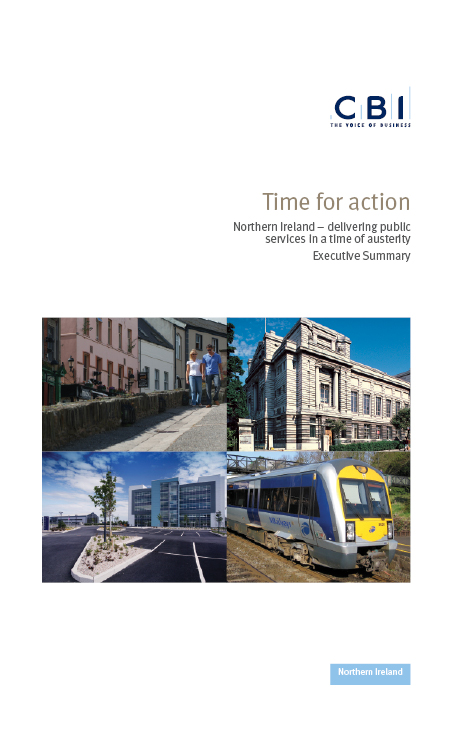
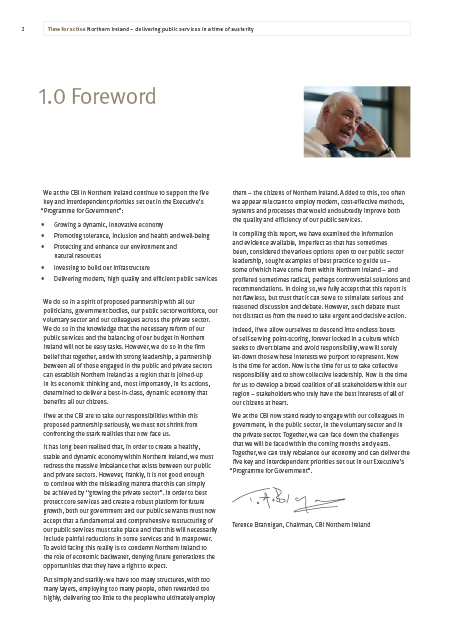
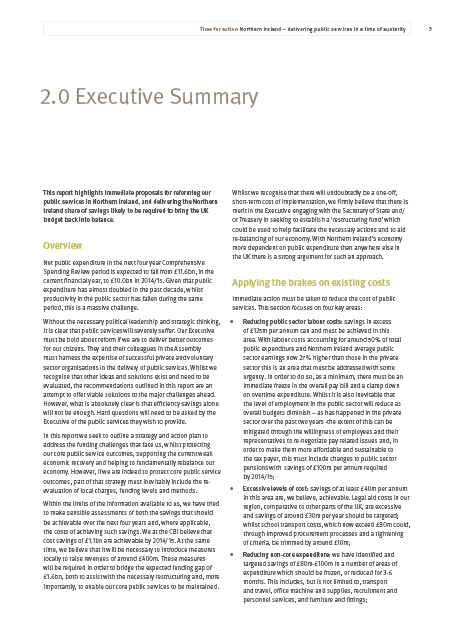
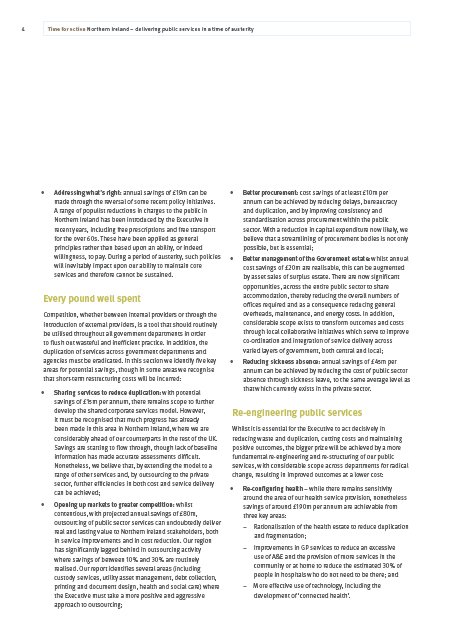
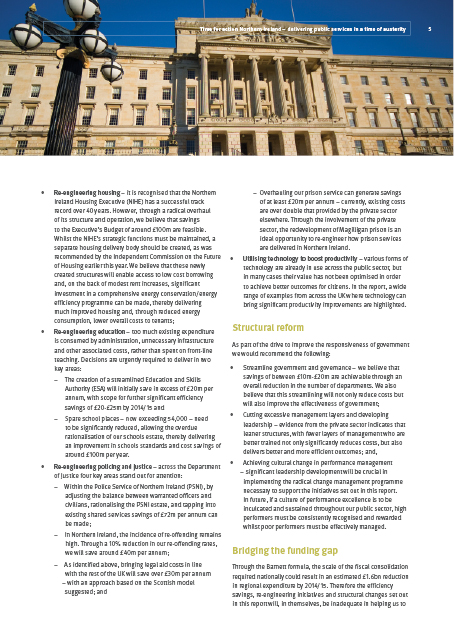
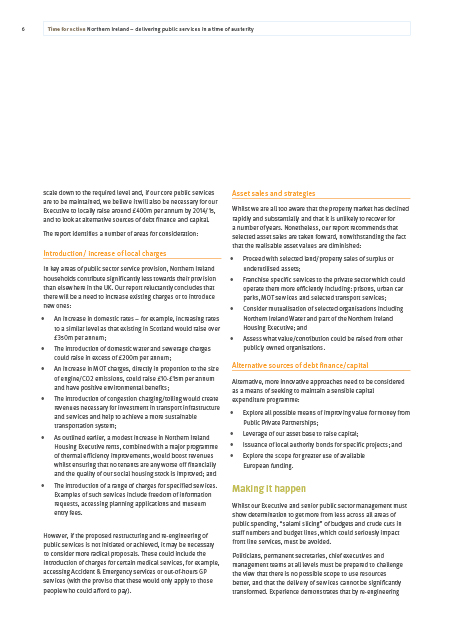
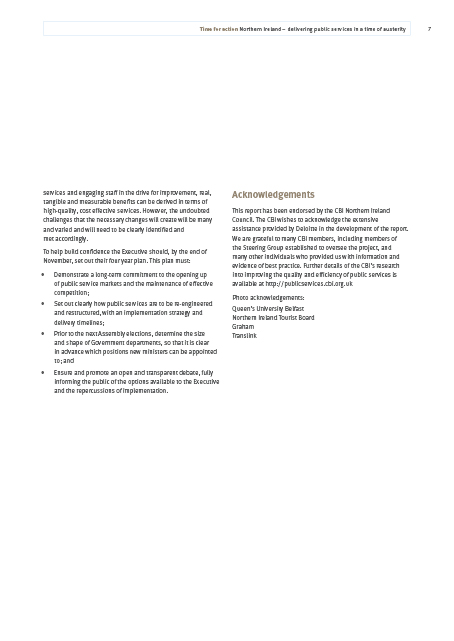

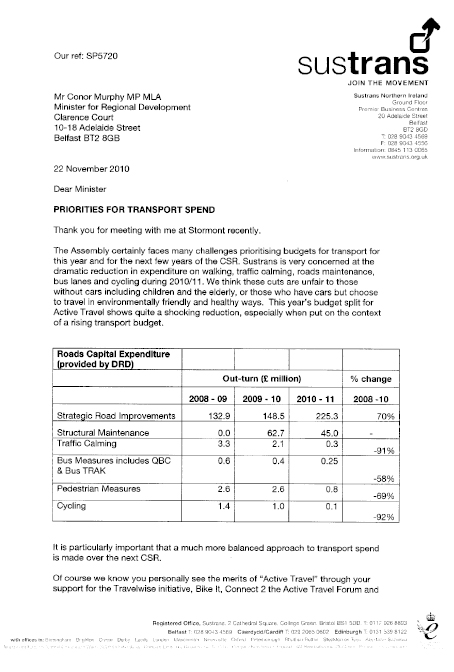
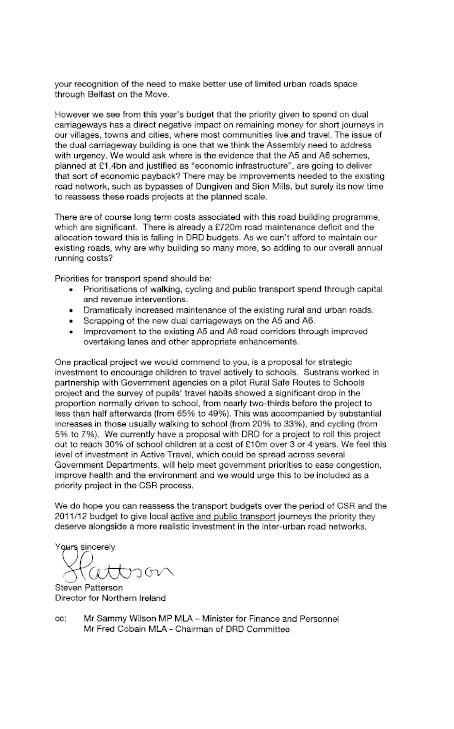
_2010_12_03_-_Disab_fmt.jpeg)
_2010_12_03_-_Disa_fmt1.jpeg)
Dear [Clerk, Committee for Regional Development]
As I am sure you are aware, the logistics sector is a vital component of the Northern Ireland economy. With this in mind, FTA has produced a submission to the Northern Ireland budget, in order to inform ministerial discussions on the priorities of the Budget; which must surely focus heavily on investment that will further enhance Northern Ireland’s economic competitiveness and development. This means, in terms of the DRD, an investment in roads infrastructure, particularly that affecting access and egress to the principal points of trade: ports and major business areas. The most important schemes from within the different tiers of DRD planned works are listed in the submission
A copy of this submission, setting out the key priority spending of the logistics industry for the maximum benefit to industry, is attached to this email. These priorities have been identified after discussion with FTA’s several hundred members across Northern Ireland.
We would be grateful if you could circulate this document to members of the Committee for potential discussion at a future meeting where the impact of the forthcoming budget on the future development of the different regions of Northern Ireland, and the impact of the budget on the DRD’s infrastructure obligations will be on the agenda.
If you have any questions then please do get in touch with either myself or FTA Head of Policy for Northern Ireland Tom Wilson on [Email address].
Best wishes,
_______________________________
Public Affairs Manager
Freight Transport Association
Direct Line:
Mobile:
Fax:
www.fta.co.uk
? Please help us achieve our environmental targets by not printing this e-mail.

The Freight Transport Association (FTA) represents over 14,000 companies spread across Great Britain and Northern Ireland relying on or providing the transport of freight both domestically and internationally, both imports and exports. Over 300 of these members are based in Northern Ireland, in every Assembly constituency. Our members include hauliers, freight forwarders, rail and air freight operators, through to customers – suppliers of raw materials, retailers, manufacturers and wholesalers, covering all modes of transport – road, rail, air and sea. Our members are involved in deep sea and domestic shipping, intermodal supply chains and retail goods, also freight operating companies and logistics service providers. In short, every link in the Northern Ireland supply chain is represented in the FTA membership.
FTA members operate over 200,000 commercial goods vehicles in Great Britain and Northern Ireland, approximately half of the UK fleet of goods vehicles, 90 per cent of goods moved by rail and around 70 per cent of goods moved by air and sea.
In addition, FTA has recently extended its operations into the south of Ireland, establishing a sister organisation named FTA Ireland, with its headquarters in Dublin. This makes FTA uniquely placed to respond to cross-border issues that affect our members across the whole island of Ireland.
The logistics industry is vital to the economic health of Northern Ireland. There are hundreds of companies moving goods around Northern Ireland, employing many thousands of people. Over 3,000 goods vehicle driving tests were completed in Northern Ireland in 2009. Indeed, Northern Ireland is home to almost 25,000 registered Heavy Goods Vehicles and of the just over 100,000 vehicles registered for the first time in 2009, 12 per cent were goods vehicles (9% goods vans and 3% heavier vehicles.)
These vehicles are far from sitting idle, as they are responsible for moving a huge quantity of goods. In 2008, Northern Ireland handled 23.5 million tonnes of freight through its four ports (according to DETI Statistics). Goods Vehicles over 3.5 tonnes moved some 57 million tonnes of goods in Northern Ireland in 2009, although here the effect of the recession is clear. The amount of goods moved, and therefore the amount of trade done by companies in Northern Ireland, was nearly 20 million tonnes down on two years previously.
The road transport network provides connectivity linking people to jobs and products to markets. International gateways are vital for international trade and, in combination with sea traffic routes, are an integral part of many supply chains. In contrast with Great Britain, in Northern Ireland freight moves almost exclusively by road. Therefore road issues, particularly protection of funding set aside for maintenance and targeted roads improvements, is vital to the Northern Ireland logistics industry. It is also vital that these funds are protected to make Northern Ireland a more attractive place for private sector investment. This is surely the only route out of the current economic malaise which is affecting Northern Ireland as keenly as anywhere else in Europe. Investment in roads is surely an investment in the economic future.
In a global marketplace, connectivity with other nations and regions is vital, and FTA members are keen to point out that the improvement of access to Northern Ireland’s ports and airports is key to effective imports and exports. In addition to international connectivity across the sea, it is also important that key routes within the island of Ireland are maintained in the north. Of the almost 60 million tonnes of goods moved in Northern Ireland, over 7 million are driven cross border between the north and the south.
Even though the recession has meant a temporary fall in overall traffic volumes, businesses report at best only marginal improvements in the frequency and extent of delays. Congestion ‘hotspots’ are a blight on the network – where the capacity of the existing infrastructure has failed to keep pace with growing traffic demand or where poor connectivity with other modes means the load is spread unevenly across different networks. Crucially for industry, the most congested parts of the network coincide with industry’s national trade routes – where freight activity is highest.
FTA recently sent in a submission to the UK Government’s Comprehensive Spending Review (CSR); highlighting the need to create a framework to enable future investment to be targeted at national trade routes where freight traffic demand growth is expected to be greatest as the nation emerges from recession. Many of the principles of this submission also apply to Northern Ireland:
In the run up to the setting of the Northern Ireland budget, FTA is laying down its thoughts on the areas where spending should be focussed.
With the completion date for the budgetary process still unclear, the issue is complicated still further by the implementation of the UK Comprehensive Spending Review (CSR). The CSR has had a profound effect on the block grant available to Northern Ireland; with a 7 per cent reduction in the resource budget scheduled for Scotland, Wales and Northern Ireland. In addition, over 5 years the capital budget for Northern Ireland has been reduced by 37 per cent, putting a number of schemes at risk. It is therefore important that industry is able to articulate to the Northern Ireland Executive, which retains authority over the bulk of transport infrastructure, where spending should be targeted to maximise economic return; and this is what this Budget submission seeks to do.
Times are hard and difficult decisions will have to be made, so the table below lays down FTA’s priorities for spending to maximise the efficiency and connectivity of Northern Ireland’s freight transport supply chains.
Priorities |
Project Outputs |
Supply Chain Benefits |
|---|---|---|
| Complete legislative process and implement Operator Licensing for the whole logistics industry. | A full licensing system to target rogue operators and improve Northern Ireland’s international reputation. | Safer roads, more efficient supply chains, less time and money wasted because of all companies being tarred with non-compliance brush, fairer working conditions for whole industry. |
| Deliver Committed Schemes |
|
Supply chain resilience, reduction in freight journey times, reduction in supply chain costs, congestion and carbon savings, safety improvements |
| Deliver Key Preparation Pool Schemes |
|
Supply chain resilience, reduction in freight journey times, reduction in supply chain costs, congestion and carbon savings, safety improvements |
| Strategic Road Infrastructure Investment |
|
Improved port access/egress, distribution efficiency, safety and carbon improvements. Reduced congestion within Harbour Estate and Titanic Quarter. (FTA recommend these schemes get priority over the proposed widening of the Sydenham by-pass). |
For further information on FTA’s Northern Ireland Transport and Supply Chain Policy or to discuss any matters in this submission further please contact:
Head of Policy – Northern Ireland
mob:
[Email Address]
Website www.fta.co.uk
Badly maintained local roads are costing the economy in Britain £4.1bn a year in wasted staff time, production delays and damage repairs, according to a new report carried out by YouGov for the Asphalt Industry Alliance . The report reveals that 55 per cent of small and medium sized enterprises (SMEs) in England and Wales are losing on average £13,600 each per year.
The new report, The Economic Impact of Local Road Condition, reveals that bad local roads are hitting over half (55 per cent) of SMEs on the bottom line, not only in obvious ways such as accidents and vehicle damage but also through decreased productivity and increased business costs. 48 per cent of businesses report that poorly maintained roads waste their staff’s time - on average each affected business reported losing 216 hours a year, the equivalent of one member of staff being absent for five weeks of the year.
Local authority roads account for over 95 per cent of the country‘s network. Local authority highway departments, facing a shortfall in funding of £800 million², are finding it increasingly difficult to meet the costs of maintaining their roads in an acceptable condition. This problem is made worse by the diversion of funds, allocated by central Government to highways maintenance, to other Council services.
There are 4.3 million small and medium-sized enterprises in England and Wales, employing 12.3 million people. SMEs are regarded as the “engine of the economy" and have a combined annual turnover of £1,350 billion³. The report reveals that poor road condition directly affects these businesses, and indirectly influences the success – or otherwise – of the local economy, in the following ways:
Investing in road maintenance has positive effects for a local area. Members of the public, who were also polled by YouGov for the report, said that the condition of local roads affected their decisions on where to shop (33 per cent); where to go for days out (39 per cent); and where to buy a house (45 per cent).
The Asphalt Industry Alliance, an industry group which campaigns to raise awareness of the need for sustained investment in road maintenance, is calling for:
QPANI Regional Director, Gordon Best, said ““QPANI fully support the Asphalt Industry Alliance in their call for a greater priority to be given to the funding of roads maintenance across the UK. Although this report does not cover Northern Ireland it demonstrates that there is a sound economic argument for properly funding local road maintenance as a key measure to help the economy emerge from recession. Improving the condition of local roads would take the brakes off our SMEs and help them to drive the recovery forward. In terms of Northern Ireland the facts highlighted in the Report are probably worse as the roads in Northern Ireland are less maintained than those in GB. This figure is confirmed in the Roads Service 2009 – 10 Annual Report (page 64) that states that we spend £4,400 per km in Northern Ireland on maintaining our road network, considerably less than that equivalent spend in England and Wales. The statistics shown in the GB report, if applied to Northern Ireland, would indicate that our under funded roads maintenance is costing the economy here at least £80million per year". Mr Best added “the continued under spending by the Executive on the maintenance of our roads network means that the recent freezing conditions will have a more serious impact on the medium to long term condition of our roads. The facts are the Executive and the Regional Development Minister say they do not have the funding to carry out what all professional opinion say is required to maintain our roads network in a safe and satisfactory condition. This figure is £112 million per year. We are no where near that figure, as over the last two years we have spent in and around £75 million and £85 million respectively and the under spend over the past 10 years now stands at approximately 500 million. Unfortunately with more low temperatures expected this year some tough decisions may have to be taken particularly with regard to the condition of our rural road network which according to the 2009 - 2010 Annual Report states that many of the rural roads have not been maintained in over 100 years . Will we have to close many of our rural roads because we don’t have the money to maintain them? Will we see slippery road signs going up on many of our roads as the skid resistance has deteriorated and no money to resurface them? How many more accidents will occur because of potholes or reduced skid resistance? What will be the impact on our economy?
Regional Director
QPANI
To view the full AIA Report click
http://www.asphaltindustryalliance.com/images/library/files/AIA_YouGov_Report_final.pdf
The Quarry Products Association NI represents approximately 95% of companies involved in the supply of quarry products to the Construction Industry in Northern Ireland. Our Association draws its membership from companies engaged in providing primary aggregates, the processing of recycled and secondary materials, the production of downstream products such as asphalt, lime mortar, ready-mixed concrete, precast concrete and road surfacing contracting. The Quarry Products Sector now employs over 3500 people across Northern Ireland and has a turnover of some £500 million.
For further information please contact Gordon Best, Regional Director, Quarry Products Association, Nutts Corner Business Park, Crumlin BT29 4SR Tel 02890824078 Fax 028 90825103 email info@qpani mobile 07876 136929
_2011_01_07_-_2_-_A_fmt.jpeg)
_2011_01_07_-_2_-__fmt1.jpeg)
_2011_01_07_-_2_-__fmt2.jpeg)
_2011_01_07_-_2_-__fmt3.jpeg)
_2011_01_07_-_2_-__fmt4.jpeg)
_2011_01_07_-_2_-__fmt5.jpeg)
_2011_01_07_-_2_-__fmt6.jpeg)
_2011_01_07_-_2_-__fmt7.jpeg)
_2011_01_07_-_2_-__fmt8.jpeg)
_2011_01_07_-_2_-__fmt9.jpeg)
_2011_01_07_-_2_-_fmt10.jpeg)
_2011_01_07_-_2_-_fmt11.jpeg)
_2011_01_07_-_2_-_fmt12.jpeg)
_2011_01_07_-_2_-_fmt13.jpeg)
_2011_01_07_-_2_-_fmt14.jpeg)
_2011_01_07_-_2_-_fmt15.jpeg)
_2011_01_07_-_2_-_fmt16.jpeg)
_2011_01_07_-_2_-_fmt17.jpeg)
_2011_01_07_-_2_-_fmt18.jpeg)
_2011_01_07_-_2_-_fmt19.jpeg)
_2011_01_07_-_2_-_fmt20.jpeg)
_2011_01_07_-_2_-_fmt21.jpeg)
_2011_01_07_-_2_-_fmt22.jpeg)
_2011_01_07_-_2_-_fmt23.jpeg)
The Industry body that represents Northern Irelands construction materials suppliers has welcomed the Regional Development Ministers announcement that next year will see a record amount of funding to repair the Provinces deteriorating roads. The Minister made the announcement following the publication of the DRD Draft Budget proposals for 2011 – 2015. Gordon Best, Regional Director of the Quarry Products Association NI, said that “The commitment by the Minister to spend a record £94 million in the next financial year on structural maintenance of our roads is to be welcomed by everyone who uses our roads network. This is good news for business, good news for all road users and good news for the construction materials supply industry at a very difficult time when jobs are under threat, people are on short term working and many businesses are struggling to balance the books. This injection of funding will help sustain more than 1200 directly employed jobs across Northern Ireland, not to mention the significant benefit from the economic ripple effect of this injection of spend across the community". However while welcoming this front loading of the 4 year spend of some £280 million on roads maintenance Mr Best added “ this level of spend for next year is welcome but still falls way short of the £112 million annually that is actually required to maintain our roads network in a safe and satisfactory condition. Lets hope that more money will be available in years 2, 3 and 4 of the budget period to ensure that we address the years of under funding to repair and resurface our important roads network".
The Quarry Products Association has also welcomed, despite the 40% forced reduction in the Departments Capital budget, the Ministers commitment to invest more than £2 billion in our infrastructure that includes over £1.1billion for roads, around £185million for public transport and over £665million for water and sewerage services. This investment in our water and sewage infrastructure is vital if we are never to see the levels of service breakdown experienced recently. The jobs that this investment will secure will help sustain many family incomes in communities many of which are in rural areas.
While recognising the financial constraints the public sector is under Mr Best concluded by saying “As a society we need to strive to be more efficient and cut wastage. We can continue to blame individuals or politicians or whoever we want for certain unforeseen events but if we all don’t realise that if we want a 21% century infrastructure with 21% century services we are going to have to pay more for them".
The Quarry Products Association NI represents approximately 95% of companies involved in the supply of quarry products to the Construction Industry in Northern Ireland. Our Association draws its membership from companies engaged in providing primary aggregates, the processing of recycled and secondary materials, the production of downstream products such as asphalt, lime mortar, ready-mixed concrete, precast concrete and road surfacing contracting. The Quarry Products Sector now employs over 3500 people across Northern Ireland and has a turnover of some £500 million.
For further information please contact Gordon Best, Regional Director, Quarry Products Association, Nutts Corner Business Park, Crumlin BT29 4SR Tel 02890824078 Fax 028 90825103 email info@qpani mobile [removed]
Committee for Finance and Personnel
Room 419
Parliament Buildings
From: Clerk, Committee for Finance and Personnel (CFP)
Date: 17 January 2011
To: Statutory Committee Clerks;
Clerk to the Audit Committee
Head of the Commission Support and Compliance Unit
CC: Clerk Assistants
Director of Clerking and Reporting
1. At its meeting on Wednesday 12 January 2011, the Committee for Finance and Personnel (CFP) discussed how flexibility might be built into the timetable for scrutinising the Executive’s Draft Budget 2011-15. The Committee agreed the following:
i. CFP will follow the normal convention of preparing a co-ordinated report on the Draft Budget on behalf of all relevant Assembly committees, which scrutinises issues both at the departmental-specific and cross-cutting levels. CFP will endeavour to complete this report within the Executive’s closing date for the wider public consultation (this was originally 9 February, but subsequent to the Committee’s meeting has now been moved to 16 February);
ii. In order to offer the other committees more time to scrutinise the draft budgets of their departments, the provisional deadline of Friday 21 January for committee responses has been changed to close of play on Thursday 27 January;
iii. CFP would prefer the “take note" debate to take place on either Monday 31 January or Tuesday 1 February instead of Tuesday 25 January (which will assist in ensuring that, where possible, committees have agreed positions before the debate); and
iv. If a committee is unable to make its response by 27 January, CFP will still accept the submission if it is received before the Committee agrees the final draft of the co-ordinated report on 16 February. In such circumstances, the late committee submission will simply be appended to the agreed report. However, late submissions will hinder CFP from its analysis and scrutiny of cross-cutting and strategic issues within the co-ordinated report.
2. The Committee also considered [a] Research briefing note, and agreed that it should be copied to all statutory committees, the Audit Committee and the Assembly Commission for information.
_2011_01_19_-_Frei_fmt.jpeg)
Committee for Finance and Personnel
Room 419
Parliament Buildings
From: Clerk, Committee for Finance and Personnel
Date: 20 January 2011
To: Statutory Committee Clerks
At its meeting on 19 January 2011, the Committee for Finance and Personnel considered the attached correspondence from the Department of Finance and Personnel on the progress of the implementation of departmental efficiency plans from April – September 2010.
Given, the cross-cutting nature of this issue, the Committee agreed to forward the correspondence to all statutory committees for information.
As part of the 2008-11 Budget process, the Executive agreed that departments should work to deliver cumulative efficiency savings of 3% a year over the period 2008-09 to 2010-11. The purpose of this report is to provide details of the level of savings achieved by departments for the first six months of 2010-11.
In the first six months of 2010-11, departments have achieved £619 million of efficiency savings (equivalent to 77.9% of the target for the full year). DEL is the only department not to have achieved at least 50% of the target level of savings for 2010-11 within six months. Three departments (DARD, DETI and FSA) have already achieved their full year target - see Table 1 below.
| Department | 2010-11 Target (£m) | 6 months Savings (£m) | % of 2010-11 Savings Achieved |
|---|---|---|---|
| DARD | 18.07 |
18.07 |
100.0% |
| DCAL | 9.36 |
5.21 |
55.7% |
| DE | 183.97 |
173.77 |
94.4% |
| DEL | 59.23 |
26.72 |
45.1% |
| DETI | 23.70 |
23.70 |
100.0% |
| DFP | 15.80 |
8.00 |
50.6% |
| DHSSPS | 343.05 |
265.58 |
77.4% |
| DOE | 11.42 |
5.71 |
50.0% |
| DRD | 65.38 |
43.90 |
67.1% |
| DSD | 56.30 |
41.91 |
74.4% |
| OFMDFM | 7.65 |
5.74 |
75.0% |
| FSA | 0.65 |
0.71 |
109.2% |
| Total | 794.58 |
619.02 |
77.9% |
Notes:
1. The % of savings achieved for FSA is more than 100% of its target due to its plans to deliver more savings than in its original plans.
2. OSNI moved from DCAL to DFP during 2008-09, the efficiency target was moved from DCAL to DFP as a result (£1m in 2010-11)
In addition to examining the actual level of savings delivered by departments, it is also important to monitor the latest projections in respect of the achievement of planned savings. Table 2 sets out the DFP assessment as to whether the targeted level of savings for each Efficiency Delivery Plan (EDP) will be achieved for 2010-11 using the following three categories:
The latest assessment is that the majority of EDPs are on track for delivery without any risk, with 16.6% being significantly at risk or not on track in 2010-11.
DHSSPS and FSA have indicated that whilst they will not meet planned efficiencies in the areas originally stated, they will over-perform in other areas in order to meet their efficiency target for 2010-11. OFMDFM has also stated that it will not meet all its efficiencies from the intended areas but it has created a new efficiency to replace those that cannot be met. DE has not provided any detail regarding not meeting planned efficiencies but it has given an assurance that in agreeing Departmental allocations for 2010-11 the Minister has introduced a range of further measures to ensure that the Department’s overall efficiencies target in 2010-11 is achieved in full.
In terms of the percentage of savings, 83.4% are on track for achievement in 2010-11 compared to 52.5% at the same point last year.
There are seven departments (DCAL, DEL, DETI, DFP, DOE, DRD, and DSD) who have 100% of both their efficiency plans and savings on target for delivery in 2010-11.
| Not On Track | On Track with Significant Risk | On Track | |
|---|---|---|---|
| % of EDP’s | |||
| 2010-11 | 7.9% |
0.9% |
91.2% |
| % of Savings | |||
| 2010-11 | 16.3% |
0.3% |
83.4% |
Note: Savings may total more than 100% due to some departments planning to achieve savings in excess of their target.
This update highlights the need for all departments to continue to monitor the implementation of their plans to deliver 3% per annum, cash releasing efficiency savings, and to make adjustments where necessary. The next round of monitoring will be undertaken at the end of the 2010-11 financial year. This will then provide an assessment of the actual delivery of efficiency savings for the full year.
Department of Finance and Personnel
January 2011
26th January 2011
The QPANI welcomes the opportunity to comment on the proposals within the DRD draft budget. The Association will be making a more detailed submission to the NI Draft Budget 2011 -2015.
The QPANI is the principal trade association representing the Northern Ireland aggregates and quarrying industry. Our members produce over 95% of aggregates quarried in Northern Ireland – sand and gravel and crushed rock. They also produce agricultural and industrial lime, silica sand and marine dredged sand and gravel, as well as secondary and recycled aggregates, ready mixed concrete and asphalt products for roads.
We fully recognise and support the Executives and Departments priority in the budget to stimulate the economy, tackle disadvantage, protect the most vulnerable in our society and protect front line services. We applaud the Department for pursuing the following objectives;
Objective A – Supporting the economy by planning, developing and maintaining safe and sustainable transportation networks; promoting airport and harbour services; addressing regional imbalance in infrastructure; and shaping the long term future of the region.
Objective B – Contributing to the health and well being of the community and the protection of the environment by maintaining and developing policy and the regulatory framework which provides sustainable, high quality water and sewage services.
It has been stated many times in the past, and was the reason for the establishment of the Strategic Investment Board and the Strategic Roads Programme, that over many years Northern Ireland suffered from significant under investment in its roads, schools, water and health infrastructure.
In reality we are now in the process of catching up with our nearest economic competitors and the much needed infrastructure investment needs to run its course to completion. The Executives programme for Government states,
“Growing the economy will be our top priority over the lifetime of this Programme for Government."
The quality of our transportation system has a key role to play in the competitiveness of our economy and achieving the wider sustainable development objectives. It is vitally important that investment is made where it will be of most benefit and deliver measurable economic success both to the local area and Northern Ireland as a whole. Roads should be viewed as “economic corridors" and should be planned with other public transport infrastructure in consultation with local business and other relevant Government Departments such as Planning Service, Invest NI and Department of Finance. The delivery objective of this budget should be to ensure that Northern Ireland will remain competitive in the global international marketplace and that the fruits of our economic success will be shared more equally at regional level and throughout society.
In 2007 an Inter Trade Ireland Survey highlighted the importance of investment in our road infrastructure. It stated that almost two thirds (65%) of businesses in the Republic of Ireland and just under half (49%) in Northern Ireland stated that the lack of ‘transport infrastructure had an adverse impact on their business". One of the Key Infrastructure findings was that:
"Businesses, both North and South, have identified road infrastructure as the main priority for improvement (61%), followed some way behind by improvement to the rail network (22%), and bus services (11%)".
Also recent HM Treasury figures show that in Northern Ireland we spend 21% less per capita in roads maintenance than in the rest of the United Kingdom yet we depend more on our roads for freight transport than any other region. Inter Trade Ireland Chief Executive Liam Nellis said: “Infrastructure is the bedrock for strong economic growth. It is only when basic infrastructure needs – in this case, the transportation network are met, that the business environment can strive towards the upper limits of its potential". As stated in the World Development Report 1994, “inadequate maintenance is almost a universal (and costly) failure of infrastructure providers. For example, a well-maintained paved road surface should last ten to fifteen years before needing resurfacing, but lack of maintenance can lead to severe deterioration in half that tune. Failings in maintenance are often compounded by ill-advised spending cuts. Curbing capital spending is justified during periods of budgetary austerity but reducing maintenance spending is a false economy. Such cuts have to be compensated for later by much larger expenditures on rehabilitation or replacement of roads".
The Quarry Products Association together with our other key stakeholders believe that not only investment in new infrastructure is vital but we also need to set aside adequate funding for the maintenance of our existing transport network. A fit for purpose and well maintained infrastructure is needed because
DRD is the largest capital Department and as such should play the leading role in improving the infrastructure of the Region within the funding made available to it.
QPANI recognise the significant financial constraints that have been placed on the Department following the outcome of the Comprehensive Spending Review and the subsequent cut in capital budget of almost 40%. In terms of the Departments current and investment spending plans set out in tables 1 and 2 in the document we believe the front loading in year 2011 -12, particularly in the roads structural maintenance allocation, is understandable given the current state of our roads network and the significant damage that has been done following two years of extreme freeze thaw conditions. The allocation of £94 million for structural maintenance is to be welcomed by all road users including the business community who depend on the network for transporting goods to customers across the island and to the ports for export. This injection of funding will help sustain more than 1200 directly employed jobs across Northern Ireland, not to mention the significant benefit from the economic ripple effect of this injection of spend across the community".
However QPANI, while welcoming the commitment in year 1 of the budget period to structural maintenance, are concerned that the total allocation to maintenance over the 4 year budget period is some £168 million short of what the Departments own structural maintenance funding plan states is required. The allocations in years 2 and 3 are at levels that will cause great difficulty for the industry. Companies have invested significantly in training employees, in production facilities, quality, safety, reducing environmental impact and purchasing equipment to deliver a quality product for the Roads Service. A reduction of such magnitude from year 1 to year 2 and then rising again from year 3 to year 4 makes it difficult to maintain resources of trained people and equipment.
Our Association also welcomes the commitment to other key infrastructure projects such as the A8, the A32, public transport infrastructure, and improvements in the water and sewage infrastructure to ensure that we meet all water quality standards expected by Europe. In terms of the A5 Aughnacloy to Derry road we are fully supportive of this project so long as the financial allocation of some £400 million is available from the Government of the Irish Republic. If this allocation is withdrawn following the forthcoming General Election in the Irish Republic then a major re-allocation of funds to projects that deliver significant benefits to the economy and the maximum creation of employment should be considered. In our view these should be all or some of the following;
Upgrade A5 from Aughnacloy to Strabane ( total 40 miles ) by construction of 2 plus one carriageways in either direction. £87.5 M)
A5 Londonderry to Victoria Bridge, 30km of new route to 2 plus one standard including by passes of New Buildings, Magheramason, Strabane and Sion Mills. £130 million
£168 M of funds redirected to Structural maintenance in years 2, 3 and 4 to bring the SM expenditure over the four year budget period up to that outlined in the Departments SM funding plan.
Construction of the Westlink / York Street flyover , cost £50 M
A2 Widening Greenisland cost £39 M
Dualling between Randalstown to Castledawson cost £70M
A8 Colemans Corner to Ballyrickard Road Larne £100 M
Total of re allocated funds to economically strategic road schemes and maintenance = £644.5 M
( costs taken from Roads Service Strategic Road Improvement Programme )
The economic ripple effect of investment of the redirected funds in these projects would be enormous and act as a real springboard for re-energising and growth of the local economy and the construction industry.
QPANI recognise and support the need to reduce our carbon emissions by encouraging those who have the obvious choice out of their cars and into public transport. We therefore support increased investment in public transport infrastructure particularly in and around Belfast, Londonderry and other major towns. It is our view that Northern Ireland does not have the population to support and finance a profitable and efficient train network. We believe that a well funded bus based park and ride, integrated public transport network fuelled on low carbon fuels is the way forward for Northern Ireland. It is not roads that create carbon emissions, it is the fuel used by vehicles that travels on it. Our Executive and UK Government need to amend the fuel pricing and tax system so that it is economically beneficial for private and business road users to use low carbon fuels.
QPANI support the development of the bus based Rapid Transit system in Belfast and believe it will reduce congestion and carbon emissions in the greater Belfast area.
We welcome the continued investment in the water and sewage network in order that we meet water quality standards expected by Europe and if we are not to experience the widespread disruption caused recently as a result of the extreme cold weather. However we believe that alternative sources of revenue based on usage of water must be introduced by the Department at the earliest opportunity.
QPANI welcomes a reduction in the use of consultants and the resultant savings.
We welcome a more focused approach on minor maintenance activities. We note the Departments comments “as maintenance functions within the resource block are already funded to optimum levels savings can not be achieved without an immediate impact on service delivery". However we suggest that an outsourcing to the private sector of a number of maintenance activities would deliver cost savings to the Department.
QPANI would recommend a rise in the concessionary fares charges age limit to 65. This will result in savings for the Department.
QPANI welcomes the proposed release of value of £15 M from the Belfast Harbour.
We welcome the rationalisation of Roads Service depots and section offices across Northern Ireland and would urge Roads Service to continue to identify opportunities for savings that can be delivered to front line services such as roads maintenance and road safety projects.
It is the QPANI view that in these times of financial constraint we must be spending every penny in areas that will deliver maximum economic benefit for the people of Northern Ireland. If we are to enjoy a 21% century infrastructure with 21% century services we are going to have to pay more for them. We look forward our views with the Regional Development Committee.
Regional Director QPANI
_Utility_Regulator_fmt.jpeg)
_Utility_Regulato_fmt1.jpeg)
_Utility_Regulato_fmt2.jpeg)
_Utility_Regulato_fmt3.jpeg)
_Utility_Regulato_fmt4.jpeg)
| Area | Town | Number of Members | Average total trips per month | Trips 7:00am-11am | Trips 11am-3pm | Trips 3pm-7pm | Trips 7pm-11.00pm | Average trips refused per month |
|---|---|---|---|---|---|---|---|---|
| Northern | Antrim | 176 |
190 |
61 |
87 |
35 |
7 |
6 |
| Ballymena | 247 |
326 |
68 |
131 |
88 |
39 |
9 |
|
| Ballymoney | 78 |
97 |
34 |
23 |
29 |
10 |
2 |
|
| Coleraine | 155 |
364 |
138 |
105 |
100 |
21 |
5 |
|
| Larne | 115 |
111 |
27 |
40 |
31 |
14 |
0 |
|
| Limavady | 44 |
44 |
19 |
18 |
7 |
0 |
0 |
|
| Eastern | Bangor | 943 |
1542 |
453 |
578 |
357 |
154 |
40 |
| Belfast | 3384 |
2669 |
922 |
1023 |
492 |
232 |
692 |
|
| Carrickfergus | 600 |
645 |
208 |
265 |
128 |
44 |
5 |
|
| Comber | 63 |
44 |
15 |
14 |
11 |
4 |
1 |
|
| Dundonald | 105 |
25 |
7 |
12 |
4 |
3 |
2 |
|
| Dunmurry | 175 |
119 |
25 |
49 |
20 |
28 |
2 |
|
| Holywood | 185 |
133 |
40 |
58 |
28 |
9 |
8 |
|
| Lisburn | 440 |
390 |
104 |
150 |
115 |
22 |
4 |
|
| Newtownabbey | 738 |
527 |
182 |
213 |
107 |
25 |
4 |
|
| Newtownards | 283 |
192 |
44 |
69 |
69 |
10 |
4 |
|
| Southern | Armagh | 140 |
337 |
103 |
90 |
102 |
43 |
4 |
| Banbridge | 111 |
283 |
74 |
85 |
82 |
42 |
1 |
|
| Craigavon(including Portadown/Lurgan) | 582 |
570 |
123 |
198 |
161 |
88 |
12 |
|
| Newry | 241 |
505 |
159 |
230 |
77 |
39 |
8 |
|
| Downpatrick | 104 |
49 |
11 |
17 |
4 |
18 |
0 |
|
| Western | Cookstown | 120 |
264 |
83 |
105 |
73 |
3 |
4 |
| Dungannon | 106 |
56 |
16 |
33 |
7 |
1 |
0 |
|
| Enniskillen | 124 |
363 |
138 |
105 |
95 |
25 |
1 |
|
| Omagh | 308 |
473 |
150 |
170 |
120 |
33 |
9 |
|
| Strabane | 64 |
12 |
5 |
1 |
4 |
2 |
0 |

Clerk to the Committee for Regional Development
Committee Office
Parliament Buildings
Stormont
Belfast
BT4 3XX 28 January 2011
Dear [Clerk, Committee for Regional Development]
Thank you for the invitation and opportunity to give evidence to the Regional Development Committee on its draft budget on Wednesday 26 January in the Long Gallery.
Following my presentation to the Committee the Chairman requested that the facts and figures contained in my submission of evidence be submitted for their further consideration.
The Road Infrastructure Priorities are Trade Routes that have been identified by FTA’s Northern Ireland Freight Council as operating beyond designed capacity that carry raw materials, goods and services for our everyday needs.
These routes need to be urgently upgraded to alleviate regularly encountered traffic congestion.
As the result of an agreement amongst EU member states, the UK adopted targets of reducing greenhouse gas and carbon dioxide emissions. The Belfast Air Quality Management steering group recently released details of specific areas in Belfast where the maximum permitted air quality levels of 40 micrograms are still being exceeded mainly as a result of traffic based emissions of Nitrous Oxide and Particulate material.
A topography map indicated three specific areas of concern
All three areas are densely populated and adjacent to the Westlink motorway where daily traffic flows recorded 81,000* vehicles per day (measured over 7 days) *DRD Roads Service 2009 Draft figures.
DRD research indicates that 70% of vehicles identified as ‘through traffic’ currently passes the rear of the City Hall and does not terminate in the city centre. When the ‘Belfast on the Move’ project gets underway the four lanes at the rear of the City Hall will be reduced to two, thereby driving much of the aforementioned traffic onto the Westlink. This will further exacerbate the Westlink congestion and add to emission levels.
By giving priority to the York Street/Westlink flyover road improvement scheme several quantifiable benefits will result:
The Air Quality readings taken in the Short Strand area also indicate unacceptable levels of micrograms.
By giving priority to road alterations and improvements to improve the efficiency of travel into and out of the Titanic Quarter at the junction of Dee Street with the Sydenham bypass would have the following benefit:
Other FTA Trade Routes that are also heavily congested have daily traffic flows as follows:
Owing to the peripherality of Northern Ireland with its need to be extremely competitive and in times of severe economic hardship when budgets are reduced, developments of important Trade Routes need to be prioritised where clear economic benefits will result.
Head of Policy – Northern Ireland
Freight Transport Association
109 Airport Road West
Belfast
BT3 9EE
Tel: (028) 9046 6699
Mobile:
E:
_2011_02_05_-_QUB__fmt.jpeg)
_2011_02_05_-_QUB_fmt1.jpeg)
_2011_02_05_-_QUB_fmt2.jpeg)
_2011_02_05_-_QUB_fmt3.jpeg)
_2011_02_05_-_QUB_fmt4.jpeg)
_2011_02_05_-_QUB_fmt5.jpeg)
_2011_02_05_-_QUB_fmt6.jpeg)
_2011_02_05_-_QUB_fmt7.jpeg)
_2011_02_05_-_QUB_fmt8.jpeg)
_2011_02_05_-_QUB_fmt9.jpeg)
_2011_02_05_-_QU_fmt10.jpeg)
_2011_02_05_-_QU_fmt11.jpeg)
_2011_02_05_-_QU_fmt12.jpeg)
_2011_02_05_-_QU_fmt13.jpeg)
_2011_02_05_-_QU_fmt14.jpeg)
_2011_02_05_-_QU_fmt15.jpeg)
_2011_02_05_-_QU_fmt16.jpeg)
_2011_02_05_-_QU_fmt17.jpeg)
_2011_02_05_-_QU_fmt18.jpeg)
_2011_02_05_-_QU_fmt19.jpeg)
_2011_02_05_-_QU_fmt20.jpeg)
Submission
prepared
by
University of Westminster, London
and
StephenWoodConsultancy
This paper has been prepared by Professor Austin Smyth of University of Westminster, London and Stephen Wood of StephenWoodConsultancy in response to the Department for Regional Development Draft Budget 2011-15, dated 13th January 2011 (see Appendix B for details on authors).
The paper has, of necessity, employed existing published information and assessments, supplemented where necessary by the authors’ estimates informed by their own considerable experience; there has been little opportunity for original in-depth research or analysis. Nevertheless, the conclusions are considered robust and highlight the following:
In line with the requirements of the budget process, the paper presents a recommended alternative mix of measures within a capital and current expenditure envelope similar to that set out in the Draft Budget.
The remainder of the paper is structured as follows:
2. Review of expenditure by mode of transport;
3. Summary assessment of capital measures against the five national transport criteria;
4. Commentary on key Savings Delivery Plan measures;
5. Conclusions on Draft Budget mix of measures; and
6. Recommended alternative mix of measures.
The profile of planned expenditure by mode of transport has changed over the period 2002 to the present day. There have been three principal expenditure plans:
Only the RTS was based upon a comprehensive review of policy and objectives and a value for money assessment of a wide range of alternative measures. It was developed in response to earlier criticisms over imbalance between facilitating private vehicle use and under funding public transport and other sustainable modes. The RTS was also supported by three more detailed Transport Plans[2] which were linked to local statutory land use plans.
The average annual capital expenditure planned allocations are presented below in Figure 2.1 (£million by mode of transport) and Figure 2.2 (Public Transport percentage share of total) and highlight[3]:
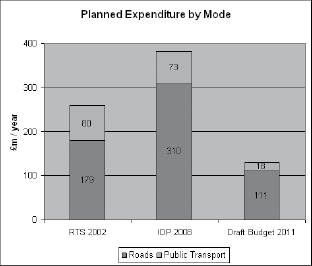

A high level assessment against the Government’s specified investment appraisal criteria has been undertaken for:
The criteria scores have been summarised from published reports where available. The findings of the Government or its advisors have been retained for the purposes of this exercise. Where reports are not available estimates have been made. Appendix A provides a definition of the criteria taken from Department for Transport guidance. It should be noted:
| Five National Transport Criteria | ||||||||
|---|---|---|---|---|---|---|---|---|
| Funding Proposed | Mode | Measure | Environment | Economy | Safety | Access | Integration | Source |
| Yes | Roads | A5 Derry – Aughnacloy | X | v | v | 0 | 0 | Roads Service Env Statement |
| Yes | Roads | A8 Belfast – Larne | X | v | v | 0 | 0 | Roads Service Env Statement |
| Yes | PT | Rapid Transit Network | 0/v | vv | v | v | v | DRD Outline Business Case |
| Yes | Rail | C3000 Fleet Replacement | vv | v | v | vv | v | Estimates |
| Yes | Rail | Coleraine – Derry track relay | 0/v | v | 0/v | 0/v | v | Estimates4 |
Table 3.1 highlights the mixed performance of the two road schemes against the criteria. Both schemes have adverse environmental impacts and neutral scores against accessibility and integration. Their primary contribution is against economy and safety with slight beneficial impacts. The rail and PT schemes record no adverse impacts and score positively across all criteria.[4]
Table 3.2 highlights the performance of key schemes either not funded or with reduced funding in the Draft Budget. The unfunded road schemes have better economy scores than the funded schemes (primarily due to greater traffic flows and current congestion) with limited reductions in other criteria scores.
Local transport & safety measures show beneficial impacts across a range of criteria, whilst structural road maintenance scores well against economy and safety. As before the Public Transport schemes score positively across all criteria with the Knockmore – Lurgan track relay scoring more highly than Coleraine – Derry due to the higher passenger numbers on this core route.
| Five National Transport Criteria | ||||||||
|---|---|---|---|---|---|---|---|---|
| Funding Proposed | Mode | Measure | Environment | Economy | Safety | Access | Integration | Comments |
| No | Roads | A6 R’stown – C’dawson | X | vv | v | 0 | 0 | Roads Service Env Statement |
| No | Roads | A2 Greenisland | X | vv | 0 | 0 | 0 | Roads Service Env Statement |
| No | Roads | A2 Sydenham Bypass | X | vvv | 0 | 0 | 0 | Roads Service Env Statement |
| No | Roads | York St Flyover | X | vvv5 | v | 0 | X6 | Estimates |
| Reduced | Roads | Local transport & safety measures | v | v | vv | vv | vv | Estimates |
| Reduced | Roads | Structural maintenance | 0 | vv | v | 0 | 0 | Estimates |
| No | Rail | Knockmore – Lurgan track relay | v | vv | v | v | v | Estimates |
| No | Bus | Fleet replacement | v | v | v | v | v | Estimates |
In general Tables 3.1 and 3.2 demonstrate that the mix of schemes proposed for funding under the Draft Budget lack balance across the full range of criteria with the reduction in funding for local transport & safety measures, which would contribute to a range of sustainable objectives, and for structural maintenance, particular losses. The chosen road schemes score relatively poorly in terms of economy compared to the unfunded road schemes.[5][6]
In addition to reductions in capital expenditure the Draft Budget includes the Department’s Savings Delivery Plan. The transport measures comprise almost £144 million, with over 70% in the last two years 2013/14 and 2014/15. The savings are split between Roads and Transport as follows:
In general terms, and having considered the explanatory detail, it would appear that the majority of the savings in Roads can be absorbed without strategic impact. The exceptions may be:
Any reduction in maintenance spend should be resisted as it represents a false economy. It defers spend on efficient planned maintenance but leads to increased spend on reactive maintenance and in later years more expensive reconstructive works. The increase in parking charges in town centres will need to be carefully managed and communicated. In principle the proposal to charge for on-street parking is sound; it should assist in the turn-over of on-street parking spaces. It would be preferable however for Roads Service to consider on and off-street parking together and deliver practical parking strategies in combination with attractive sustainable transport options that support the economy of the town centres.
The reductions in Transport include a £30 million contribution from a Dividend from Belfast Port. However, it is unclear whether the dividend will be realised as Belfast Port is likely to resist strongly and new primary legislation will be required.
The majority (£ 20 million approx) of the remaining transport reductions, strike at the heart of public transport provision and current support for socially disadvantaged groups:
It is apparent that if these proposals proceed then the following undesirable scenario will unfold:
Quality public transport is a pre-requisite for the Department to achieve its key objectives affording transport choices in addition to providing essential accessibility for people without private cars. Public transport is a necessity for people without cars and people with disabilities; whilst the costs accrue to the Department for Regional Development, substantial cross-sector benefits are realised by Departments responsible for employment, health, education, environment, culture, rural and social development. Having made significant progress in addressing social and accessibility issues in recent years, it is appears illogical, inefficient and inequitable to place the burden of savings on relatively disadvantaged people, when funding is reduced.
The final substantial saving identified is £6.34 million for reduction in the use of Technical Advisors or external consultants. This begs the question of the adequacy of the skills profile available within the Department to progress its programme of work. Whilst the saving may not affect front-line services it must be recognised that professional transport skills and knowledge have a role to play in assisting the efficient and equitable planning and delivery of public transport.
We have prepared our assessment of the Draft Budget proposals against the Department’s official appraisal criteria and on the basis of the performance of each of the schemes as prepared by the Governments’ own Advisors (where available). We consider the Draft proposals under each of the specified criteria.
Overall, the draft programme with its large capital spend on roads schemes at the expense of public transport will encourage greater use of private transport which works against the environmental objective by encouraging longer distance commuting and travel generally and a switch from public to private transport. In addition, while environmental protection measures are now well established for road design, there remain substantial negative impacts in terms of land-take and disturbance to flora and fauna and the settings of historic buildings and sites.
The rail system has the potential to perform relatively well under the environmental objective. However, road improvements which undermine rail’s competitive position in rail served corridors are likely to negate the potential sustainability benefits to be achieved by rail. Express coaches using the new roads can make positive if modest contributions to this objective at good load factors. The reduction in public transport capital investment is amplified by the substantial reduction in revenue support for public transport; so in addition to slowing improvements in public transport infrastructure, service levels will inevitably fall.
There is little consensus among independent expert opinion concerning the overall effects of transport on competitiveness and economic growth. Any improvements to the transport infrastructure are likely to yield small cost savings and gains to firms. Transport costs are not the primary factor in business location. Many elements of the Draft Budget are unlikely to perform strongly in relation to overall competitiveness of the economy. In relation to the major capital projects such benefits as do accrue mainly involve redistribution of relative competitiveness within the country rather than contributing significantly to the overall competitiveness of Northern Ireland. The large capital spend on two road schemes with relatively low economic returns come at the expense of smaller and better performing schemes which reduce congestion and improve primary linkages in the region.
In relation to new roads, these tend to have a net positive impact due to the significantly reduced collision rates, although this is partly offset by their potential to induce additional traffic, which increases risk of additional accidents and encourages mode shift away from the safer public transport alternatives. The large capital spend on two road schemes with only slight beneficial impacts against safety, are at the expense of a spread of more local improvements which target these criteria.
In relation to Accessibility, major road schemes tend to reduce public transport viability and hence service levels (either directly through modal switching or indirectly through land-use settlement patterns) and broaden the divide in term of inequity of access. The impacts of the reduction in revenue support for public transport will be focused on the most disadvantaged groups, including people living in rural areas and people with disabilities.
Turning to integration, infrastructure programmes, including the DRD’s plans must align themselves strongly to the Regional Development Strategy if co-ordinated and all-encompassing efforts to increase economic prosperity and balanced regional development are to be achieved.
Specifically in relation to land use, it is important to note projected housing demand requires future development to take place in a way which avoids urban sprawl, achieves high standards of urban design quality and promotes more compact and public transport friendly urban areas to maximise peoples’ quality of life and the sustainability of future development. The proposed road schemes will tend to promote further spatial dispersal and rural isolation as it becomes increasingly expensive to sustain local public transport. In general terms, the provision of improved public transport works to encourage desirable spatial development patterns while major highway infrastructure encourages sprawl, ribbon development and dispersed settlement.
The RDS Consultation Draft of January 2011, acknowledges the importance of this in the following statement:
“If it is to be effective however, any reorientation on transport must be sustainable. It must provide for more integrated, equitable, competitive and environmentally sensitive arrangements. Against severe fiscal constraints, any new RTS is likely to suggest making better and smarter use of our roads and railways, reduce our environmental impact, maintain our roads and railways better, improve accessibility and safety, support communities and our economy."
The proposals in the Draft Budget, also released by DRD in January 2011 seem strangely at odds with these arguments.
On the basis of this review the Department’s proposals do not represent best use of taxpayers’ money. It is apparent that the proposed Draft Budget is unbalanced. In some instances we believe there are additional significant concerns about the robustness of the case for selected proposals. The large capital spend on new road infrastructure at the expense of maintenance of the existing deteriorating roads will require further additional reconstructive expenditure in due course.
It is evident that there are contradictions between elements of the programme, and in particular how they seek to address both the economic and environmental challenges, faced by Northern Ireland as well as social inclusion and spatial development needs.
Our conclusions based on the assessment above include:
Our conclusions lead to a suggested re-focusing of the DRD’s programme to address key areas of underperformance.
Northern Ireland’s economic growth in recent times was accompanied by a massive increase in emissions of green house gases (GHG), linked in large part to a rapid rise in energy consumption to meet the significant increase in demand for transport (Table 6.1).
| Region | Transport GHG 1990-2008 |
Road Transport CO2 Emissions Growth |
Emissions/Head 2008 Relative to UK Average |
|---|---|---|---|
| England | +2.5% |
+5.7% |
- 8% |
| NI | +35.9% |
+39.5% |
+35.7% |
| Scotland | +4.4% |
+8.1% |
+9.3% |
| Wales | +3.4% |
+5.1% |
+ 8.5% |
In addition to increases in trip making, however, it is the spatial manifestation of economic growth and demographic changes that have significantly reinforced this rise and posed major challenges for the transport system. Employment growth and changes have influenced development patterns such as house building. Increases in household numbers, associated employment, services and facilities are a major planning challenge. As house prices spiralled longer distance commuting has increased and has been facilitated by the improving interurban road network. The typical low-density suburban housing generates increased car travel as it cannot easily support public transport services.
In the longer term, the most potent policy levers for addressing the environmental sustainability challenges in transport may be the combined effect of housing and planning strategies and prioritisation of urban consolidation. This could represent a pronounced shift away from extensive sprawl type patterns as experienced in recent years and towards infill and compact development forms.
This review has identified the tensions between Northern Ireland’s pursuit of economic growth and securing a more sustainable future. Current macro economic conditions suggest total emissions may well fall. However, although this might offer some respite even with advances in vehicle and infrastructure technology, the dominance of road for passenger and freight transport suggests that for the foreseeable future Northern Ireland will be unable to reduce carbon intensity in the transport sector.
The key reason for this conclusion is the absence, for many journeys, of more sustainable alternatives for non urban passenger transport and the absence of competitive rail freight or other sustainable modes for internal freight movements. This situation has been reinforced by years of relative underfunding of public transport compared to other parts of the UK and Ireland, an undesirable position that will be exacerbated by the DRD’s Draft Budget proposals should they be implemented as currently tabled.
Spending on public transport per head in Scotland is double that of Wales and some three times that of Northern Ireland (Figure 6.1). It is important to note once again that the figures for England include those for London and the remainder of the country. Separate figures for London indicate the capital enjoys spending on public transport that exceeds levels for Scotland. Conversely other parts of England experience low levels of local funding.
We conclude that measures under the Draft proposals have not and will not reconcile the pressures to sustain economic growth while at the same time securing an environmentally sustainable future. The public policy requirement to secure balanced regional and spatial development while at the same time constraining urban sprawl poses challenges for economic policy and environmental sustainability. It also brings into sharp relief recent failings of the planning system in promoting a sustainable transport future.
The de facto emphasis on a predict and provide policy rather than managing demand not only reinforces the growing extent of these challenges but also means possible problems for the long term funding of infrastructure maintenance, the viability of public transport, with the attendant effects on future flexibility in policy.

It is against this backdrop that we identify a wide ranging set of recommendations to inform the Committee on the future short to medium term needs of transport in Northern Ireland. These are set out in Table 6.2 below. It must be emphasised that these recommendations are made at a strategic level. Resources available to the authors do not permit detailed development and appraisals to ensure such proposals offer maximum value for money in terms of the economic, environmental and social benefits they yield. Nevertheless, it is argued that their adoption would bring much greater cohesion not only to the debate on transport policy but also to effectiveness in its delivery, were they or some variant to be adopted. Moreover, these recommendations provide considerable scope for flexibility while at the same time remaining consistent in the pursuit of acknowledged objectives.
| Mode | Measure | Rationale | Sum | Change from Draft Budget |
|---|---|---|---|---|
| Roads | A5/A8 Selective Dualling | Value for money bypasses and overtaking links to dual standard addressing regional imbalance | £200 |
- £600 |
| Roads | A6 Randalstown - Toome | Value for money upgrade to dual addressing regional imbalance | £40 |
+ £40 |
| Roads | A2 Greenisland | Value for money upgrade to dual | £60 |
+ £60 |
| Roads | Structural Maintenance | Value for money essential maintenance | £480 |
+ £200 |
| Roads | Local Transport & Safety | Targets wider criteria | £110 |
+ £80 |
| Roads | Sub Total | £890 |
- £220 |
|
| Rail | C3000 Fleet Replacement | Generates modal shift | £100 |
+ £0 |
| Rail | Adelaide Train Maintenance | Essential for new train fleet Generates modal shift | £15 |
+£0 |
| Rail | Coleraine – Derry track relay | Permits completion of relay Addressing regional imbalance | £65 |
+ £55 |
| Rail | Lurgan – Knockmore track relay | Essential maintenance Generates modal shift | £40 |
+ £40 |
| Rapid Transit/Quality Bus Corridors/Services | Rapid Transit Network/ Quality Bus Corridors/Services | Enables progress on implementation of existing and additional schemes Generates modal shift | £100 |
+ £50 |
| Other Public Transport | Bus Fleet replacement and initial work on upgrading Cross Border Rail | Addressing social equity & access Generating modal shift | £70 |
+£60 |
| Public Transport | Sub Total | £390 |
+ £205 |
|
| Proposed Transfer from Capital to Current Expenditure | £15 |
+£15 |
||
The individual changes and their rationale are explained in outline below.
A number of assumptions have been made in interpreting the Transport budget of £183.6 million as given in Table 2 of the Draft Budget document. In particular it has been estimated that the budget will not be sufficient to complete the Coleraine - Derry track relay (total cost estimate £65m[7]) and the Rapid Transit Network (total cost estimate £100m).
Standard Definitions for National Transport Criteria (source Webtag Unit 3.2 – Department for Transport )
The Objectives and sub-objectives are:
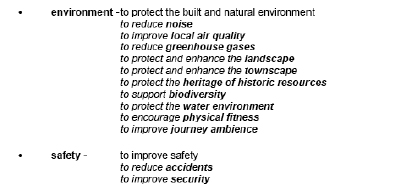
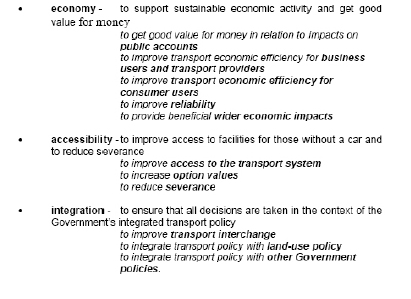
Professor Smyth, who is a Fellow of the CILT (Ireland) and was lead author of Transporting Ireland, is Head of the Department of Transport Studies at the University of Westminster, London. He was formerly Professor of Transport Economics at the Transport Research Institute in Edinburgh, and earlier completed his term as Director General at the National Institute for Transport and Logistics (NITL) in Dublin in 2006. In 1989 he was appointed to the first Chair in Transport to be established in Ireland at the University of Ulster.
Professor Smyth has thirty years experience in the transport industry, consultancy and research worldwide. He has worked for a variety of public and private sector clients in various EU States, Russia and Eastern Europe as well as North America, the Middle East and Thailand.
He has advised Governments in Ireland, the UK, Eastern Europe and the Middle East, UK Devolved Administrations and Local Authorities on transport policies, strategies and funding. Professor Smyth recently completed a study on Devolution and Transport in the UK. This addressed the potential for integrating policies across the UK and between the UK and Ireland.
He has secured commissions from a wide varieties of bodies including the European Commission, the European Economic and Social Committee, Organisation for Economic Cooperation and Development OECD)/European Conference of Ministers of Transport (ECMT), the UK’s Office of Deputy Prime Minister Department for Transport, the Scottish Executive, the Scottish Parliament, the Welsh Office, Department for Regional Development (NI), Department of Education (NI), the UK’s Engineering and Physical Sciences Research Council, the UK¹s Economic and Social Sciences Research Council, the Scottish and Northern Ireland Forum on Environmental Research (SNIFFER) and InterTrade Ireland.
He has also undertaken commissions on behalf of public transport operators in Ireland, the UK, USA, Israel and Russia in relation to urban bus and rail systems, and intercity rail schemes. He was the co author of the business case developed by Iarnród Éireann and Northern Ireland Railways in support of the upgrading of the Dublin-Belfast Enterprise rail service. He was also a member of the team that undertook the Dublin Suburban Rail Review in 2002. He advised Iarnród Éireann on its purchase of new Intercity rolling stock for the Cork and Limerick lines.
Professor Smyth has reviewed developments in regulation and competition across Europe and the US on behalf of ECMT/OECD. He has been Advisor to the EU on value for money and cost effectiveness of the EU’s Cohesion Fund transport expenditure in Ireland and on the then proposed investment in Light Rail systems. He has been engaged as an Expert Advisor to European Economic and Social Committee on economic aspects of sustainable transport and development policies and regulatory issues.
He contributed to a fundamental review of regulation of bus services in Northern Ireland and recently undertook an investigation of school transport with particular reference to regulatory and financial issues, and based on a review of practice in Scotland, Northern Ireland and the Republic of Ireland. The study identified multi-million pound efficiency savings and a more cost effective pattern of delivery. He was also a Member of the Department for Regional Development (NI) Panel charged with promoting the use of innovative funding and financial mechanisms including PPP’s. This foreshadowed the establishment of the North’s Strategic Investment Board.
Stephen Wood is a Member of the Chartered Institute of Logistics and Transport, a Transport Planning Professional and a Chartered Engineer, with over 25 years project experience, principally in Ireland and Great Britain, with particular expertise in transport strategy and plan-making.
He has recently established StephenWoodConsultancy following employment with specialist transport planning consultancies; most recently as Associate Director responsible for transport business development and delivery throughout Ireland. He was also the Principal Transport Planner with the Department for Regional Development Northern Ireland and provided extensive technical guidance and appraisal on the Railways Task Force (2001) and the Regional Transportation Strategy (2002) before Project Managing all aspects of the Sub-Regional Transport Plan (2006).
Stephen has wide recent project experience in Ireland including the preparation of Safety Strategy for RSA, major scheme Business Case for Irish Rail, promotion of major road investment for the South East Regional Authority, Expert Witness at the An Bord Pleanala hearing on Ringaskiddy Port Redevelopment, assistance on a Smarter Travel Areas Stage 2 Bid, multi-modal modelling for National Transport Authority in support of 2030 Vision in addition to preparing an integrated Transport Strategy for Derry ~ Londonderry City Region on behalf of Ilex urban regeneration company.
[1] Investment Strategy for Northern Ireland 2 (published by Strategic Investment Board)
[2] Belfast Metropolitan Transport Plan, Sub-Regional Transport Plan and Regional Strategic Transport Network Transport Plan
[3] Figures extracted from RTS Table 5.1 and make allowance for revenue expenditure. All figures in year base as published i.e. 2002, 2008, 2011.
[4] Scores are recorded as neutral / slight due to the low passenger flows expected
[5] BCR greater than 4.9 recorded in March 2009 Stage 1 Report
[6] Scheme is not included in Belfast Metropolitan Area Plan or in Belfast Metropolitan Transport Plan
[7] Source Public Transport Investment Development Plan - 2008
_2011_02_10_-_NICV_fmt.jpeg)
_2011_02_10_-_NIC_fmt1.jpeg)
_2011_02_10_-_NIC_fmt2.jpeg)
_2011_02_10_-_NIC_fmt3.jpeg)
_2011_02_10_-_NIC_fmt4.jpeg)
_2011_02_10_-_NIC_fmt5.jpeg)
_2011_02_10_-_NIC_fmt6.jpeg)
_2011_02_10_-_NIC_fmt7.jpeg)
_2011_02_10_-_NIC_fmt8.jpeg)
_2011_02_10_-_NIC_fmt9.jpeg)
_2011_02_10_-_NI_fmt10.jpeg)
_2011_02_10_-_NI_fmt11.jpeg)
_2011_02_10_-_NI_fmt12.jpeg)
_2011_02_10_-_NI_fmt13.jpeg)
_2011_02_10_-_NI_fmt14.jpeg)
_2011_02_10_-_NI_fmt15.jpeg)
_2011_02_10_-_NI_fmt16.jpeg)
_2011_02_10_-_NI_fmt17.jpeg)
_2011_02_10_-_NI_fmt18.jpeg)
_2011_02_10_-_NI_fmt19.jpeg)
_2011_02_10_-_NI_fmt20.jpeg)
_2011_02_10_-_NI_fmt21.jpeg)
_2011_02_10_-_NI_fmt22.jpeg)
_2011_02_10_-_NI_fmt23.jpeg)
_2011_02_10_-_NI_fmt24.jpeg)
_2011_02_10_-_NI_fmt25.jpeg)
_2011_02_10_-_NI_fmt26.jpeg)
_2011_02_10_-_NI_fmt27.jpeg)
_2011_02_10_-_NI_fmt28.jpeg)
_2011_02_10_-_NI_fmt29.jpeg)
_2011_02_10_-_NI_fmt30.jpeg)
_2011_02_10_-_NI_fmt31.jpeg)
_2011_02_10_-_NI_fmt32.jpeg)
_2011_02_10_-_NI_fmt33.jpeg)
_2011_02_10_-_NI_fmt34.jpeg)

Derry~Londonderry has a new Regeneration Plan to 2020 for the City and Region: One City. One Plan. One Voice. This Plan represents a new way of doing business. The Mission of the Regeneration Plan is:
“to deliver Renewal – Economic, Physical and Social, building a stronger and more vibrant economy with increased prosperity for our city and region, in ways which ensure that opportunities and benefits from regeneration are targeted towards the most deprived groups in our communities".
Our two guiding principles are: Mainstreaming Equality and Embedding Sustainability, which will drive what we do.
Equality is a cornerstone on which the regeneration process, structure and proposals have been built and will be delivered from, in order to tackle the root causes of the issues and challenges we face. Our approach stems from the Programme for Government and the Statutory Duty “to have due regard“ to the need to promote equality of opportunity and “to have regard“ to the desirability of promoting good relations, as laid out in Sections 75 (1) & (2) of the Northern Ireland Act (1998).
Sustainability is critical to our future. It helps generate investment and employment, creates cooperative change, ensures economic and social fairness and makes the city a more attractive place. It’s about enhancing every area of our lives, taking long term measures to protect our environment like recycling and reducing carbon emissions, tackling health problems such as obesity, alcoholism and drug misuse and widening our job base to reduce unemployment so together we can create a vibrant, cohesive and prosperous community.
Derry~Londonderry’s key assets remain the place and its people. The City’s strategic location on a river estuary in the North West of Ireland has defined its role historically and geographically over the centuries as the capital of the North West region.
We are UK City of Culture 2013, a University City and home to some genuinely world class companies. Our port is a vibrant export – import hub and our airport welcomes visitors and investors. Our City walls attract thousands of visitors and the re-development of the former military sites at Fort George and Ebrington will significantly advance the transformation of the City and Region. A City population of 110,000, almost 40% of whom are under 25, and a market hinterland of 300,000 are evidence of the potential that the region offers to both external investors and indigeneous entrepreneurs.
This city region (including Derry~Londonderry, Strabane, Limavady and Donegal) does however face serious challenges. It has suffered from under investment, high levels of deprivation and unemployment (the NI Executive Sub Committee preparing the new NI Economic Strategy recognising the historically high claimant rates in Derry, Strabane and Limavady) and low levels of literacy and numeracy. Health and social problems too are widespread in our more deprived wards.
In the regional and strategic context, the Strategy Board is concerned that the draft Budget proposals make no reference to the priority status of the City and the wider North West as referenced in the Regional Development Strategy for Northern Ireland and in the National Spatial Strategy as endorsed by the Government in the Republic of Ireland. Both Governments recognise the economic disadvantage of this region and in response have established the North West Gateway Initiative as a means whereby a sub-regional agenda can be addressed as a priority for Government.
The NI Executive is committed to Equitable and Balanced economic growth throughout the region. Accordingly, there must be a specific recognition of the need to address the disparities of the North West, and especially the tackling of deprivation and up skilling and re-skilling of the workforce, if we are going to achieve that equity and balance.
The Regeneration Plan for Derry~Londonderry provides an unprecedented opportunity for the NI Executive to Rebalance the Economy and address disadvantage in a holistic systematic and integrated manner ensuring that both Equality and Sustainability commitments are delivered.
However current budget plans undermine fundamentally the effectiveness of this unique planning approach which is more than the sum of its parts.
Particular priorities for Derry~Londonderry within the draft Budget Consultation are:
Opportunities to build on our Digital Strengths, our Eco-City proposals, Skills Escalator plans and Early Intervention in Health and Education underpin these priorities.
The NI Executive has a unique opportunity to support the City and the North West and get behind the delivery of this Comprehensive Framework, by ensuring an across-government approach is taken.
Previous success in terms of Integrated Development Funding should be built upon to create the enabling environment of capital and recurrent funding necessary to deliver successful Regeneration, not just to the North West but also in other areas of deprivation across Northern Ireland.
The Social Investment Fund presents a unique approach, when coupled with maximising EU funding as advocated in the Budget plan, to create a pot of up to £160m over four years. It could provide connecting finance across government activities and the outcomes would be immediate and long lasting. If this was targeted at Derry~Londonderry’s Regeneration Plan, it would address economic underperformance, individual disadvantage and put the Regeneration Plan on a different trajectory leading to much earlier success.
The economic outlook for Derry~Londonderry is challenging. Without direct, strategic intervention the levels of economic and social well-being will continue to lag behind, and indeed the gap in prosperity widen. The Regeneration Plan for Derry~Londonderry to 2020 provides the direct interventions necessary, by 2020 beginning to see the impacts of the Plan on the City, with the building blocks in place for the transformation of the City region: 12,500 net additional jobs, £465 million of additional GVA and improvements in the fiscal balance by some £200 million.
We invite the Executive, through the draft Budget 2010 Consultation Process, to partner with the North West in developing a strategic approach to redress economic imbalance and target disadvantage. It would represent an exemplar to support the strategic opportunities at Local, Regional and International levels.

Colum Eastwood, Mayor of Derry Sir Roy McNulty, Chairman of Ilex
Co-Chair, Regeneration Strategy Board Co-Chair, Regeneration Strategy Board
Northern Ireland presently faces an unprecedented challenge with constraints in public sector spending against a backdrop of the severest economic recession experienced in our lifetimes. Meeting this challenge head on, Derry~Londonderry’s Regeneration Plan provides a real opportunity to change how we do business, to re-orientate public sector expenditure within the City in ways which can deliver both value for money and a high rate of internal return, as well as contributing to reducing inequalities, enhanced productivity, increased value added and the improvement of the overall fiscal balance of the North West within Northern Ireland.
The Investment Strategy that will accompany the final Regeneration Plan will identify sources of funding for the delivery of programmes, including maximising resources across Government, the identification of new sources of funding, including the private sector, and the sourcing of additional funding from within the EU.
The Plan is securely grounded on robust, non-dismissible socio-economic research highlighting the challenges and opportunities that Derry faces within the next two decades. In essence, it provides a roadmap for recovery for the City. The forecast outcomes from the plan, which have been tested within the Econometric Model, show a dynamic Derry~Londonderry by 2020 with a population of 120,000 living here, 12,500 more people in employment, almost ½ billion in additional wages and profits and a significant improvement in the fiscal balance of almost £200m.
This contrasts starkly with the inequalities currently evident in the areas of employment, education and health. The data presented within the Plan shows that in some wards only one in three citizens are in employment, individuals are twice as likely to die before the age of 75, and young people have only a 1 in 10 chance of proceeding to third level education.
The North West economy witnessed a major decline in its economic fortunes during the last ten years with the rapid contraction and closures within traditional manufacturing sectors. These have included Seagate Limavady, Desmond’s Clothing Claudy, Arntz Belting Derry and Adria Strabane with the loss of thousands of jobs. It must be remembered that this economic shock for the North West occurred at a time in which the rest of NI experienced economic growth rates which ranked it amongst the best regions of the UK.
The net effect today of the industrial restructuring that took place West of the Bann is illustrated in Graph 1. This clearly shows the extent to which the area is in decline with Derry~Londonderry’s, Strabane’s, and Limavady’s claimant count rate all significantly higher than the NI average, ranking 1st, 2nd and 3rd worst within NI during December 2010.

Not alone does Derry~Londonderry’s present situation rank poorly in NI terms but Oxford Economics’ evaluation of its performance within the 86 major urban conurbations in the UK places it no higher than 83rd out of 86 on all of the key economic metrics, including economic activity rates, gross value added and resident employment.
This bleak assessment is reinforced by the latest figures released by INI (Jan 2011) in relation to assistance given to externally owned clients, showing that only 116 new jobs in total were created during the last two years 2008/2010 in the DCC area and within the programme for locally owned businesses, rates of start-up have fallen to 40% of their peak in 2004/5.
A second-city requires a number of elements to provide the ‘critical mass’ which can ensure that it achieves the foundations for a sustainable City Region. These elements can lead to population increase, improvements in the value and volume of jobs and demand for high level skills. The elements are a University of appropriate size, a regional hospital, an airport, good external and internal transport links, a well qualified workforce, vibrant arts and culture infrastructure and a good quality of life e.g. recreational and leisure provision and personal security.
The Plan is based on eleven Catalyst Programmes designed to address the inequalities, needs and challenges that Derry~Londonderry faces between now and 2020 and build on the particular strengths of the City including its young population, its Digital uniqueness, the unique opportunity of UK City of Culture 2013, and the University. The Catalyst Programmes are as follows:
These programmes have been chosen for their ability to deliver transformational change, contributing to our objectives of creating employment and reducing inequality. Rather than being aspirational in nature, as many regeneration plans tend to be, it is founded upon a robust evidence based approach, including a comprehensive statistical baseline, a bespoke econometric model developed by Oxford Economics and the involvement of all stakeholders (over 1,000 people) within the city including the public, private and community/voluntary sectors.
The ‘silo’ like approach which appears to be applied to drafting departmental budgets ignores the significant existing regional differentials in employment/unemployment/economic activity, education, health, transport and telecommunications particularly evident in the North West. All of these have direct equality impacts in the areas of access to employment, training, health and service provision.
Taken together they pose a real threat to the delivery of successful regeneration within Derry~Londonderry as the Plan, which is integrated and holistic in impact and approach, which requires a similar response from Government such as the creation of an Integrated Development Fund type approach which builds on the successful model of the past. This would help mitigate the adverse impact on the eleven catalyst projects, a number of which could be seriously undermined by the draft budget 2010. These include, in particular, higher education expansion, in particular the University, the UK City of Culture Framework 2013, implementation of the Integrated Transport Strategy, and the provision of specialist radiotherapy services at Altnagelvin Area Hospital.
Furthermore, such a Fund (which considered both capital and re-current funding) would maximise the opportunity for effective investment, employment and generally tackling disadvantage leading by 2020 to the creation of 12,500 additional jobs, an increase in GVA of £½bn and a fiscal improvement of almost £200m.
The future expansion of Higher Education (HE) in the city is vital to future prosperity, and has widespread cross community and cross party support. Any increase in fees would be regressive in nature and, in an area with such high levels of benefit dependency, any diminution in support for students from low income households will perpetuate inequalities which are in contravention to the aims of the budget. The relocation and new school facility for Foyle and Londonderry College is of strategic importance. Any delay in the Foyle and Londonderry College project will likely have a knock on effect on the physical expansion of the University.
Because we know that those who attend 3rd level institutions are much more likely to remain within commuting distance for the majority of their lives, this University expansion plan also assists in providing a pool of skilled labour for local employers and inward investors, as well being a significant employer in its own right. The outworkings of the consultation on the development of a Higher Education Strategy for NI recognises the importance of access and retention rates as significant issues, with the Step-Up model cited as an exemplar of best practice. In particular, support for the development of R+D and its commercialisation will also be vital to economic growth, as will continuing support for the FE and HE and schools interface to deliver a joined up skills escalator approach.
The econometric modelling has forecast that, in the absence of this intervention, the City will quickly face a higher level skills shortage, negatively impacting upon the development of the proposed North West Science Park at Fort George. Additionally, this shortage will likely result in increased numbers of inward commuters reducing the positive multiplier effects of the investment, and missing the aim of targeting disadvantage. The acceleration of the Clinical Translational Research and Innovation Centre located within Altnagelvin would also be affected negatively as it is intimately linked with the expansion of the University.
The Regeneration Plan targeted the expansion of Higher Education, particularly the University to 9,400 full-time equivalent places. A major first step in the current proposal is a substantial expansion in Higher Education provision at the University of Ulster’s Magee campus, and at the North West Regional College. This proposition is an essential component of the economic, physical and social renewal of the City.
Any slowdown in delivery relating to the University expansion will have a extremely negative effect, not only upon the availability of high level skills within the city, but also upon the positive multiplier effect that these produce when delivered simultaneously.
We ask Government to provide this first step of delivering a 1,000 increase in MaSN targeted at Magee in the current budget period.
The Regeneration Plan recognises and harnesses the importance of culture as a tool in delivering regeneration which can also assist DCAL in delivering on its overall aim
to deliver economic growth and to enhance the quality of life in Northern Ireland by unlocking the full potential of the Culture, Arts and leisure sectors.
Relevant flagship projects include Quality Spaces and Places, Children and Young People, Digital Derry and Early Intervention in Health and Education. Of particular significance is Derry~Londonderry’s success in becoming the first UK City of Culture in 2013 which received departmental and NI Executive endorsement.
Delivering ‘sustainable economic growth’ is one of the stated aims of DCAL as is ‘balanced regional development’. The Regeneration Plan for Derry~Londonderry clearly identifies the need for investment in sports and sporting facilities in Derry. In addition there are no centrally funded regional cultural facilities in the City. A Strategic Outline Case for the re-development of the Clock Tower building at Ebrington in support of delivering successfully UK City of Culture 2013 is currently under consideration by DFP.
Derry~Londonderry is working with Belfast City Council and a number of key agencies on a strategic response to the events and opportunities across 2012, including the anniversary of the Titanic and the opening of the Giant’s Causeway Centre and the Clipper Round the World Race, and in 2013 with City of Culture and the World Police and Fire Games. If only one event is supported, NI will lose a significant strategic opportunity at local, regional and international level to put on a world class programme and series of events over the two years that can be marketed to an international audience.
UK City of Culture is a year-long ‘event’. The economic impact of this accelerator project identifies the potential for doubling tourism, delivering over 900 net additional new jobs in 2013 alone and building on the legacy, increase net new jobs to 2,800 in 2020 (with 2,300 more residents employed and over 1,000 from the bottom half of the most deprived wards in the City ). This is approximately one fifth of total net new jobs targeted in the Regeneration Plan for Derry~Londonderry with consequent reductions in government financial support towards those unemployed and economically inactive. The City of Culture in 2013 will benefit the NI economy directly by contributing overall £98 million in additional GVA and fiscal improvement of £63 million in 2020 (out of a total improvement of £200 million) and £43 million in 2013, directly attributable to City of Culture 2013.
With the focus in the Regeneration Plan on the creative and digital economy we welcome the £4m Creative Industries Fund and in particular the potential opportunities to support Digital Derry initiatives.
The issue of sequencing of capital spend is a prominent issue in the delivery of the City of Culture to ensure the legacy of the CoC year is consolidated going forward. Oxford Economics stress that, if we are to ensure that the potential gains of the 2013 year in terms of GVA and jobs are maximised, capital and recurrent support for skills programmes and marketing in tourism are also required. We welcome the commitment to provide £4m capital for developments relating to Ebrington from the NITB for City of Culture. However, this is currently placed in 2014 and could usefully be front loaded.
The private sector has been galvanised by City of Culture, as reflected in five new planning applications pending or submitted within the Derry~Londonderry region for accommodation for example, illustrating the extent to which the private sector are weighing in behind the opportunities that the City of Culture presents. The public sector, including DCAL and NITB, need to support and encourage such initiatives especially in the current economic climate.
Accordingly, we are asking for a resource to enable effective Marketing and Programming of an international standard, and the sequencing of capital funds to be reconsidered.
The Regeneration Plan has taken a long-term ten year view of the needs of the City and the North West (including Derry, Donegal, Strabane and Limavady) region including Donegal, Strabane, Derry and Limavady. It has identified a number of key physical infrastructural projects that are vital to enable the North West to compete effectively and equitably with the rest of NI and the other UK regions including rail, A5 and A6, public transport and the airport.
The population projections within the plan forecast an additional 10,000 individuals within the city by 2020. When coupled with the peripherality of the region, and the current state of existing infrastructure, this creates immediate challenges.
The flagship Integrated Transport Strategy proposed aligns with DRD priorities and ensures balanced regional growth as highlighted in the draft Regional Development Strategy. One of the key objectives of the strategy is to achieve a behavioural shift from the private car to other forms of transport. By offering a fully integrated and accessible network people have more attractive and efficient modes of travel to choose from and are less likely to rely on private transport and align with the City’s commitment to sustainability.
The strategy seeks to address barriers to good relations, which will be further enhanced through the cross linking of bus services. It will also provide positive benefits to those living in the rural hinterland, on both sides of the border, by addressing barriers to employment, education and other key services through the enhancement of a range of feeder services which include accessible and rural transport services and taxis. The proposals for the A5 and A6 roads schemes are a core part of the Integrated Transport Strategy and any suggestion that the A5 and A6 roads be rescheduled or de-prioritised will impact adversely on the Regeneration Plan proposals. The expansion of the University, the attraction of inward investment, our ability to retain graduates, and our commitment to building our cultural tourism product, will all be compromised by any proposals to slow down the delivery of these key infrastructure projects.
The Regeneration Plan, in terms of Equality and Sustainability, places great emphasis upon the replacement of private transport by public transport solutions throughout the city. If public transport services are curtailed, or if fare increases are put into effect, especially if they take place before 2013, we will have lost a unique opportunity to demonstrate the effectiveness of public transport in moving large numbers of individuals quickly and efficiently and giving local people in disadvantaged neighbourhoods access to employment and services, both urban and rural.
We ask that Government delivers in full on the Integrated Transport Strategy for Derry~Londonderry and the North West Region.
As Health is a flagship within the Plan, of particular concern is the completion of the Satellite Radiotherapy Unit which was expected not only to directly benefit patients within the North West through the improvement in health outcomes, but was seen as complementing other key initiatives including the Clinical Translational Health Centre. Inability to staff the Satellite Radiotherapy Unit will have a significant detrimental impact upon all of these related initiatives. Furthermore, the focus in the Regeneration Plan on the Healthy City Status and Early Intervention is expected to reduce the rate of Premature Mortality within the city where, for example, within some wards lung cancer rates are amongst the highest in NI and the Mortality Rate for those under 75 years of age is almost twice that of the NI average.
We ask that recurrent resources are found to support the Satellite Radiotherapy Unit.
The strength of the One City, One Plan, One Voice lies in the evidence base upon which it is founded, the involvement of all of the key stakeholders in its formulation, and its thorough testing within Oxford Economics’ Econometric Model which proves the robustness of the catalyst programmes as drivers of real change. The prizes of an improved fiscal balance, reducing inequality and embedding sustainability, can be achieved even at this time of constraints within public sector funding, but only through the targeted support of the NI Executive working in partnership with the North West to deliver our mission and achieve the aim of the Strategy Board:
“to deliver in Derry the best regeneration any City in these islands has ever seen"
Margaret Ritchie, Minister,
DSD, November 2007
We believe that the development of, for example an Integrated Development Fund or similar targeted at regeneration would create the opportunity for the Executive to respond creatively to resolve entrenched problems facing not just the North West but Northern Ireland as a whole.
_2011_02_16_-_1_Su_fmt.jpeg)
_2011_02_16_-_1_S_fmt1.jpeg)
_2011_02_16_-_2_Su_fmt.jpeg)
_2011_02_16_-_2_S_fmt1.jpeg)
_2011_02_16_-_2_S_fmt2.jpeg)
When DRD Minister Conor Murphy invited comment on his Draft Budget 2011 – 2015 he asked “that people include in their responses a stated view of how they best believe spending should be allocated and income generated."
I quote from his statement made in Dungiven on 6th May 2009 at the announcement of the Preferred Route for the A6 Derry to Dungiven dualling scheme. “Tackling regional disparities and reversing decades of under investment west of the Bann is vital. This investment is central to the Executive’s priorities for Derry and the North West as a whole in maximising and realising its full economic potential."
So it was with disbelief and great disappointment that Dungiven Bypass Committee received the news of the Ministerial decision not to include the bypass/A6 improvements in his Draft Budget.
The decision to proceed with major improvements to the A5 and A8, criticised by NICVA overview of the budget, means the overdue bypass will again be put on the long finger.
In May 2009, completion of Stage 2 in the planning process for the A6 improvements was reached months ahead of the A5 and A8 schemes. Forward to 2011 and the A6 project has been overtaken to the extent that tendering has already been finalised for the A5 scheme.
Puzzling indeed when we consider the distances involved – A6 (30km) and A5 (85km).
We could be forgiven for believing that the Minister’s fixation with financial assistance of £400m from the Dublin Government in the A5 and A8 schemes has led to his decision to exclude the A6 project from the Draft Budget.
It would serve no useful purpose for me to go on at length about assurances given, by officials at all levels, that a start date of 2013 could be expected for the bypass.
Sufficient to say that fifty years on from 1966 (2016) and the people of Dungiven will still await a start date for the bypass.
Yours in anticipation of nothing much happening,
Chairman

February 2011
This document is also available in alternative formats. To request a copy in an alternative format or for any other queries please see the “Contact Us" section of this response or visit our website at www.imtac.org.uk.
1 Imtac is a committee of disabled people and older people as well as others including key transport professionals. Our role is to advise Government and others in Northern Ireland on issues that affect the mobility of older people and disabled people.
2 Our aim is to ensure that older people and disabled people have the same opportunities as everyone else to travel when and where they want.
3 Imtac receives support from the Department for Regional Development.
4 Imtac recognises the unprecedented financial constraints which form the background to the Budget proposals. The Committee understands that the DRD has had to make difficult decisions which in normal circumstances the Department would not want to contemplate. Whilst understanding the pressures on the Department to make savings we must balance our comments with the requirement to represent the best interests of disabled people and older people.
5 The Committee notes that the Department has recognised in the consultation that the measures contained in the draft Budget could potentially have a negative impact on disabled people, older people as well as other Section 75 groupings. We also note that lessening the impact on these groupings was a major consideration on spending decisions. Finally we note that the EQIA indicates a negative impact on Section 75 groupings including disabled people and older people but assesses this impact as low.
6 Imtac would challenge this assessment on a number of grounds. Firstly even a cursory examination of the draft Budget identifies that most of the measures involving transportation services will hit disabled people, older people and other section 75 groupings disproportionally. In financial terms the proposals represent a significant percentage cut in the overall budgets of both the Transport Programme for People with Disabilities and the Rural Transport Fund. The loss of almost £9.5 million in public transport subsidy will again disproportionately impact on Section 75 groupings.
7 Listing the impact of savings in these areas highlights just how the savings will affect people and raise significant questions over whether the assessment of low impact is justified. Savings will mean:
8 Imtac notes that the statistical evidence used by the Department to assess the equality impacts of the draft Budget strongly indicates that the proposed savings impact most on disabled people, older people, younger people, women and people with dependents. The Committee responds to many such consultations and it is rare that statistics show such clear impacts on equality groupings.
9 The Committee does believe that use of further quantitative and qualitative data would reinforce what is already strong evidence of significant negative impact. Firstly the Department should have highlighted readily available census data on car ownership in Northern Ireland. This indicates that a significant minority of households in Northern Ireland do not have access to a car. Both census data and household surveys indicate that both older people and disabled people are less likely to have access to a car than others in society. On the wider issue of social exclusion there are clear correlations between car ownership and areas of deprivation in Northern Ireland (highlighted in the development of the revised draft Regional Development Strategy). It is clear from the evidence available around car ownership figures that measures to reduce transport services for people with no access to a car will increase social exclusion and inequality in our society.
10 This is confirmed by analysis of other evidence undertaken into the link between social exclusion and transport. Work undertaken[1] by the UK Government has confirmed the link between transport and social exclusion. This work has clearly illustrated that poor access to transport severely restricts the opportunities of many in our society to participate in day to day activities, contributing to poverty and inequality. The groups most liable to be effected exactly mirror the groups identified by the Departments own EQIA. The report identifies the barriers which make getting around difficult for people. These barriers include the availability and affordability of transport. Locally the DRD has undertaken its own work into the specific difficulties faced by older people and disabled people accessing transport. The Accessible Transport Strategy (2005) contains an excellent analysis of why disabled people and older people find accessing transport difficult and the effects of poor access to transport. It is disappointing that the Department did not use readily available qualitative data when assessing impact. We believe the use of such data would indicate that the proposals contained in the draft Budget will have a significant not low impact on the Section 75 groupings identified.
11 The Department has justified many of the savings by indicating that the current services do not offer value for money and by implication are not valued by users. Imtac believes the evidence used by the Department to make this assessment is questionable. Take the proposal to largely restrict door2door transport to core hours – Monday to Friday 9am to 5pm. It is clear that in general people travel less in the evenings and at night so it should not surprise the Department that less people use the service then. However we have looked at data[2] around usage and find that in a significant number of locations there is considerable usage of the Scheme after 7pm (over 20% of journeys made in some places). It should be noted that the figures do not allow calculations to be made from 5pm to 11pm or from 7.30am to 9am, or weekends. However Disability Action has indicated that out of hours usage of the Belfast service accounts for over one third of journeys made. Clearly this evidence contradicts the Departments justification for making the changes. It also indicates that the change will have a significant impact on the many disabled people and older people who use the service during these hours. A fairer approach would be to look at operating hours for the scheme in areas where usage out of core hours is very low.
12 Imtac would also question the decision to remove or reduce funding for Translink bus services under both TPPD and RTF. We base this on both value for money and the impact ending such services will have on passengers concerned and other passengers. From a value for money perspective a service that can pick up multiple passengers is more efficient than a door to door type service. This is borne out by a comparison of the costs per trip on door2door services and Easibus services for example (around £15 per trip compared with under £2). From the passenger perspective public transport services can be relied on to run at set times and on regular routes unlike door2door and rural Dial-a-lift which must be booked and is not always available. Removing these services will also place a greater burden on door to door transport services already struggling to meet demand.
13 These issues have already been illustrated by the removal of Easibus services in Derry and Bangor. We have heard from disabled people in Bangor who have found getting out much more difficult since the service ended with door2door nigh on impossible to book because of demand. In Derry demand for the door2door service has risen since the removal of Easibus with an increase in the number of refusals in bookings.
14 It would appear from the draft Budget that the DRD believe that the transportation needs of older people and disabled people can be best met by the concentration of resources into “many to many" door to door services. For some time now Imtac has argued that this approach is the least efficient, most expensive approach and does not fully utilise the resources available to the Department. We have commended the Department for the investment in accessible public transport here. The accessibility of our bus and rail network compares favourably with many other areas of these islands. Imtac believes that there is the potential to encourage the greater usage of public transport by older people and disabled people if the correct support measures are put in place. In the longer term we believe an approach that maximises the usage of public transport and minimises the usage of alternative services to those who cannot access other services is the most cost effective approach for Government and delivers the greatest benefits for passengers.
15 Imtac is frustrated that the Department does not appear to recognise the potential of such an approach. It is worrying that the Department does not recognise that services such as Easibus can represent a low cost alternative to door2door as well as complementing existing town services. Most worrying of all is the potential long term damage the loss in subsidy to Translink could have to increasing the usage of public transport by older people and disabled people. Imtac is aware that Translink face other budgetary pressures including £5 million of savings from the Departmental of Education transport budget and rising costs such as fuel. We are concerned that the cumulative effect of these pressures and the savings imposed by DRD will mean significant reductions in services and rising fares. All evidence shows that this will impact on disabled people and older people and make use of public transport much more difficult. It will also increase demand on services such as door2door which cannot be met under the proposed funding.
16 Whilst the draft Budget indicates the probability of service reductions and rising fares on public transport the Committee cannot make any assessment of the impact of the savings in public transport until more detail are provided by Translink. We are concerned that the current budget is incomplete and that when Translink brings proposals forward they may indicate a more significant negative impact on equality groups.
17 Many people in deep rural areas will not be able to access conventional public transport even if we could afford substantial additional investment. In this respect the relatively new rural dial-a-lift service is a welcome service. However Imtac is concerned that the resources allocated in the draft Budget will limit the development of this service, as it will not be sufficient to target the service at those people who need it most.
18 Imtac also has concerns about removing support for Shopmobility services and group services. Shopmobility provides a vital link in the transport chain. The services they provide mean many older people and disabled people have the independence to enjoy our towns, cities, shopping centres, and in some cases the countryside. Schemes receive a relatively small amount of funding from DRD which only partly meet their costs, mainly by funding staff essential for managing and developing schemes. The grant made by the DRD is significant in persuading other funding bodies to contribute and can leverage investment in the services, encourage volunteering and provide additional services for users including advice for people on a range of issues. It should also be noted that there are a number of new schemes which are still finding their feet. Taking all this into account Imtac is concerned that the Department are targeting “under performing" Shopmobility services. Imtac would ask that the Department make clear what criteria is to be used to establish whether is a scheme is performing or not and in addition confirm that consideration be given to continue funding newer schemes to allow an opportunity for services to become established.
19 Many organisations of older people and disabled people avail of group service supported by the RTF and TPPD. These services are low cost and importantly the only accessible transport available. Imtac agrees that priority should be given to providing transport to individuals. However we are concerned that the complete removal of support for group services will have a significant impact on disabled people and older people, particularly as there are relatively few accessible alternatives. We also do not believe there is evidence to support the Departments justification for removing services claiming groups can find other sources of funding for transport elsewhere. A quick check with NICVA would highlight that many community and voluntary groups have been hit hard by the recent financial climate and resources are a major issue.
20 The Committee welcomes the decision not to make savings that directly affect users of the Concessionary Fares Scheme. However it is likely that reduced public transport services will indirectly negatively impact on users of scheme.
21 Imtac acknowledges that other saving/income generating proposals will have an impact of disabled people and older people. The Department correctly identifies the extension of parking charges as one. We would agree that the Blue Badge Scheme does offer a degree of protection from these changes and would ask that a commitment be given to retain the concession currently enjoyed by holders. We also agree that maintenance savings have the potential to impact on the mobility of disabled people and older people. We would ask that where risks/hazards have been identified that present a barrier to older people and disabled people that priority be given to removing these barriers.
22 Imtac also has concerns about the reliability of income generating proposals included in the draft Budget. We are concerned that if anticipated income levels from parking charges and the Belfast Harbour do not materialise further savings will have to be found from DRD supported services. Given current proposals it is inevitable that further savings will again impact on disabled people, older people and other equality groupings.
23 We would ask the Department to consider three long-term trends that make short-term savings in transportation services potentially more damaging. The first is the projections for rising numbers of older people in the future. It is likely that demand for transportation services will rise over the next decade. Saving proposals will leave us unprepared to meet this demand. The second factor is the sustainability of moving forward based on proposals that are based on encouraging greater car usage. Climate change and the rising costs of fuel makes rolling back on the progress made to date to provide an alternative to car usage ill advised. Finally demographic trends indicate a rapidly increasing rural population here. Given other trends we have raised we must start to think about how we develop better solutions for rural communities.
24 These wider issues underpin much of the strategic thinking emerging from the DRD through revisions of the Regional Development Strategy and Regional Transportation Strategy. The savings envisaged by the draft Budget will set progress back considerably from the current situation and make change in the long term much more difficult.
25 From a wider Government perspective the draft Budget does not meet the strategic priorities of the Executive to promote inclusion, health and well being. The short-term approach of making savings that reduce the availability and increase the affordability of transport services will have knock on impacts on other Departmental budgets. All evidence indicates that poorer access to transport will make accessing employment, training and key services such as health more difficult. The results of this in the short and longer term is greater pressure on the budgets of other Departments as more people will be economically inactive and require support in terms of additional benefits, health and social care.
26 Imtac recognises that the DRD faced difficult choices when looking to make savings. However we believe the Department has seriously under estimated the impact of proposals to take around £13.5 million out of transport services. We believe that all available evidence shows that these savings will hit vulnerable groups (including disabled people and older people) hardest by reducing the availability of services and increasing the cost of transport. There is a stark contrast on the impact of the saving proposals on those who have access to a car and those who do not. People who have access to the car will admittedly face increasing parking charges but otherwise will be able to enjoy the same level of mobility as currently exists. People without access to a car will face a reduced ability to travel and will have to pay more to do so. Based on this analysis the Budget is unfair and will increase inequality in our society. Our key recommendation is that the Department consider reallocating some of the resources identified for roads to transportation services to redress the inequalities created by the Draft Budget.
27 As a matter of urgency the Committee would ask the Department to look again at the savings proposed for transportation services with a view to reducing the impact on all the services involved. These services are essential to the current mobility of older people and disabled people and we believe the impact of the proposed savings could set us back 15 years.
28 In the longer term Imtac believes the Department must look again at its current approach to reducing social exclusion, moving away from the current focus on alternative services. It is imperative that we make best use of the resources we have and in particular the massive investment made in improving public transport services. We would like to start discussions with the Department and other stakeholders about how we can encourage more older people and disabled people to use public transport whilst at the same time reducing the demand for more expensive alternative services as well as looking at targeting other resources better including the Concessionary Fares Scheme.
29 Finally in the current climate it is also essential that we make efficient use of all available transport resources including those provided by other Government Departments. Serious discussions need to begin about how Departments and transport providers can share resources to deliver the best possible services to people and communities within heavily constrained budgets.
30 If you have a query about this document or would like it in another format you can contact us at:
Enterprise House
55-59 Adelaide Street
Belfast
BT2 8FE
Telephone: 028 9072 6020
Textphone: 028 9072 6016
Fax: 028 9024 5500
Email: info@imtac.org.uk
Website: www.imtac.org.uk
[1] Making the Connections: Final Report on transport and social inclusion (Social Inclusion Unit 2003)
[2] Taken from statistics included in the current tender document for Door2door services
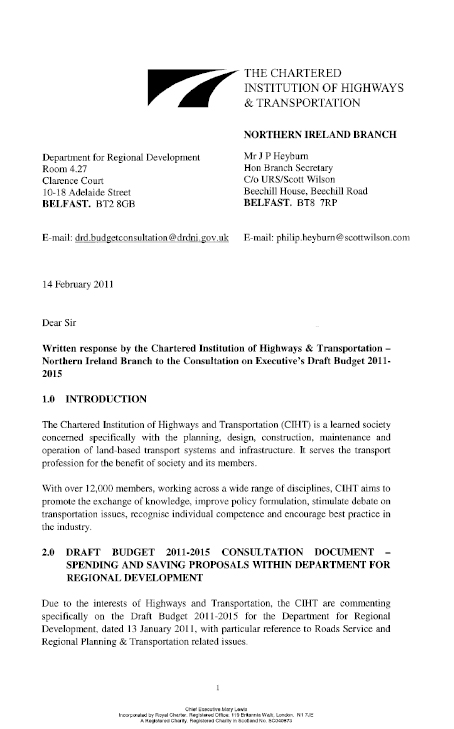
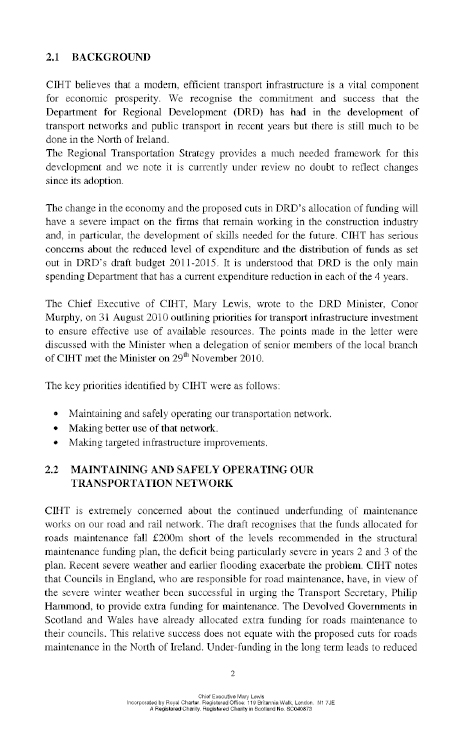
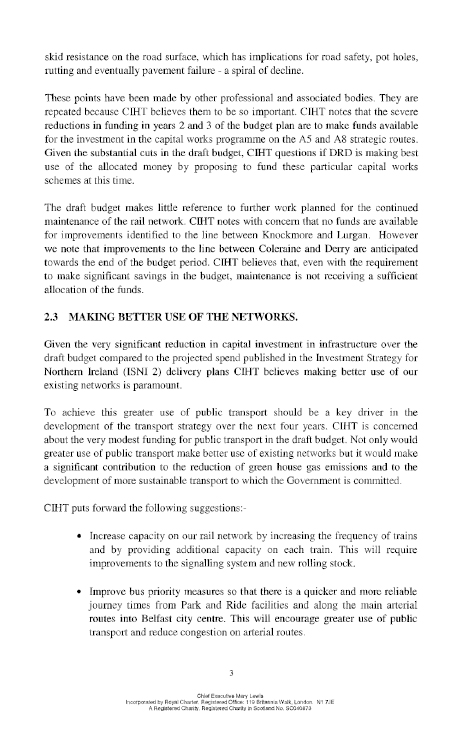
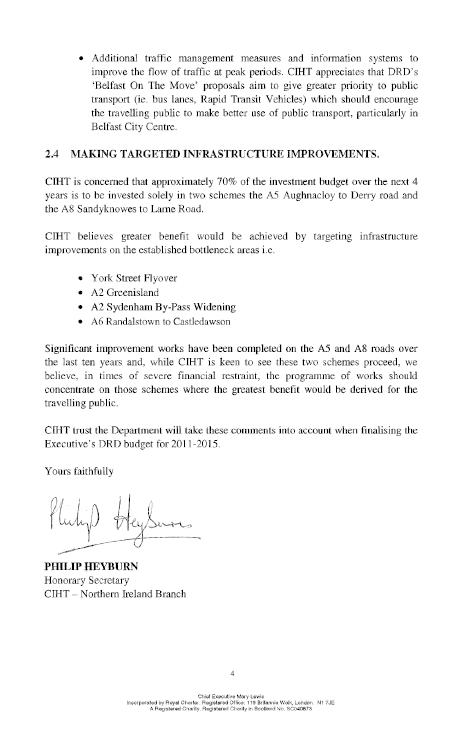
February 2011
Executive Summary
1. Background
2. Role and Purpose of BHC
3. Legal Consultation
4. BHC’s Corporate Plan 2011 – 2013 Investment Expenditure
5. BHC Extended Powers and Public Corporation Status
1. Belfast Harbour Commissioners (BHC), together with DRD, has been requested by the Budget Review Group (BRG) to consider “options", excluding privatisation, for the “release of resources" to assist the NI Executive.
2. BHC, whilst wishing to assist the NI Executive, is however required to consider the request within the context of its legal and constitutional standing as a statutory corporation independent of, and not owned by Government, with its powers and duties prescribed by legislation.
3. Legal advice obtained by BHC, which accords with DRD’s initial view, advises that resource release options such as Appropriation, Dividend, Levy and Mutualisation are not currently within BHC’s powers and duties as prescribed by legislation.
4. The only legal method for BHC to “support" the NI Executive is by projects which are within the vires of BHC, have a Harbour benefit and consequently create value for the NI Economy.
5. The Attorney General’s office and BHC’s legal advisors are currently engaging in a review of the legal position.
6. BHC’s 2011-2013 Corporate Plan includes £92m of Investment Expenditure which will not only benefit the Harbour itself but will also deliver significant value and benefit for the NI economy through project construction and ultimate end operation/use with consequent direct and indirect economic multiplier benefits.
7. Such Investment Expenditure includes:
a. The recently announced £40m DONG Energy offshore wind farm logistics project which will be the catalyst for the creation of a Marine Energy Park for Belfast and sustain 150 construction jobs and create up to 300 new jobs when in operation.
b. The extension of BHC’s Grain and Animal feedstuffs facilities to ensure that NI’s food and drink sector has the scale and competitiveness to continue to compete and achieve growth in the global market and sustain its 80,000 sector related employment.
8. In addition to marine infrastructure development projects BHC will, during the Plan period, also undertake a £5m investment in facilities to accommodate the expansion of the NI Science Park thus helping to realise the economic potential of this sector.
9. BHC does not receive any public funding. All cash and other assets held by BHC are raised from Harbour Users and held for the statutory purposes of operating the Harbour Undertaking. These assets are therefore for a particular purpose and are not free to be used for non-harbour purposes. Appropriation of such assets could lead to a challenge by Harbour Users.
10. BHC’s 2010 year end investment cash position is £58m however this is already committed principally to two projects - £11m to the Titanic Signature Project and £40m to the DONG Energy project.
11. Net cash generated from BHC’s operations after maintenance expenditure and available for development projects is currently £10m per annum. Notwithstanding the absence of powers to release cash to the NI Executive the £15m allocation in the DRD draft budget in years 2013 and 2014 would exceed BHC’s net annual cash generation.
12. BHC’s Corporate Plan Investment Expenditure of £92m will be self financed. Any potential release of cash to the NI Executive could thus curtail the development plans of BHC with associated diminution of benefit to the NI Economy.
13. The NI Trust Ports have pre-existing borrowing powers within their legislation, which are available for use. The use of such borrowing powers may result in PCS (Public Corporation Status) accounting challenges for DRD. Such challenges would be removed if legislation was introduced.
14. In June 2006 DRD commenced a wide ranging consultation on Ports’ Policy in Northern Ireland. In February 2008 this process was concluded with the Minister’s statement to bring forward legislation to remove NI Trust ports from Public Corporation Status and to provide additional commercial powers but at the same time safeguarding Trust ports public interest obligations. Although the relevant Harbour Orders legislation has been drafted, it has not yet been introduced to the Assembly.
15. A recent CEBR economic impact assessment of how BHC’s activities support the NI economy concluded that BHC directly and indirectly supports 186,000 jobs- 27% of NI’s employment – and £7.4bn of Economic value generation - 31% of NI total.
16. Without powers to release resources directly, the introduction of legislation to extend BHC’s commercial powers and remove it from PCS (Public Corporation Status) classification would enable BHC to enhance and maximise this contribution to the NI Economy via participation in a wider range of projects.
1.1 The NI Executive Budget Review Group (BRG) has requested the Department of Regional Development (DRD) to explore options, excluding privatisation, for value release by BHC to the NI Executive.
1.2 On 10 December 2010 the DRD Permanent Secretary wrote to BHC on behalf of the BRG to ask BHC to examine, with DRD, potential options to release resources to assist the NI Executive.
1.3 Consideration of the request was agreed at the BHC Board Meeting of 14 December 2010 with the BHC Executive to obtain legal advice on the powers of BHC to release resources and any constraints or procedures attaching thereto. The matter to be returned to the BHC Board on 22 February 2011.
1.4 On 13 January 2011 the DRD published its Draft Budget 2011 – 2015 for consultation. The Draft Budget includes a total receipt to DRD from BHC of £30m in 2013/14 and 2014/15, (£15m each year).
1.5 On 7 February 2011 BHC Chairman, Finance Director and Commercial Director met with the First Minister, Deputy First Minister, Regional Development Minister and Minister for Finance to further discuss the Budget Review Group’s request.
1.6 On 8 February 2011 BHC Chairman, Finance Director and Commercial Director appeared before the DRD Committee inquiring into the background to references to BHC within the draft DRD budget.
2.1 BHC is a Statutory Corporation (commonly referred to as a “Trust port"), which is independent of, and not owned by Government. The Constitution of BHC is established by the Belfast Harbour Acts and Orders 1847 to 2002 plus any relevant Public General Acts. The Statutory purpose of BHC is to manage and develop the Harbour Undertaking.
2.2 BHC, in common with other Trust ports, does not have shareholders or owners. Trust ports are not trusts in the legal sense nor are Trust port Boards trustees in that sense.
2.3 DRD defines Trust ports as:
“autonomous, self-financing statutory bodies whose constitutions are set out in legislation. They operate on a commercial basis with the profit generated by their activities reinvested to improve their facilities."
2.4 DRD is responsible for Trust ports’ policy and the legislative framework within which ports operate. In addition DRD appoints the chairmen and members of the Trust ports.
2.5 Although independent of Government, BHC is subject to a comprehensive regime of public accountability, of which the following are key characteristics:
2.6 DRD also has the power to compulsorily privatise BHC.
2.7 The role of BHC in the N Economy is significant - a recent CEBR economic impact assessment of how BHC’s activities support the NI economy concluded that BHC directly and indirectly supports 186,000 jobs- 27% of NI’s employment – and £7.4bn of Economic value generation- 31% of NI total.
3.1 BHC has sought legal advice from Bircham Dyson Bell, one of the UK’s leading Parliamentary and Public Law firms with extensive experience in Harbour legislation.
3.2 Bircham Dyson Bell’s legal advice to BHC has been shared with DRD. Such advice accords with the Department’s initial views and in essence, concludes that there is no legal means for transfer of assets, including cash, from BHC to Government neither by direct transfer nor arising from a process of constitutional change to BHC’s corporate structure.
3.3 The only current legal method for BHC to support the NI Executive is by projects which are within the vires of BHC, have a Harbour benefit and consequently create value for the NI economy.
3.4 The Attorney General’s office and BHC’s legal advisors are currently engaging in a review of the legal position including the potential for legislative change.
4.1 BHC’s Corporate Plan 2011-2013 (Appendix) includes Investment Expenditure of £92m for Port Development projects which will not only benefit the Harbour itself but also deliver significant economic gain for the NI economy through construction jobs and job creation arising from end operation/use with consequent direct and indirect economic multiplier benefit.
4.2 Such Investment Expenditure includes:
a. The recently announced £40m DONG Energy offshore wind farm logistics project which will be the catalyst for the creation of a Marine Energy Park for Belfast and sustain 150 construction jobs and create up to 300 new jobs when in operation.
b. The extension of BHC’s Grain and Animal feedstuffs facilities to ensure that NI’s food and drink sector has the scale and competitiveness to continue to compete and achieve growth in the global market and sustain its 80,000 sector related employment .
4.3 In addition to marine infrastructure development projects BHC will during the Plan period also undertake a £5m investment in facilities to accommodate the expansion of the NI Science Park thus helping to realise the economic potential of this sector.
4.4 BHC does not receive any public funding. All cash and other assets held by BHC are raised from Harbour Users and held for the statutory purposes of operating the Harbour Undertaking. These assets are for a particular purpose and are not free to be used for non-harbour purposes. Appropriation of such assets could lead to a challenge by Harbour Users.
4.5 BHC’s 2010 year end investment cash position is £58m however this is already contractually committed principally to two projects - £11m to the Titanic Signature Project and £40m to the DONG Energy project.
4.6 Net cash generated from BHC’s operations after maintenance expenditure and available for development projects is currently £10m per annum. Notwithstanding the absence of powers to release cash to the NI Executive the £15M allocation in the DRD draft budget in years 2013 and 2014 would exceed BHC’s net annual cash generation.
4.7 BHC’s Corporate Plan Investment Expenditure of £92m will be self financed. Any potential release of cash to the NI Executive would thus curtail the development plans of BHC with associated diminution of benefit to the NI Economy.
5.1 As a creature of statute BHC, together with other NI Trust ports, can only undertake activities for which legislation provision has been made. In the case of BHC specifically the various Harbour Acts and Orders from 1847 to 2002.
5.2 The requirement for change to the Harbour Legislation pertaining to NI Trust ports has been identified since early 2000s and in particular the limitations of current commercial powers which inhibits BHC’s ability to compete more effectively and provide a greater contribution to the NI economy.
5.3 The consensus for legislative change was amplified by a decision of HM Treasury to apply with effect 1 April 2005 a determination by the Office of National Statistics (ONS) that Trust ports should be treated as Public Corporations for accounting purposes only.
5.4 DRD commenced consultation on the options for legislative change in 2006. The NI Trust ports collectively and individually participated in the consultation process with a preferred option emerging referred to as the Modified Trust port Model.
5.5 DRD has undertaken considerable work to progress the legislation necessary for this Model. However it has not yet been brought before the Assembly.
5.6 Without powers to release resources directly, the introduction of legislation to extend BHC’s commercial powers and remove it from PCS classification would enable BHC to enhance and maximise this contribution to the NI Economy via participation in a wider range of projects.
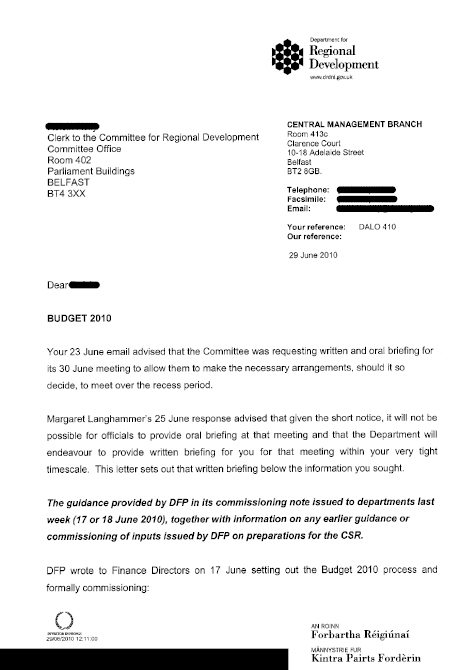
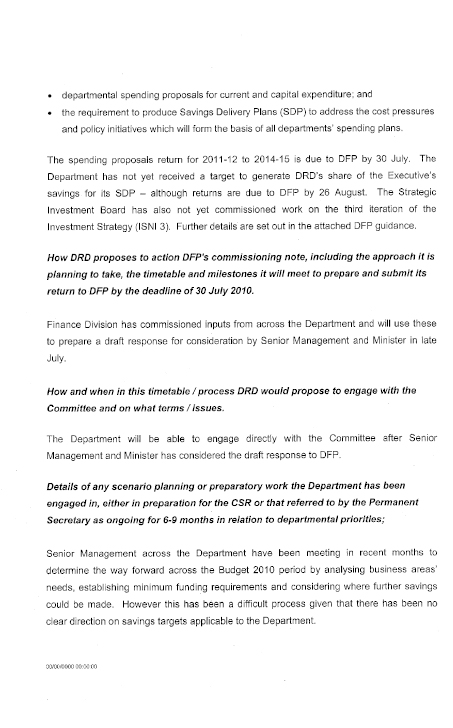

Public Spending Directorate
DFP
June 2010
1.1 This purpose of this guidance is to provide details of the background and approach to the NI Executive Budget 2010 process. It outlines:
(a) the Public Expenditure context
(b) the processes that will contribute to it;
(c) the inputs required from departments; and,
(d) the timetable for the key stages in the process.
1.2 In the context of the continued uncertainty in respect of the UK public expenditure environment and the expectation of a real terms reduction in available resources, the Budget 2010 process will involve the development of the spending plans for NI departments covering the four year period 2011-12 to 2014-15. In parallel, work will need to be taken forward by departments to develop plans to deliver additional resource releasing savings over this period in order to fund the allocations made in the Budget 2010 process.
1.3 It is important to stress at the outset that a number of the planning assumptions set out in this guidance may be subject to change by the Finance Minister and the Executive, as well as in response to changing circumstances. However, in order for departments to be able to provide meaningful Budget 2010 returns, it is essential that there is some form of point of reference on which spending proposals can be based.
1.4 Throughout the Budget 2010 process, departments will have due regard to the objectives as outlined below including statutory duties concerning equality of opportunity and good relations as set out in Section 75 of the Northern Ireland Act 1998; they will also give full consideration to opportunities to address social need experienced by the most deprived people and areas, focusing particularly on opportunities to tackle the problems of unemployment and/or increase employability.
1.5 Departments are also reminded of the importance of early and regular engagement with key stakeholders during all stages of the Budget 2010 process, particularly with Assembly committees. Departments should engage with stakeholders when identifying and prioritising both spending proposals and savings plans.
1.4 The 2007 UK Comprehensive Spending Review was formally launched 27 months before the outcome was announced in October 2007. In contrast, the 2010 Spending Review will have to be completed in less than 6 months whilst the change in Government has resulted in additional uncertainty in respect of the expected outcome for the NI Executive. The emergency UK Budget on 22 June 2010 is expected to provide an updated position in respect of projected level of UK public spending over the next four years, although the NI Executive Departmental Expenditure Limit (DEL) will only be confirmed at the conclusion of the 2010 Spending Review in the autumn.
1.5 In respect of current expenditure, the expectation at this time is that the NI Executive DEL will remain constant in cash terms over the next four years (i.e. a real terms reduction) but from a reduced baseline position reflecting the NI Executive’s share (£127 million) of the reduction in UK public spending announced on 24 May 2010. In addition, there is scope for HM Treasury to make further baseline adjustments.
1.6 The planning assumption is that there will not be significant additional amounts of resources available for allocation from internally generated sources of funding, whilst the overcommitment is expected to remain at zero for the Budget 2010 period, reflecting the improved spending performance of NI departments over the Budget 2008-11 period. This means that NI departments will need to deliver additional savings in order to generate the resources required to address the cost pressures and policy initiatives that departments are now being asked to submit- see Section 2.
1.7 It is essential therefore, that there is a strong focus on delivering savings, whilst minimising the impact on the delivery of priority frontline services. Therefore the intention is for Savings Delivery Plans to be published by departments alongside the draft Budget document, or as soon as possible thereafter, to facilitate public consultation and to ensure that the provision of priority services can be maintained. Further guidance will be issued on this matter to departments shortly.
1.8 The current expenditure baseline position for NI departments in Budget 2010 will be the Revised 2010-11 Spending Plans agreed by the Executive in April 2010 adjusted for time limited allocations, the savings projected to be made from Invest to Save Projects over the period 2011-12 to 2014-15 as well as the additional savings required as part of Budget 2010.
1.9 In line with normal practice, there is no baseline position in respect of capital investment, reflecting the discrete and finite nature of most capital projects. In addition, the position in respect of the expected level of available resources to fund capital projects over the Budget 2010 period is more uncertain than for current expenditure. Although there is expected to be a significant reduction in the NI Executive capital investment DEL, there are a broad range of potential outcomes. Furthermore, although there are signs of recovery in the local property market, it is expected that departmental capital receipts will be lower than previously (indicatively) planned for over the early part of the Budget 2010 period.
1.12 Therefore, the level of resources available capital investment is expected to be less than the indicative plans for capital investment over the period 2010-11 to 2014-15 included in the second iteration of the Investment Strategy for Northern Ireland (ISNI) 2008-18. The slippage of projects from the current Budget period will increase the demand for resources whilst there should, in principle, be significant offsetting savings from lower than expected construction and land costs.
1.13 The capital allocations to NI departments for the years 2011-12 to 2014-15 will be set as part of the Budget 2010 process, informed by the work, led by the Strategic Investment Board (SIB), to develop the third iteration of the ISNI. Priority will be given to capital projects which are already substantially commenced as well as those where contractual commitments are in place for specific amounts of funding.
1.14 Detailed baseline prints will be issued to departments shortly. As departments are not expected to be currently in a position to provide details of where they intend to make additional savings over the coming four years, the baseline prints will include a separate Unit of Service (UoS) with a negative figure for the amount of savings required of each department. As the Budget 2010 process progresses and departments identify the business areas where savings are to be made, the amount attributed to this UoS should move to zero. Although the full amount of the savings required will be attributed to Other Resource Near Cash in the first instance, departments will be able to transfer part of the savings into Administration Near Cash, in line with their Savings Delivery Plans.
1.15 The deadline for submitting Budget 2010 spending proposals is 30 July 2010. In addition, departments will be expected to have provided full details of the areas where they intend to make savings by 26 August 2010 which is also the deadline for departments to complete a Technical Exercise in respect of proposed transactions to move resources in the opening baseline position between both UoS and UoB. This represents a greater degree of flexibility for departments than would normally be the case to allow departments to more fully align funding with business requirements.
1.16 The broad strategic priorities for the Budget 2010 process are expected to be in line with those set out in the Programme for Government with “growing the economy" remaining the Executive’s top priority. In addition, and subject to further Executive consideration, it is expected that the same basic structure in respect of Public Service Agreements will remain in place. However, there will be revisions to the specification of performance targets reflecting the departmental allocations made as part of the Budget 2010 process. In order to enhance this linkage, each spending proposal will be expected to include details of the impact of the bid being successful (against the counterfactual position) for specific quantifiable performance targets, in addition to the linkage to overall PSA’s
1.17 The Executive has yet to conclude on the approach as to how the Department of Justice (DoJ) and the Public Prosecution Service (PPS) should be incorporated into the Budget 2010 process. For example, in light of the financial package agreed with the Government as part of the devolution of policing and justice powers to the NI Assembly one option would be for DoJ and PPS to be ring-fenced as part of Budget 2010. However, until this decision is made by the Executive, in terms of preparatory work, both DoJ and PPS are advised to develop Savings Delivery Plans and Spending Proposals on the same basis as that for the other main departments.
1.18 In line with previous arrangements, the NI Assembly and the NI Audit Office will be provided with the level of funding required by each organisation (both current expenditure and capital investment) in order to carry out their respective functions, as agreed by the Assembly Commission and the Public Accounts Committee respectively. In accordance with the overall framework for Budget 2010, the approach for the Assembly Ombudsman/Commissioner for Complaints, Food Standards Agency and NI Authority for Utility Regulation will be the subject of further specific discussion with DFP to ensure that it is fit for purpose, in light of the scale of funding to these organisations.
1.20 One of the main themes from the Review of the NI Executive Budget 2008-11 process was the need for earlier and more detailed engagement by departments with their Assembly committees and other stakeholders as part of each Budget process. Although the unavoidable delays in initiating the Budget 2010 process means that there will be less scope to take this forward as part of the current process than will be the case in future years, it remains essential that Assembly committees are provided with as much information that is both appropriate and practical. However, it is also recognised that there can be significant differences in the form of engagement between individual departments and their respective Assembly committees whilst decisions on how to manage this relationship ultimately lie with individual departments.
1.21 In addition to the regular updates that departments should already be providing to Assembly committees in respect of their financial position for 2010-11 and future years, it is important that committees are also provided with the opportunity to provide advice and comment in respect of the Budget 2010 process. In particular, departments will be expected to consult with Assembly committees, as well as other key stakeholders, in respect of the spending proposals for Budget 2010. This should include a clear rationale for the departmental prioritisation of spending proposals whilst also highlighting the broader financial context.
1.22 However, the need to take forward the Budget 2010 process in a timely manner remains paramount and departments should not delay in providing returns to DFP by 30 July 2010, in order to consult with their Assembly committee. The pro-forma for each spending proposals will now include details of the groups that the department has consulted with in developing the bid for additional funding. Assembly committees should also be kept fully informed of any changes to their spending proposals during the course of the Budget 2010 process.
1.23 It is intended that supporting documentation such as prioritised spending proposals and Savings Delivery Plans will be published at the same time, or as soon as possible after, the draft Budget document is published in the autumn. Supporting documentation should be published on departmental websites and sent to Assembly committees. Although the draft Budget document will include high level detail in respect of the budget allocations to NI departments it is also important that Assembly committees are provided with details of which spending proposals are being supported and how much funding is being provided.
1.24 The main form of consultation on the draft Budget proposals will be through the Assembly committees and departments should seek to provide timely responses to any queries or requests for additional information. It is also important that there is recognition of the financial constraints facing the Executive and departments should highlight the consequences that additional funding for one particular area may require the funding for another to be reduced accordingly. Departments will also wish to consult with stakeholder groups with a specific interest in the allocation of resources between business areas within the department. Whilst it may not be possible to fully incorporate the views expressed during the draft Budget consultation process into the final revised spending plans for NI departments, it is important to provide feedback to stakeholder groups and in particular Assembly committees following the conclusion of the Budget 2010 process.
1.25 Table 1 below sets out the broad timetable for the Budget 2010 process. It is important to note that there remain some significant uncertainties, particularly in respect of the timing of the outcome of the 2010 Spending Review. Therefore, there may be significant changes in timescales as the process progresses. In addition, the delay initiating the process means that the timescale are very challenging. This reflects the importance of departments and public bodies having final spending plans in place sufficiently advance of the 2011-12 financial year to allow plans for delivery to be put in place.
Activity |
Timing |
|---|---|
| Departments to begin work on plans to deliver savings- following DFP Ministers note to Executive of 12 April | April |
| Guidance issued to departments in respect of Budget 2010 | mid June |
| Guidance issued to departments in respect of Savings Delivery Plans | June |
| Pre-Consultation exercise with key stakeholders. | June- early August |
| Receipt of departmental returns – Departments proposed spending plans including linkages to PSA’s. | 30 July 2010 |
| Ministerial bi-laterals | August – early Sept. |
| Departments to provide details on savings and Technical Exercise | 26 August |
| Draft proposals to Executive for consideration1 | September |
| 2010 Spending Review outcome announced by HMT | October |
| Draft Budget published alongside draft PfG and ISNI | October |
| Public Consultation Process on the draft document | October to December |
| Revised proposals to Finance Minister for consideration | Early December |
| Revised proposals to the Executive for consideration | Mid December |
| Final Budget document published | Late December |
1 Based on the anticipated 2010 Spending Review outcome for the Executive.
1.26 The next significant milestone in the process will be the submission of departmental returns for Budget 2010, which should be sent to DFP by 30 July 2010 and recorded on RBM by 5pm on this date. Details of where departmental savings are proposed to be made should be recorded on the RBM by 26 August 2010 as well as details of proposed movements of funding between UoS and UoB.
2.1 The departmental returns for Budget 2010 should set out, in one document, the departments proposed current expenditure and capital investment spending plans for the years 2011-12 to 2014-15, comprised of a set of spending proposals with supporting evidence. In particular, the benefits that would be achieved as a result of the spending proposal being implemented should be clearly stated with a clear linkage to Public Service Agreement outputs/outcomes where appropriate.
2.2 In making recommendations to Ministers on the allocation of available resources, current expenditure spending proposals will be assessed in terms of alignment with ministerial priorities, impact on PSA indicators as well as the extent to which the proposal relates to an unavoidable pressure (pre-commitment or statutory/legal requirement). In addition, a positive impact on equality, good relations, poverty, social inclusion or sustainable development would also increase the chances that a proposal will be recommended to Ministers. Therefore it is important that sufficient quality and quantity of evidence is provided, with the onus on the sponsor business area.
2.3 In light of the cross-departmental approach to the development of PSAs the preference is that the lead department for each PSA puts forward a joint proposal on behalf of the relevant delivery partner departments. This avoids the risk of two departments bidding for the same funding or not at all. There should be clear identification of when a spending proposal is linked to others so that they can be considered collectively where appropriate.
2.4 Whilst the return will reflect the department’s views, it is essential that there is early and substantive engagement with the relevant DFP Supply Team – particularly in view of the tight overall resource position and the desire to avoid nugatory work for departments in terms of preparing spending proposals. Supply will therefore continue to engage with departments to discuss the approach and proposed contents of returns.
2.5 The departmental resource baselines to be used for the Budget 2010 process will shortly be provided. Only the baseline data provided by CED should be used by departments as the starting points for their returns. For the avoidance of doubt, spending proposals are only required where a department requires additional resources to those set out in the baselines. In line with the normal practice, there is no baseline position in respect of capital investment.
2.6 The structure for the departmental return is set out below:
Current Expenditure Proposals
Capital Investment Proposals
2.7 The following paragraphs specify the requirements of each section. It is important that all sections are covered in departmental returns.
2.8 The departmental submission should begin with a short textual summary of the department’s proposals, followed by a table setting out the overall budgeting implications of the proposals. A pro forma for this is attached at Annex A with a separate table to be completed for current expenditure and capital investment spending proposals. At this stage the PSA/Objective linkage is in respect of the 23 PSA’s in the Programme for Government (PfG) 2008-11 document. For example, a spending proposal linked to the PSA objective of Tackle the skills barriers to employment and employability, should include the value 3.1 in the PSA/objective column reflecting that this is the first objective in PSA 3.
2.9 For each current expenditure spending proposal the departmental submission should complete Annex B which sets out details of each proposal and supporting evidence:
(a) Summary of Spending Proposal - setting out the main points of the proposal and in particular how it links with the over-arching Executive priorities. The Responsible Officer for the proposal will be contacted for clarification on the information provided in the return. Links to other proposals and the date the HLIA/EQIA was completed should also be specified, as well as the groups consulted with in developing the proposal;
(b) Resource Requirements - should be set out relative to the position in 2010-11 although this may not be appropriate for new policies/programmes. The additional funding required is split between administration and Other Resource near Cash, whilst departments should also indicate if this includes depreciation and impairments. In terms of the evidence that the level of resources proposed is the minimum necessary Departmental returns should refer to best practice levels of marginal/average costs in supporting the case. In light of the more constrained fiscal position it is also important to identify whether a reduced form of the bid might be possible (i.e. is it all or nothing);
(c) Public Service Impact - key part of each spending proposal will be the projected impact on public services as reflected in the linkage with the PSA Key Performance Indicators (KPI’s). Although the expectation is that most spending proposals will be in respect of the existing KPI’s within PfG 2008-11, departments will also be able to put forward proposals as regards new performance targets.
The baseline position will be the expected level of performance in 2010-11 for each KPI affected by the spending proposal. In respect of the value added from the bid being successful, the forecast values for the KPI over the next four years should be set under the two scenarios of the bid being successful and not being met. Although, the provision of KPI data will strengthen the case for a spending proposal to be funded, it is recognised that such information may not be available in all cases. Therefore supplementary information on wider benefits can be provided, although such impacts should be clear and unambiguous i.e. references to for example; improved staff morale, avoidance of industrial action and/or avoidance of public criticism etc should not be used;
(d) Extent to which proposal is unavoidable - it is recognised that in some cases there will be significant costs associated with simply maintaining existing services (MES) with little or no enhancement in respect of the delivery of public services. It is essential that sufficient evidence is presented that the proposal is definitely unavoidable and that the quantum of cost involved is the minimum necessary; and,
(e) Equality, Good Relations, Poverty/Social Inclusion and Sustainable Development Impact - it is important that specific positive impacts in respect of Equality & Good Relations, as well as Social Inclusion and Sustainable Development are considered as part of the broader assessment of each proposal.
2.10 The ISNI 2008-18 included indicative capital investment spending plans for the period 2011-12 to 2014-15. In addition, information has recently being requested from department at official level in respect of the latest cost profiles for these projects and any additional pressures, focusing on contractually committed spend. However, not all departments were in a position to provide the information as requested whilst it is important that there is a clear understanding of the capital funding requirement identified by departments. Therefore, departments are required to submit spending proposals in respect of all their capital investment requirements over the Budget 2010 period.
2.11 For each capital investment spending proposal the departmental submission should complete Annex C which sets out details of each proposal and supporting evidence. Although, departments should combine smaller scale minor works capital projects as a single proposal, it is essential that there is sufficient disaggregation to provide the Executive with a clear understanding of the proposal.
(a) Summary of Spending Proposal - setting out the main points of the proposal and in particular how it links with the over-arching Executive priorities. The Responsible Officer for the proposal will be contacted for clarification on the information provided in the return. Links to other proposals and the date the EQIA/HLIA was completed should also be specified, as well as the expected procurement method;
(b) Capital Requirements - should be set out in respect of the full amount required for each financial year as well as the associated additional resource requirements specifically associated with the project, which should not be bid for separately as a current expenditure proposal. In terms of the evidence that the level of resources proposed is the minimum necessary Departmental returns should provide evidence that they have sought to reduce the level of funding required compared to early projections, for example those in the ISNI 2008-18. In light of the more constrained fiscal position it is also important to identify whether a reduced form of the bid might be possible (i.e. is it all or nothing) or whether it would be possible to defer the project until after 2014-15;
(c) Linkage with Budget 2008-11 - departments should set out details of the extent to which expenditure has already commenced in the current Budget 08-11 period and thus, that rejecting the proposal might result in wasted expenditure. This should not include details for ongoing minor works but specific larger scale projects which have expenditure tails into the Budget 2010 period;
(d) Linkage with ISNI 2008-18 - departments should set out details of the annual expenditure plans for the project that were included as indicative plans in the ISNI 2008-11 as well as any details of changes to the expenditure profile. In particular, the expectation is that the current capital funding requirements should be lower than when ISNI 2008-18 was published in January 2008;
(e) Slippage from current Budget 2008-11 Period - in addition to projects which began in the current Budget period but with tails into the Budget 2010 period (as captured in (c)), there will also be projects that were expected to start in the period 2008-09 to 2010-11 but have slipped to future years. It is important to provide details of only the amount of expenditure that has slipped from the current Budget 2008-11 period, as opposed to the total cost of the project. In order to provide assurance that previously delayed projects will progress in line with the revised timescales, departments should provide details of why there was slippage in the project as well as the steps that have been taken to ensure that it does not occur again.
(f) Contractual Commitments - it is recognised that departments may have already signed contracts in respect of projects with expenditure in both the current and Budget 2010 periods. However, the nature of commitments can vary significantly with the key factor being whether a contract has been signed for a specific amount of funding or whether a contract implies a commitment to a minimum level of capital expenditure by a department. In order to provide assurance that a contract is in place, the date that the contract was signed and the date that final DFP approval was secured, should also be specified.
(f) Economic, Equality, Good Relations, Poverty/Social Inclusion and Sustainable Development Impact - it is important that specific positive impacts in respect of Equality and Good Relations, as well as Social Inclusion and Sustainable Development should be considered as part of the broader assessment of each proposal. In the context of the key role played by public infrastructure in facilitating economic growth, departments should set out the impact on long term economic growth. In addition, there are also shorter terms economic benefits from expenditure on capital projects as a stimulus for the construction sector, which should also be set out.

From: Nigel McCormick
Finance Director
Cc: Copy distribution below
Tel: (028) 9054 0848
Email: nigel.mccormick@drdni.gov.uk
Date: 30 July 2010
To: Adrian Arbuthnot
DFP Supply
1. Michael Brennan’s 17 June commissioning memo sought departmental current and capital spending proposals for the Budget 2010 period over the next four years 2011-12 to 2014-2015.
2. We have split our current and capital spending proposals into two categories:
3. You should note that we have not prioritised our bids. They are simply presented by business area by the highest value in 2011-12. No prioritisation should be inferred. This is because the Executive has not yet agreed the Budget 2010 process. The format of our return is set out as follows:
4. You should note that there is one NI Water spending proposal each for current and capital expenditure to meet the regulatory settlement / contract in Public Expenditure terms. You will be aware that the first two years of the Budget 2010 period are the last two years of the current Price Control period.
5. You will also be aware that the Trust Ports remain within the PE system. At this stage the Ports have confirmed they currently have no plans to seek DEL loans to fund their borrowing requirements over the Budget 2010 period. However due to the commercial nature of the Ports you should note that this situation could change very quickly if, for example, a commercial opportunity became available for a port. Whilst we are not in a position to log a bid, I should be grateful if DFP would log this potential funding requirement.
6. On admin costs we are, like other NICS Departments, fast losing the flexibility to manage a reduction in staff numbers through the suppression of vacant posts and the redeployment of staff within DRD and to other Departments. Given this we feel that redundancy will be necessary to help reduce numbers beyond annual natural wastage levels.
7. Under current arrangements redundancies for service wide grades are managed on an NICS basis. It is difficult at this stage to be precise about planning requirements but we do feel that DFP should be making some provision for redundancy using information on vacancies and projected surpluses provided by Departments. On this basis, we have not included any bid for redundancy costs.
8. We have included the Resource consequentials of Capital bids being met as part of the bid, as set out in the guidance. We have also included separate “consequentials" bids in the lists for Current and for Capital proposals. These consequentials are inescapable costs that will arise if Capital bids are not met. As such they are very similar to contractual commitments in their effect. We have specified some in the short time available. Should specific bids not be met we would need to examine those in particular to identify if there are any further such consequentials.
9. Indeed such consequentials may also arise in respect of Resource savings, for example public liability claims due to reduced standards of maintenance. We are not yet in a position to quantify such consequentials and so may need to bid for these later.
10. Given the timing of this exercise and the fact that the Assembly is in summer recess, DRD has not had the opportunity to fully engage with the Regional Development Committee. Consequently this return has not been considered by the Committee and may be subject to change following Committee consideration or indeed by our own Minister.
[Signed]
Nigel McCormick
Copy List:
Paul Priestly
Lian Patterson
Geoff Allister
Doreen Brown
John McNeill
Gary Fair
John Mills
Ciaran Doran
Brian White
Tom Reid
Roger Downey
Stephen McGlade
John McKibbin - DFP
Joanne McBurney - DFP
| Rank | Spending Proposal | PSA | Resource (£000’s) | |||
| 2011-12 | 2012-13 | 2013-14 | 2014-15 | |||
| Structural Maintenance (Patching) | 13 | 5,300 | 7,300 | 9,500 | 11,700 | |
| Street Lighting Inspection and Testing | 13/14 | 4,710 | 4,925 | 5,150 | 5,380 | |
| Street Lighting Operations and Maintenance | 13/14 | 4,120 | 5,240 | 6,370 | 6,500 | |
| Resource Consequentials – Structural Maintenance (Patching and Public Liability) | 13/14 | 1,000 | 5,355 | 10,182 | 13,887 | |
| Street Lighting Electricity | 13/14 | 450 | 910 | 1,390 | 1,890 | |
| Total | 15,580 | 23,730 | 32,592 | 39,357 | ||
| Rank | Spending Proposal | PSA | Resource (£000’s) | |||
| 2011-12 | 2012-13 | 2013-14 | 2014-15 | |||
| Maintain the existing Concessionary Fares Scheme | 13 | 6,100 | 8,300 | 10,600 | 13,000 | |
| Increased NILGOSC contributions from NITHC | 13 | 5,500 | 5,500 | 5,500 | 5,500 | |
| Increased railway Public Service Obligation (PSO) shortfall | 13 | 4,200 | 5,900 | 6,800 | 8,200 | |
| Fund the increases in Fuel Duty Rebate (FDR) | 13 | 3,100 | 3,700 | 4,300 | 5,000 | |
| Rural Transport Fund (Dial-a-lift) | 13 | 1,000 | 1,050 | 1,100 | 1,155 | |
| Total | 19,900 | 24,450 | 28,300 | 32,855 | ||
| Rank | Spending Proposal | PSA | Resource (£000’s) | |||
| 2011-12 | 2012-13 | 2013-14 | 2014-15 | |||
| Regulatory settlement in Public Expenditure terms. | 15 | 32,200 | 32,600 | 44,900 | 53,800 | |
| Rank | Spending Proposal | PSA | Resource (£000’s) | |||
| 2011-12 | 2012-13 | 2013-14 | 2014-15 | |||
| Ongoing costs of equal pay claim, increased ASLC contributions, future pay awards. | 4,245 | 6,910 | 9,716 | 12,463 | ||
| Rank | Spending Proposal | PSA | Resource (£000’s) | |||
| 2011-12 | 2012-13 | 2013-14 | 2014-15 | |||
| Free Disabled Travel | 13 | 4,550 | 4,800 | 5,050 | 5,300 | |
| Pension Reform within NITHC | 13 | 2,600 | 2,000 | 1,500 | 900 | |
| Railway PSO Hourly Services | 13 | 2,000 | 1,800 | 1,600 | 1,400 | |
| Implementation of Regional Transportation Strategy | 1/13/ 14 |
0 | 1,500 | 1,000 | 1,500 | |
| Total | 9,150 | 10,100 | 9,150 | 9,100 | ||
DRD’s Total Current Expenditure Spending Proposals are £81,075k / £97,790k / £124,658k / £147,575k.
| Rank | Spending Proposal | PSA | Capital (£000’s) | |||
| 2011-12 | 2012-13 | 2013-14 | 2014-15 | |||
| Structural Maintenance Funding Plan | 13/14 | 103,500 | 107,000 | 110,500 | 114,000 | |
| Capital Improvements and Local Transport & Safety Measures | 13/14 | 52,000 | 40,000 | 50,000 | 60,000 | |
| Other Strategic Road Improvements | 13 | 46,500 | 39,900 | 18,800 | 10,000 | |
| Structural Maintenance back-log | 13/14 | 25,000 | 40,000 | 51,000 | 51,000 | |
| A5 Derry to Aughnacloy | 13 | 15,000 | 165,000 | 285,000 | 210,000 | |
| A6 Randalstown to Castledawson | 13 | 12,300 | 44,500 | 35,100 | 2,000 | |
| Street Lighting renewal | 13/14 | 6,000 | 6,000 | 8,000 | 11,000 | |
| Capital Consequentials - A2 Greenisland (if Other Strategic Road Improvements bid not met) | 13 | 5,000 | 0 | 0 | 0 | |
| Other Roads Capital | 13/14 | 4,000 | 4,000 | 9,000 | 9,000 | |
| A8 Belfast to Larne | 13 | 3,400 | 46,000 | 51,000 | 12,000 | |
| A6 Derry to Dungiven | 13 | 1,500 | 3,200 | 62,500 | 100,100 | |
| Total | 274,200 | 495,600 | 680,900 | 579,100 | ||
| Rank | Spending Proposal | PSA | Capital (£000’s) | |||
| 2011-12 | 2012-13 | 2013-14 | 2014-15 | |||
| New Trains Two Programme | 13 | 70,665 | 8,446 | 72 | 0 | |
| Bus Fleet Replacement Programme | 13 | 13,540 | 13,220 | 12,980 | 13,070 | |
| Coleraine to Derry Track Renewal | 13 | 11,893 | 66,825 | 7,240 | 0 | |
| Rail Service Delivery | 13 | 7,503 | 10,230 | 32,548 | 52,809 | |
| Rail Safety Programme | 13 | 5,533 | 6,741 | 5,717 | 4,425 | |
| Bus Service Delivery | 13 | 3,793 | 6,094 | 9,443 | 3,430 | |
| City of Derry Airport Safety Works | 13.3 | 3,000 | 3,000 | 3,000 | 0 | |
| School Bus Signage and Lighting | 13 | 693 | 231 | 0 | 0 | |
| Bus Passenger Facilities | 13 | 402 | 182 | 265 | 163 | |
| Rapid Transit | 13 | 350 | 350 | 1,500 | 10,000 | |
| MV Canna Boat Replacement | 13 | 0 | 3,200 | 4,300 | 0 | |
| Total | 117,372 | 118,519 | 77,065 | 83,897 | ||
| Rank | Spending Proposal | PSA | Capital (£000’s) | |||
| 2011-12 | 2012-13 | 2013-14 | 2014-15 | |||
| Regulatory settlement in Public Expenditure terms. (Consequential Resource £0k / £0k / £2,280k / £4,560k) | 15 | 235,000 | 238,000 | 228,000 | 228,000 | |
| Rank | Spending Proposal | PSA | Capital (£000’s) | |||
| 2011-12 | 2012-13 | 2013-14 | 2014-15 | |||
| Sustainable Transport Projects (Consequential Resource £1,050k / £1,750k / £2,650k / £3,450k) | 1 | 5,750 | 12,750 | 16,250 | 16,250 | |
| Travelwise NI and Active Travel Projects (Consequential Resource £100k / £100k / £100k / £100k) | 14/20/ 22 |
1,300 | 1,300 | 1,300 | 1,300 | |
| Modernising public transport through Information & Communications Technology (ICT) (Consequential Resource £700k / £1,300k / £1,400k / £1,100k) | 1 | 100 | 500 | 4,550 | 4,350 | |
| Audio Visual System on Buses | 13 | 50 | 1,500 | 2,000 | 2,000 | |
| Total | 7,200 | 16,050 | 24,100 | 23,900 | ||
DRD’s Total Capital Expenditure Spending Proposals are £633,772k / £868,169k / £1,010,065k / £914,897k.
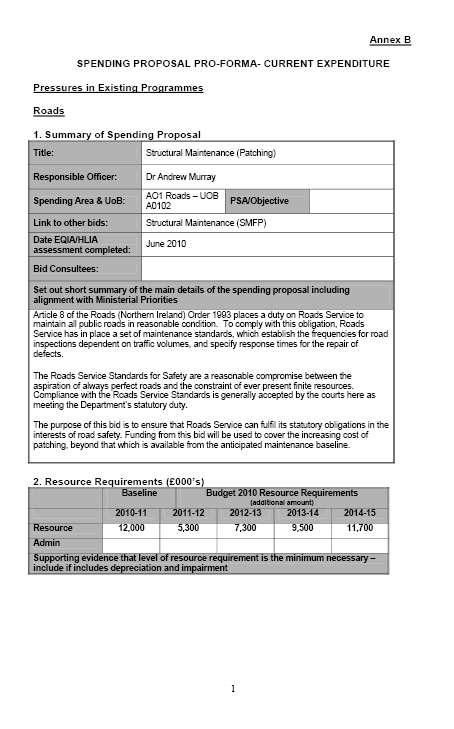
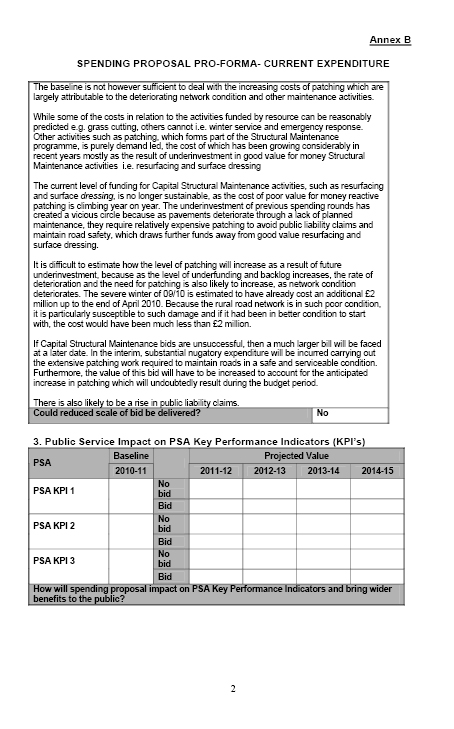
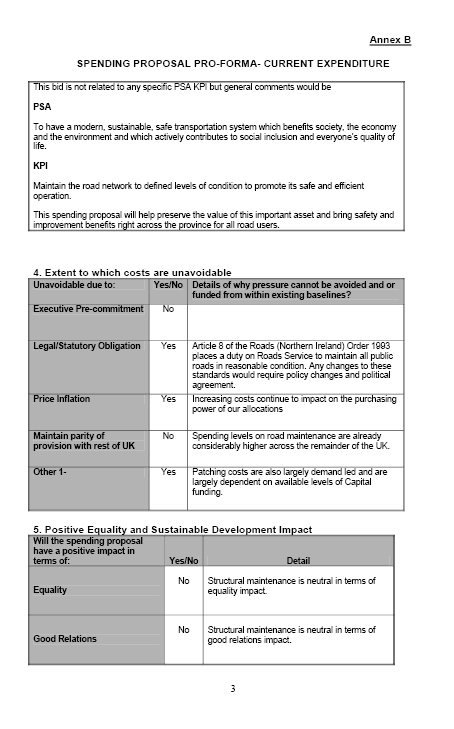

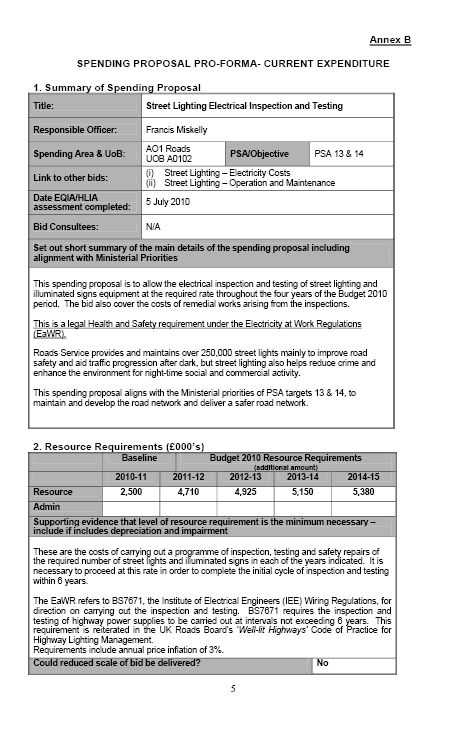
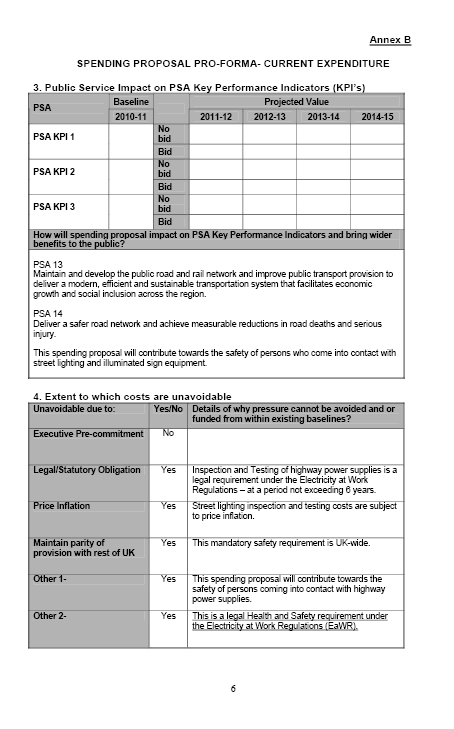


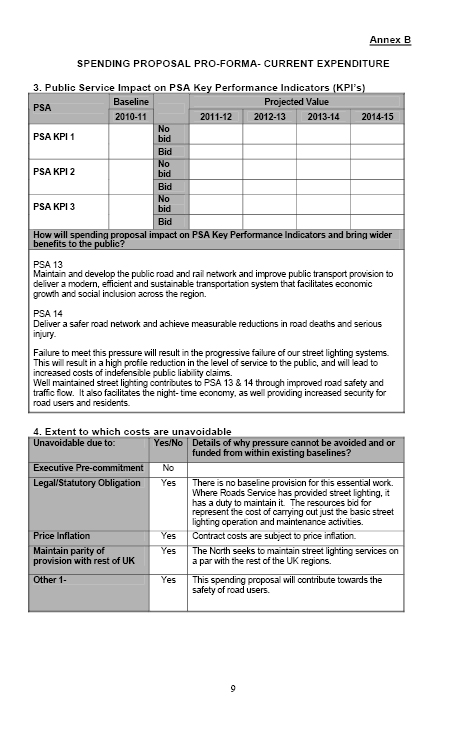
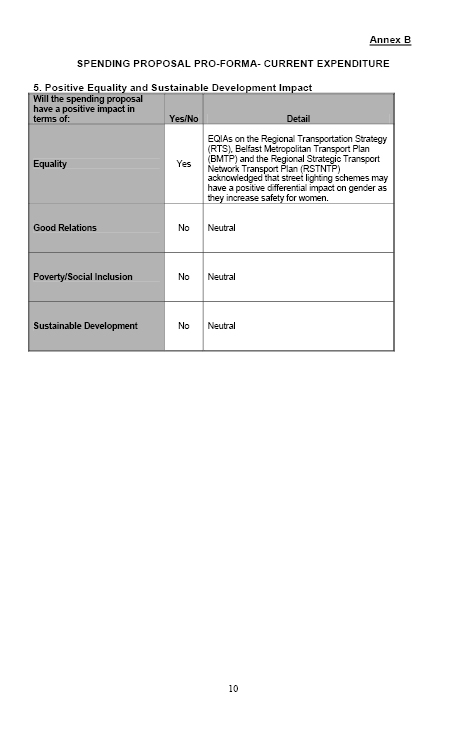
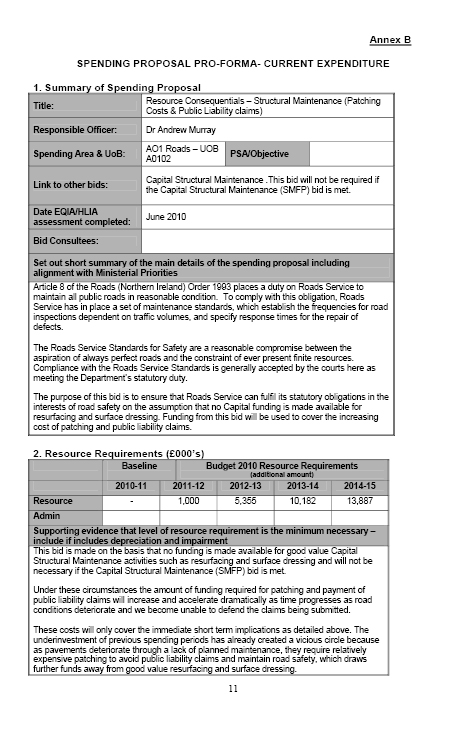
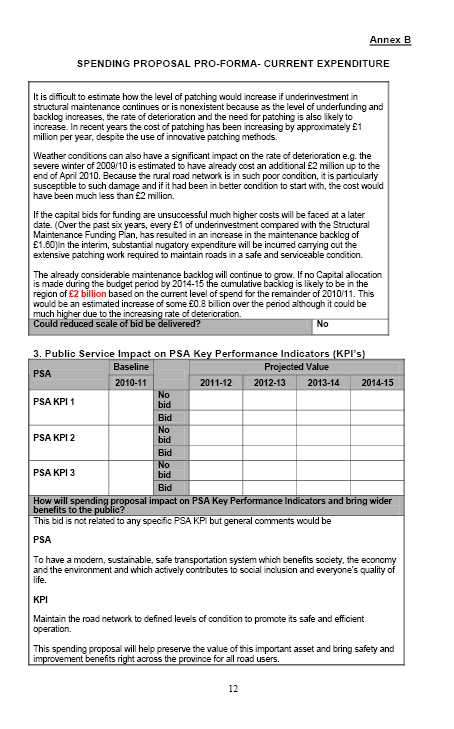

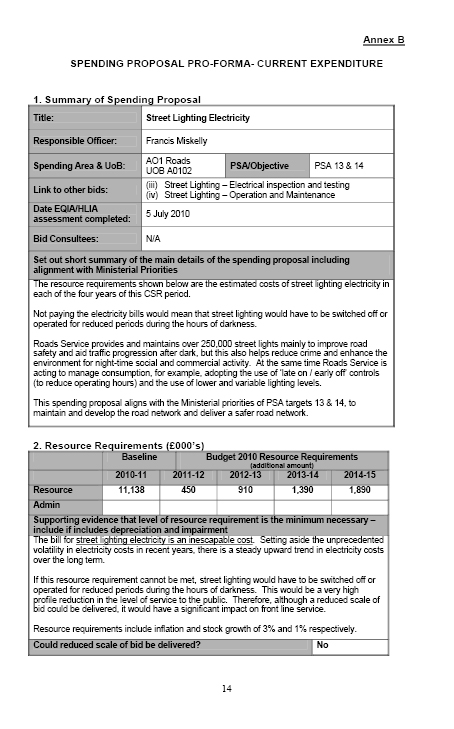
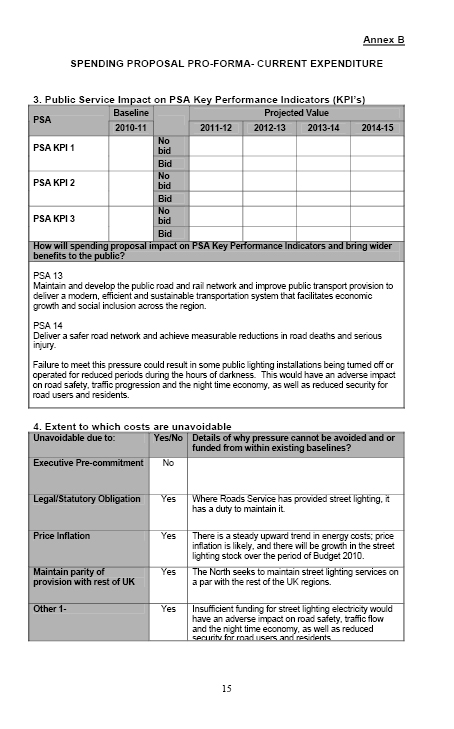
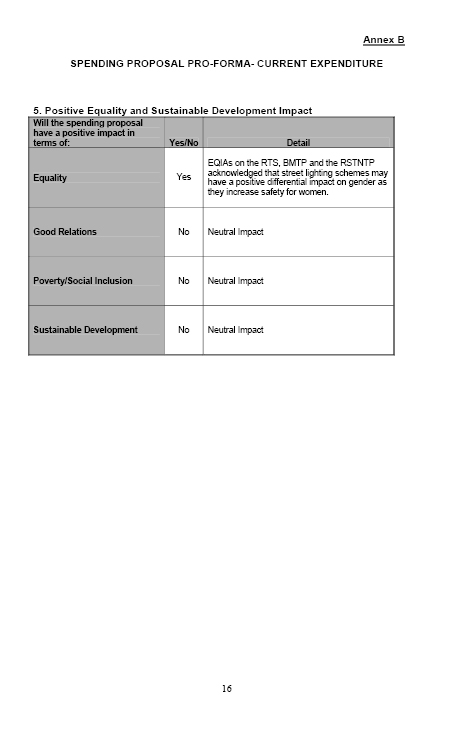
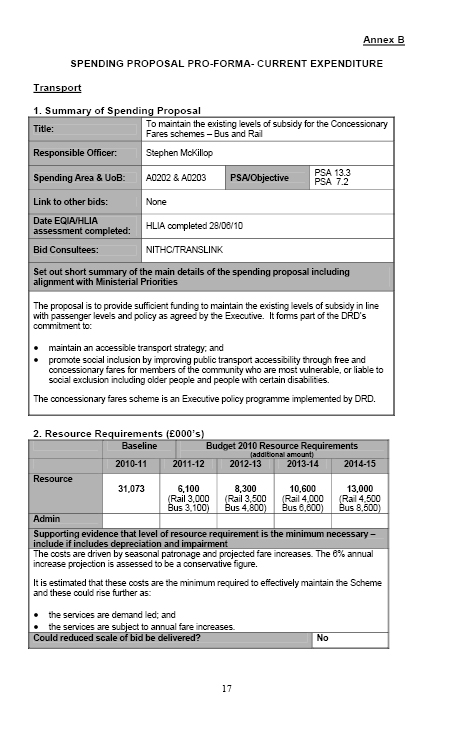
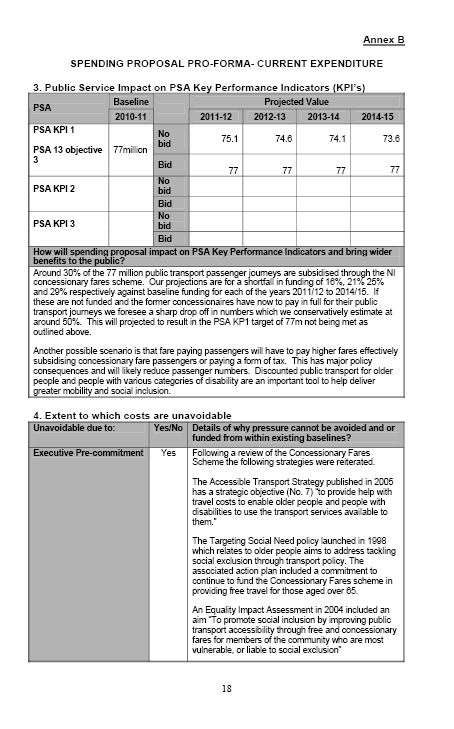
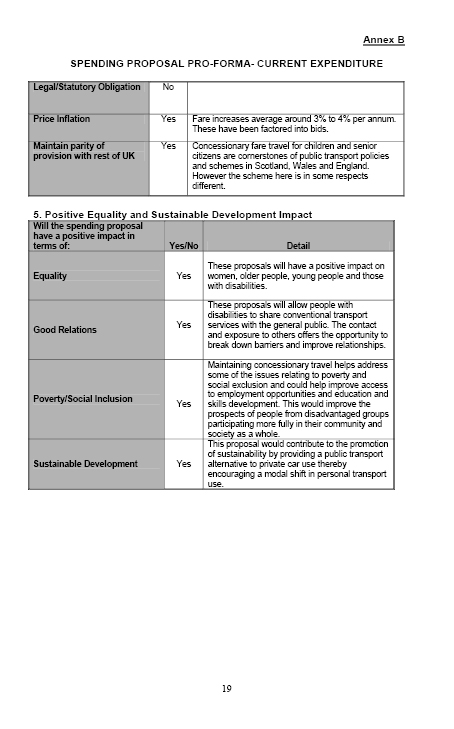

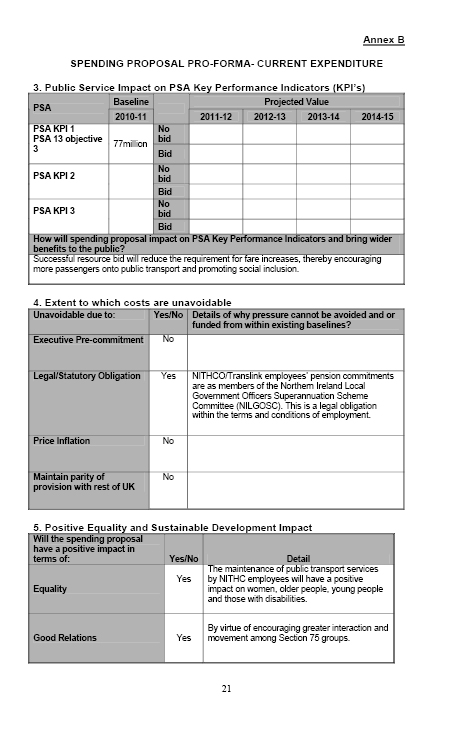
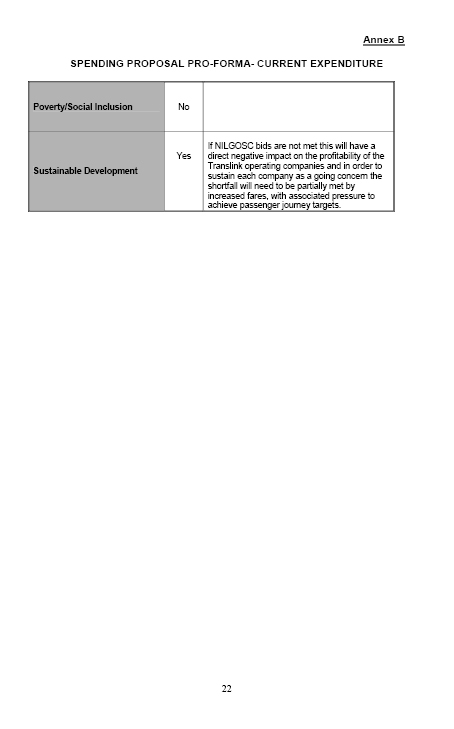

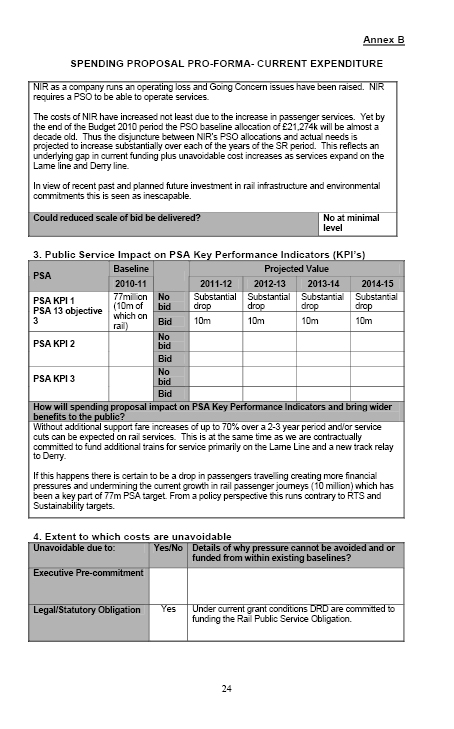

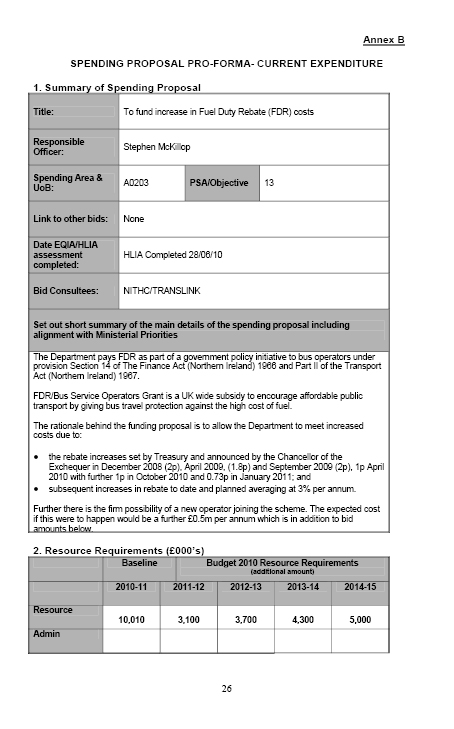
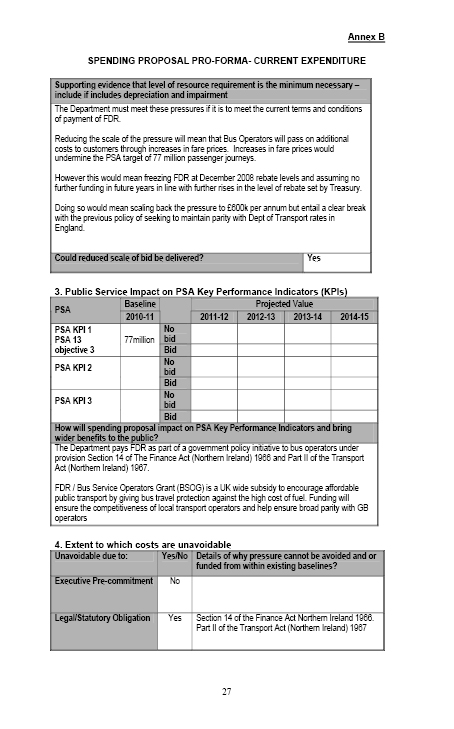
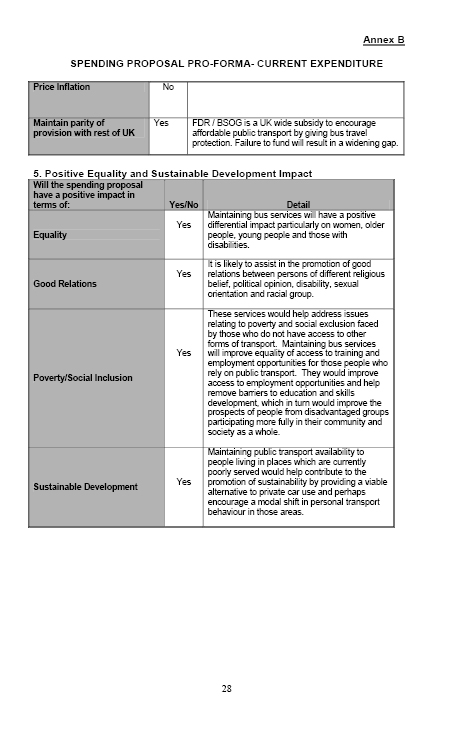
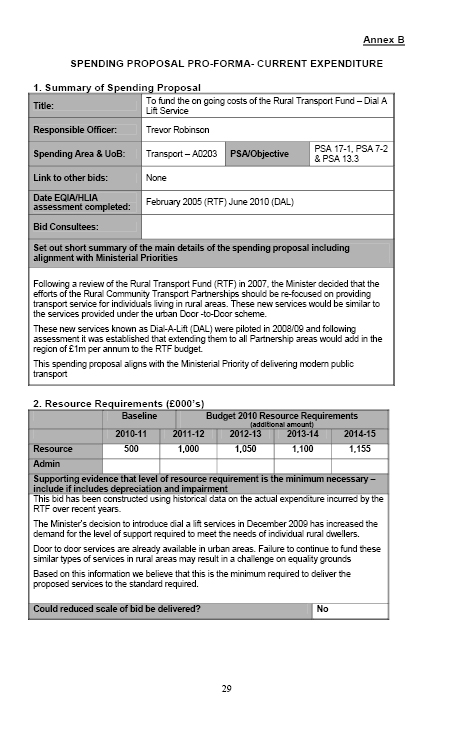
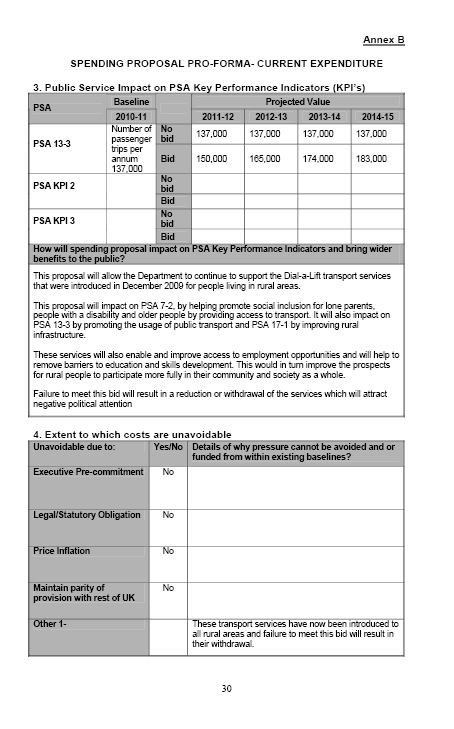
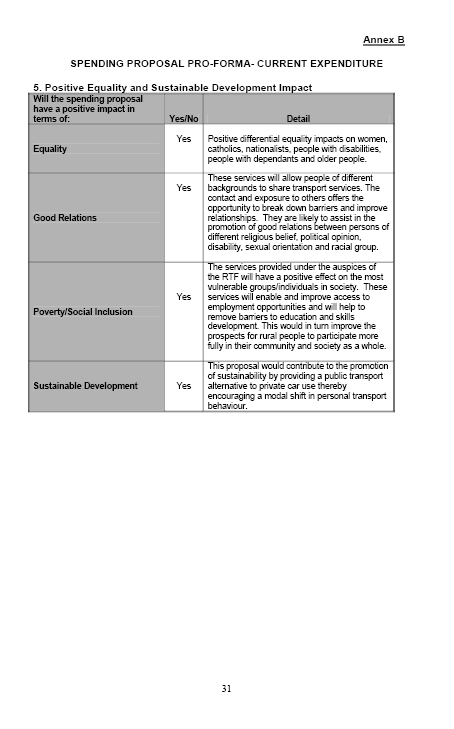

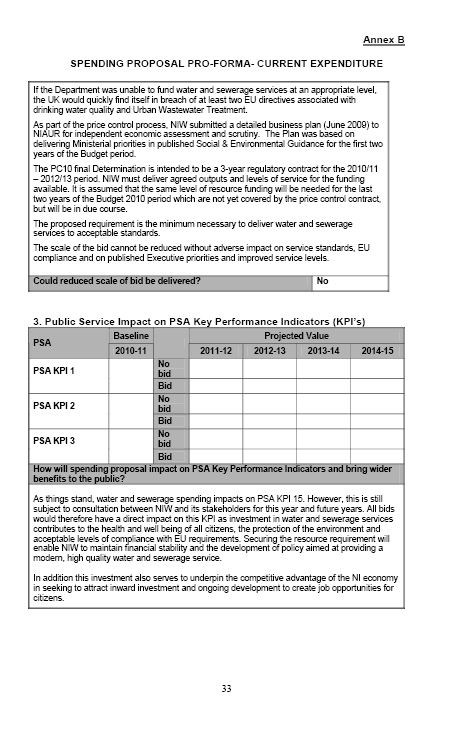
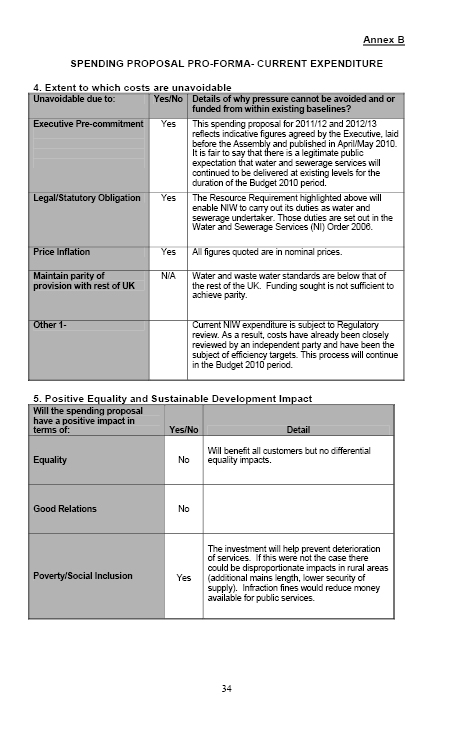

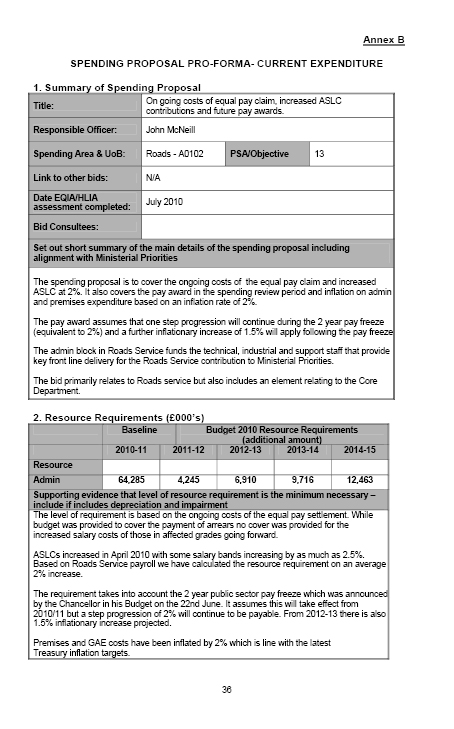

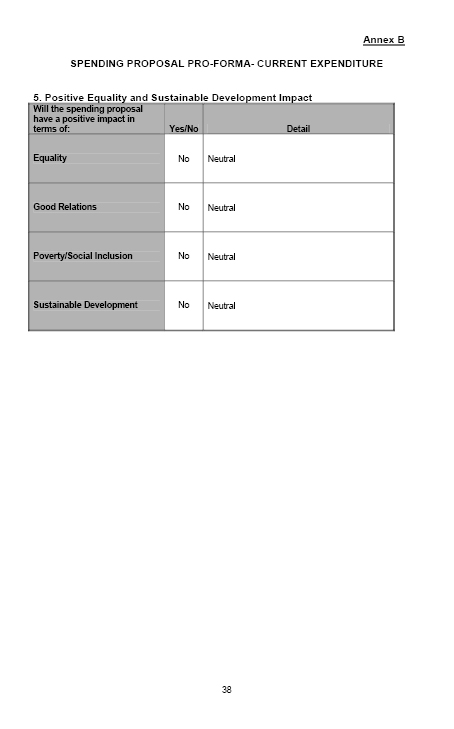
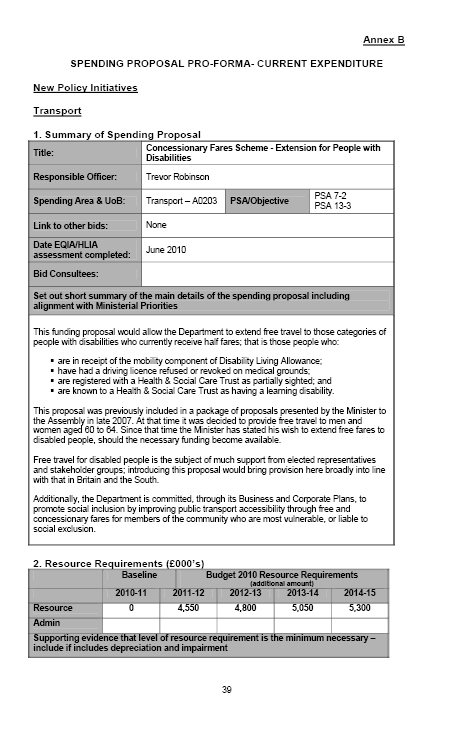

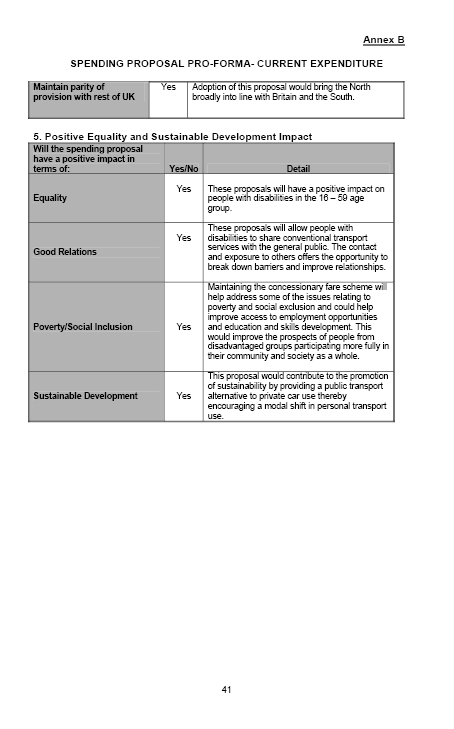
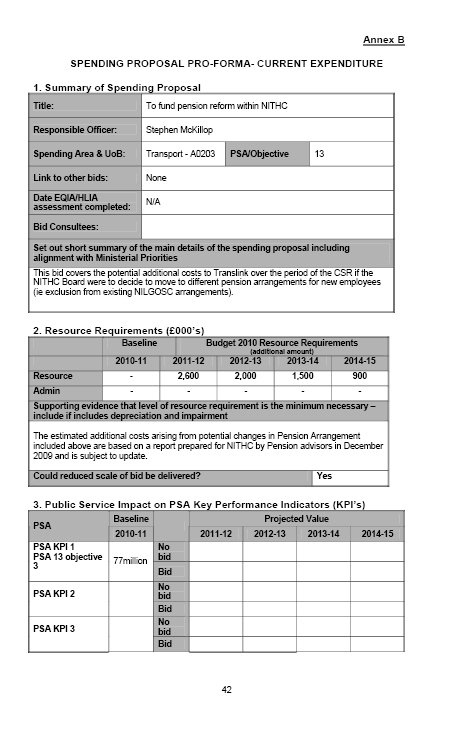
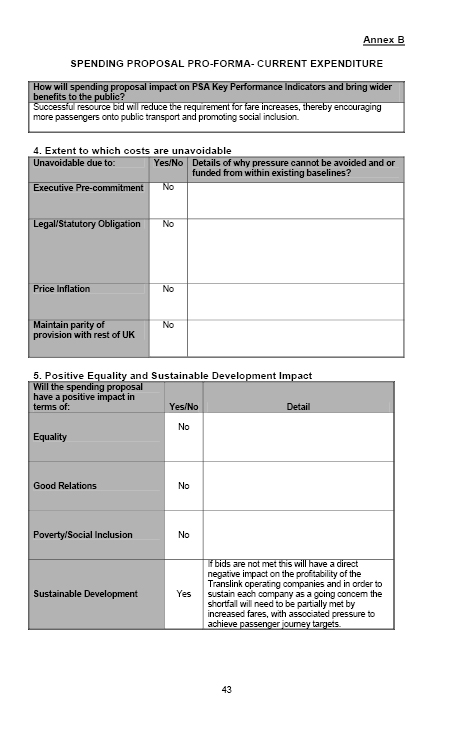
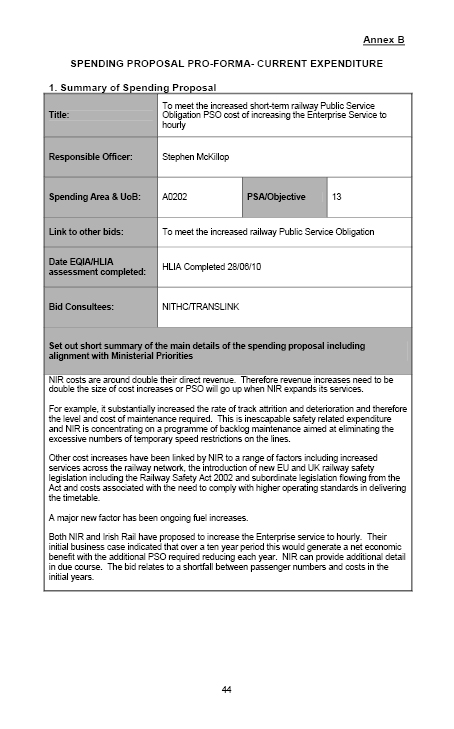
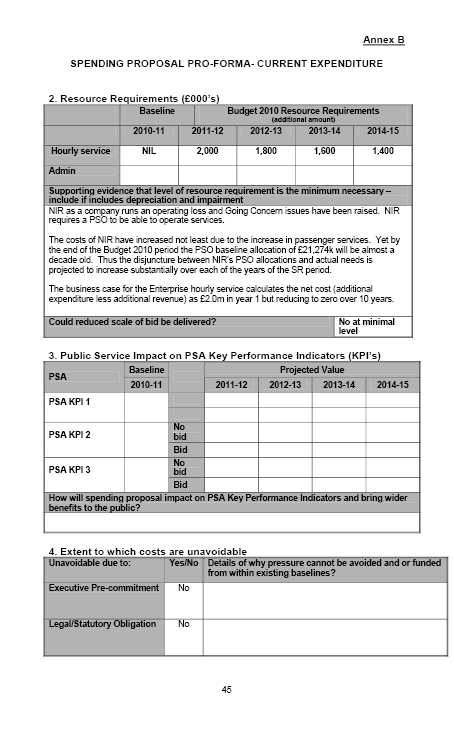
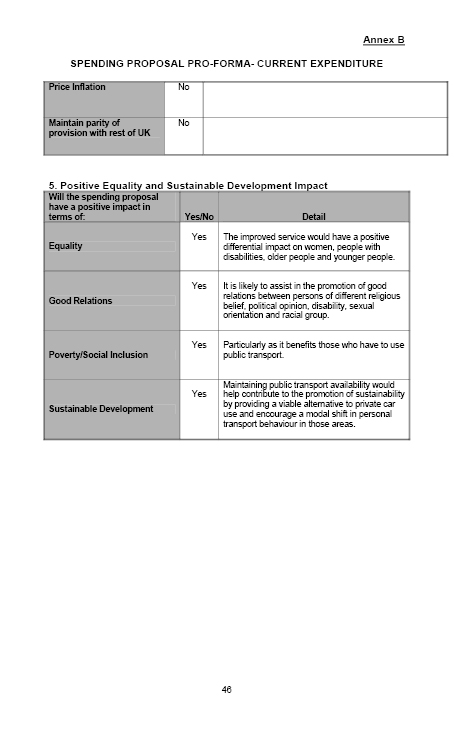
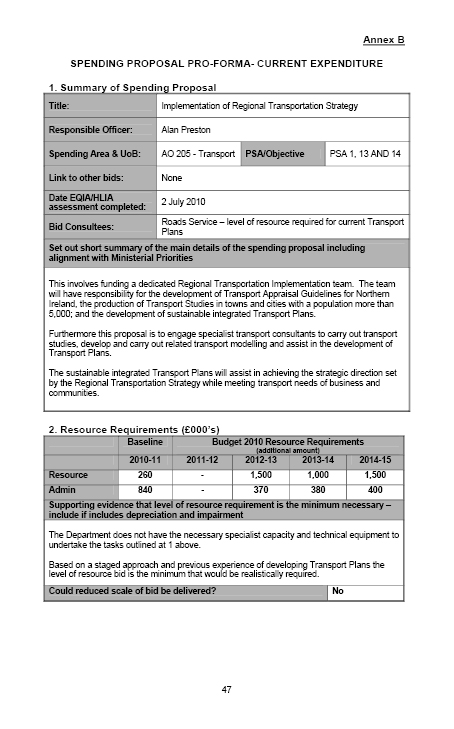

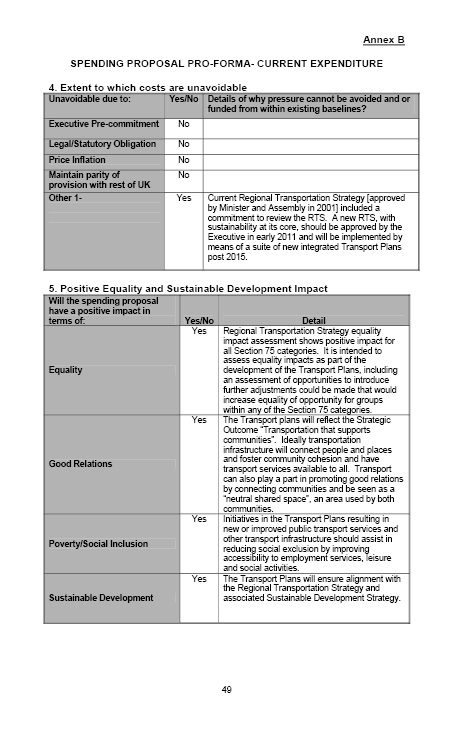


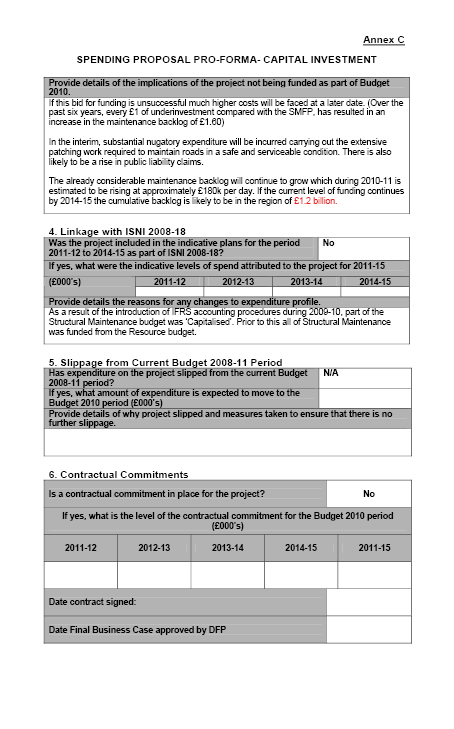


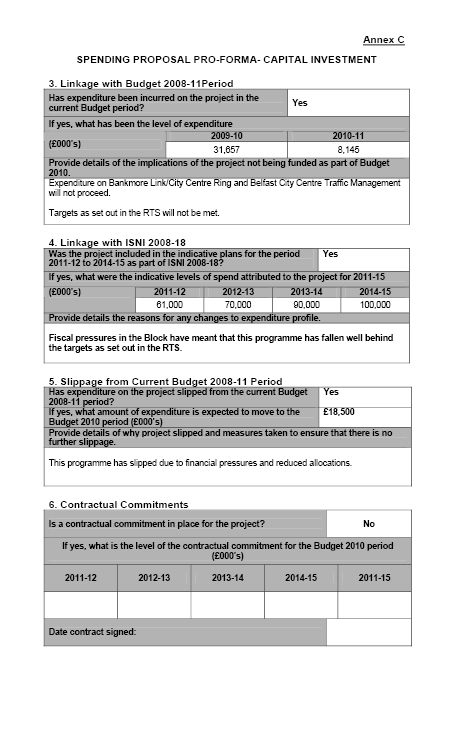
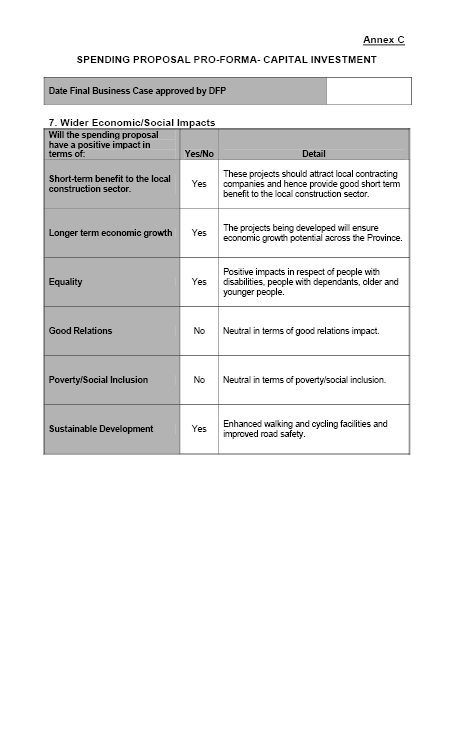



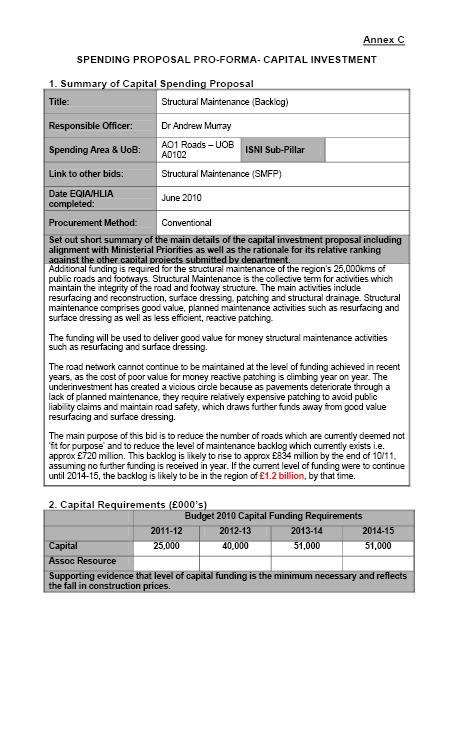
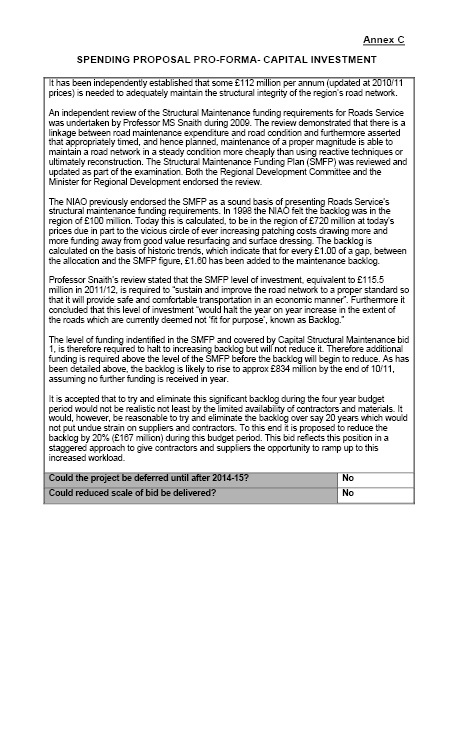
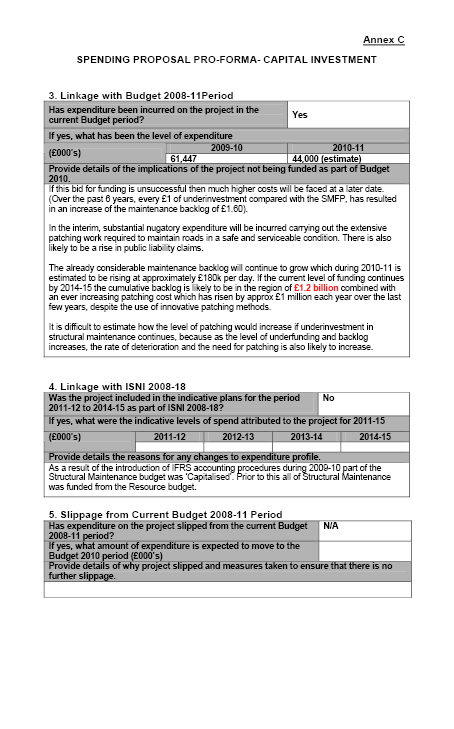

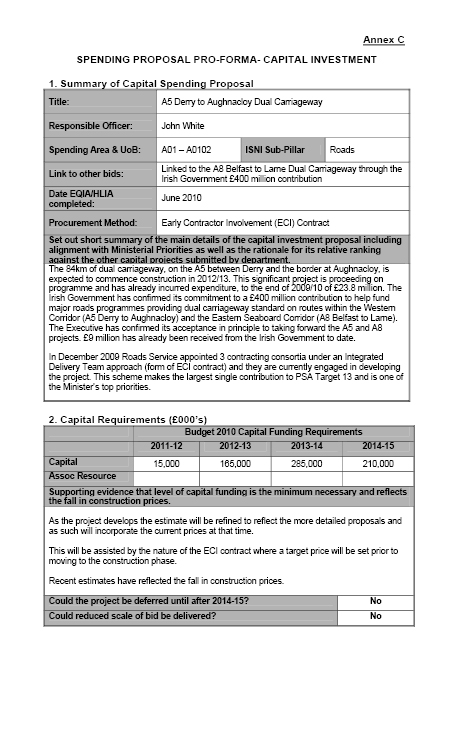


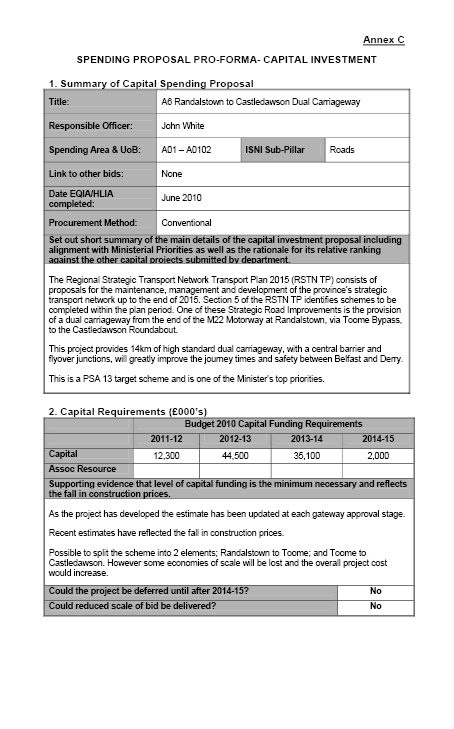
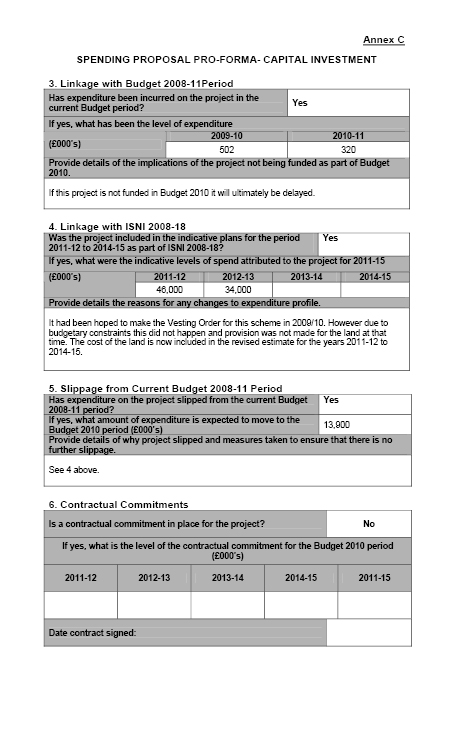
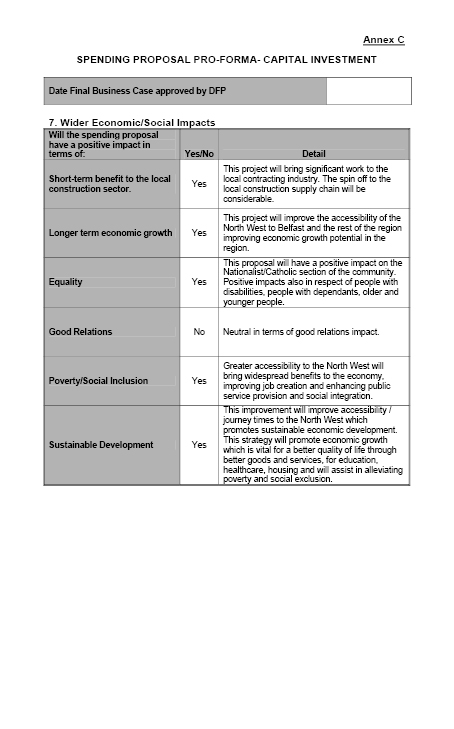

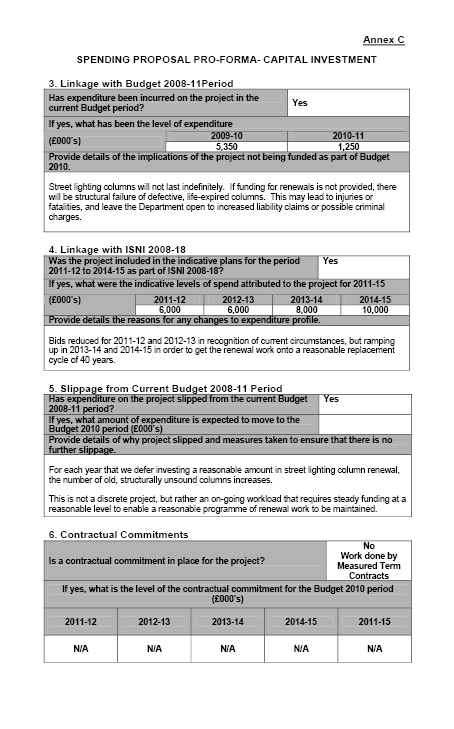


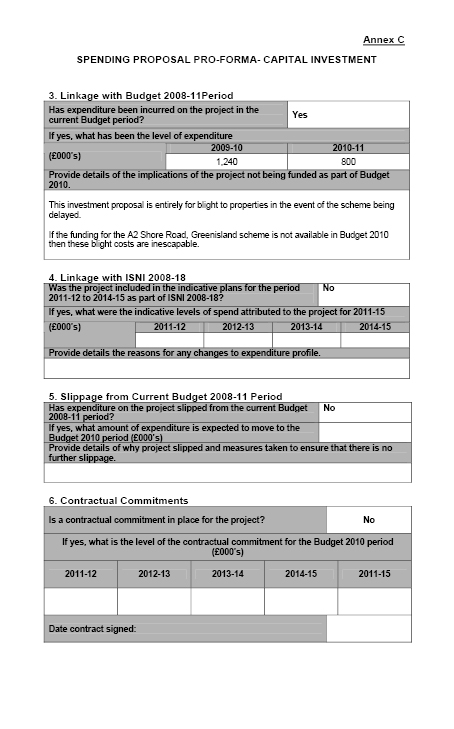
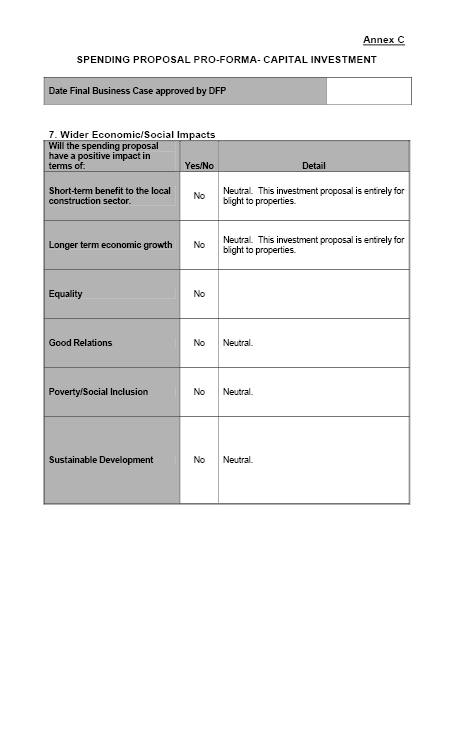

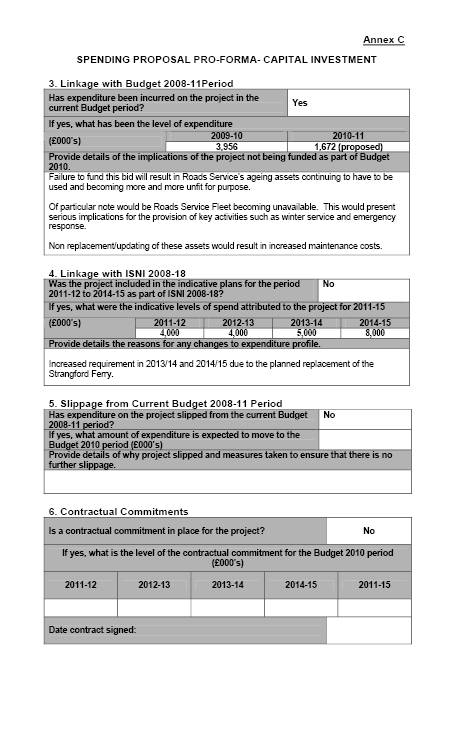
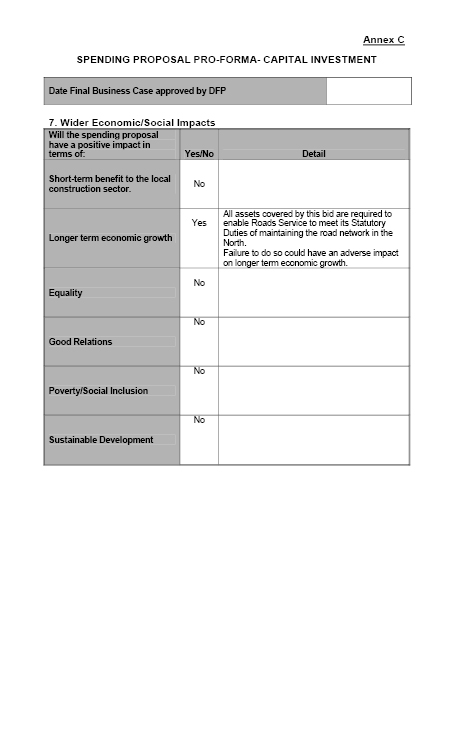
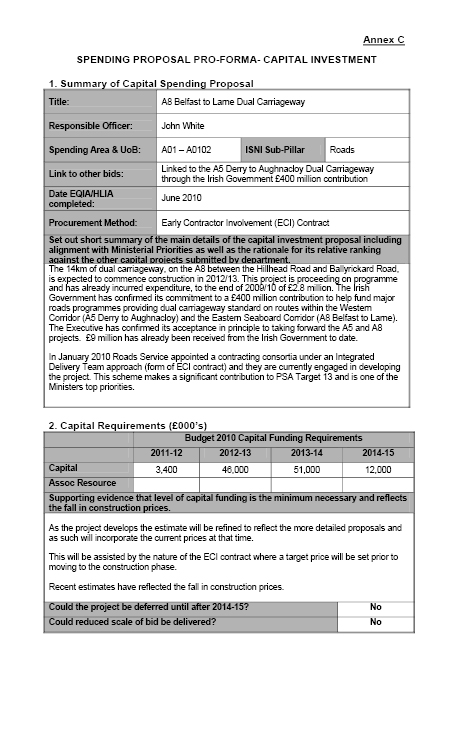

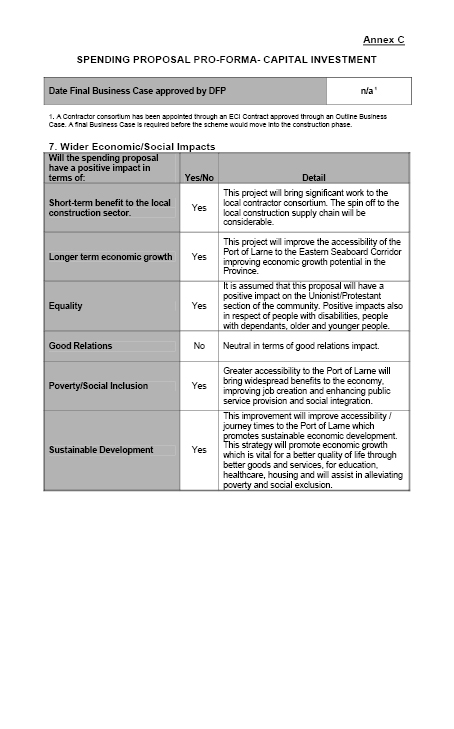


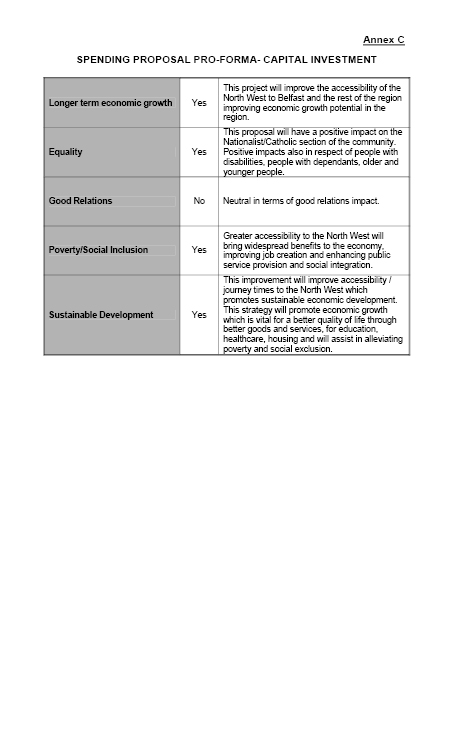
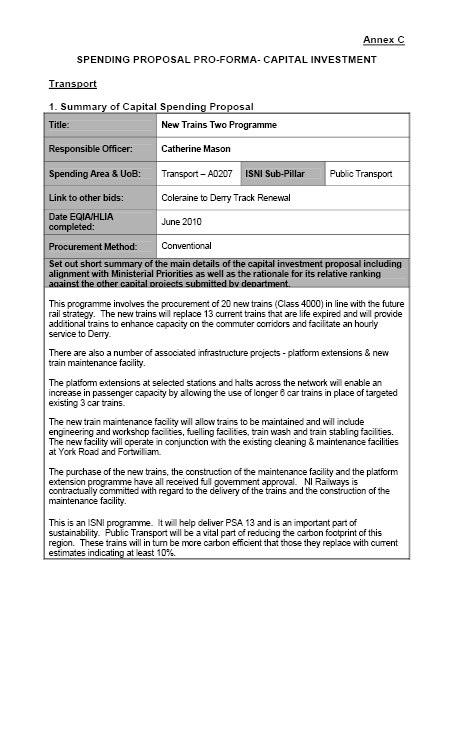

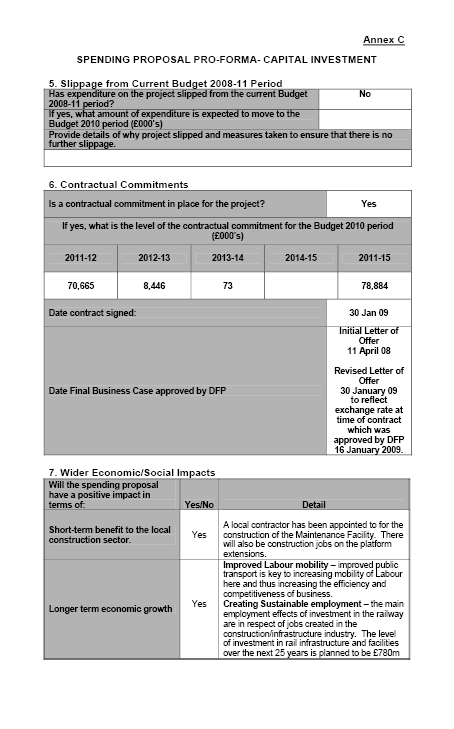
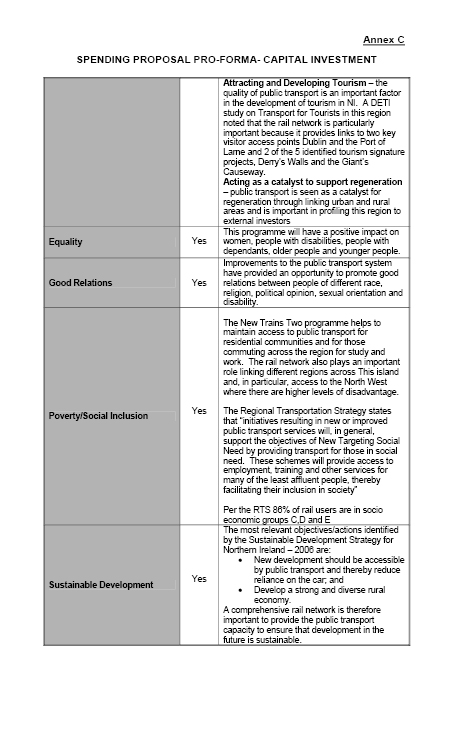
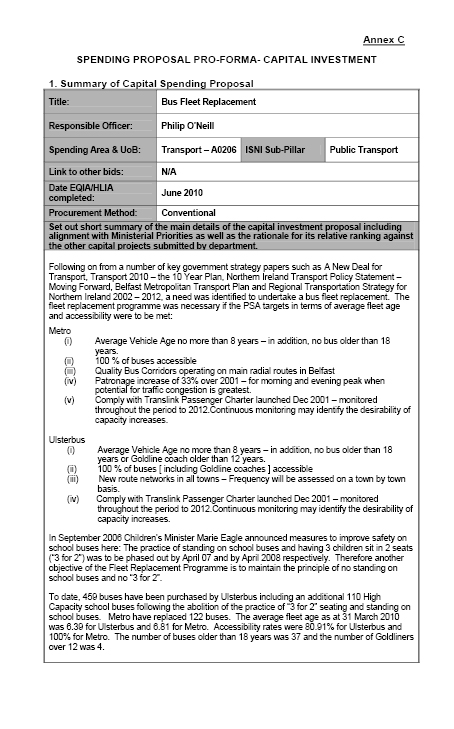
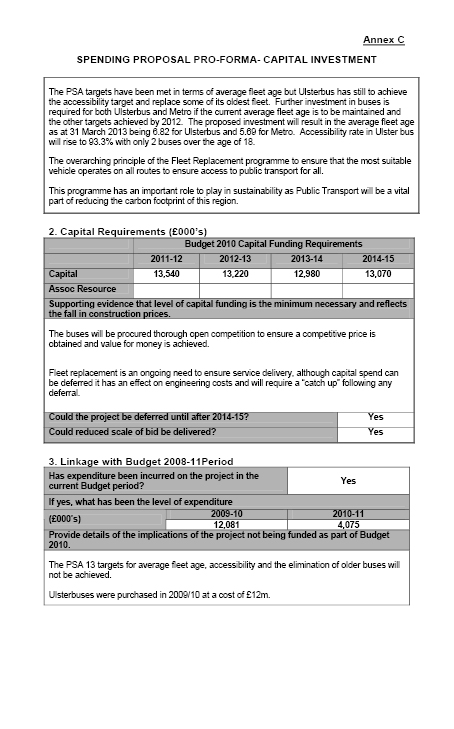


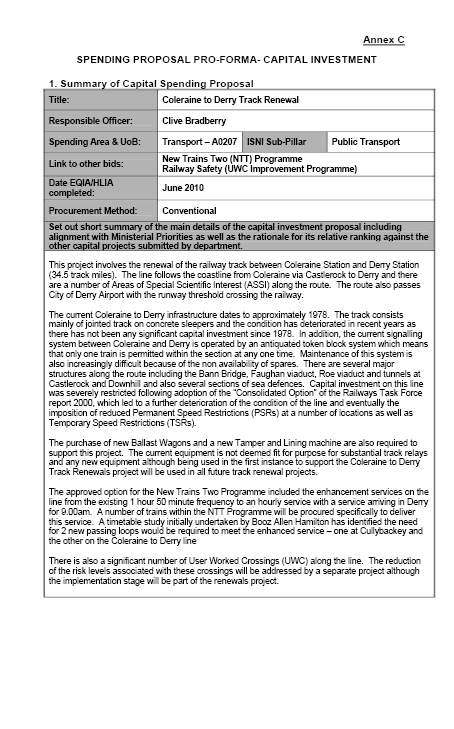

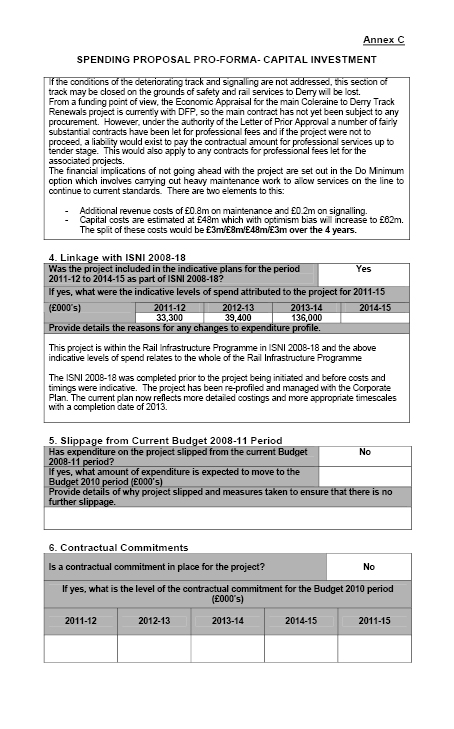

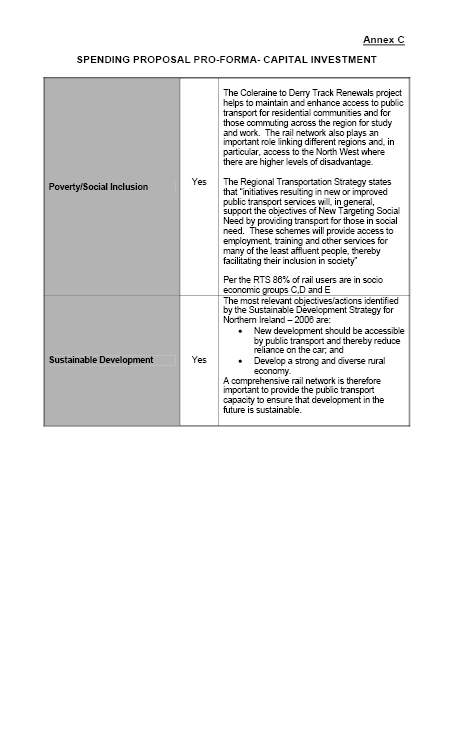

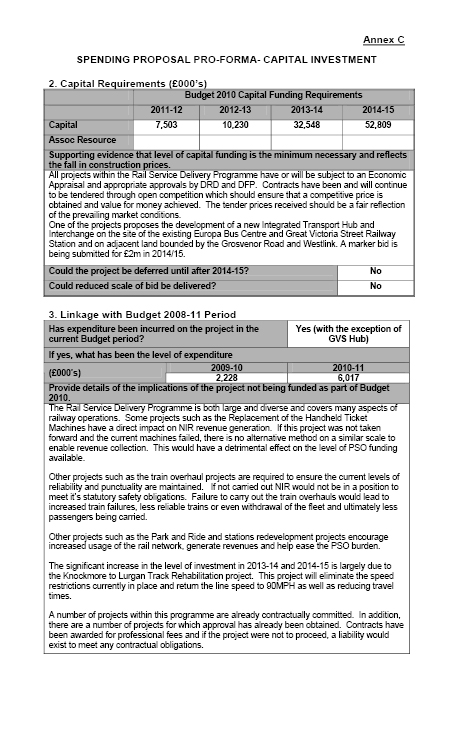
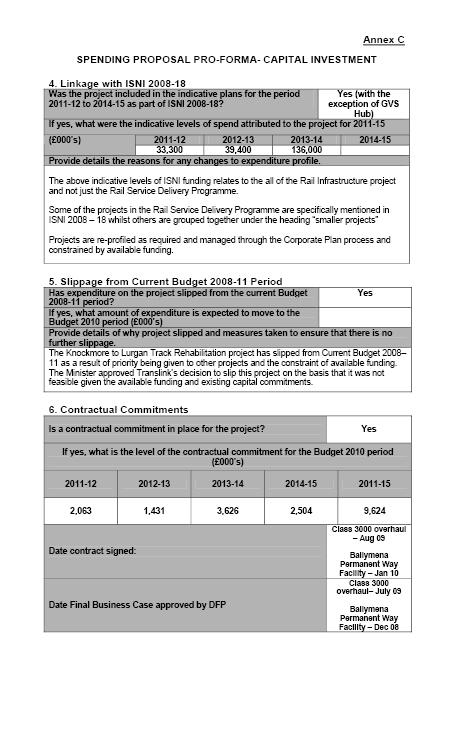
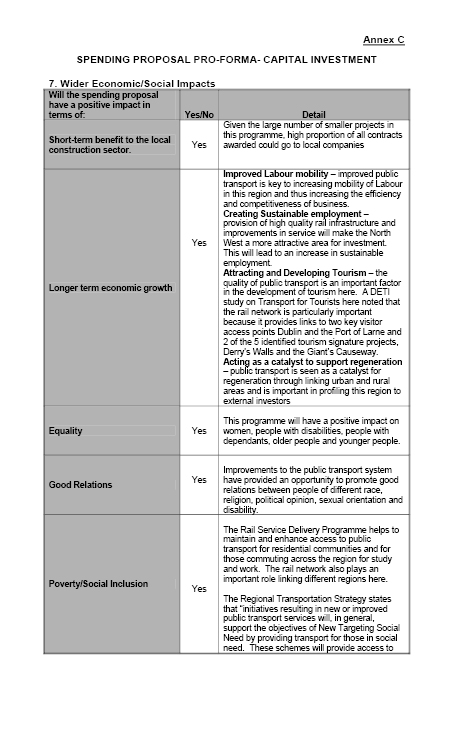

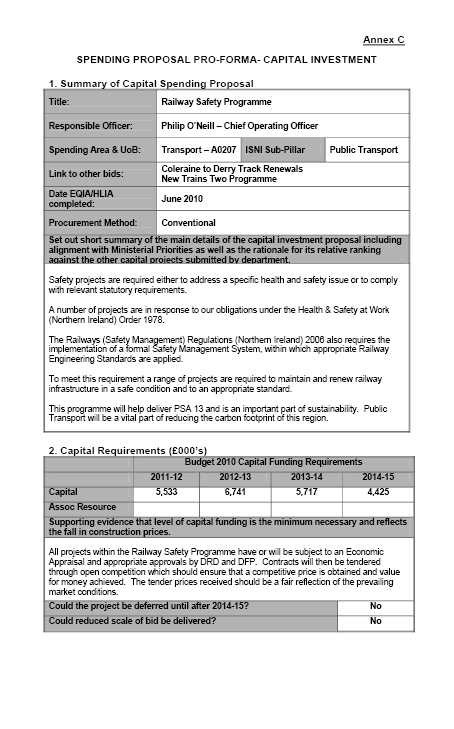
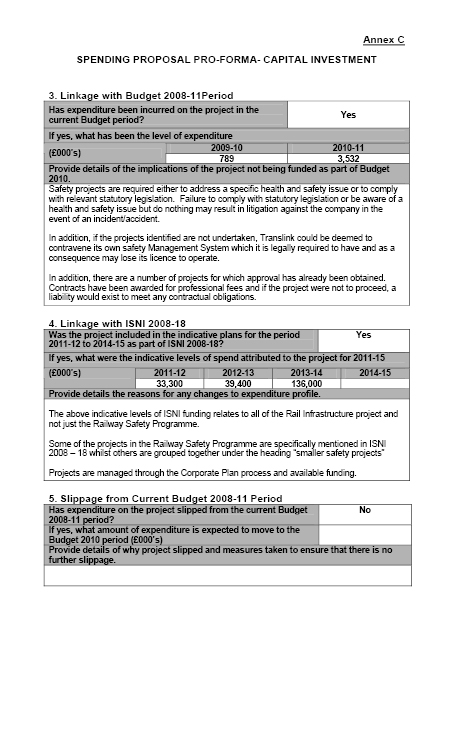

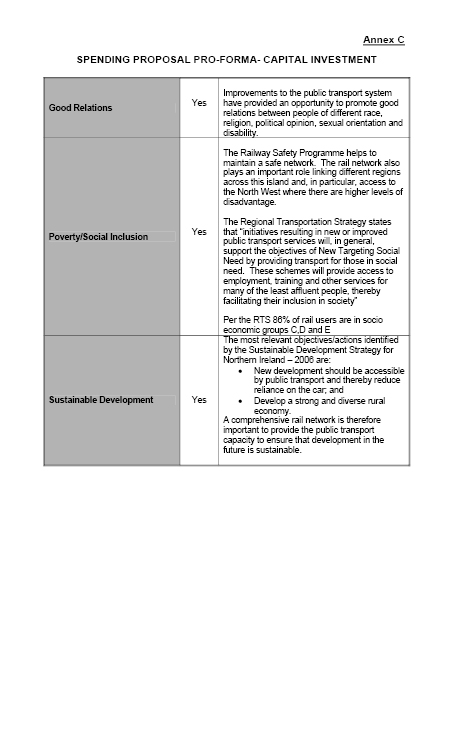
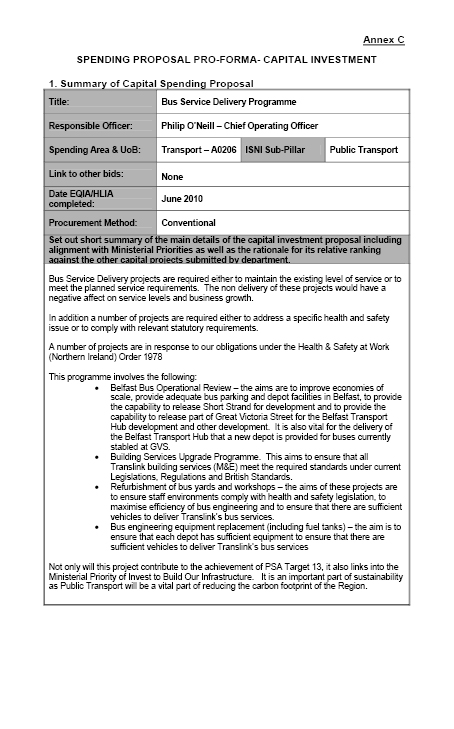
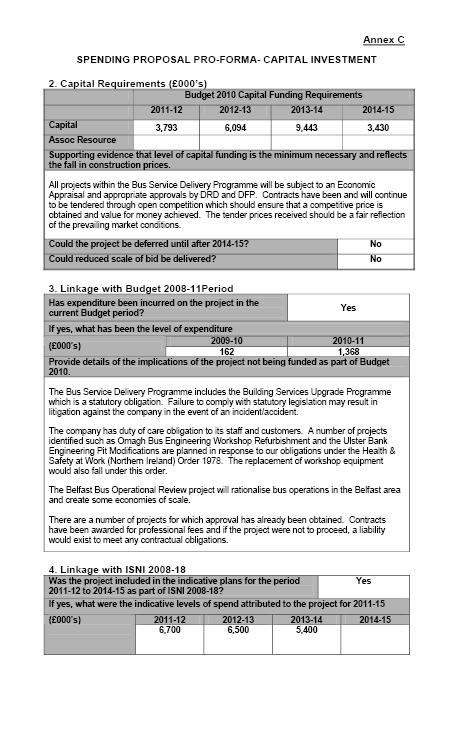

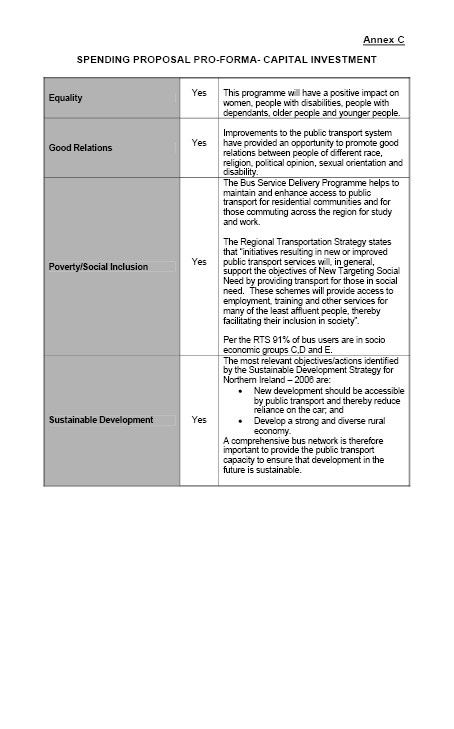


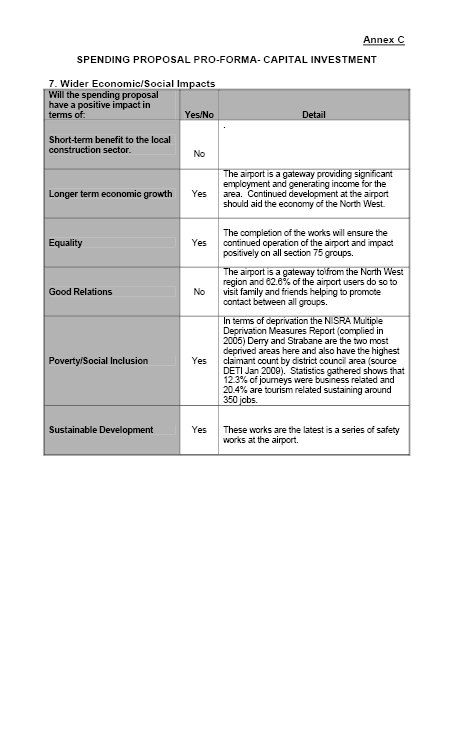

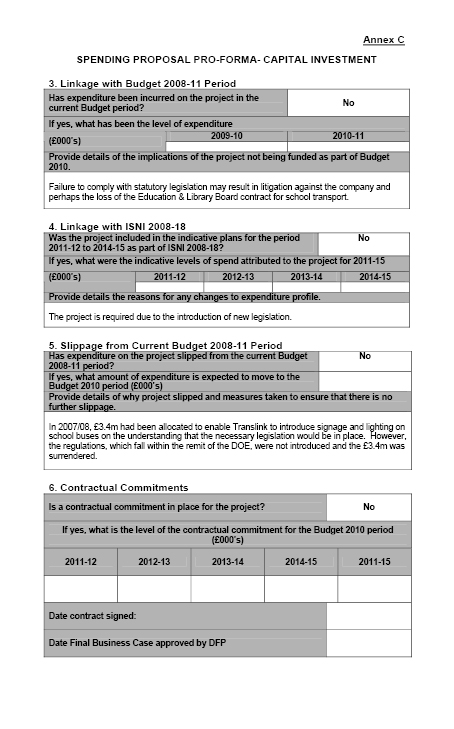
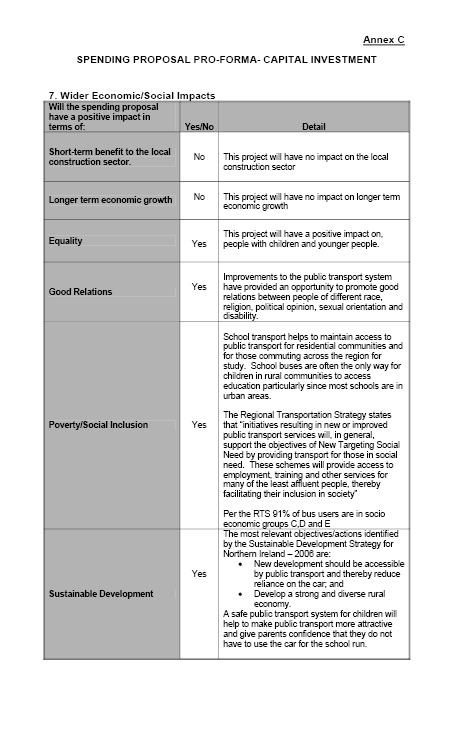
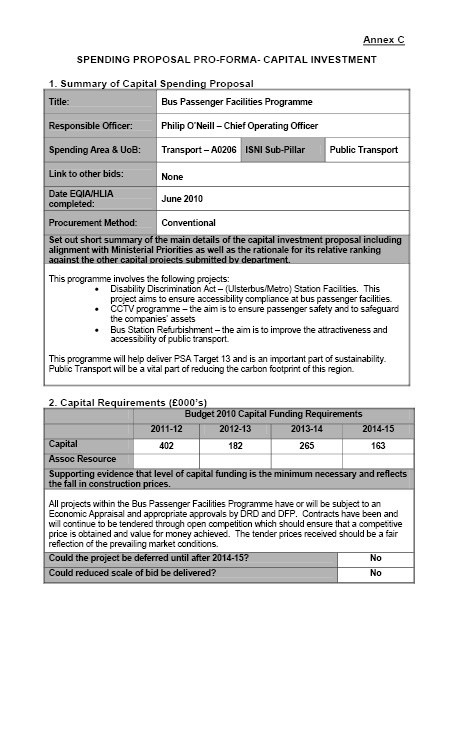
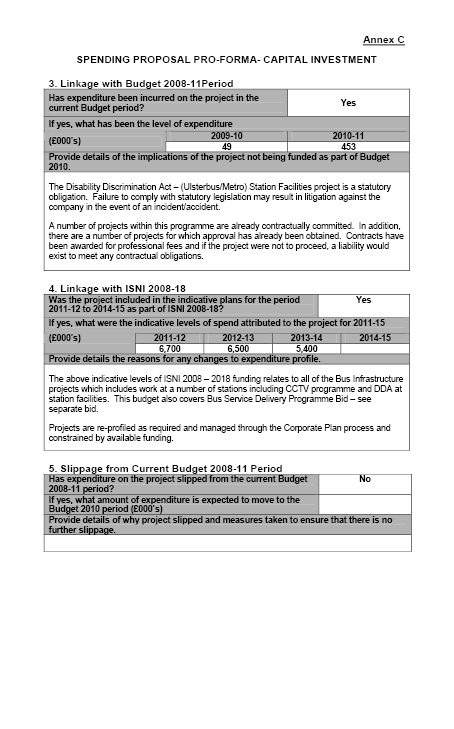
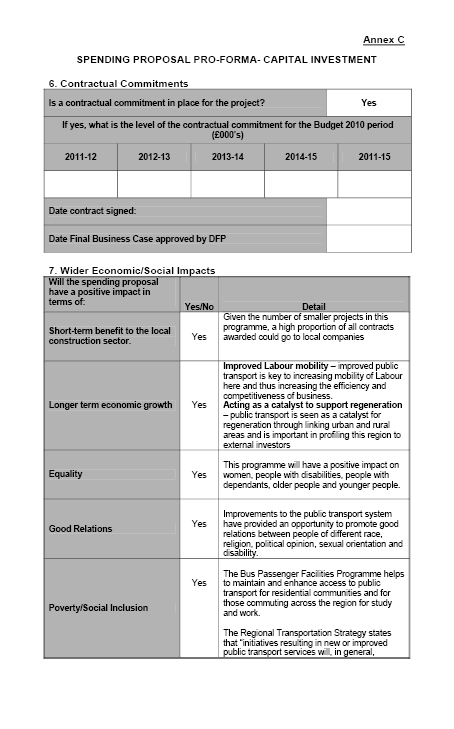
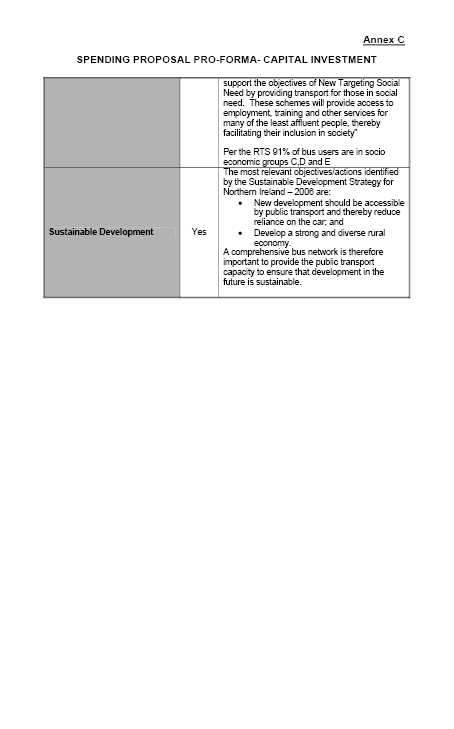
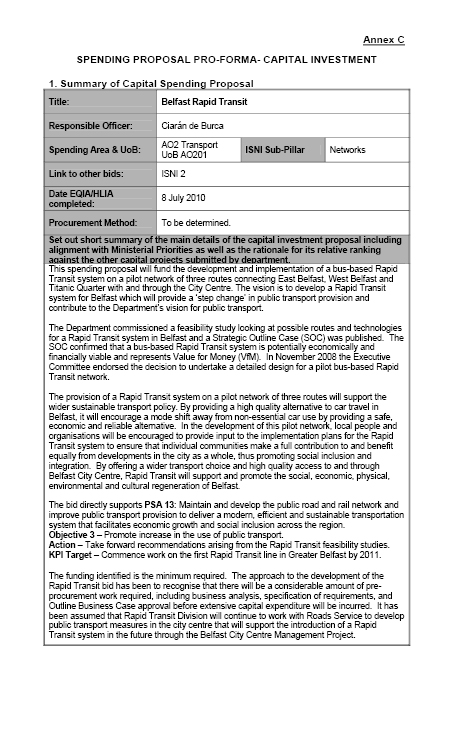
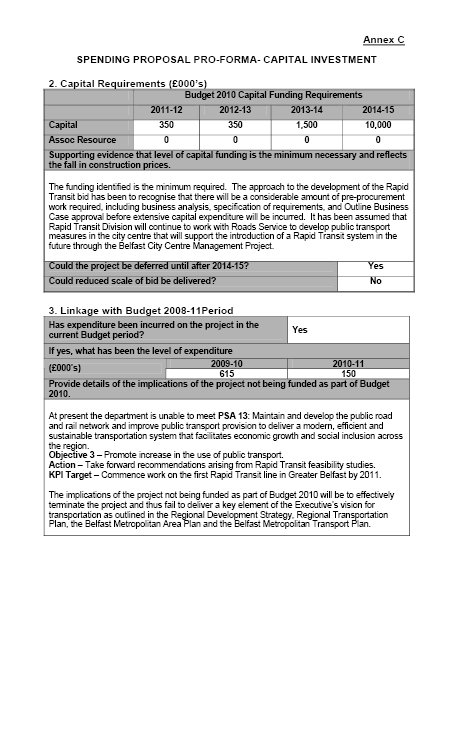
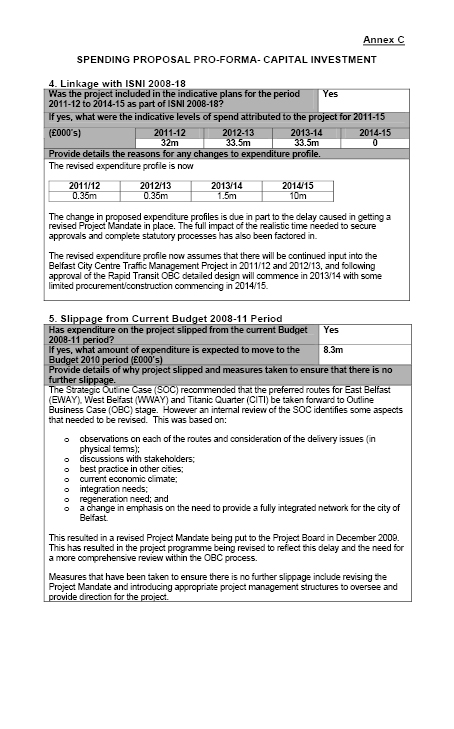
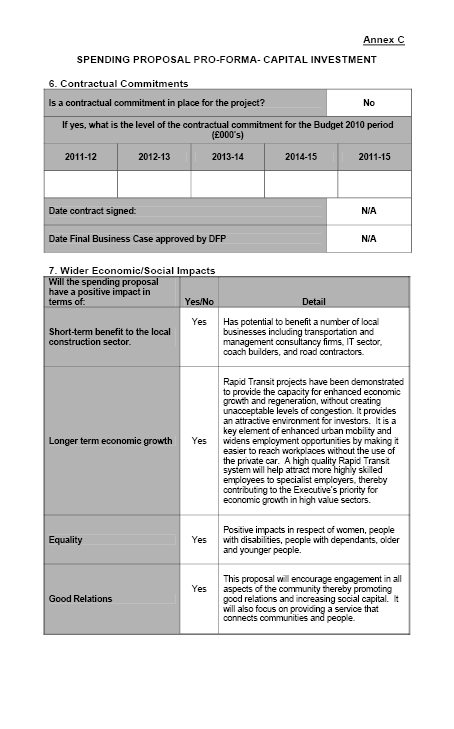
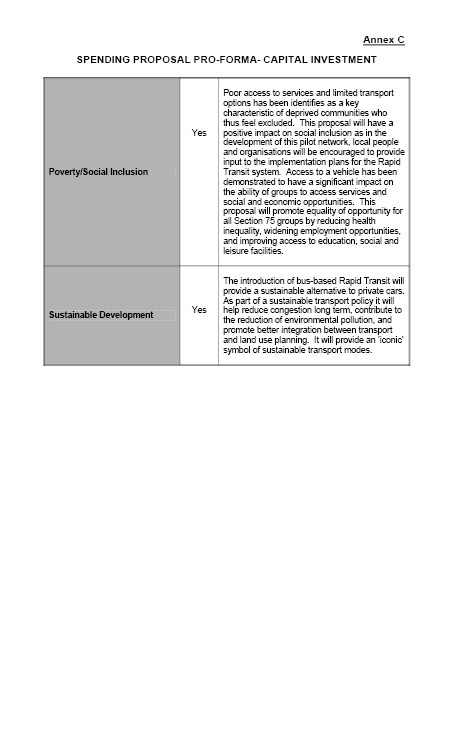
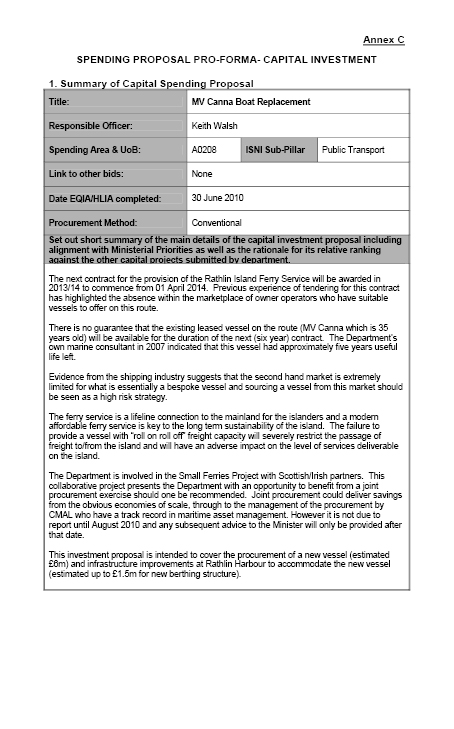
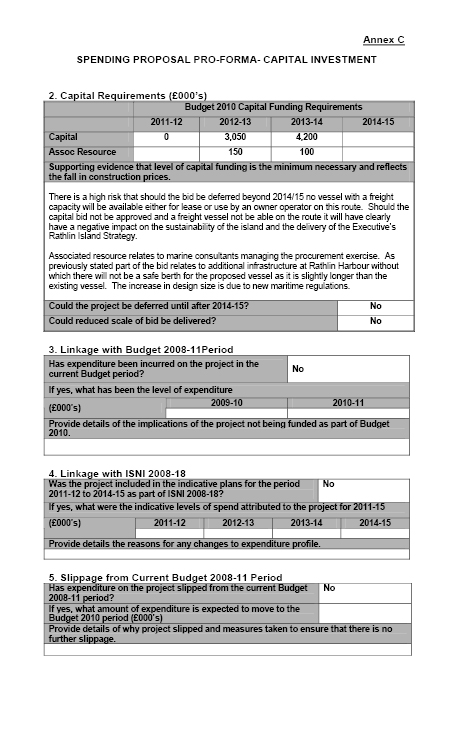
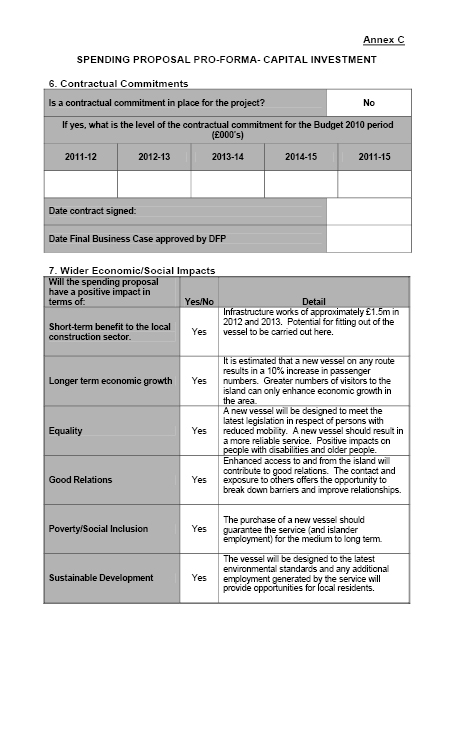
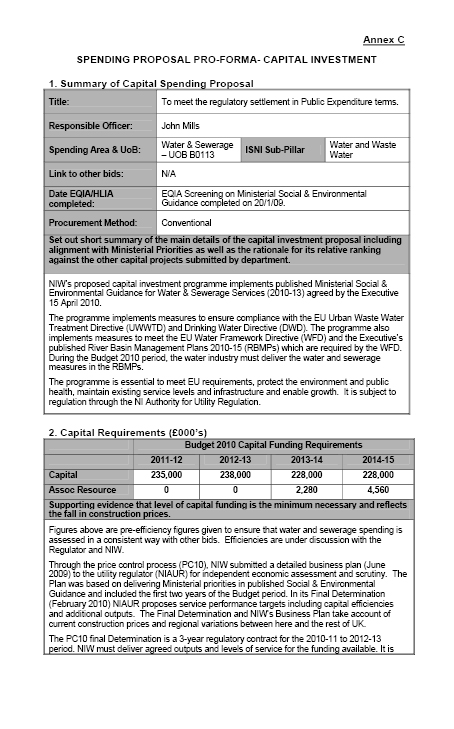
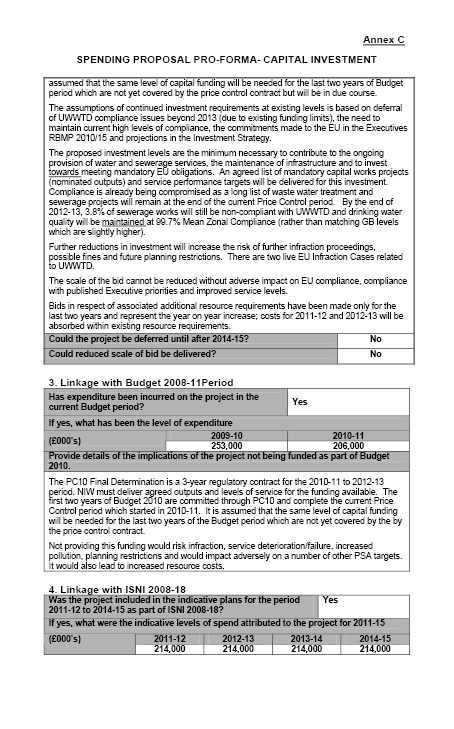
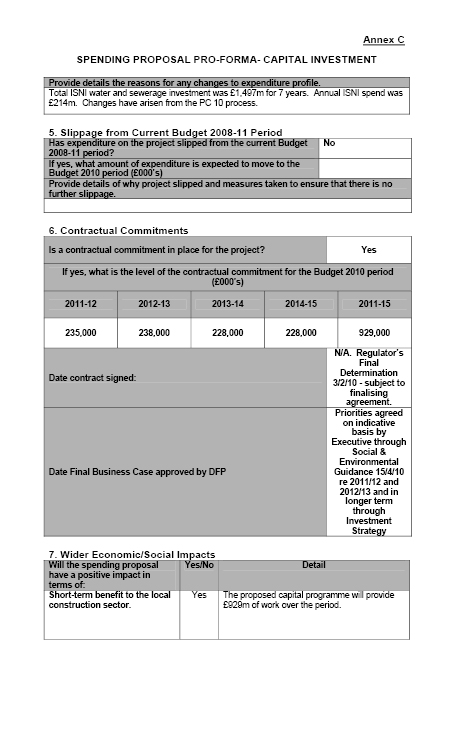
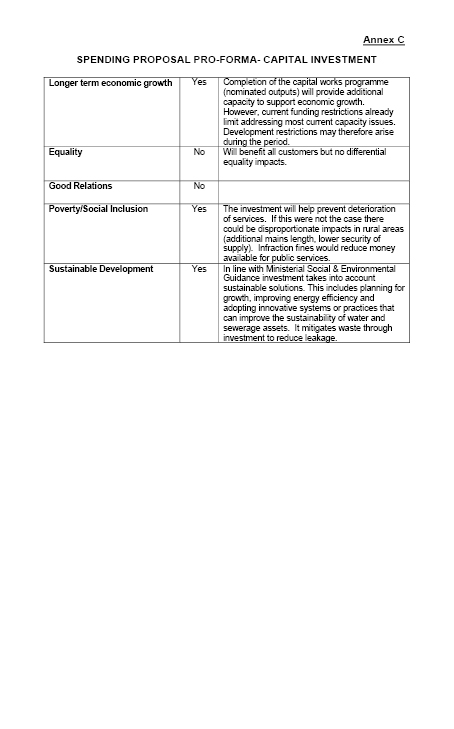
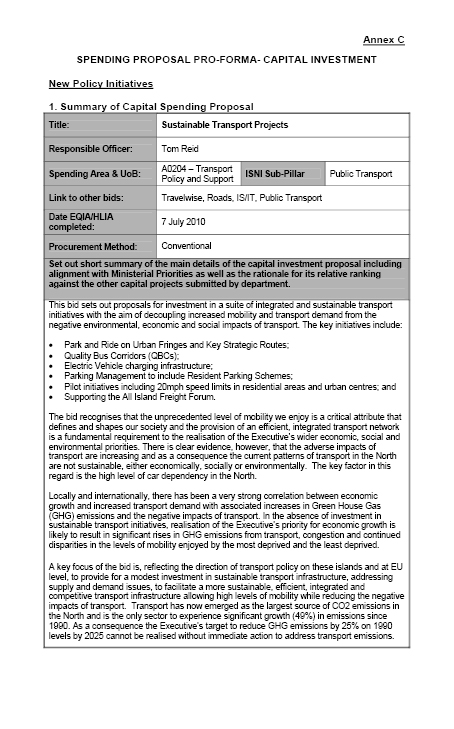
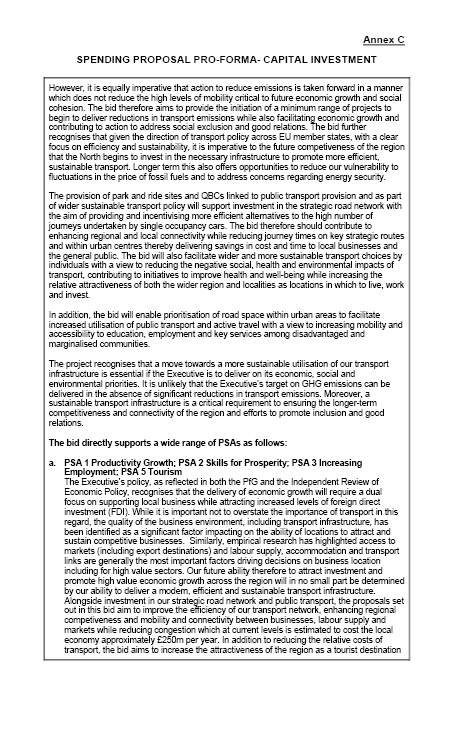

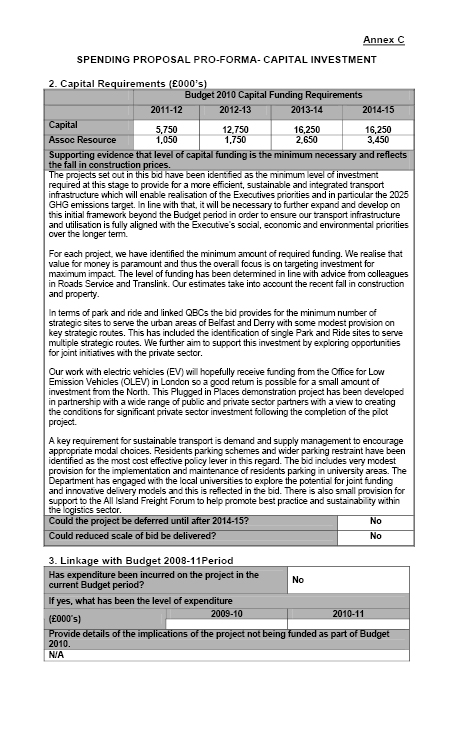
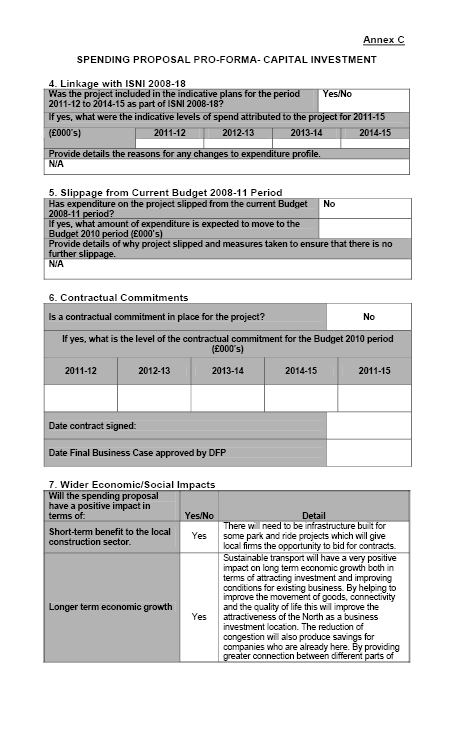
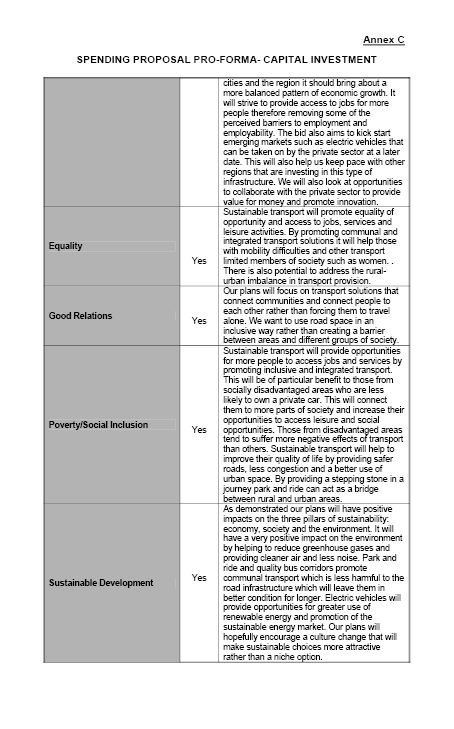
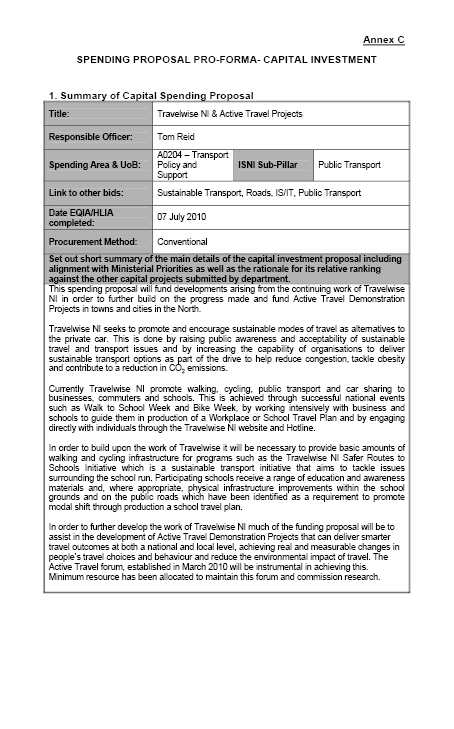
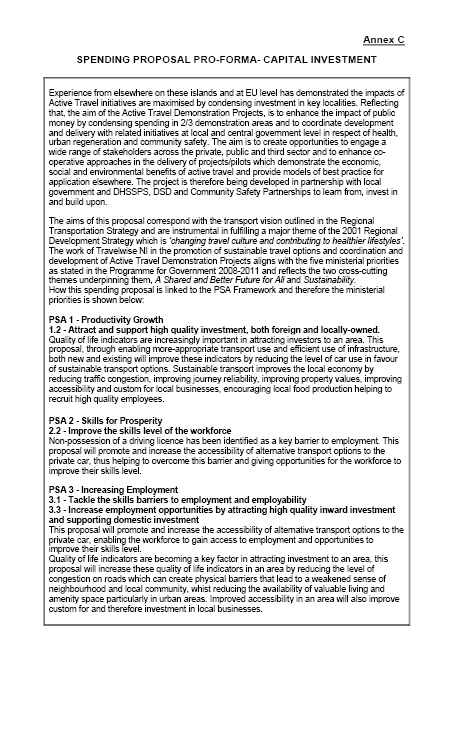

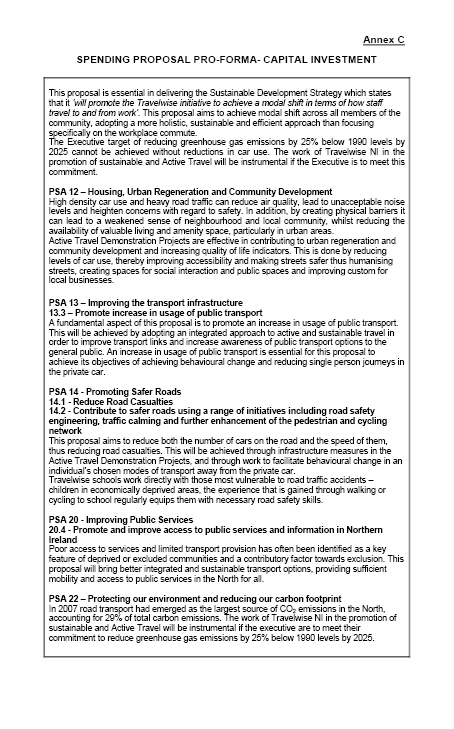

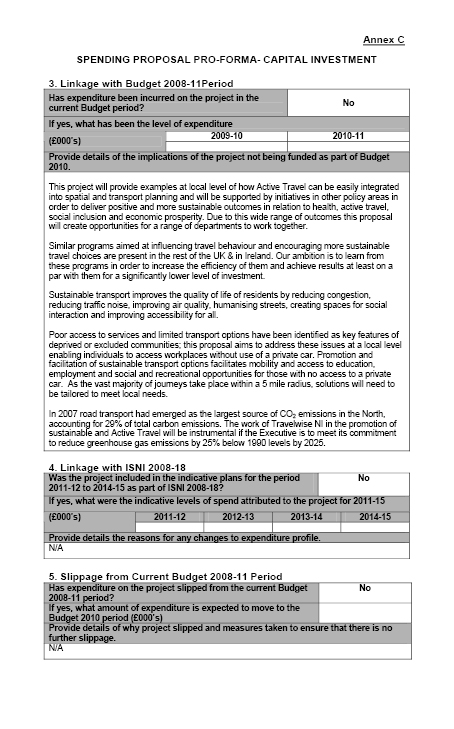
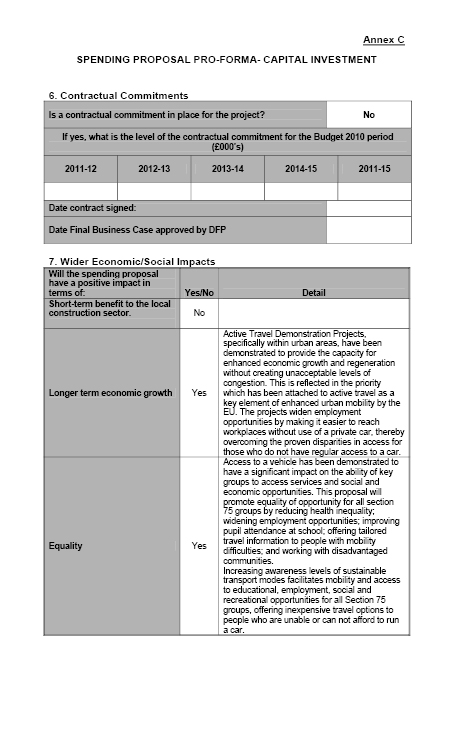
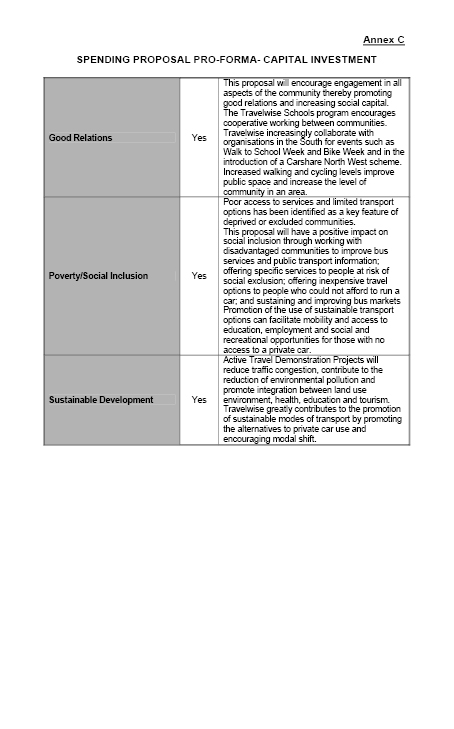


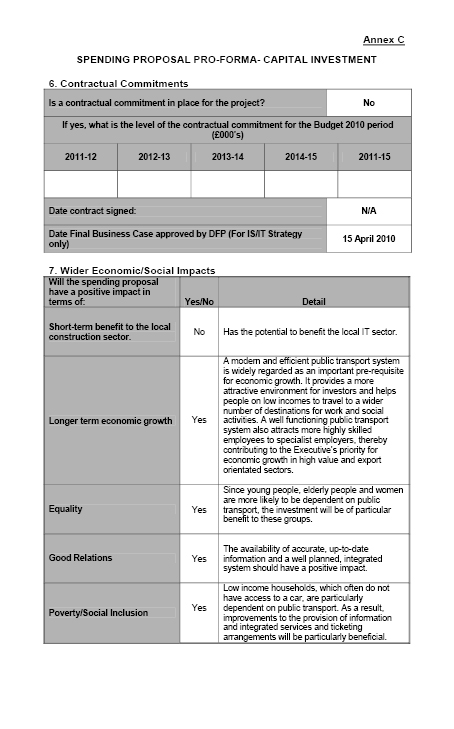

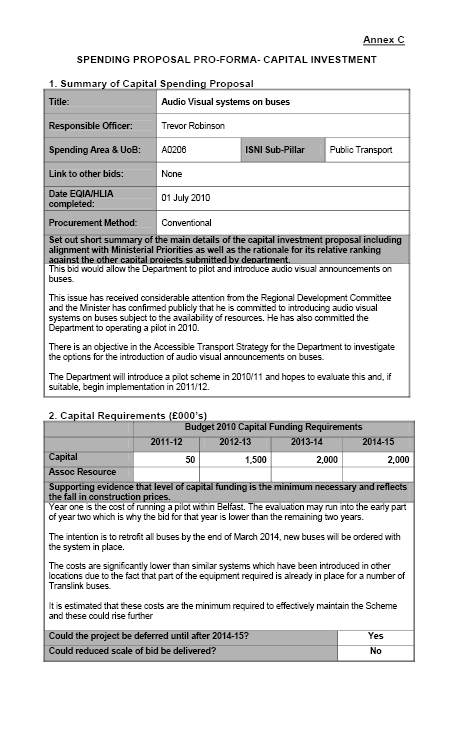



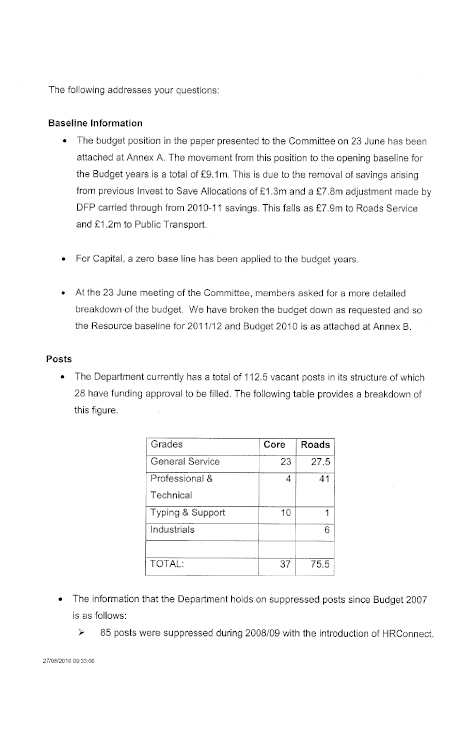
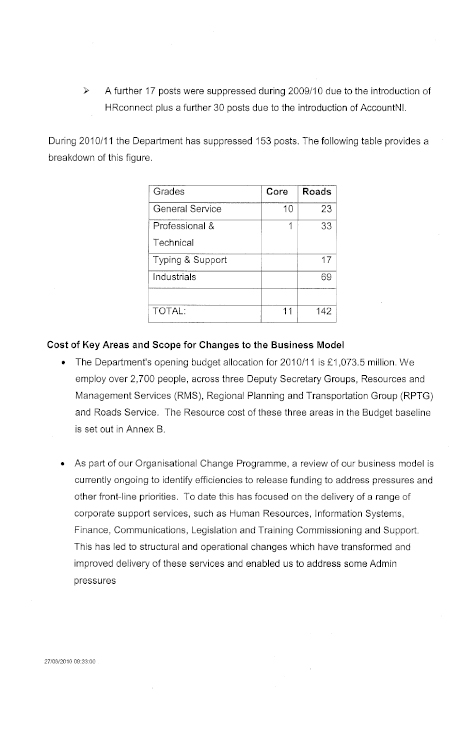
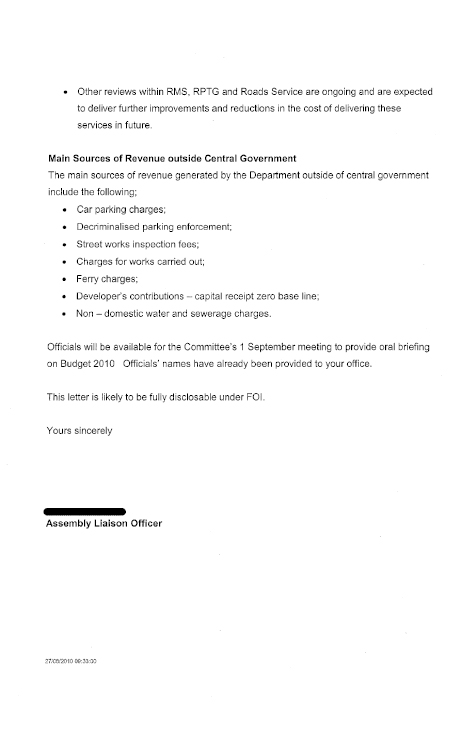


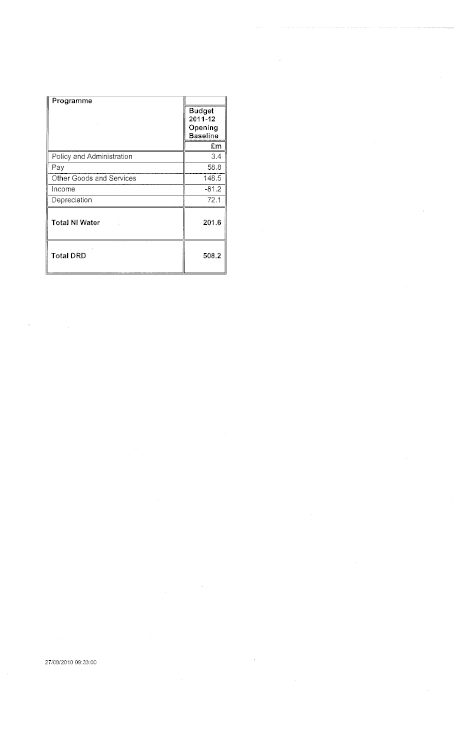
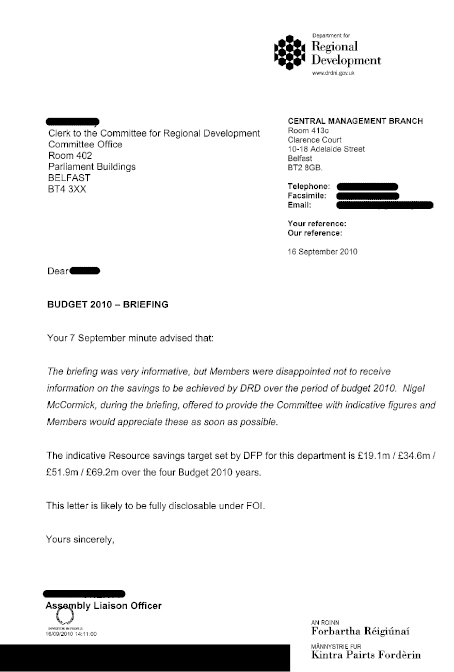
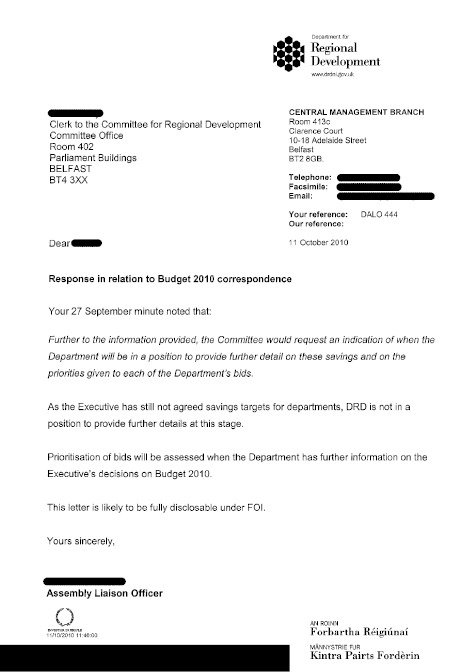
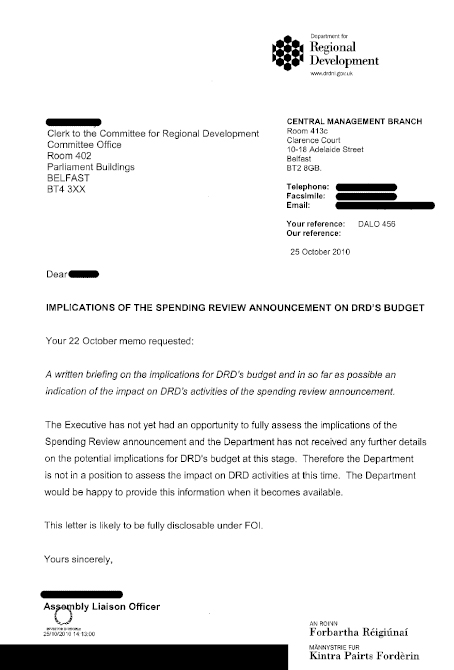
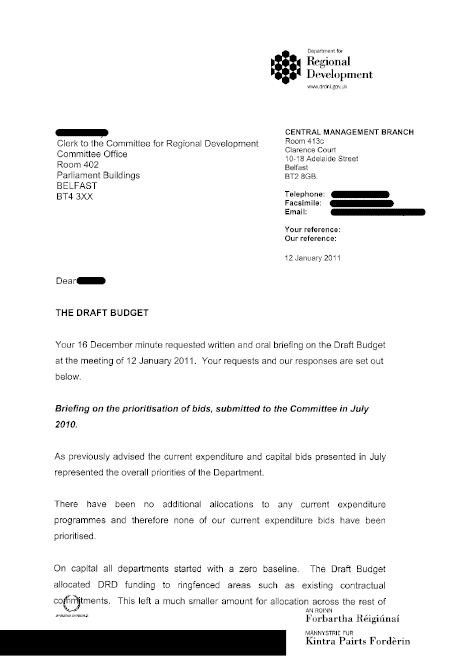
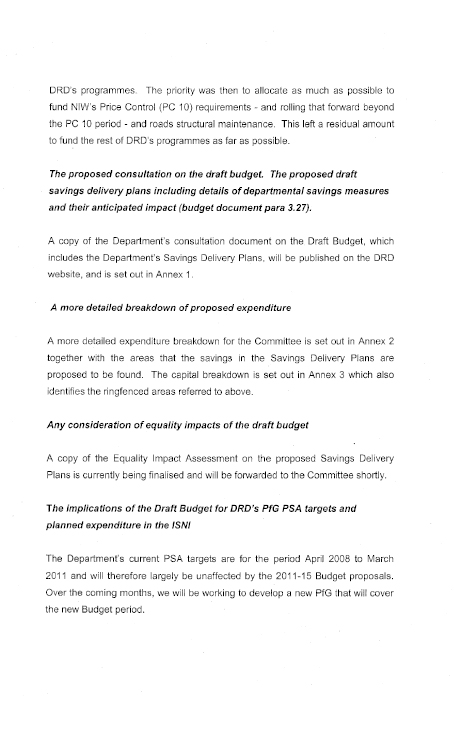
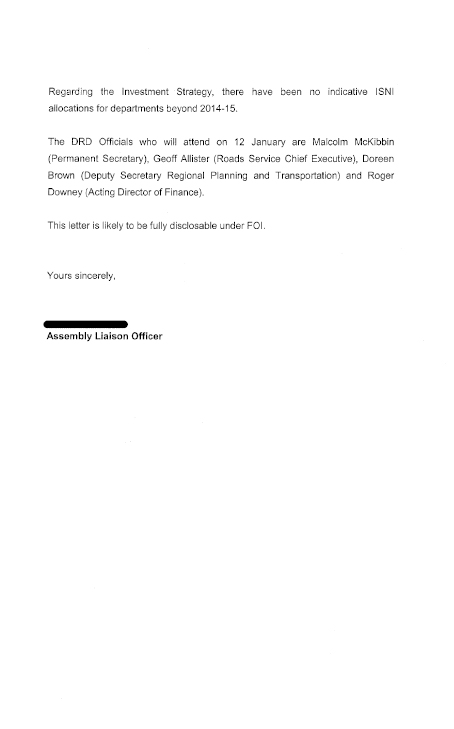
For Regional Development
January 2011
Draft Budget 2011-15:
Spending and Savings Proposals within the Department of Regional Development
Introduction
Spending Proposals
Savings Delivery Plans
Appendix 1: Savings Delivery Plans
Appendix 2: Draft Budget 2010 Policy and Equality Impact Assessment Consultation
[This shall be published shortly]
1. The NI Executive’s ‘Draft Budget Document 2011-15’ was announced on the 15 December by the Minister for Finance and Personnel. The Draft Budget set out the proposed current expenditure and capital investment allocation for NI Departments over the four Budget periods 2011-15. It can be accessed on the Budget website: www.northernireland.gov.uk/budget2010
2. This paper sets out the spending proposals and savings plans for the Department for Regional Development (DRD) over the Budget years.
3. The announcement of the Draft Budget commenced a period of public consultation the closing date being 9 February 2011.
4. In parallel DRD is also running a consultation on its own departmental spending proposals and savings plans. This will include a separate Equality Impact Assessment details of which can be found at Appendix 2. This shall be published shortly.
5. The Department has already met with the Assembly Committee for Regional Development on its spending proposals and savings options. The Department will continue to consult with the Committee and other stakeholders over the coming weeks.
6. We are also interested in hearing your views on any aspect of the attached documents and would ask all interested parties to provide their responses prior to the consultation closing date of 9 February 2011.
7. If this document is not in a format that suits you please let us know. Contact details can be found below.
Roger Downey
Acting Director of Finance
Department for Regional Development
Room 4.27
Clarence Court
10-18 Adelaide Street
Belfast
BT2 8GB
Telephone: 02890 540848
E-mail: DRD.BudgetConsultation@drdni.gov.uk
8. Comments should be sent to arrive no later than 9 February 2011.
9. Individual replies will not be issued to respondents, but a list of respondents together with responses will be published on the Department’s website. If you do not wish your response or name to be published on the website please advise in your correspondence to us.
10. The Executive’s priority in this Budget is to stimulate the economy, tackle disadvantage, protect the most vulnerable in our society and protect front line services. As historically the largest capital department, DRD has a lead role to improve the infrastructure to support this within the available funding.
11. The overall aim of the Department is to improve quality of life by securing transport and water infrastructure and shaping the region’s long-term strategic development. In pursuing this aim the key objectives of the Department are:
12. The Draft Budget allocations for 2011-15 are set out in Tables 1 and 2 below.
| Objective and Spending Area | 2011-12 £m |
2012-13 £m |
2013-14 £m |
2014-15 £m |
|---|---|---|---|---|
| Objective A | ||||
| Roads | 209.5 |
200.8 |
194.9 |
188.7 |
| Transport | 90.5 |
92.8 |
71.1 |
71.7 |
| Total Objective A | 300.0 |
293.6 |
266.0 |
260.4 |
| Objective B | ||||
| Water and Sewerage | 200.3 |
193.6 |
193.6 |
193.6 |
| Total Objective B | 200.3 |
193.6 |
193.6 |
193.6 |
Total |
500.3 | 487.2 | 459.6 | 454.0 |
| Objective and Spending Area | 2011-12 £m |
2012-13 £m |
2013-14 £m |
2014-15 £m |
|---|---|---|---|---|
| Objective A | ||||
| Roads | 144.9 |
254.5 |
387.4 |
324.7 |
| Transport | 90.7 |
25.7 |
13.3 |
53.9 |
| EU Structural Funds | 0.2 |
0.1 |
0.2 |
0.2 |
| Total Objective A | 235.8 |
280.3 |
400.9 |
378.8 |
| Objective B | ||||
| Water and Sewerage | 202.5 |
145.0 |
140.0 |
180.0 |
| Total Objective B | 202.5 |
145.0 |
140.0 |
180.0 |
Total |
438.3 | 425.3 | 540.9 | 558.8 |
13. The Draft Budget allocations would help DRD to continue to improve elements of our roads, transport and water infrastructure. They would also allow us to continue to fund the majority of our existing programmes including concessionary fares across DRD, albeit at a much reduced level.
14. The Draft Budget allocations would provide capital investment to DRD of almost £2 billion over the Budget 2010 period. This includes over £1.1 billion for roads, around £185 million for public transport and over £665 million for water and sewerage services.
15. However whilst Roads Service has a significant allocation, around £790 million (or 70% of it) is tied up in two major road schemes – the A5 between Derry and Aughnacloy and the A8 between Belfast and Larne. The Department acknowledges the Republic of Ireland’s contribution of £400 million towards the A5 and A8 schemes (of which £274 million is scheduled for this Budget period). However the overall reduction of 40% in the Executive’s Spending Review settlement, and the scale of these schemes, means that that there are no allocations to commence construction on other major roads schemes such as:
16. In addition there will be significant reductions in other capital improvement programmes such as walking and cycling, traffic calming, collision remedial, traffic management measures, local safety improvements and bridge strengthening. The impact will be particularly severe in 2012-13 and 2013-14.
17. This funding of the A5 and A8 also reduces the available funding for the transport and water and sewerage programmes, and there is no funding for the Knockmore to Lurgan track replacement or to fund the Utility Regulator’s recommended capital funding level in 2012-13.
18. As part of the Draft Budget the Executive signalled its intent to continue to focus on additional revenue raising methods. If, over the course of the budget period, additional funding became available to DRD as a consequence of such methods then the Department would seek to allocate funding to valuable projects which are currently unfunded, such as the Knockmore to Lurgan rail track improvement project, major roads schemes like those noted at paragraph 15 above, and further funding to meet the current investment shortfall for water and sewerage infrastructure.
19. The Department would still however be able to take forward the following projects.
20. On roads, the allocations would allow the Department to begin construction of:
21. The Draft Budget allocations in capital and current expenditure for roads structural maintenance total around £94m / £52m / £56m / £82m over the Budget period. This averages at around current levels totalling over £280 million over the four year period. However these levels of structural maintenance expenditure are still around £200 million short of levels recommended in the Structural Maintenance funding Plan over the Budget period (at nominal prices). It should be noted that given the profile of expenditure on the A5 and A8, the available funding is much lower in years 2012-13 and 2013-14 – falling from a record high of £94 million in year 2011-12.
22. This level of investment, coupled with reductions in roads maintenance activities, is predicted to lead to the network being less resilient to extreme weather events such as freeze / thaw cycles and flooding.
23. On transport the Draft Budget allocations would allow the Department to continue to support Translink to:
24. The spending proposals would also allow the Department to fund the development of a bus based Rapid Transit system on a pilot network of three routes connecting East Belfast, West Belfast and Titanic Quarter with and through the City Centre.
25. In addition DRD would be able to plan to invest in a number of sustainable transport initiatives - electric vehicle charging infrastructure, the ‘Belfast on the Move’ proposals, and some other bus priority measures.
26. On water and sewerage the allocations would also allow DRD to provide funding to NI Water to help meet the priorities agreed by the Executive (in Social and Environmental Guidance for Water and Sewerage Services - May 2010) to maintain and improve our infrastructure, deliver sustainable and affordable levels of service to consumers and meet EU compliance obligations. The levels of funding are based on an assessment by the NI Authority for Utility Regulation (Water and Sewerage Services Price Control 2010-2013 Final Determination – February 2010
27. NI Water will continue to deliver the improvements in its significant capital works programme over the three year Price Control (PC10) period. This includes:
28. Recent interruptions to water supplies have highlighted the ongoing need for adequate investment in our water and sewerage infrastructure. Investment in 2011-12 and 2014-15 is largely as planned. However in 2012-13 and 2013-14 only around three quarters of the planned investment has been allocated. Although the funding will not meet all proposals it is still a significant level of investment of £203m / £145m / £140m / £180m. The Regulator’s Determination targets are subject to revision once budgetary allocations are agreed as part of the Revised Budget and the Department will work with NI Water, the Regulator and other stakeholders to undertake any necessary re-prioritisation.
29. DRD will take forward a range of measures to deliver the additional savings of £15.7m / £28.8m / £56.4m / £62m current expenditure by 2014-15. The main areas for the proposed savings include:
30. Details of these savings and their impacts are available in the Department’s Savings Delivery Plans (SDPs) in Appendix 1.
31. Due to the historic underfunding of the railway Public Service Obligation the Department proposes to allocate around £13 million over the Budget period to this programme. £5.2 million of this is proposed to be funded from additional savings in the SDPs and £7.7 million from a reclassification from capital expenditure. The Department also proposes to reclassify £1.6 million from capital expenditure to fund roads maintenance activities in current expenditure in 2014-15. These reclassifications are subject to Executive approval as part of the Revised Budget process.
The Department is required to fund cumulative current expenditure reductions of £17.0m / £30.1m / £57.7m / £63.3m over the Budget period from the opening 2010-11 budget position of £517.3m.
Included in the £517.3m is an allocation of £1.3m for roads and transport Invest to Save projects. As this is automatically returned to the Executive as part of the terms of the original allocation, DRD has to fund the remaining reductions of £15.7m / £28.8m / £56.4m / £62m totalling £162.9m. This is set out as follows.
| 2011-12 £m |
2012-13 £m |
2013-14 £m |
2014-15 £m |
|
|---|---|---|---|---|
| Draft Budget Current Expenditure Reductions in each year | 17.0 |
30.1 |
57.7 |
63.3 |
| Removal of 2010-11 Invest to Save | (1.3) |
(1.3) |
(1.3) |
(1.3) |
| Savings Delivery Plan Targets | 15.7 |
28.8 |
56.4 |
62.0 |
The Department is treating these reductions as the overall savings target. There are no proposals to make further savings to allocate additional funding to existing current expenditure programmes.
There have already been significant reductions to the Department’s current expenditure budget over recent years:
Significantly though in previous budgets, these savings were mitigated by additional allocations. This is not the case in this budget.
It has been a very difficult process to identify savings to these levels and the Department has looked at all programmes across DRD.
The process of reviewing savings and income generation options has been led by the senior management within the Department and a series of workshops has been conducted with the Minister. Each option has been considered by the Minister and senior management against an agreed list of priorities in order to assess the relative impact of each option put forward. The options proposed reflect the Department’s Objectives and Minister’s priorities.
Each saving proposal has also been subject to an equality screening to identify the differential equality impacts on Section 75 groups. Consideration was also given to the impact on sustainable development, good relations, poverty and social inclusion. A detailed Equality Impact Assessment can be found at Appendix 2. This shall be published shortly.
The Department’s proposed savings are summarised in the following table.
Title of Savings Measure |
Spending Area |
2011-12 (£000’s) |
2012-13 (£000’s) |
2013-14 (£000’s) |
2014-15 (£000’s) |
Total (£000’s) |
Type of Savings |
|---|---|---|---|---|---|---|---|
| Increased Parking Charges | Roads | 2,000 | 8,500 | 12,500 | 14,500 | 37,500 | Increasing Revenue |
| Reductions in Expenditure on Technical Advisors and Depreciation | Roads | 8,000 | 8,000 | 8,000 | 8,000 | 32,000 | Administration / Policy |
| Reductions in Maintenance Activities | Roads | 300 | 1,500 | 2,440 | 660 | 4,900 | Lower Priority Programmes |
| Savings in Street Lighting Energy and Parking Enforcement | Roads | 1,400 | 2,400 | 3,400 | 3,400 | 10,600 | Procurement |
| Park and Ride | Transport | 500 | 700 | 700 | 700 | 2,600 | Procurement |
| Concessionary Fares Policy | Transport | 400 | 400 | 400 | 400 | 1,600 | Policy |
| Rural Transport Fund | Transport | - | 300 | 600 | 800 | 1,700 | Funding |
| Transport Programme for People with Disabilities | Transport | - | 700 | 700 | 900 | 2,300 | Funding |
| Public Transport Reform | Transport | 2,000 | 700 | 700 | 700 | 4,100 | Funding |
| Rathlin Ferry Subsidy | Transport | - | - | 200 | 200 | 400 | Funding |
| NILGOSC Subsidy, Reimbursement Rates and Fuel Duty Rebate to NITHC | Transport | - | 860 | 5,800 | 2,800 | 9,460 | Funding |
| Technical Advisors | Transport and Core | 1,100 | 1,740 | 1,760 | 1,740 | 6,340 | Administration / Policy |
| Dividend from Ports | Transport | - | - | 15,000 | 15,000 | 30,000 | Increasing Revenue |
| Based on Regulator’s assessment | Water and Sewerage | - | 6,200 | 6,200 | 6,200 | 18,600 | Funding |
| Sub Total | 15,700 | 32,000 | 58,400 | 56,000 | 162,100 | ||
| Proposed switch from capital Budget | - | - | - | 6,000 | 6,000 | ||
| Additional savings proposed to be reallocated to the Railway Public Service Obligation | - | (3,200) | (2,000) | - | (5,200) | ||
| Total | 15,700 | 28,800 | 56,400 | 62,000 | 162,900 |
The savings reflect reductions of 3.3% / 5.8% / 11.2% / 12.2% on the Department’s 2010-11 opening baseline of £517.3m and are outlined in more detail in the Draft Budget Savings Delivery Plans at Annex 1.
Reclassification from capital to current expenditure
The Department proposes to reclassify £6m of capital to current expenditure in 2014-15 to mitigate the current expenditure reductions in that year. This reclassification is subject to Executive approval as part of the Revised Budget process.

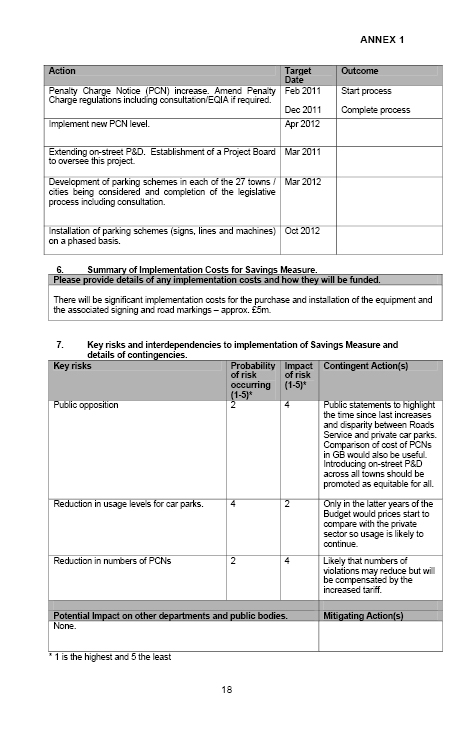
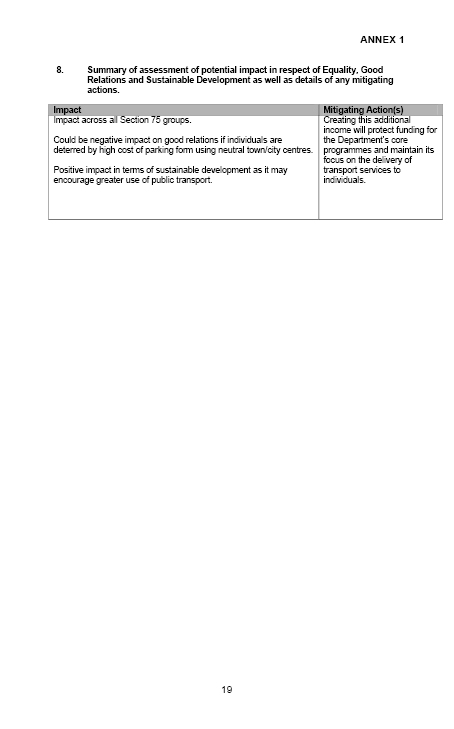
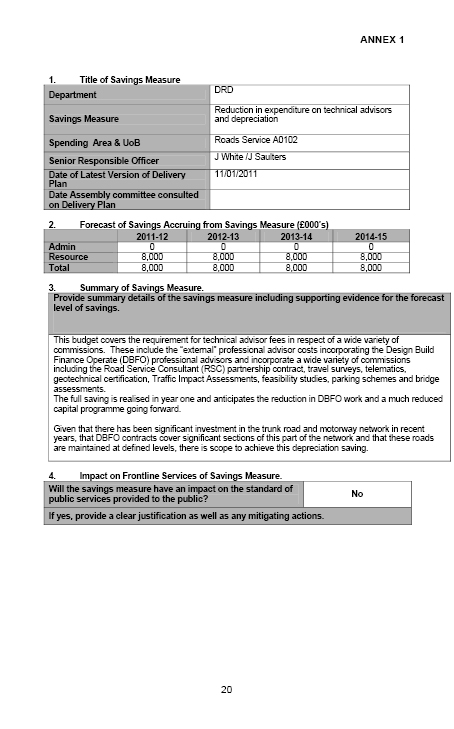
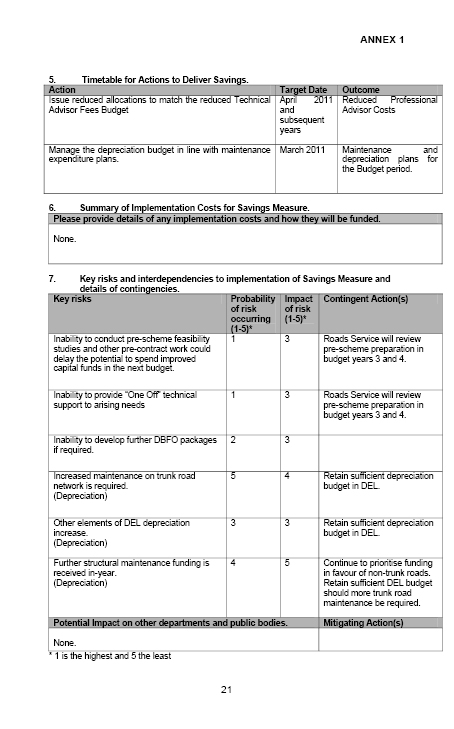

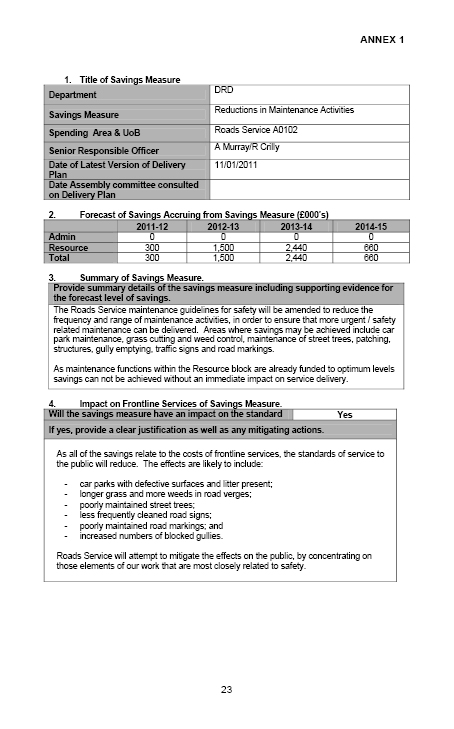
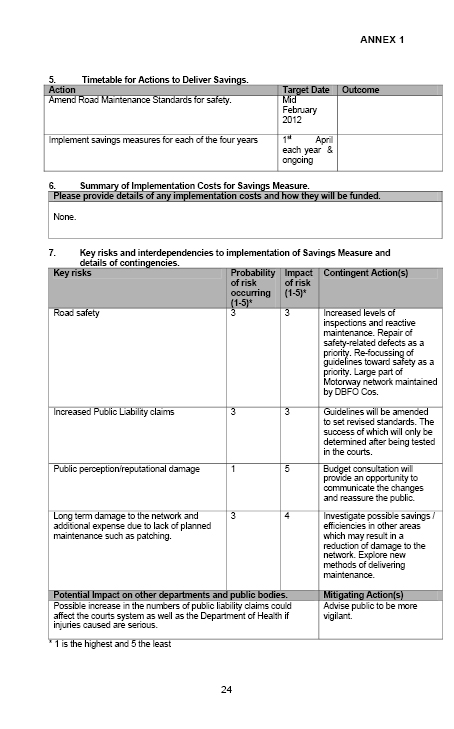
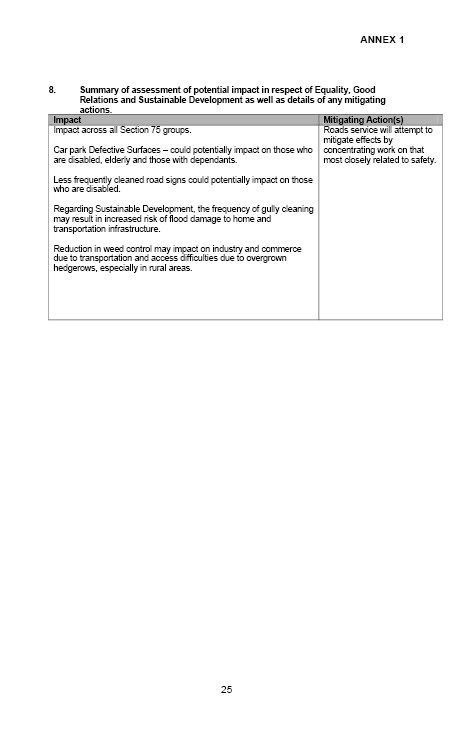


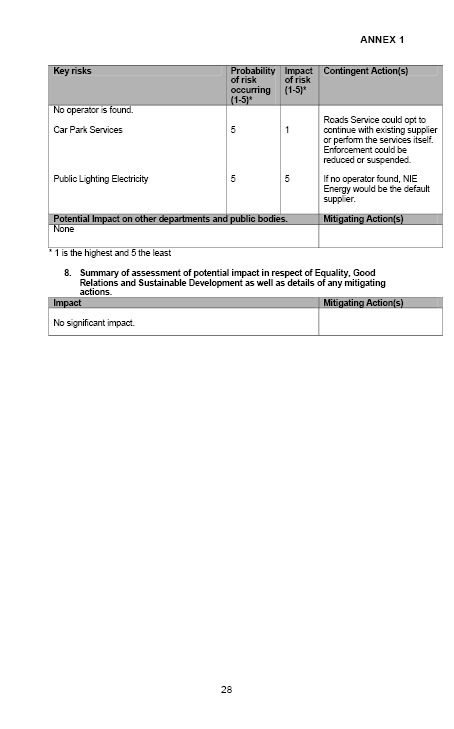
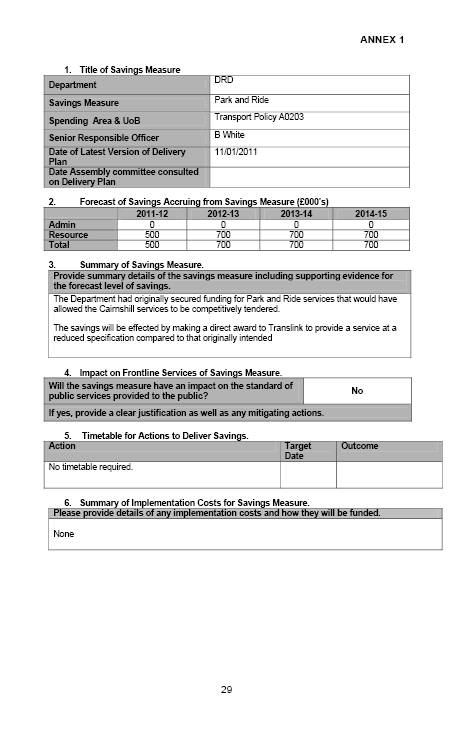
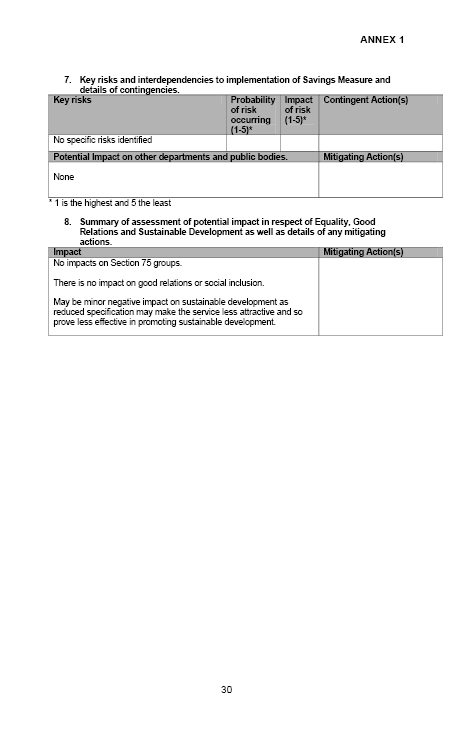

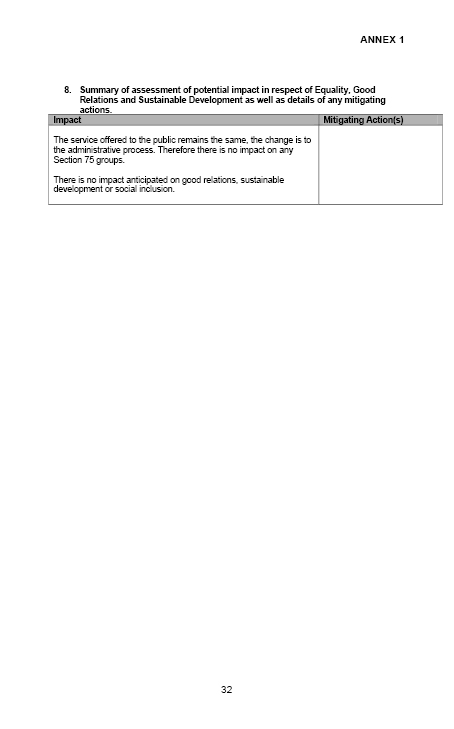



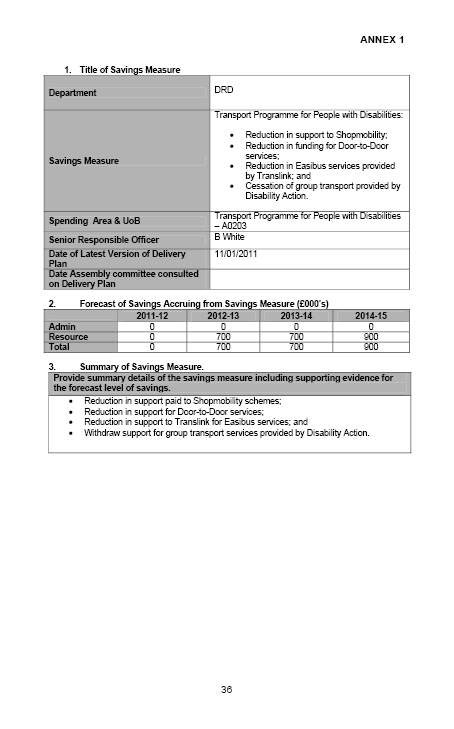
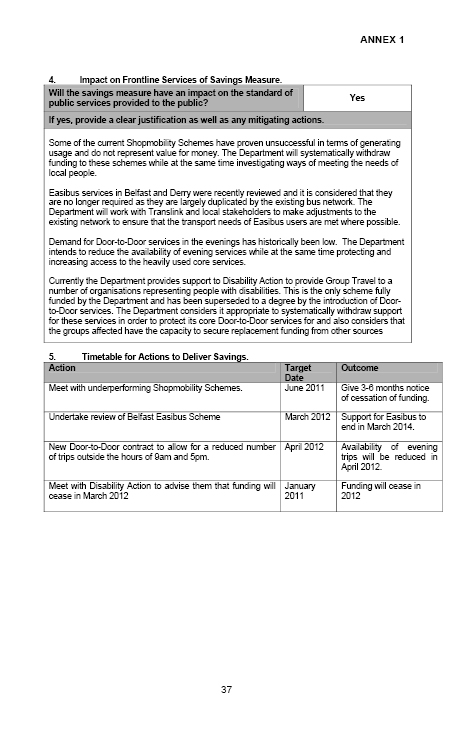
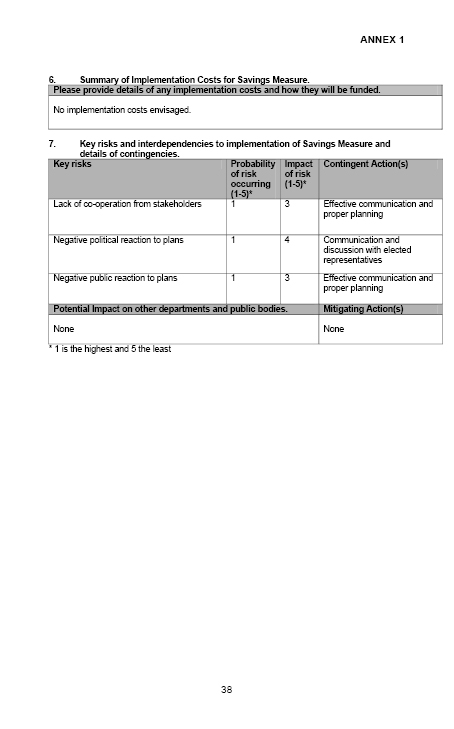

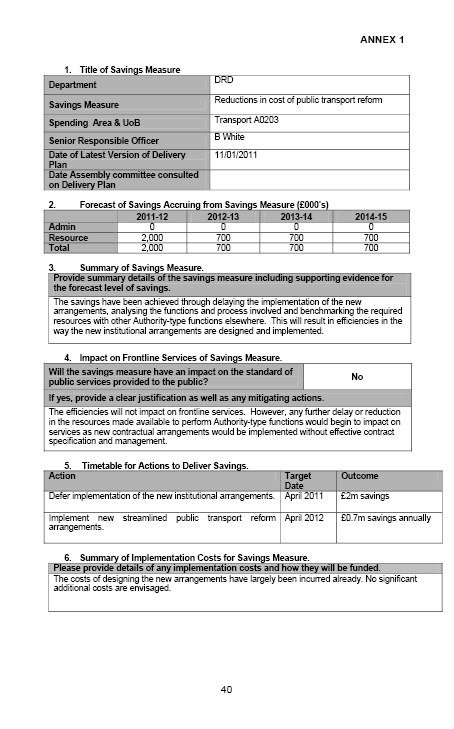
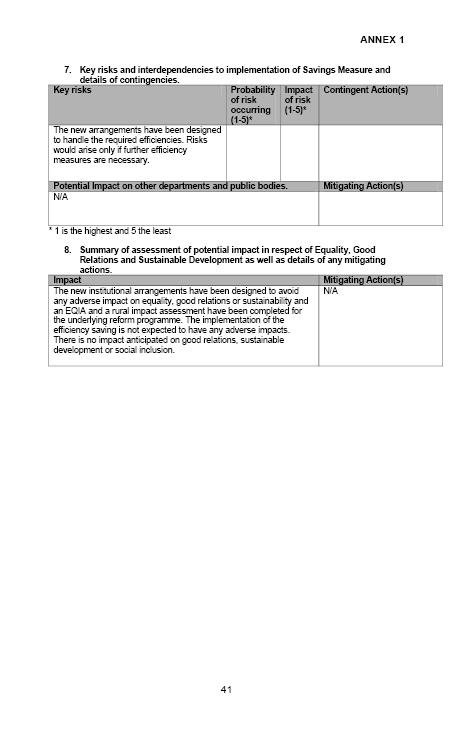
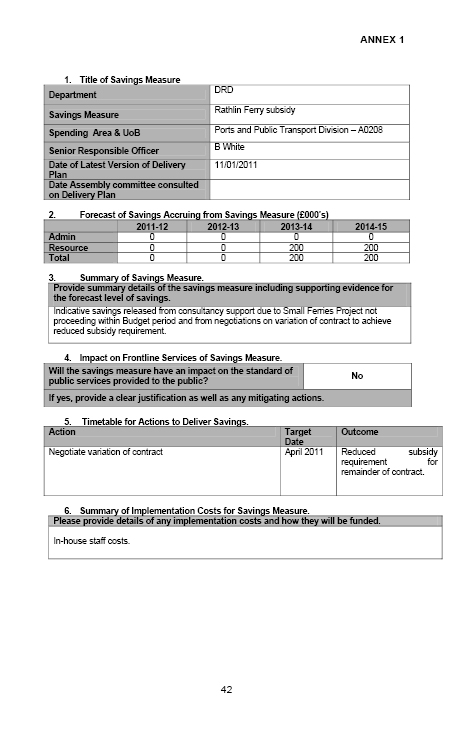

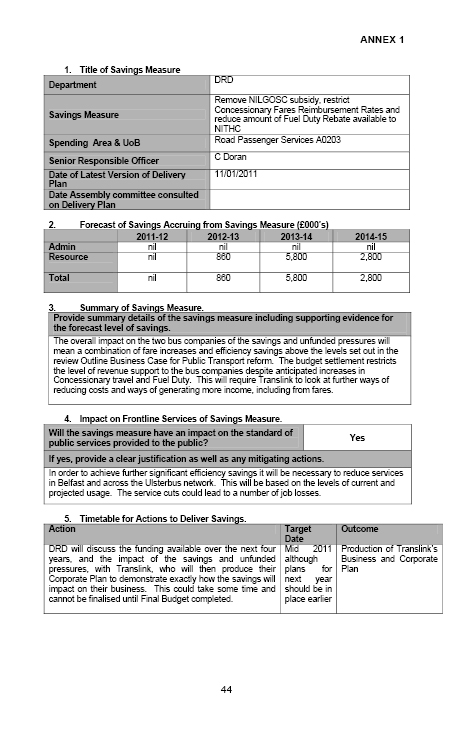
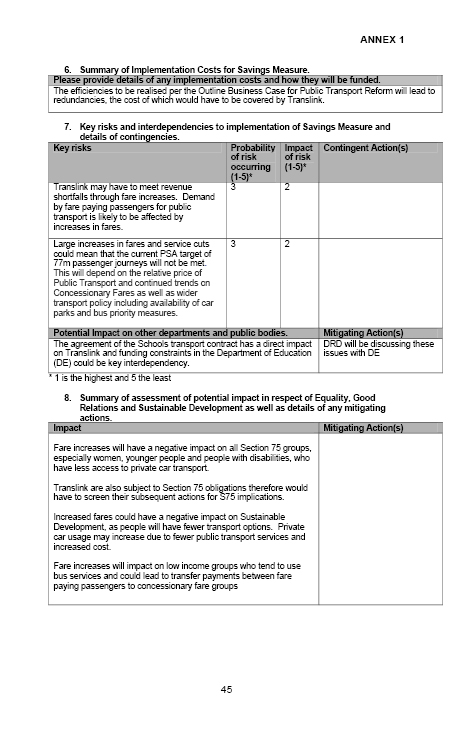

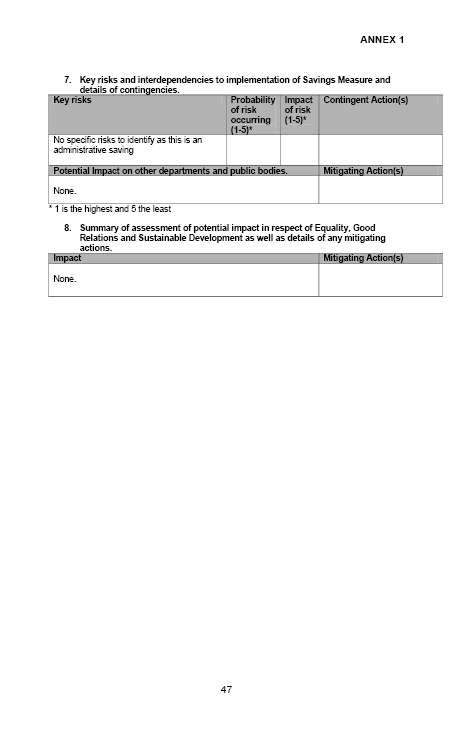
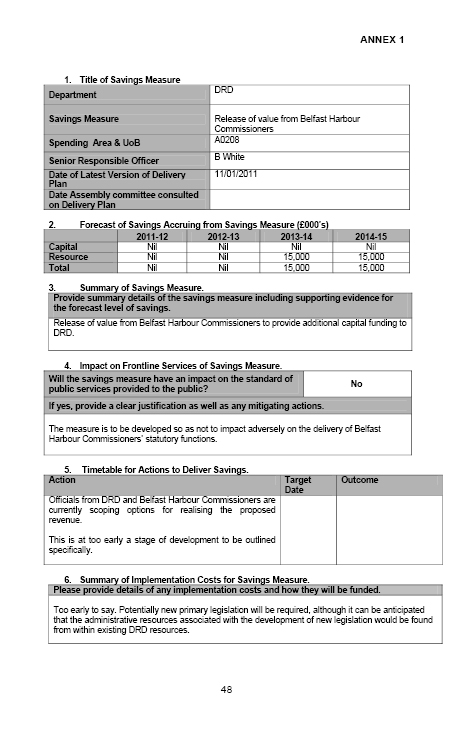


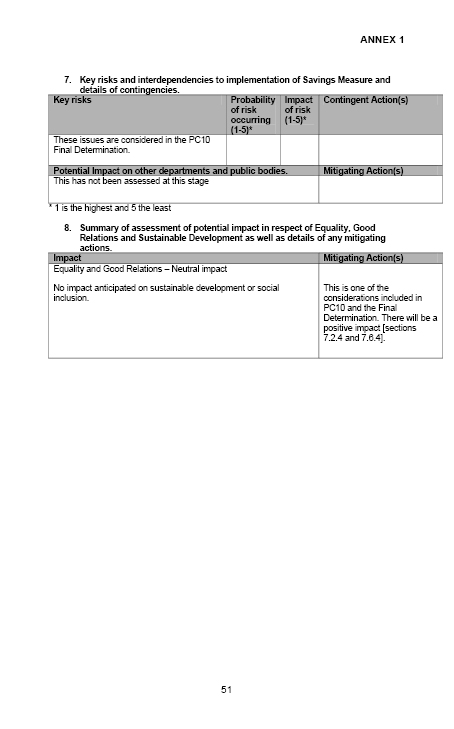
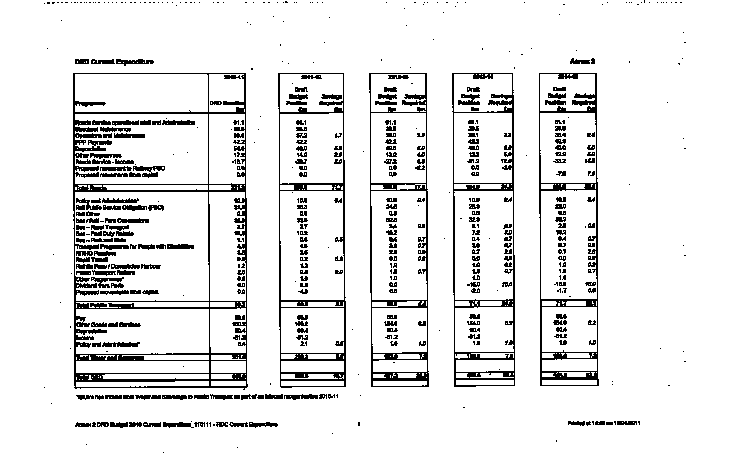




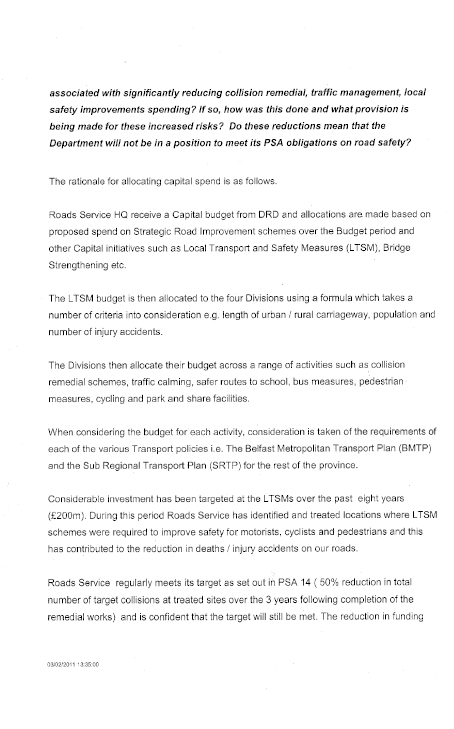


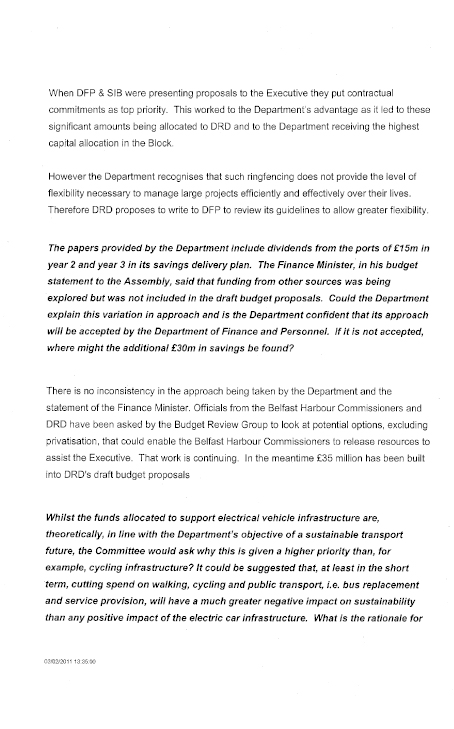

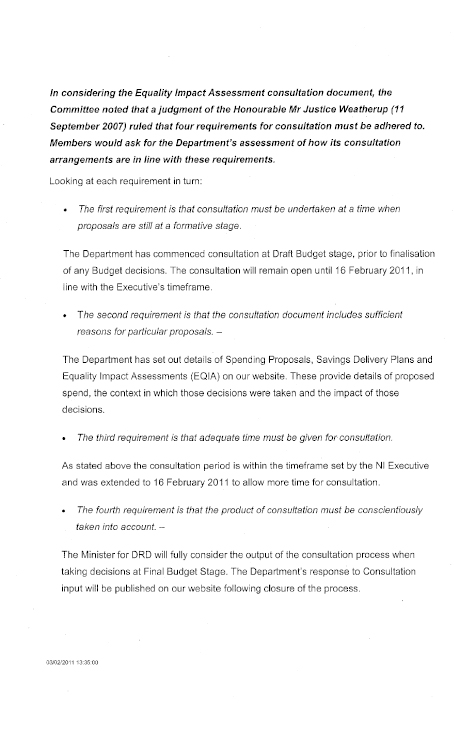

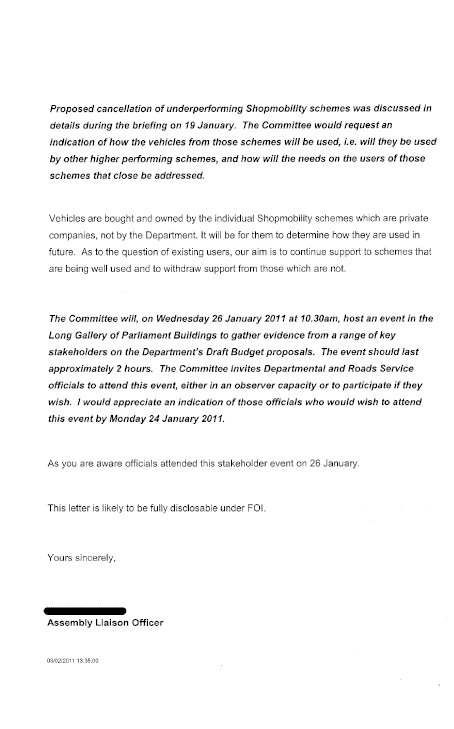
| 2010-11 | 2011-12 | 2012-13 | 2013-14 | 2014-15 | |||||
|---|---|---|---|---|---|---|---|---|---|
| £m | £m | % | £m | % | £m | % | £m | % | |
| DARD | -173.5 |
16.4 |
-109.5% |
13.9 |
-15.2% |
20 |
43.9% |
29.3 |
46.5% |
| DCAL | 59.9 |
11.8 |
-80.3% |
21.9 |
85.6% |
22.2 |
1.4% |
85.8 |
286.5% |
| DE | 169.3 |
127.4 |
-24.7% |
100.4 |
-21.2% |
101.5 |
1.1% |
139.4 |
37.3% |
| DEL | 37.6 |
41.2 |
9.6% |
32.3 |
-21.6% |
18.5 |
-42.7% |
28.3 |
53.0% |
| DETI | 73.5 |
71.7 |
-2.4% |
44.9 |
-37.4% |
16 |
-64.4% |
28.8 |
80.0% |
| DFP | 15.2 |
16.5 |
8.6% |
12.1 |
-26.7% |
10.6 |
-12.4% |
28.4 |
167.9% |
| DHSSPS | 201.7 |
214.8 |
6.5% |
278.8 |
29.8% |
184.9 |
-33.7% |
163.3 |
-11.7% |
| DOE | 182.4 |
6.1 |
-96.7% |
5.9 |
-3.3% |
4 |
-32.2% |
7.6 |
90.0% |
| DOJ | 80 |
78.3 |
-2.1% |
64.5 |
-17.6% |
51.8 |
-19.7% |
82 |
58.3% |
| DRD | 556.2 |
438.3 |
-21.2% |
425.3 |
-3.0% |
540.9 |
27.2% |
558.8 |
3.3% |
| DSD | 269.6 |
150.3 |
-44.3% |
120.6 |
-19.8% |
99 |
-17.9% |
190.3 |
92.2% |
| OFMDFM | 12 |
9.1 |
-24.2% |
3.8 |
-58.2% |
8.8 |
131.6% |
25.6 |
190.9% |
| Assembly Ombudsman | 0 |
0.1 |
0.0% |
0 |
-100.0% |
0 |
0.0% |
0 |
0.0% |
| FSA | 0.1 |
0 |
-100.0% |
0 |
0.0% |
0 |
0.0% |
0.1 |
0.0% |
| NIA | 3.6 |
1.2 |
-66.7% |
0 |
-100.0% |
0 |
0.0% |
5.7 |
0.0% |
| NIAO | 0.3 |
0.4 |
33.3% |
0.2 |
-50.0% |
0.4 |
100.0% |
0.2 |
-50.0% |
| NIAUR | 0 |
0 |
0.0% |
0 |
0.0% |
0 |
0.0% |
0 |
0.0% |
| PPS | 0.3 |
0.2 |
-33.3% |
0.2 |
0.0% |
0.2 |
0.0% |
0.2 |
0.0% |
1,488.20 |
1,183.80 |
-20.5% |
1,124.80 |
-5.0% |
1,078.80 |
-4.1% |
1,373.80 |
27.3% |
|
| 2010-11 | 2011-12 | 2012-13 | 2013-14 | 2014-15 | |||||
|---|---|---|---|---|---|---|---|---|---|
| £m | £m | % | £m | % | £m | % | £m | % | |
| AOCC | 1.6 |
1.6 |
-1.0% |
1.6 |
-1.0% |
1.6 |
-1.0% |
1.5 |
-1.0% |
| DARD | 224.9 |
224.9 |
0.0% |
236 |
4.9% |
222.6 |
-5.7% |
219 |
-1.6% |
| DCAL | 113.3 |
112.5 |
-0.7% |
113.2 |
0.6% |
110 |
-2.9% |
103 |
-6.3% |
| DE | 1,914.80 |
1,852.20 |
-3.3% |
1,857.30 |
0.3% |
1,861.60 |
0.2% |
1,847.70 |
-0.7% |
| DEL | 798.9 |
775.4 |
-2.9% |
767.4 |
-1.0% |
785.6 |
2.4% |
813.8 |
3.6% |
| DETI | 199.5 |
204.9 |
2.7% |
211.6 |
3.2% |
203.5 |
-3.8% |
205.5 |
1.0% |
| DFP | 182.9 |
190.5 |
4.2% |
187.1 |
-1.8% |
179.9 |
-3.9% |
180.9 |
0.5% |
| DHSSPS | 4,302.90 |
4,348.10 |
1.0% |
4,427.70 |
1.8% |
4,543.20 |
2.6% |
4,629.20 |
1.9% |
| DOE | 129.6 |
121.8 |
-6.0% |
123.6 |
1.4% |
121 |
-2.1% |
121.5 |
0.4% |
| DOJ | 1,223.70 |
1,213.10 |
-0.9% |
1,189.00 |
-2.0% |
1,166.70 |
-1.9% |
1,176.40 |
0.8% |
| DRD | 517.3 |
500.3 |
-3.3% |
487.2 |
-2.6% |
459.6 |
-5.7% |
454 |
-3.3% |
| DSD | 521.1 |
516.7 |
-0.8% |
532 |
3.0% |
543 |
2.1% |
523.4 |
-3.6% |
| FSA | 9.6 |
9.4 |
-1.3% |
9.3 |
-1.0% |
9.2 |
-1.0% |
9.2 |
-1.0% |
| NIA | 48.4 |
46 |
-5.0% |
43.7 |
-5.0% |
41.5 |
-5.0% |
39.4 |
-5.0% |
| NIAO | 9.5 |
9 |
-5.0% |
8.6 |
-5.0% |
8.2 |
-5.0% |
7.8 |
-5.0% |
| NIAUR | 0.5 |
0.5 |
-1.0% |
0.5 |
-1.0% |
0.5 |
-1.0% |
0.5 |
-1.0% |
| OFMDFM | 80.2 |
79 |
-1.4% |
80.2 |
1.6% |
77 |
-4.1% |
73.7 |
-4.3% |
| PPS | 37.4 |
37 |
-1.0% |
36 |
-2.6% |
35.2 |
-2.3% |
33.9 |
-3.6% |
10,316.10 |
10,242.90 |
-0.7% |
10,311.90 |
0.7% |
10,369.60 |
0.6% |
10,440.40 |
0.7% |
|
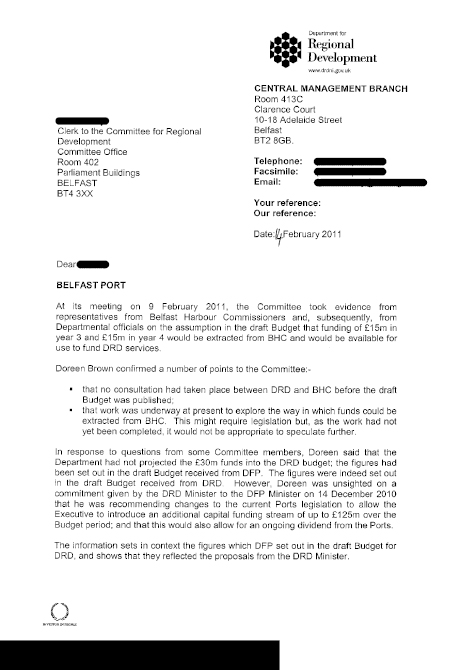


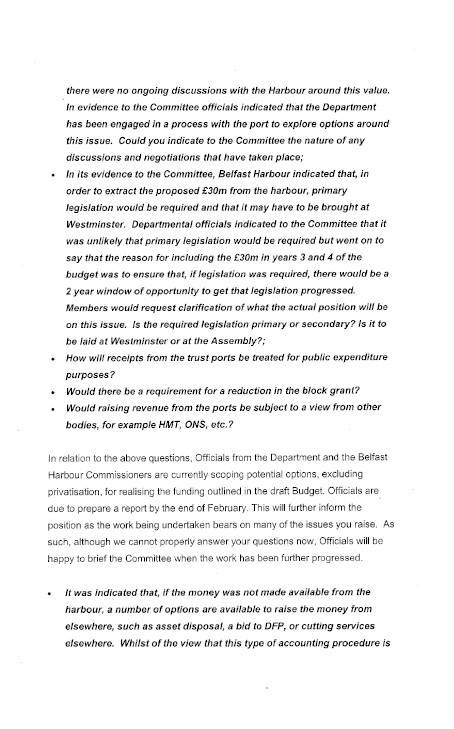

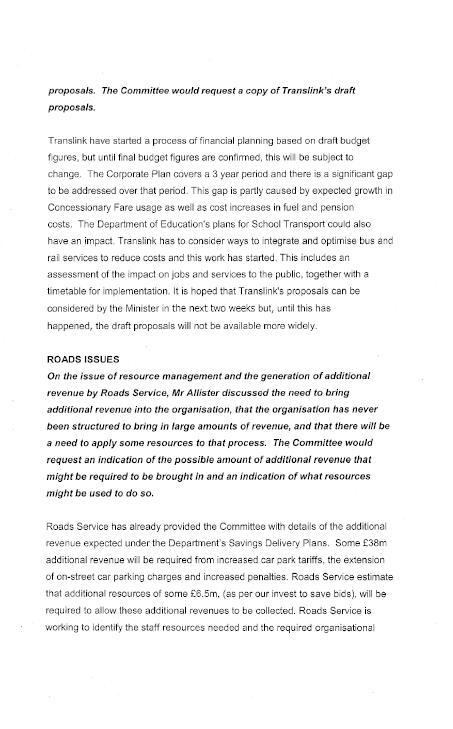
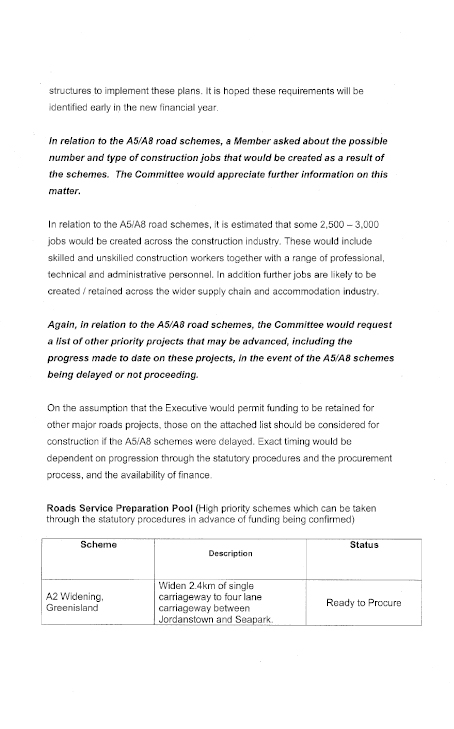
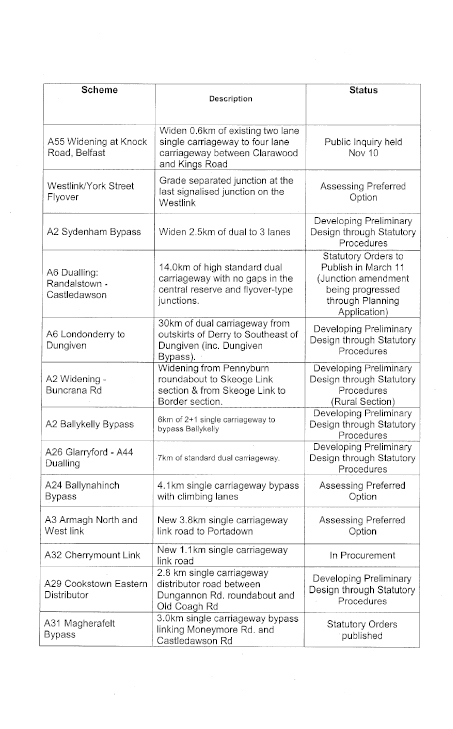
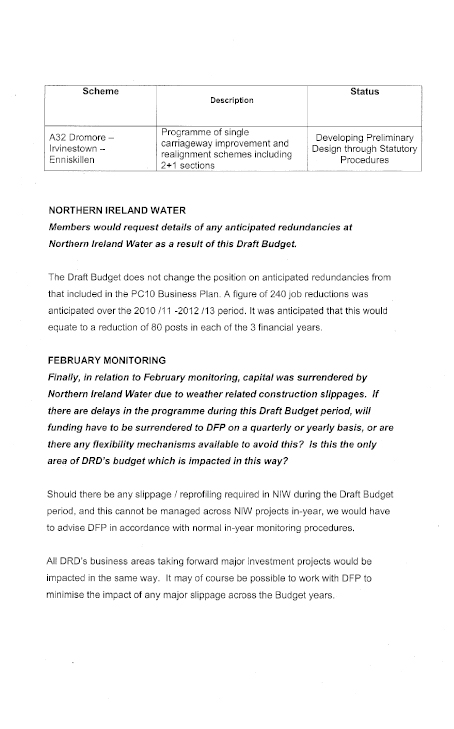


Paper 000/00 1st October 2010 NIAR 487-10
As the British Government prepares for the forthcoming Comprehensive Spending Review (CSR) the devolved administrations are preparing themselves for significant cuts from their respective block grants. Research commissioned by the Northern Ireland Council for Voluntary Action (NICVA)[1], outlines the likely impact of public spending cuts for Northern Ireland, suggesting the overreliance on the public sector for direct and indirect employment as well as a £300 million shortfall in funds caused largely by the continued subsidy of NI Water, place the region in a particularly vulnerable position.
Following this report NICVA contacted each government department and requested they meet with voluntary and community organisations in their area of interest to outline the current situation and discuss issues of concern. On Thursday 2nd September DRD officials held a meeting attended by over 50 representatives from the voluntary sector as well as John McCallister, MLA. The committee for Regional Development requested Research and Library to attend this event on their behalf and this report is provided in response to that request.
Nigel McCormick, Director of Finance and Doreen Brown, Deputy Secretary, represented the Department. Nigel McCormick commenced proceedings with a presentation outlining the commitments the Department had in maintaining its infrastructure assets within its predominantly capital based budget. He identified depreciation as a significant budgetary strain in order to highlight the unique predicament DRD has when faced with making cuts, highlighting years of underinvestment stating: “there is not a lot you can do in terms of saving; roads need fixed!" [Emphasis added]. The extent of the underinvestment was made clear when he described a 700 mile backlog of roads requiring repair.
Mr. McCormick outlined the financial breakdown for each of the areas DRD is responsible for with approximately £300 million spent on roads, £200 million on water and £60 million on public transport. He acknowledged that a capital based Department like DRD will face huge challenges particularly if the proposed 20% cut to the capital budget is realised and suggested that while there was a lot of uncertainty investment in infrastructure would be vital for economic recovery, suggesting cuts while inevitable, should not inhibit the regions potential for development. He identified the strategic priorities going forward as:
A member of the audience commented on the disproportionate spending on public transport compared to roads which he said was currently around 80/20. Doreen Brown responded to this suggesting that this was a result of the investment strategy. She elaborated further suggesting that while spending on roads will come from the capital budget public transport is reliant on resource funding.
The audience member suggested that a target of 50/50 should be sought if the Department is serious about sustainable transport. Ms. Brown responded saying this would not happen but the Department will do everything it can to protect baseline funding for sustainable transport. She explained that roads are also necessary, not only for sustainable transport, they are also required for the movement of freight and are also used by buses it was further commented that good roads lead to reduced emissions.
An interesting question about crosscutting measures was then posed. An audience member asked why cuts can’t be offset when spending leads to saving in other areas. The example given was cycling and if cycling leads to reduced obesity levels and health benefits saving the DHSSPS money, shouldn’t more be spent on cycling infrastructure, even from the health budget. Unfortunately the question was unanswered apart from a passing reference to attempts being made to work smarter.
Questioning then moved to how the Department decides where cuts should be made. An audience member suggested that Belfast City Council had reduced their cycling budget from £400,000 to £10,000 and also cut their spending on traffic calming measures, his question was ‘…how is a balance found between economic and social considerations?
The Departments response was that they were unaware of the figures quoted. The audience member responded that these had come directly from the cycling officer at the Belfast roads division. In terms of prioritising projects they suggested this is the decision of the minister and his advisors and only he would be able to answer it. Ms. Brown suggested that there will be consultation on cuts but these have yet to be decided on she suggested that if cuts happen the voluntary sector needs to lobby but again emphasised no decisions had been made.
John McCallister, MLA commented on the need for the Department to protect frontline services, which lead to the question of what constitutes front line services. This brought little response from the Department but members of the audience emphasised that people with disabilities, the elderly and those in rural areas should not be ignored and funding for concessionary fares, smartpass and community transport should continue.
[1] from Oxford Economics and ERINI (Economic Research Institute of Northern Ireland) see: http://tiny.cc/lh0n7
Paper 000/00 1st October 2010
Paper 000/00 6 January 2011 NIAR 674-10
This paper presents a critical evaluation of the Northern Ireland Executive’s draft Budget 2011-15. Some procedural questions are highlighted and a number of issues for further clarification are presented.
Paper 000/00 17th January 2011
The Minister of Finance introduced the Northern Ireland Executive’s draft Budget for 2011/12 to 2014/15 to the Assembly on 15 December 2010.
The purpose of this note is to draw out some of the key messages and to highlight some issues which require further clarification.
The closing date for the consultation is 9 February 2011. This is an eight-and-a-half week period for members of the public, interested bodies and the Assembly’s statutory committees to consider and respond to the draft budget.
Good practice suggests that 12 weeks should be the standard period for formal consultation, with a minimum period of eight weeks.[1] Whilst the consultation on the draft Budget satisfies that eight-week minimum, it should be noted that this period is over the Christmas and New Year holidays. Consequently, it is likely that Assembly committees will have only two meetings at which to consider draft Budget 2010.
Good practice on legislative budgeting suggests that:
Parliament should be allowed 2–4 months to scrutinize, debate, and propose alternative budgetary policies (within limits of cost), prior to adopting and promulgating the annual budget before the new fiscal year begins.[2]
The Executive’s timeline does just about meet the lower end of the time scale suggested by the Office of First and Deputy First Minister’s guidance but it falls short of that suggested by International Monetary Fund (IMF) guidance. It should also be noted that the draft Budget 2011-15 document does not contain detailed spending proposals below the level of departmental allocation. The document states that:
Ministers have been asked to publish a more detailed breakdown of proposed expenditure on their departmental websites. This should be accompanied by details of their savings delivery plans which will provide more information on the savings measures required to enable the department to live within their budget allocation. The savings delivery plans will include details of any implications for frontline services. [3]
It goes on to state that each department’s consultation will run concurrently with the consultation on the overall budget. At the time of writing (6 January 2011) only four of the Executive’s departments have published a consultation document on their websites. Therefore, both the public and the Assembly are being consulted on only part of the information, albeit with a promise that more will be forthcoming. The more time that elapses before this detailed information is published the less likely it is that the consultation will comply with good practice guidelines.
In the Executive’s Review of Spending Plans 2010/11 a similar process was used for consultation whereby departments were to publish information on their websites. The following extract from a previous Assembly Research paper is relevant here because it appears there is a danger of similar criticisms being made again.
The approach to consultation on that occasion was criticised by The Methodist Church in Ireland’s Council on Social Responsibility which in correspondence with the Committee for Finance and Personnel raised general dissatisfaction with the process:[4]
…the consultation was at best flawed and at worst opaque. The process falls far short of good practice for consultations. It is not clear how a response could be made or what the deadline is for such responses […] DFP has asked each department to publish more detailed information on its website. However, sometimes this information is not easy to locate on the websites (e.g. DHSSPS website), or when it can be located, does not contain information about what the focus of the consultation actually is or how a response can be effected (e.g. DCAL website).
The submission went on to cite a judgement by Weatherup J, handed down on 11 September 2007: “it is common ground that, whether or not consultation of interested parties and the public is a legal requirement, if it is embarked upon it must be carried out properly," (emphasis added)
In his judgement, Weatherup J cited another judgement[5] in which the four requirements of consultation were stated:
To be proper, consultation must be undertaken at a time when proposals are still at a formative stage; it must include sufficient reasons for particular proposals to allow those consulted to give intelligent consideration and an intelligent response; adequate time must be given for this purpose; and the product of consultation must be conscientiously taken into account when the ultimate decision is taken.
The Methodist Church in Ireland’s Council on Social Responsibility wrote that “viewed against these requirements the current consultation falls far short […] Northern Ireland deserves better of the Executive with respect to consultation."
DFP officials were asked about the effectiveness of the consultation process on the Review of Spending Plans on 21 April 2010 in an evidence session with the Committee for Finance and Personnel. In response, an official commented:
In the responses to the draft proposals, concerns were expressed by the health and social care sector about perceived cuts. However, there were no suggestions as to, for example, if we were to take resources and allocate them to area B, which other areas should have their budgets reduced to meet the pressure. That was not explored. The other issue was pro rata cuts across Departments, as opposed to the targeted approach which the Executive decided to pursue and implement. There was no great deal of analysis or response on that.[6]
It may well be that consultees did not feel able to subject the proposals to detailed analysis simply because the information provided was in many cases insufficient for them to do so. Indeed, despite the descriptions of the documents that are available on departmental website as ‘consultations’ it was not clear exactly what the public was being consulted on - as noted above. It is difficult to frame a response when the question is not clearly defined."
It should be noted that at least some of the criticisms previously levelled at the approach to consultation are less valid in relation to the draft Budget. The DCAL and DFP documents do contain a closing date for comments, for example.
There is a requirement in section 64(1) of the Northern Ireland Act 1998[7] that a draft Budget must be laid before the Assembly prior to the commencement of the following financial year:
The Minister of Finance and Personnel shall, before the beginning of each financial year, lay before the Assembly a draft budget, that is to say, a programme of expenditure proposals for that year which has been agreed by the Executive Committee in accordance with paragraph 20 of Strand One of the Belfast Agreement.
Paragraph 20 of Strand One of the Belfast Agreement states:
The Executive Committee will seek to agree each year, and review as necessary, a programme incorporating an agreed budget linked to policies and programmes, subject to approval by the Assembly, after scrutiny in Assembly Committees, on a cross-community basis.[8]
It appears therefore (and this should not be construed as definitive legal advice) that the draft Budget document that was presented to the Assembly on 15 December does not discharge the Minister’s duty under section 64(1) but that rather a further document that has been agreed following consultation is required. The effect of this may be to constrain any additional time available to the Executive if the Minister is to comply with his statutory obligation.
It is not immediately clear however why the Executive has chosen 9 February 2011 as the closing date for the consultation and why more time could not be given to the Assembly and other stakeholders. Considering that the draft Budget covers a four-year period, it is presumably even more important that the Assembly and other stakeholders are able to scrutinise the proposals fully than if it were a one-year plan.
An additional time constraint, however, is the coming Assembly election. The last sitting prior to the election is scheduled for 22 March 2011, so for the Minister to discharge his duty under section 64(1) a finalised Budget must be laid before the Assembly before that date.
It may be possible that there is another legislative mechanism through which more time could be sought.
For example, the Vote on Account mechanism allows the Assembly to approve a proportion of the current year’s allocation to be used by departments for the following year. The Introduction to the Vote on Account 2010-11 explains:
The Vote on Account is normally calculated as a proportion (45 per cent) of the preceding year’s total voted provision. Generally this should be sufficient to ensure that the provision made for each service is not exhausted before the Main Estimates can be approved in the summer, but not so high as to prejudge the Northern Ireland Assembly’s consideration of the Main Estimates.[9]
The Vote on Account is usually taken at the same time as the Spring Supplementary Estimates are considered in February. It might be possible to increase the provision in the Vote on Account to a greater proportion than 45% to allow a longer consultation period. This is because the Budget itself does not confer authority on departments to spend money – that requires an Appropriation Act which accompanies the Main Estimates, usually around June.
Such an approach would not appear to solve the requirement on the Minister under section 64(1). The Committee may wish to seek legal advice on this matter.
The Executive has presented a four-year budget. There are some advantages in such an approach, not least that it provides certainty for departments and other stakeholders over the medium term. On the other hand, it could be argued that the approach also limits the flexibility of the incoming Executive (following the Assembly election in May) to address changing circumstances.
In its second report on the Inquiry into the Role of the Northern Ireland Assembly in Scrutinising the Executive’s Budget and Expenditure, the Committee for Finance and Personnel recommended that:
Whilst it considers that the setting of a clear timetable to include key milestones at the start of each budget process is of vital importance, the Committee believes that clarity is required on the shape, frequency and duration of future budget cycles. In noting that the Budget 2010 process will develop departmental spending plans for the four-year period from 2011-12 to 2014-15, the Committee recommends that a regularised annual budgetary review process is established within this framework, with a pre-determined timetable, to enable the Executive and Assembly to make interim reappraisals of departmental allocations against progress in delivering PfG priorities and savings.[10]
The Budget document does not refer to any mechanism for an annual formalised review.
The allocations in the draft Budget for each Executive department’s current expenditure are shown below in Table 1.
It should be noted that, unlike the Executive’s allocation in the UK Government’s recent Spending Review 2010, the figures are presented in cash terms. This means that the assumed impact of inflation for future years is ignored.

Source: Draft Budget 2011-15
In Table 2 below, the draft allocations are shown in real terms through the application of HM Treasury deflators.[11] It shows that the total planned real-term decreases for departments’ current expenditure from the 2010/11 base year to 2014/15 range from 2.6% (DHSSPS) to 20.6% (DRD).
It should be noted that there are difficulties associated with considering these allocations in real terms:
| £m | 10/11 | 11/12 real | 12/13 real | 13/14 real | 14/15 real | total real change 10/11 to 14/15 £m | total real 10/11 to 14/15 % change |
|---|---|---|---|---|---|---|---|
| DARD | 224.9 |
219.4 |
225.3 |
206.9 |
198.2 |
-26.7 |
-11.9 |
| DCAL | 113.3 |
109.8 |
108.1 |
102.2 |
93.2 |
-20.1 |
-17.7 |
| DED | 1914.8 |
1807.0 |
1773.0 |
1730.4 |
1672.3 |
-242.5 |
-12.7 |
| DEL | 798.9 |
756.5 |
732.6 |
730.2 |
736.5 |
-62.4 |
-7.8 |
| DETI | 199.5 |
199.9 |
202.0 |
189.2 |
186.0 |
-13.5 |
-6.8 |
| DFP | 182.9 |
185.9 |
178.6 |
167.2 |
163.7 |
-19.2 |
-10.5 |
| DHSSPS | 4302.9 |
4242.0 |
4226.7 |
4223.0 |
4189.8 |
-113.1 |
-2.6 |
| DOE | 129.6 |
118.8 |
118.0 |
112.5 |
110.0 |
-19.6 |
-15.1 |
| DOJ | 1223.7 |
1183.5 |
1135.0 |
1084.5 |
1064.7 |
-159.0 |
-13.0 |
| DRD | 517.3 |
488.1 |
465.1 |
427.2 |
410.9 |
-106.4 |
-20.6 |
| DSD | 521.1 |
504.1 |
507.9 |
504.7 |
473.7 |
-47.4 |
-9.1 |
| OFMDFM | 80.2 |
77.1 |
76.6 |
71.6 |
66.7 |
-13.5 |
-16.8 |
Source: Assembly Research calculations based on Draft Budget 2011-15
The allocations in the draft Budget for each Executive department’s current expenditure are shown below in Table 3.
It should be noted that, unlike the Executive’s allocation in the UK Government’s recent Spending Review 2010, the figures are presented in cash terms. This means that the assumed impact of inflation for future years is ignored.
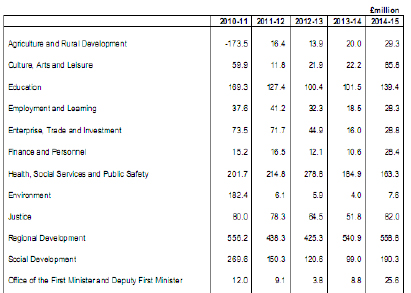
Source: Draft Budget 2011-15
In Table 4 below, the draft allocations are shown in real terms through the application of HM Treasury deflators.[12] It shows that the total planned real-term decreases for departments’ capital expenditure from the 2010/11 base year to 2014/15 range from +93.1% (OFMDFM) to -96.2% (DOE).
As above, it should be noted that there are difficulties associated with considering these allocations in real terms:
| £m | 10/11 | 11/12 real | 12/13 real | 13/14 real | 14/15 real | total real change 10/11 to 14/15 £m | total real 10/11 to 14/15 % change# |
| DARD | -173.5 | 16.0 | 13.3 | 18.6 | 26.5 | 200.0 | * |
| DCAL | 59.9 | 11.5 | 20.9 | 20.6 | 77.7 | 17.8 | 29.6 |
| DED | 169.3 | 124.3 | 95.8 | 94.3 | 126.2 | -43.1 | -25.5 |
| DEL | 37.6 | 40.2 | 30.8 | 17.2 | 25.6 | -12.0 | -31.9 |
| DETI | 73.5 | 70.0 | 42.9 | 14.9 | 26.1 | -47.4 | -64.5 |
| DFP | 15.2 | 16.1 | 11.6 | 9.9 | 25.7 | 10.5 | 69.1 |
| DHSSPS | 201.7 | 209.6 | 266.1 | 171.9 | 147.8 | -53.9 | -26.7 |
| DOE | 182.4 | 6.0 | 5.6 | 3.7 | 6.9 | -175.5 | -96.2 |
| DOJ | 80 | 76.4 | 61.6 | 48.1 | 74.2 | -5.8 | -7.2 |
| DRD | 556.2 | 427.6 | 406.0 | 502.8 | 505.8 | -50.4 | -9.1 |
| DSD | 269.6 | 146.6 | 115.1 | 92.0 | 172.2 | -97.4 | -36.1 |
| OFMDFM | 12 | 8.9 | 3.6 | 8.2 | 23.2 | 11.2 | 93.1 |
Source: Assembly Research calculations based on Draft Budget 2011-15
Notes:
* Calculation of a percentage change figure is meaningless where the base year (2010/11) is equal to or less than zero.
# Percentage changes in allocations are presented over the four-year period for illustrative purposes. These should be interpreted with caution: the percentage change over four years can mask year-on-year fluctuations. For example, the OFMDFM allocation drops considerably for 2011/12 and 2012/13 before increasing by large amounts for 2013/14 and 2014/15.
In his statement to the Assembly the Minister announced that the Executive has “commissioned the Environment Minister to take forward the introduction of a plastic bags levy in Northern Ireland."[13] The draft Budget 2011-15 does not provide details of the revenue-raising potential of this measure, although the Minister did refer to a figure of £4m per annum in his statement.
No timescale for the introduction of the levy was outlined.
The draft Budget 2011-15 refers to “other possible revenue sources that Ministers have been tasked to evaluate over the coming weeks" and then suggests that if these options are viable they will be “factored into the final budget allocations."[14] Unfortunately the document itself does not provide any further detail on what these options might be.
In his statement, the Minister did refer to “reserves held by other bodies such as housing associations, which hold reserves of over £250 million, and the Harbour Commissioners, who hold reserves of nearly £60 million."[15] He also later noted that to realise revenue from the reserves of these bodies would require legislation and that “we have not yet built into the Budget the additional money that might be available."[16]
Again, no timescale was outlined for the introduction of such measures.
This raises a further issue about the consultation process. The public and the Assembly’s committees are being asked to provide views on prospective taxation measures about which they do not have any detailed information.
The UK Government’s Spending Review 2010 increased the cost of the Northern Ireland Executive’s borrowing. Previously, the Executive was able to borrow from the Public Works Loans Board (PWLB) at 0.5% above the rate of UK Government Gilts (i.e. the rate at which HM Treasury borrows). The Spending Review however announced that the premium on PWLB loans was to increase to 1%.[17] This means that the cost of borrowing has risen at a time when the Executive is planning to rely on it more. Actual drawdown of RRI borrowing in previous years is shown in the Table below:
| Year | Borrowing drawn down |
| 2003/04 | £79.4m |
| 2004/05 | £168.7m |
| 2005/06 | £162.9m |
| 2006/07 | £214.6m |
| 2007/08 | £97.6m |
| 2008/09 | £16.6m (plus £243.4 m of borrowing power used to offset on balance sheet PFI projects) |
| 2009/10 | £185.3m (plus £60.7 m of borrowing power used to offset on balance sheet PFI projects) |
RRI interest repayments are to rise from £44.9m in 2011/12 to £63.4m in 2014/15 in cash terms[19] – an increase over the budget period of 41.2%. It is assumed that these interest payments are only related to the borrowing associated with capital investment and do not include any repayments that may be due for borrowing related to the collapse of the PMS as the details for the proposed scheme are as yet not finalised.
In a letter to the Committee for Finance and Personnel on 10 December 2010, the Department for Finance and Personnel (DFP) confirmed that the PMS administrator will make both the principal and the interest repayments on the loan. It is therefore anticipated that there would be no net cost to the Northern Ireland block – although this presumably assumes that the administrator is indeed able to make the repayments on time and in full.
The draft Budget document states:
…civil servants obtaining pre-existing contractual entitlements to scale progression with those employees earning less than £21,000 also receiving a further annual award of £250.[20]
This seems to imply that only pay scales will be frozen above the £21K level and that civil servants will continue to receive incremental pay progression on those existing scales. It is not, however, absolutely clear that this is indeed what the Executive has proposed: the document does not state whether all civil servants have pre-existing contractual entitlements or just some.
In his statement the Minister said:
…the health budget will, I think, increase by 7% over that period. That compares favourably with the situation in Wales, where there was a 2·5% real reduction, and in Scotland, where there was a 3·03% real reduction.[22]
However, a number of points should be noted in regard to this assertion:
The draft Budget document provides scant detail on what either of the new Funds is designed to achieve or how they will do so. It is therefore difficult for members of the public or other interested parties to judge whether the proposals are sound or not.
The following extract from the Treasury’s guidance explains the concept of an administration budget concisely:
Administration Budgets cover the costs of all central government administration other than the costs of direct frontline service provision or support activities that are directly associated with frontline service delivery. In practice Administration Budgets include activities such as provision of policy advice, business support services, back-office administration of benefits, advice on and administration of grant programmes, technical or scientific support, and the work of the Government’s Regional Offices.[27]
The draft Budget 2011-15 document argues that:
[Abolition of administrative cost controls] will give Ministers greater flexibility to effectively and efficiently manage the resources at their disposal, with a view to maximising the outcomes achieved with such resources.[28]
It could be considered, however, that a time of public expenditure restraint is not necessarily the most appropriate time for controls on expenditure on back office functions rather than service delivery to be removed. The Budget document does not provide any detail on how the Executive proposes to ensure that departments do not unnecessarily shift resources from the front line to the back line (or indeed, the other way around).
The stated aim of the Executive in relation to switching from current to capital is to protect construction jobs.[29] In evidence to the Committee for Finance and Personnel on 1 December 2010, Victor Hewitt, Director of the Economic Research Institute of Northern Ireland, made the following observation:
Be cautious on transfer — there are no free lunches in economics. You may transfer money from current to capital to preserve construction jobs, for example. However, you should not fool yourselves that removing current expenditure to help the construction industry will not have job implications: you may kill off jobs that were either directly or indirectly supported by that money.
Some construction is specialised. If you put money into road building, you may have to import labour from across the water because we do not have those skills here. It is a very delicate balance and it must be looked at in the round. An economist should never look at things in isolation; there are always implications.[30]
Colm McCarthy, University College, Dublin, also made the point in evidence on 24 November 2010 that it is possible to ‘overdo’ capital infrastructure investment:
It is fine to build a motorway from Dublin to Cork, but it need only be done once. There is no need to over-design and over-build roads, which we did a little bit. Some parts of the motorway network in the South were over-specified. That happened here in the 1960s, the MI to Dungannon being a case in point.[31]
On the other hand, Professor David Heald, University of Aberdeen, made the following comments on 3 November 2010:
It is very important to protect capital expenditure as much as possible. Obviously, one does not want bad capital projects — the quality of capital projects is important — but Northern Ireland is heavily dependent on the public sector and the construction sector. My understanding is that the construction sector is quite localised, so the regional multipliers in Northern Ireland will be quite high from capital spending. Therefore, one ought to think about the question of whether room can be found to move money from resource into capital.[32]
Expert opinion, therefore, seems a little divided. The Budget document doesn’t contain any detail to justify the level of current to capital switch. It might be helpful to know why the Executive settled on the level of switching that it did for the draft allocations.
The Executive established a £26m invest-to-save fund as part of its Review of Spending Plans 2010/11. In the Budget document it is asserted that projects that received allocations from this fund were successful, but no evidence is produced to support that claim. It might provide reassurance to members of the public and other interested parties if an analysis or evaluation of the 2010/11 invest-to-save funding were available to inform consideration of allocations in the draft budget: these amount to £100m in cash terms over the four-year period.
There are two references in the Budget document to assets disposal. Table Two in Annex B contains a line ‘Additional Capital Receipts – Central Asset Management Unit’ which indicates capital receipts of £100m over the budget period. There is no further mention of the Central Asset Management Unit in the document, so it is difficult to know what these assets might be or to challenge whether the figures provided for receipts are realistic.
The second mention of assets disposal is in Table Four of Annex B which includes projections for capital receipts by departments over the budget period. There is no detail provided on what assets these forecasted receipts relate to.
The draft Budget 2011-15 includes proposed allocations for other public bodies in addition to Executive departments. It is perhaps worth noting that the use of the phrase ‘Non-Ministerial Departments’ in the draft Budget is something of a misnomer. The Assembly is constitutionally separate from the Executive, not a department of it. The Comptroller and Auditor General (and so therefore the NIAO) and the other bodies listed also have separate statutory roles and independence from the Executive.
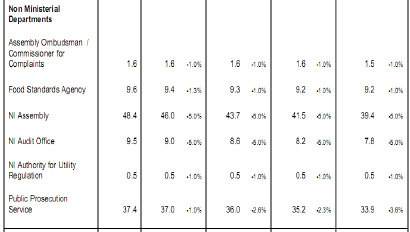
Source: Draft Budget 2011-15
In Table 7 below, the draft allocations are shown in real terms through the application of HM Treasury deflators.[33] It should be noted that there are difficulties associated with considering these allocations in real terms:
| £m | 10/11 | 11/12 real | 12/13 real | 13/14 real | 14/15 real | total real change 10/11 to 14/15 £m | total real 10/11 to 14/15 % change |
| Assembly Ombudsman/commissioner for complaints | 1.6 | 1.56 | 1.53 | 1.49 | 1.36 | -0.24 | -15.1 |
| Food standards agency | 9.6 | 9.17 | 8.88 | 8.55 | 8.33 | -1.27 | -13.3 |
| NI Assembly | 48.4 | 44.88 | 41.72 | 38.57 | 35.66 | -12.74 | -26.3 |
| NI Audit Office | 9.5 | 8.78 | 8.21 | 7.62 | 7.06 | -2.44 | -25.7 |
| NI Authority for Utility Regulation | 0.5 | 0.49 | 0.48 | 0.46 | 0.45 | -0.05 | -9.5 |
| Public Prosecution Service | 37.4 | 36.10 | 34.37 | 32.72 | 30.68 | -6.72 | -18.0 |
Source: Assembly Research calculations based on Draft Budget 2011-15
The Table shows that the total planned real-term decreases for Non-Ministerial departments’ current expenditure from the 2010/11 base year to 2014/15 range from 9.5% (NI Authority for Utility Regulation) to 26.3% (NI Assembly).
The largest reduction in real terms for current expenditure of the Ministerial departments is 20.6% (DRD) (see Table 2 above) – a smaller reduction than that indicated for the NI Assembly.
Yet on 8 November 2010 the Assembly resolved:
That this Assembly notes with concern the likely reduction in the block grant that will be brought about by the comprehensive spending review; and calls on the Assembly Commission to reduce its running costs in line with the level of reduction faced by Executive Departments.[34]
On an initial reading it appears that the Executive has gone against the wishes of the Assembly as expressed in the resolution and decreased the NI Assembly allocation in excess of that faced by Executive departments, rather than in line with them.
A very similar level of real-terms reduction (25.9%) has also been proposed for the NI Audit Office (NIAO). It should be noted, however, that section 65(3) of the Northern Ireland Act 1998 (c.47) provides that:
The Comptroller and Auditor General for Northern Ireland shall not, in the exercise of any of his functions, be subject to the direction or control of any Minister or Northern Ireland department or of the Assembly.[35]
The role of Executive departments in relation to the NIAO is limited under section 66(3) of that Act to the provision of advice by DFP to the Assembly’s Audit Committee.
Under Article 6(2) of the Audit (Northern Ireland) Order 1987[36] it is the Assembly’s Audit Committee which has the statutory role of approving (with or without modification) the Comptroller and Auditor General’s resource requirements for a given financial year. This estimate must then be laid by the Audit Committee before the Assembly.
For the purposes of comparison, the proposed allocations for equivalent bodies in Scotland and Wales may be of interest:
| £m | 2010/11 allocation | 2011/12 proposal | 2011/12 real terms | cash terms % change | real terms % change |
| Scottish Parliament and Audit Scotland | 98.7 | 95.9 | 93.6 | -2.84% | -5.17% |
| Welsh Assembly Commission and Auditor General | 54.0 | 54.2 | 52.9 | +0.0037% | -2.04% |
| Northern Ireland Assembly and NIAO | 57.9 | 55.0 | 53.66 | -5% | -7.32% |
Sources: Assembly Research calculations based on Draft Budget 2011-15, Welsh Assembly Government final budget 2010/11[37] and draft Budget 2011/12[38], Scotland’s Spending Plans and draft Budget 2011/12[39]
One final point which is relevant to consideration of the Northern Ireland Assembly Commission’s budget allocation is that Commission agreed a real-terms reduction of 13.3% over the four years.[40] The Scottish Parliament Corporate Body’s proposal for the period is to achieve a 12% real-terms reduction over the period.[41] The National Assembly for Wales Commission has similarly proposed a real-terms reduction of 12% over the period.[42]
[1] OFMDFM (2003) ‘A practical guide to policy making in Northern Ireland’ available online at: http://www.ofmdfmni.gov.uk/practical-guide-policy-making.pdf (accessed 20 December 2010) (see section 8.5
[2] International Monetary Fund Technical Notes and Manuals (2010) ‘Role of the Legislature in Budget Processes’ available online at: http://www.imf.org/external/pubs/ft/tnm/2010/tnm1004.pdf (accessed 20 December 2010) (see page 5)
[3] NI Executive (2010) ‘Draft Budget 2011-15’ available online at: http://www.northernireland.gov.uk/website_-_draft_budget.pdf (accessed 20 December 2010) (see page 30)
[4] This section is extracted from Assembly Research paper 45/10 available online at: http://archive.niassembly.gov.uk/researchandlibrary/2010/4510.pdf (accessed 5 January 2011) (see page 14)
[5] Ex p Coughlan [2000] 3 All ER 850, [2001] QB 213, para 108
[6] Official Report Committee for Finance and Personnel 21 April 2010, available online. (accessed 27 April 2010) (see page 5)
[7] Available online. (accessed 5 January 2011)
[8] Available online at http://www.nio.gov.uk/agreement.pdf (accessed 5 January 2011)
[9]http://www.dfpni.gov.uk/ni-estimates-vote-on-account-2010-2011.pdf
[10] CFP (2010) ‘Second Report on the Inquiry into the Role of the Northern Ireland Assembly in Scrutinising the Executive’s Budget and Expenditure’ available online at http://archive.niassembly.gov.uk/finance/2007mandate/reports/Report_66_09_10R.html#3 (accessed 22 December 2010) (see Recommendation 4)
[11] Available online at http://www.hm-treasury.gov.uk/data_gdp_fig.htm (accessed 20 December 2010)
[12] Available online at http://www.hm-treasury.gov.uk/data_gdp_fig.htm (accessed 20 December 2010)
[13] Official Report 15 December 2010 available online at: http://archive.niassembly.gov.uk/record/reports2010/101215.pdf (see pages 180-181)
[14] NI Executive (2010) ‘Draft Budget 2011-15’ available online at: http://www.northernireland.gov.uk/website_-_draft_budget.pdf (accessed 20 December 2010) (see page 23)
[15] Official Report 15 December 2010 available online at: http://archive.niassembly.gov.uk/record/reports2010/101215.pdf (see pages 187)
[16] Official Report 15 December 2010 available online at: http://archive.niassembly.gov.uk/record/reports2010/101215.pdf (see pages 189)
[17] HM Treasury (2010) ‘Spending Review 2010’ available online at: http://cdn.hm-treasury.gov.uk/sr2010_completereport.pdf (accessed 22 December 2010) (see page 50)
[18] Source: communication with DFP
[19] NI Executive (2010) ‘Draft Budget 2011-15’ available online at: http://www.northernireland.gov.uk/website_-_draft_budget.pdf (accessed 20 December 2010) (see page 51)
[20] NI Executive (2010) ‘Draft Budget 2011-15’ available online at: http://www.northernireland.gov.uk/website_-_draft_budget.pdf (accessed 20 December 2010) (see page 24)
[21] NI Executive (2010) ‘Draft Budget 2011-15’ available online at: http://www.northernireland.gov.uk/website_-_draft_budget.pdf (accessed 20 December 2010) (see page 51)
[22] Official Report 15 December 2010 available online at: http://archive.niassembly.gov.uk/record/reports2010/101215.pdf (see pages 187)
[23] Scottish Executive (2010) ‘Scotland’s Spending Plans and Draft Budget 2011-12’ available online at: http://www.scotland.gov.uk/Publications/2010/11/17091127/9 (accessed 20 December 2010) (see Table 8.02)
[24] Source: Assembly Research calculations
[25] Communication with DFP official
[26] For more information on the Administrative Cost control regime, see Assembly Research Briefing Note 192/10, available online at: http://archive.niassembly.gov.uk/researchandlibrary/2010/19210.pdf
[27] Treasury (2010) „Consolidated budgeting guidance from 2010-11? available online at http://www.hm-treasury.gov.uk/d/consolidated_budgeting_guidance201011.pdf (accessed 29 November 2010) (see page 55)
[28] NI Executive (2010) ‘Draft Budget 2011-15’ available online at: http://www.northernireland.gov.uk/website_-_draft_budget.pdf (accessed 20 December 2010) (see page 29)
[29] NI Executive (2010) ‘Draft Budget 2011-15’ available online at: http://www.northernireland.gov.uk/website_-_draft_budget.pdf (accessed 20 December 2010) (see page 28)
[30] Official report available online. (accessed 21 December 2010) (see page 7)
[31] Official report available online. (accessed 21 December 2010) (see page 40)
[32] Official report available online. (accessed 21 December 2010) (see page 3)
[33] Available online at http://www.hm-treasury.gov.uk/data_gdp_fig.htm (accessed 20 December 2010)
[34] Official Report available online at: http://archive.niassembly.gov.uk/record/reports2010/101108.pdf (accessed 21 December 2010) (see page 197)
[35] Available online (accessed 21 December 2010)
[36] Available online (accessed 4 January 2011)
[37]http://wales.gov.uk/docs//finance/report/091201finalbudgeteng.pdf (accessed 5 January 2011)
[38]http://wales.gov.uk/docs/finance/report/101117gowamotionen.pdf (accessed 5 January 2011)
[39]http://www.scotland.gov.uk/Publications/2010/11/17091127/18 (accessed 5 January 2011)
[40] Source: communication from NI Assembly Clerk/Director General 9 December 2010.
[41] Source: letter from the Presiding Officer to the Convenor, Finance Committee 16 November 2010, available online (accessed 6 January 2011) (see page 3)
[42] National Assembly for Wales (2010) ‘Assembly Commission Budget 2011-12’ available online (accessed 6 January 2011) (see page 8)
Paper 000/00 17th January 2011 NIAR 000-00
The Department for Regional Development (DRD) is the largest capital based department and therefore the prospect of the capital investment allocation declining by some 40 per cent over the next spending review period provides a massive challenge.[1] The scale of this challenge becomes all the more lucid when consideration is given to Departments remit of securing transport and water infrastructure; the areas so badly affected by the recent extreme weather conditions.
The general consensus is that, as bad as the weather was, it has only served to highlight years of under investment in key infrastructure. The Draft Budget presented to the Committee on 12th January can have done little to alleviate any kind of trepidation over the challenges ahead and as members noted on the day, it appears to be a backward step on many of the departments policies over the past mandate, particularly sustainable transport, public transport reform and rural/community transport.
In addition to the wider policy implications of the draft spending plans there are a number of issues which have the potential to affect the general well-being of the population, not least through cost cutting measures which may impact road safety, but also in terms of increased social exclusion due to reduction in essential public transport services.
The aim of this paper therefore is to outline the key points from the budget and the department’s proposed spending and saving delivery plans. Consideration will be given to the impact these proposals will have, particularly on vulnerable groups and any differential impacts will be highlighted for your consideration.
The latest Comprehensive Spending Review, published in October 2010, has brought about an end to what has been a prolonged period of public expenditure growth. Northern Ireland’s block grant, which was in the region of £9.3 billion for 2010, is £9.4 billion in 2011-2012 and will only increase to £9.5 billion at the end of the four year period which represents an accumulative fall of 6.9 per cent in real growth. The capital budget will be reduced from £1.2 billion in 2010 to £0.8 billion by 2014-2015 which represents a cut in real terms of 37 per cent.[3] Tables one and two show the current and capital expenditure by Department over the current CSR period.
| 2010-2011 | 2011-2012 | 2012-2013 | 2013-2014 | 2014-2015 | |
| Agriculture and Rural Development | 224.9 | 224.9 0.0% | 236.0 4.9% | 222.6 -5.7% | 219.0 -1.6% |
| Culture, Arts and Leisure | 113.3 | 112.5 -0.7% | 113.2 0.6% | 110.0 -2.9% | 103.0 -6.3% |
| Education | 1,914.8 | 1,852.2 -3.3% | 1,857.3 0.3% | 1,861.6 0.2% | 1,847.7 -0.7% |
| Employment and Learning | 798.9 | 775.4 -2.9% | 767.4 -1.0% | 785.6 2.4% | 813.8 3.6% |
| Enterprise, Trade and Investment | 199.5 | 204.9 2.7% | 211.6 3.2% | 203.5 -3.8% | 205.5 1.0% |
| Finance and Personnel | 182.9 | 190.5 4.2% | 187.1 -1.8% | 179.9 -3.9% | 180.9 0.5% |
| Health, Social Services and Public Safety | 4,302.9 | 4,348.1 1.0% | 4,427.7 1.8% | 4,543.2 2.6% | 4,629.2 1.9% |
| Environment | 129.6 | 121.8 -6.0% | 123.6 1.4% | 121.0 -2.1% | 121.5 0.4% |
| Justice | 1,223.7 | 1,213.1 -0.9% | 1,189.0 -2.0% | 1,166.7 -1.9% | 1,176.4 0.8% |
| Regional Development | 517.3 | 500.3 -3.3% | 487.2 -2.6% | 459.6 -5.7% | 454.0 -1.2% |
| Social Development | 521.1 | 516.7 -0.8% | 532.0 3.0% | 543.0 2.1% | 523.4 -3.6% |
| Office of the First Minister and Deputy First Minister | 80.2 | 79.0 -1.4% | 80.2 1.6% | 77.0 -4.1% | 73.7 -4.3% |
| 2010-2011 | 2011-2012 | 2012-2013 | 2013-2014 | 2014-2015 | |
| Agriculture and Rural Development | -173.5 | 16.4 | 13.9 | 20.0 | 29.3 |
| Culture, Arts and Leisure | 59.9 | 11.8 | 21.9 | 22.2 | 85.8 |
| Education | 169.3 | 127.4 | 100.4 | 101.5 | 139.4 |
| Employment and Learning | 37.6 | 41.2 | 41.2 | 32.3 | 18.5 |
| Enterprise Trade and Investment | 73.5 | 71.7 | 44.9 | 16.0 | 28.8 |
| Finance and Personnel | 15.2 | 16.5 | 12.1 | 10.6 | 28.4 |
| Health, Social Services and Public Safety | 201.7 | 214.8 | 278.8 | 184.9 | 163.3 |
| Environment | 182.4 | 6.1 | 5.9 | 4.0 | 7.6 |
| Justice | 80.0 | 78.3 | 64.5 | 51.8 | 82.0 |
| Regional Development | 556.2 | 438.3 | 425.3 | 540.9 | 558.8 |
| Social Development | 269.6 | 150.3 | 120.6 | 99.0 | 190.3 |
| Office of the First Minister and Deputy First Minister | 12.0 | 9.1 | 3.8 | 8.8 | 25.6 |
Table two shows that the DRD’s capital spend will increase by £120.5 million (20%) over the budget period. This is just slightly higher that expenditure for 2010/11 although not a fair comparison as it does allow for inflation, et cetera. When the proposed spending for the draft budget period is adjusted to 2010/11 prices it allows for a reasonable comparison to be made between the two periods. Table three shows that overall the capital spend in this budget period will be 27.5 per cent below that of the previous budget period while in terms of individual Departments, the DRDs capital budget is 9.5 per cent lower than it was for the previous period (table four).
| £m | 07/08 to 10/11 | 11/12 to 14/15 | Difference | % |
| Capital | 5797.7 | 4206.1 | -1591.6 | -27.5 |
| Current | 35090.7 | 34088.4 | -1002.3 | -2.9 |
| Total planned expenditure | 40888.5 | 38294.5 | -2593.9 | -6.3 |
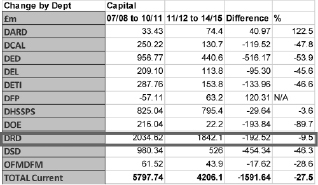
Broadly speaking the DRD has responsibility for transport and water infrastructure as well as for producing the Regional Development Strategy (RDS). These are separated into two objectives, A and B:
As the brief discussion of the budget allocations has shown the Department must now attempt to realise these objectives, with significantly less funds than it has done in the past, a considerable task given they are highly dependent on capital investment which has been severely cut. Although table 4 shows a real term reduction in capital expenditure of 9.5% it must be remembered that a significant amount, some £790 million of the current allocation has been ring fenced by the executive to progress with the A5 and A8 road schemes over the duration of this spending period. This greatly distorts the capital budget allocation[4] given that 70 per cent of the allocation for roads is used up with these two projects, while it represents over 40 per cent of the total proposed capital expenditure for the period. Tabled five and six (below) show the proposed current and capital expenditure for the DRD over the draft budget period 2011-2015.
| 2011-12 £m |
2012-13 £m |
2013-14 £m |
2014-15 £m |
Total over period £m |
|
| Objective A | |||||
| Roads | 209.5 | 200.8 | 194.9 | 188.7 | 793.9 |
| Transport | 90.5 | 92.8 | 71.1 | 71.7 | 326.1 |
| Total objective A | 300.0 | 293.6 | 266.0 | 260.4 | 1,120 |
| Objective B | |||||
| Water and Sewerage | 200.3 | 193.6 | 193.6 | 193.6 | 781.1 |
| Total Objective B | 200.3 | 193.6 | 193.6 | 193.6 | 781.1 |
| Total | 500.3 | 487.2 | 459.6 | 454.0 | 1,901.1 |
| 2011-12 £m |
2012-13 £m |
2013-14 £m |
2014-15 £m |
Total over period £m |
|
| Objective A | |||||
| Roads | 144.9 | 254.5 | 387.4 | 324.7 | 1,111.5 -790m A5/A8 = 321.5 |
| Transport | 90.7 | 25.7 | 13.3 | 53.9 | 183.6 |
| EU Structural Funds | 0.2 | 0.1 | 0.2 | 0.2 | 0.7 |
| Total objective A | 235.8 | 280.3 | 400.9 | 378.8 | 1,295 |
| Objective B | |||||
| Water and Sewerage | 202.5 | 145.0 | 140.0 | 180.0 | 667.5 |
| Total Objective B | 202.5 | 145.0 | 140.0 | 180.0 | 667.5 |
| Total | 438.3 | 425.3 | 540.9 | 558.8 | 1,962.5 |
The allocations for the A5 and A8 combined with the cuts mean that inevitably, many proposed major road schemes will not move forward in this period and this will have an impact on the economy given the potential employment which may have been generated or indeed current positions which may have been safeguarded.
Paragraph sixteen of departments spending proposals state that:
“…there will be significant reductions in other capital programmes such as walking and cycling, traffic calming, collision remedial, traffic management measures, local safety improvements and bridge strengthening."
There are a number of areas in this brief paragraph which are very distinct and which will resonate differently with different people. If we consider the departmental objective; to maintain safe and sustainable transportation networks, it is clear that their ability to satisfy this will be seriously undermined by this proposal. In terms of sustainability, improving walking and cycling were, based on all the rhetoric coming from the Department, significant priorities; however the recent reality has shown them to be the areas most vulnerable to cuts.
In safety terms reductions to traffic calming, collision remedial, traffic management measures, local safety improvements and bridge strengthening will all have an impact on the safety of pedestrians and cyclists but also on car users. Although the proposals suggest that the impact on these programmes will be most severe in the middle two years of the budget period, the level of detail provided is insufficient on which to make any kind of detailed response. The proposed cuts facing each of the programmes mentioned warrants further explanation, as well as a thorough risk assessment; neither is provided in the consultation document.
The Draft Budget allocations in capital and current expenditure for roads structure maintenance are:
| 2011-12 | £94m |
| 2012-12 | £52m |
| 2013-14 | £56m |
| 2014-15 | £82m |
Over the period of the budget this is some £200 million (70 per cent) short of levels recommended in the Structural Maintenance funding plan. And although DRD representative, Geoff Allister commented to the committee[5] that the “£94 million that will go into structural maintenance in year one is as much investment as I can recall in my time" this will do little to alleviate the concerns of consultees who a) were unlikely to have heard that comment and b) who will have read that:
“This level of investment, coupled with reductions in road maintenance activities, is predicted to lead to the network being less resilient to extreme weather events such as freeze/thaw cycles and flooding".[6]
The fact that the structural maintenance allocations drop off so dramatically in year two and three must be of some concern given the fact that the last three winters in the UK have gotten progressively worse and no one can really predict what will happen next year. Perhaps of even greater immediate concern, particularly to rural dwellers will be the criteria used to allocate the structural maintenance fund, although again, this information is not provided in the consultation.
Evidence given to the committee highlighted that safety was the number one priority when allocating these funds and then routes across the networks were prioritised. The potential therefore, which was readily accepted by the Department, was that lesser used rural roads will not be a high priority and will therefore be unlikely to be looked at in the current spending period. Again this information would have been useful in the budget as details of how funds are prioritised, will at least give consultees the information they need on which to formulate a reasonable response.
The spending proposals will allow the DRD to fund the development of its Rapid Transit system as well as allowing them to ‘plan to invest’ in a number of sustainable transport initiatives, including electric vehicle infrastructure. While these proposals are welcome, particularly in the case of the Rapid Transit system, consultees may ask why it is only now that a pilot is planned given the scheme was agreed in 2008.
While the funds allocated to support electrical vehicle infrastructure are, theoretically, in line with the Departments objective of a sustainable transport future, the question of how this is a higher priority than for example, cycling infrastructure may be one worth asking. It could be suggested that, at least in the short term, cutting spend on walking, cycling and public transport i.e. bus replacement and service provision will have a much greater negative impact on sustainability than the electric car infrastructure will have a positive one. However this debate only serves to demonstrate again, that the lack of this type of detail is in the consultation makes any meaningful analysis impossible.
To date achieving modal shift has been a priority of the Department, however if underinvestment compromises on safety and as predicted by the Department, service levels decline and fares go up, the average consumer will feel they have no alternative but to use the car. The cumulative effect of these measures will hit the most vulnerable in society, as any attempt to reduce services on unprofitable routes could result in them being cut off. From and environmental and indeed economic point of view congestion will increase, as will emissions.
NI Water’s 2010-13 Business Plan (PC10) provides the company’s assessment of the capital investment required in the PC10 period to maintain its assets, provide for new development and growth, enhance levels of service to consumers, improve the quality of water supplied and sewage discharged, and provide the general facilities required to support its business activities.
NI Water prepared its estimates based on current costs which were then adjusted to reflect the company’s view on the efficiencies they believed could be achieved in PC10. The Northern Ireland Authority for Utility Regulation (NIAUR) and NI Water formally confirmed that the Price Control for 2010 – 2013 (PC10) had been accepted on December 23rd 2010. The price control is subject to public funding and is underpinned by a Memorandum of Understanding between the Department for Regional Development and the Utility Regulator; the figures are detailed in tables eight and nine.
| £m 07/08 Prices | £m Nominal Prices | |
| 2010/11 | 2029.80 | 214.9 |
| 2011/12 | 189.074 | 204.9 |
| 2012/13 | 176.665 | 195.7 |
| PC10 Total | 568.719 | 615.4 |
Source: NIAUR (2010)[7]
| £m 07/08 Prices | £m Nominal Prices | |
| 2010/11 | 193.309 | 193.4 |
| 2011/12 | 183.732 | 188.0 |
| 2012/13 | 187.308 | 196.1 |
| PC10 Total | 564.349 | 577.5 |
Source: NIAUR (2010)[8]
While this was signed off in December 2010, the proposed departmental spending plans show a shortfall in the agreed capital spend for water (see table ten). While at the most basic level this cut to funding will inhibit NI Water in delivering on its agreed performance levels it will no doubt only serve to aggravate an already aggrieved customer base who suffered through a Christmas period of unprecedented water shortages.
| NI Water PC10 | Proposed Allocation | (%)Difference | |
| 2010/11 | 214.9 | 201.99 | -6% |
| 2011/12 | 204.9 | 202.5 | -1.1% |
| 2012/13 | 195.7 | 145.0 | -26% |
| PC10 Total | 615.4 | 549.4 | 11% |
NIWater is already operating within the constraints of the legacy of under-investment in water and sewerage services. One good example is the rate of water mains replacement activity. Each year a proportion of the water main network must be replaced to protect continuity of service. In 2007-10, and despite increased investment, the NIWater rate still lagged 35% behind the replacement rates of the England and Wales water companies who have similar asset stocks to NIWater.
The proposed rate of replacement during PC10 will improve, but due to funding constraints it will only go part of the way toward closing this gap, with the rate still behind by 19%. If the pace of investment in the provision of water services in Northern Ireland is not addressed, there will be an even greater and more expensive catch-up required in the future.
Accordingly, the Regulator and Department agree that any request for alteration of funding by the Undertaker will be referred to them for joint review. Alterations to public expenditure will be subject to final Ministerial or Executive decision. Before agreeing material variations to the Capital Programme, the Regulator will consult the Environment Agency, the Drinking Water Inspectorate and the Consumer Council. Requests for alteration by the Undertaker must be above the materiality threshold. The Regulator and the Department shall agree written procedures for dealing with alterations to funding.[10]
According to the Draft Budget the Department are required to fund cumulative current expenditure reductions of £162.9 million over the four year spending period. This will be realised through a combination of sixteen measures which include increasing revenue, reducing funding and managing procurement. The total saving across the four years has been laid set as follows:
| 2011-12 | £15.7m |
| 2012-12 | £28.8m |
| 2013-14 | £56.4m |
| 2014-15 | £62m |
The budget clearly states that:
“The process of reviewing savings and income generation options has been led by the senior management within the Department and a series of workshops has been conducted with the Minister. Each option has been considered by the Minister and senior management against an agreed list of priorities in order to assess the relative impact of each option put forward." (Page 14)
As with other parts of the budget, the issues of priorities come up and questions over how these are set, immediately come to mind. Previously measures which would clearly meet the Departments objective A, in terms of sustainability and safety have been cut therefore the question is if issues identified as key objectives are not a priority, then what is?
Public Transport, an area previously well supported has been earmarked for cuts in this budget. The areas which have been identified for reduced funding in the Draft Budget include:
| Spending Area | 2011-12 (£000’s) | 2012-13 (£000’s) | 2013-14 (£000’s) | 2014-15 (£000’s) | Total (£000’s) | |
| RTF | Transport | - | 300 | 600 | 800 | 1,700 |
| TPPD | Transport | - | 700 | 700 | 900 | 2,300 |
| PTR | Transport | 2,000 | 700 | 700 | 700 | 4,100 |
| RFS | Transport | - | - | 200 | 200 | 400 |
| NILGOSC | Transport | - | 860 | 5,800 | 2,800 | 9,460 |
An initial response to these proposed savings is that there is a disproportionate focus on rural areas and in particular on vulnerable groups. Research clearly shows that groups such as the elderly, disabled, single parents and young people are less likely to have access to a car and are therefore more susceptible to social exclusion. Many of these groups will rely on public transport and the Rural Transport Fund has made a significant contribution to the mobility of these groups. The RTF provided approximately 203,000 passenger trips on Ulsterbus services in 2007-08 and supported 18 Rural Community Transport Partnerships (CTP); the CTPs provided 630,000 passengers in the same year.[11] The draft budget proposes to:
Despite the fact the figures above are dated they demonstrate very clearly the potential number of people who will potentially affected by these cuts.
The Draft Budget does acknowledge the impact on vulnerable groups and suggests that it will make some effort to retain services where possible. One area of concern is the fact that it sees door-to-door services picking up the shortfall caused by the reduced Translink services. This proposal is clearly unsustainable for two reasons; firstly there is a disproportionate cost associated with providing door-to-door services and secondly, this funding is also planned to be reduced.
In terms of the Transport Programme for People with Disabilities (TPP) savings of £2.3 million have been identified over the spending period, this will be made up with a:
An assessment of these proposals has again identified vulnerable groups, including older people, people with disabilities and women as most likely to be affected. It is worth noting that these proposals go against the long term vision for transport in Northern Ireland, which is:
“To have a modern, sustainable, safe transportation system which benefits society, the economy and the environment and which actively contributes to social inclusion and everyone’s quality of life."[12]
Within the proposed budget there are also a series of planned cuts to Translinks funding which will have an impact across the bus and rail network, leading to increased fares and reduced service levels. These proposals are likely to affect the wider network and have the potential again to not only isolate certain vulnerable groups, but also to reduce the attractiveness of public transport to the wider public.
This draft budget proposes to introduce a series of measures which go against established policy. This paper has already shown that it will inhibit the Departments ability to deliver on goals of having a sustainable and safe transportation system. Many of the cost saving measures would appear to expose vulnerable groups and rural areas which would suggest it has the potential to contribute to social exclusion rather than inclusion.
[1] Finance Minister’s Draft Budget Statement - Draft Budget 2011-15 [online] available from: http://nia1.me/3o
[2] Unless otherwise stated, information in this document taken from DRD Draft Budget 2011-15 available from: http://nia1.me/3z
[3]Northern Bank (2010) Comprehensive Spending Review Analysis [online] available from: http://nia1.me/3v
[4]Official Report (Hansard) for the Committee for Regional Development, 12th January 2011. available from: http://nia1.me/40
[5]Official Report (Hansard) for the Committee for Regional Development, 12th January 2011. available from: http://nia1.me/40
[6]DRD Draft Budget 2011-15 available from: http://nia1.me/3z Paragraph 22 (Page 9).
[7] Memorandum of understating between the DRD and NIAUR: Written agreement [online] available from: http://nia1.me/3w
[8] Memorandum of understating between the DRD and NIAUR: Written agreement [online] available from: http://nia1.me/3w
[9] NI Executive (2010)Revised 2010-11 Spending Plans for NI Departments [online] available from: http://nia1.me/3x
[10] Memorandum of understating between the DRD and NIAUR: NOVEMBER 2010 [online] available from: http://nia1.me/3y
[11] DRD (2008) Rural Transport Fund [online] available from: http://nia1.me/42
[12]DRD (2002) Regional Transportation Strategy [online] available from: http://nia1.me/43
Paper 000/00 17th January 2011
Committee for Regional Development
Committee Office
Room 435
Parliament Buildings
Ballymiscaw
Stormont
Belfast
BT4 3XX
Tel: 02890 521821
Fax: 02890 525927
Email committee.regionaldevelopment@niassembly.gov.uk
Ms Jennifer McCann MLA
Chairperson
Committee for Finance and Personnel
Parliament Buildings
Ballymiscaw
Stormont
Belfast
BT4 3XX 6 January 2011
Timetable for consideration of the Draft Budget and publication of departmental information
Dear Jennifer,
1. At the Committee meeting of 6 January 2011, the Committee for Regional Development decided to write to you to request more time to consider the Northern Ireland Draft Budget for 2011-2015.
2. Following publication of the Draft Budget and the Finance Minister’s statement to the Assembly, the Regional Development Committee wrote to a number of its key stakeholders requesting written and oral briefing on the impact for their organisations of both the Executive’s Draft Budget document and the information to be published on the Department for Regional Development’s spending and savings plans and its plans for public consultation and consideration of equality impacts. The deadline given by the Committee for receipt of written papers from stakeholders was Friday 7 January 2011, with oral evidence sessions planned for 12 January 2011. This would allow the Regional Development Committee one week to consider the briefing received and to formulate a response to your Committee’s call for input by your deadline of 21 January 2011.
3. As, at the time of writing, the Department for Regional Development has not published its detailed spending and savings plans, and stakeholders are not in a position to provide comment in any meaningful way on the impact for their organisations of the draft Budget or DRD’s spending and savings plans. In turn, the Committee will have no adequate time to consider DRD’s detailed plans, or the impact they may have on stakeholder organisations.
4. The Finance and Personnel Committee timeframe, as it currently stands, does not allow the Regional Development Committee adequate time to make an informed response to your Committee or to the coordinated report on the Draft Budget. It is also doubtful whether there is enough time for the Committee to formulate an informed view to represent during the proposed take note debate on the Draft Budget, indicatively timed for 25 January 2011.
5. Indeed Members were concerned, in the absence of detailed information published across all departments, that it could prove very difficult for anyone, be they stakeholders, members of the public, voluntary and community sector organisations, or business and trade union organisations, to make a detailed response to the public consultation by the closing date of 9 February 2011.
6. Members understand that the timetable for finalisation of the Budget is very tight this year, and that this is largely outside the control of the Finance and Personnel Committee. However the Members of the Regional Development were keen to:
a. Request more time for consideration of the detailed departmental spending and savings plans;
b. Reiterate its previously expressed view that adequate time is needed to make an informed response by the Assembly committees, and that this time should reflect the important role of the committees in the Assembly process of developing the Draft Budget and finalising the Executive’s Final Budget.
7. A response as soon as possible would be appreciated. In the interim, the Regional Development Committee will continue to prioritise scrutiny of the Draft Budget and will, as far as it is possible, strive to meet your Committee’s timetable and to play its full part in the Assembly’s consideration of budget and financial matters.
Yours sincerely,
Committee Chairperson
Committee for Regional Development
Committee Office
Room 435
Parliament Buildings
Ballymiscaw
Stormont
Belfast
BT4 3XX
Tel: 02890 521821
Fax: 02890 525927
Email committee.regionaldevelopment@niassembly.gov.uk
Dathai McKay MLA
Chairperson
Committee for Finance and Personnel
Parliament Buildings
Ballymiscaw
Stormont
Belfast
BT4 3XX 31 January 2011
Dear Dathai,
1. At the Committee meeting of 31 January 2011, the Committee for Regional Development decided to provide the following input to your committee’s Co-ordinated Report on the Executive’s Draft Budget 2011-2015.
2. Members were keen to stress that, because of the tightness of the timescale for public consultation on the Executive’s Draft Budget and the complexity of the Department for Regional Development’s spending and savings plans, this response is an interim response. Once Members have had the opportunity to consider all the written and oral evidence provided by stakeholders on the impact of the Department for Regional Development’s spending and savings plans proposals, together with the papers and oral evidence provided by departmental officials, they will form a more detailed view on the Department’s proposals. The Committee will then provide its views to the Minister for Regional Development, the Finance and Personnel Committee, and publish its final response on the Assembly’s web pages.
3. I wrote to you earlier this month expressing the Committee’s concerns about the impact of the Executive’s timescale for both public consultation and the Assembly’s consideration of the Draft Budget. On behalf the Regional Development Committee I would like to thank you and your committee for pressing the case for an extension to the timetable. The Assembly and its Committees play a vital role in the scrutiny of the Draft Budget and the development of the final Budget, and the time available to Committees should reflect their critical contributions.
4. Members were pleased that the Executive responded to the committee’s request for more time, and extended the consultation process by one week. The Committee used this time at its meeting of 26 January 2011, to hear from a number of key stakeholders about the impact of the spending and savings plan proposals on their organisations and sectors. A detailed discussion of the serious impacts identified during the event will be available once the official report has been published. In the interim, the issues raised are reflected briefly in the paragraphs below.
5. The size of the cuts facing the Department for Regional Development are significant, and will have a severe impact on the most vulnerable in society, economic competitiveness, and the sustainability of transport in Northern Ireland.
6. The Committee heard from the Department and stakeholders that the proposed cuts will have a negative impact on all the Section 75 groups and will directly impact the most vulnerable in society, people with disabilities and older people, rural communities, and those without access to a car.
7. The scale of the cuts in DRD’s capital budget, with reduced levels of investment in road schemes, roads structural maintenance, public transport initiatives and water and sewerage services will place additional pressures on businesses in Northern Ireland, and will make growing the economy more difficult. Congestion and poor road maintenance lead to longer and less reliable journey times, and increase the costs of doing business in Northern Ireland. The quality of all our infrastructure - public transport and water and sewerage services included - are a key factor in determining the attractiveness of Northern Ireland as an investment location for foreign direct investment.
8. The evidence received stated that this Draft Budget will roll back the progress made in recent years on accessible and sustainable transport, discouraging the use of public transport as an option for those with a choice, lead to social exclusion for those without alternative transport services or access to a car and, potentially, increase transport related emissions.
9. The Committee will continue to consider the evidence received, analyse the proposed allocations and savings plans, and looks forward to working with the Department to secure the best possible budget outcome for regional development in Northern Ireland.
10. Although recognising the severity of the settlement in the 2010 Spending Review, the Committee was disappointed to note the allocations to the Department’s total budget over the four year budget period. Whilst there is a slight increase, from £938.6 million in 2011-12, to £1.012 billion in 2014-15, Members noted that, when compared with total planned expenditure in the previous budget period, the total Draft Budget allocations were a 6.3% reduction in real terms.[1]
11. The reductions in the Spending Review settlement are particularly stark when you look at the impact of reductions in DRD’s Draft Budget, as identified by the Department in its consultation document and evidence to the Committee.
12. There are no allocations to commence construction on major roads schemes such as the A6 Randalstown to Castledawson scheme; the A2 Greenisland scheme; the York Street Flyover; the Sydenham bypass widening scheme; and other schemes along the A6. With the exception of the A5 and A8, the A32 Cherrymount Link is the only other scheme to complete in the budget period.
13. There will be significant reductions in other capital improvement programmes such as walking and cycling, traffic calming, collision remedial (although Roads Service is adamant that safety will be prioritised); traffic management measures; local safety improvements; and bridge strengthening.
14. Funding will not be available in years two and three of the budget period to meet the agreed levels of investment in water and sewerage services as set out in the PC10 final determination.
15. Funding is confirmed for the planning phase only on rapid transit, and to plan to invest in electric vehicle charging infrastructure (despite DRD/DOE making a successful OLEV bid), the Belfast on the move city centre traffic management initiative, and for other bus priority measures.
16. From an historic high of £92 million in year one, structural maintenance funding falls sharply in years two and three of the budget period, and over the budget period is some £200m below the circa. £112 million per annum recommended in the Snaith Report. The Department states that this level of investment, coupled with reductions in roads maintenance activities is predicted to lead to the network being less resilient to extreme events such as freeze/thaw cycles and flooding.
17. Turning to current expenditure budget, the Department is required to fund cumulative current expenditure reductions of £163 million over the four year budget period. The Department stated that it is the only department facing a year on year reduction. In evidence, officials indicated that roads PPPs, provision for public liabilities and public service obligations (PSOs) were the only areas not cut as part of its savings plans.
18. The balance of expenditures over the budget period, between expenditure on roads and on transport, starting with 2011-2012 is 66:34; 79:21; 87:13 and 80:20. With the exception of the year one allocations which are unusual, these ratios fall short of the 65:35 identified in the 2002 Regional Development Strategy (RDS).
19. Of the 14 savings measures identified, two are to be achieved through procurement; two through increased revenue raising; one by lowering priorities; three through changes in administration or policy approach; and six through cuts in funding. The Committee will continue its work on analysing the incidence of planned savings during the remaining consultation period.
20. The Committee noted the figures provided by the Department in its papers of 12 January 2011, which illustrate how much of the planned current and capital allocations in DRD which are ringfenced.
21. On the one hand, the Committee recognises the importance of ringfencing as a tool to ensure that funding for high priority projects is used only for those purposes. For example, significant amounts of the structural maintenance capital allocations (£107.8 million of the £177.7 million) are ringfenced for this purpose. Overall, Members were concerned to note that, on average, 48% of capital investment in public transport and 83% of investment in roads over the budget period were ringfenced. Smaller amounts, 17% and 11% respectively were the proportions of current expenditure ringfenced over the same period.
22. This concern arises because once ringfenced, such allocations can only be used for the specified purposes. Should the Department be unable to spend all or part of a ringfenced allocation, permission must be sought from DFP to use that money for other purposes.
23. For example, the capital funding for the A5/A8 is ringfenced 100%. This project is dependent on a contribution of £400 million from the Republic of Ireland Government to progress. Construction, envisaged to begin for both schemes in 2012, is also subject to the successful outcome of public inquiries. Because the allocation is ringfenced, if the project was for any reason unable to proceed, the Department would require approval from DFP for the reallocation of this funding to other priority roads projects.
24. The Department, in its briefing to the Committee on 12 January 2011, stated that whilst Roads Service has a significant allocation, around £790 million (or 70% of it) is tied up in these two major road schemes (A5 and A8). The Department acknowledges the Republic of Ireland’s contribution to this project, however it highlighted that the 40% reduction in the Spending Review settlement, and the scale of these schemes means that there are no allocations to commence construction on other major road schemes.
25. Roads Service has, traditionally, been skilled in managing its funding allocations to achieve optimal outcomes for the Department. By managing the development of a range of priority schemes that are at different stages of the design, consultation / inquiry and construction process, Roads Service has in the past used its allocations flexibly to progress a range of roads schemes. Ringfencing such a significant amount of the Department’s total budget for two schemes might hinder Road Service’s ability to best manage work in its specialist area. The Committee hopes to continue to explore this issue and the Department’s options with DRD over the course of the consultation on the Draft Budget. The Committee is strongly of the view that if the A5 or A8 schemes, for whatever reasons, are unable to proceed then the ringfenced funding should be available to the Department for other priority road projects.
26. The Committee received a written submission from the Northern Ireland Authority for Utility Regulation, which highlighted the Regulator’s views on the level and profiling of capital investment expenditures over the period of PC 10 (the 3 year price control period from 2010-2013), as this is reflected in the Draft Budget allocations. The table below illustrates this point.
| PC 10 Final Determination (PE terms) | Budget 2007/ Draft Budget 2010 | Difference | Difference | |
| £m | £m | £m | % | |
| 2010/11 | 194.2 | 201.00 | 7.7 | 4.0% |
| 2011/12 | 188.4 | 202.00 | 14.1 | 7.5% |
| 2012/13 | 195.9 | 145.0 | -50.9 | -26.0% |
| PC10 Total | 578.5 | 549.0 | -29.1 | -5.0% |
| 2013/14 | -- | 140.0 | -- | -- |
| 2014/15 | -- | 180.0 | -- | -- |
| Draft Budget Total | 667.5 | -- | -- |
Source: Letter from NIAUR, 26 January 2011 and DALO 489 12 January 2011.
27. The Committee notes that in year 1 of the Draft Budget (year 2 of the PC10 period) there is an indicative capital investment allocation some 7.5% in excess of the level recommended in the agreed PC10 determination, however this is followed by an allocation which is £50million (26%) lower than the level agreed in PC10. Members recognise the constraints facing Northern Ireland Water, particularly in the current economic climate, however they were concerned about the impact this may have on Northern Ireland Water’s ability to deliver the investment in infrastructure which was agreed as necessary during the PC10 process.
28. Looking at the profile of capital expenditure for water and sewerage services in the Draft Budget, it begins at a level, has a significant dip in years 2 and 3, and increases again in year 4. This “u-shape" profile is the opposite of what might be expected for relatively large scale infrastructure investment programmes carried out over a number of years. In profile, such projects tend to have lower expenditures in the early years, with an expenditure peak at the mid-point and slightly beyond (an “inverted u-shape").
29. Briefing from the Utility Regulator identifies the potential implications of the Draft Budget profile for capital expenditure in Northern Ireland Water (NIW) as:
30. Members wish to highlight the factors driving the need for capital investment in NIW.
| % Capital Investment | Driven by: |
| 44.4% | Need to maintain the asset base and sustain current level of performance and service. |
| 29.3% | Need to meet quality compliance / EU directives |
| 18.9% | Need to facilitate growth or development needs |
| 7.3% | Enhancing the level of performance |
Source: Letter from NIAUR, 26 January 2011
31. The Committee understands that work is ongoing to identify and investigate options for re-profiling the capital investment programme, however Members are concerned. As can be seen above, the majority of capital investment, almost 74%, is driven by the need to maintain current levels of service and performance and to meet compliance standards. A reduction of 26% in the level of capital investment in year 2, with a further reduction in year 3 of the Draft Budget period, cannot but have an impact on the levels of service and compliance currently provided by NIW. There could be little or no room for service or performance improvements or development over the coming years.
32. Again, the Committee hopes to explore this issue with the Department during the consultation period and beyond.
33. The Committee held a stakeholder engagement event on Wednesday 26 January 2011 on the impact of the Department’s spending and savings delivery plans. Whilst the Committee has not had a chance to consider the feedback received during this event in detail, the following paragraphs are not exhaustive but they provide a flavour of the contributions made during the event. These are organised under the headings of social, economic and environmental impacts, however the Committee is keenly aware that these are interlinked and cross-cutting categories. The Committee plans to publish the official report of this event on the Assembly’s web pages at the earliest opportunity. This will provide a more detailed and nuanced picture of the feedback received on the impact of the Draft Budget, which we hope will contribute to the debate as the budget process moves forward.
34. There was a significant amount of discussion on the social impacts of the Department’s spending and savings delivery plans. Contributions were received from organisations including the Consumer Council, the Community Transport Association (CTA), Disability Action, the Inclusive Mobility Transport Advisory Committee (IMTAC), Shopmobility, and Translink.
35. There was agreement among many of the stakeholders at the Committee’s event that the proposals in the Department’s spending and savings delivery plans would have a disproportionately negative impact on older people, people with disabilities, and people reliant on public transport, especially in rural areas.
36. The Committee heard from IMTAC that restrictions in the door-to-door service to core hours will limit the ability of older people and people with disabilities to go out in the evening and at weekends, an impact also identified by Disability Action. IMTAC stated that the combination of measures in the draft budget proposals will limit Shopmobility schemes; reduce support for rural and group travel schemes; reduce subsidy for rural public transport; reduce the number of Rural Community Transport Partnerships; and reduce the level of subsidy to Translink. The cumulative impact of these proposals will be to reduce the supports available to many vulnerable people, and in IMTAC’s view this will cause social exclusion, isolate many people in their homes and reverse the dramatic progress Northern Ireland has made in the past 15-20 years for disabled people, young people, older people and those who have no access to a car.
37. The CTA was also of the view that reductions in the rural transport fund and transport programme for people with disabilities will have significant impact on communities by 2015, with increased problems in terms of rural isolation, exclusion and access for the most vulnerable in society. Reductions in the Rural Community Transport Network would mean that 25%-30% of people in rural areas will not be able to access transport solutions, CTA said.
38. CTA also stressed the need to consider the linkages between community transport provision and reductions to Translink’s budget. The impact of potential reductions in rural routes and service frequencies, together with the possibility of increasing fares, will place further pressures on community transport to deliver the alternative access solution.
39. The impact on those older people, people with disabilities, people with mobility difficulties and their families, arising from the proposed reductions in support for Shopmobility schemes was also discussed. Shopmobility highlighted its success in generating much of its own funding, and emphasised that the trips taken as a result of Shopmobility schemes put money back into the economy. This local economic benefit would be lost, as well as the obvious benefits to the vulnerable members of society who make use of the schemes, should the proposals go ahead as they currently stand.
40. IMTAC stated that millions of pounds have been spend in the past on providing accessible public transport infrastructure, but this will be lost if people cannot get to the public transport network to use the accessible buses and trains. IMTAC called for a creative re-examination of alternative approaches based on evidence of usage patterns, rather than an across the board approach. The CTA was of the view that transport should receive priority if further monies became available during the budget period. It also highlighted the need to look for joined-up solutions, to share costs and savings across departments including health and education.
41. Translink made a number of points on the social impacts of the spending and savings proposals. It stressed that it wanted to minimise any negative impacts in terms of services and jobs. In contributions, Translink stressed it was cognisant of its social and sustainability objectives, and the need to provide for the travel requirements of older people, people with disabilities and those living in rural communities – at an individual level and also at a community level.
42. Translink stated that it was trying to protect the geographical coverage of the network as far as possible, and indicated that connectivity and integration were important considerations. As it makes changes, it has to ensure that people still have access and connections to the main network. However, Translink explained that it was duty bound to examine the poorest performing parts of the network and that, ultimately, is down to passenger numbers, services that are unnecessary or those that can be covered through a combination of other services. It also stated that it would be looking at parts of the network where it thought services could be improved or enhanced to grow passenger numbers.
43. NILGA welcomes proposals to secure a better deal for the supply of street lighting energy but was very concerned to note that one of the contingencies, if this doesn’t happen, is dimming or removal of street lights or introducing shorter burning hours. There is a paradox in this proposal in terms of DRD’s commitment to contribution to the health and well being of the community. Better street lighting helps improve road safety, as well as reducing crime and the fear of crime. It also helps to create happy and healthier communities by promoting social inclusion and sustainable transport patterns by encouraging people to walk or cycle.
44. Again, there was wide ranging discussion on the economic impacts of the Department’s spending and savings proposals. The Confederation of British Industry (CBI), the Quarry Products Association Northern Ireland (QPANI), the Federation of Small Businesses (FSB), the Northern Ireland Local Government Association (NILGA) and the Freight Transport Association (FTA) all made contributions on this aspect of the Draft Budget proposals.
45. CBI welcomed the broad approach taken and the investment commitment set out in the Draft Budget. Continuing to invest in the strategic road network and public transport are high priorities for the CBI, and it supports the schemes to upgrade the A5 and A8. QPANI also welcomed the commitment to capital spending on the A5 and A8. However, it was of the opinion that if the contribution from the Republic of Ireland government was not forthcoming following the general election, that the planned capital allocations in DRD’s budget should be reallocated to strategic programmes and schemes across Northern Ireland that will positively maximise the impact on jobs.
46. CBI expressed its disappointment that other key roads, which it saw as priority schemes, particularly the A6 Randalstown-Castledawson and the York Street flyover, were not to proceed.
47. CBI welcomed the commitments to proceed with investment in transport, including Rapid Transit, but sought clarification on the need for another train maintenance facility. Translink provided clarification on this issue, stating that the need for a new train maintenance facility is a reflection of the substantial increase in the capacity of the railways as the new trains are brought in. Maintenance is required to optimise that additional rail capacity and to physically maintain the trains.
48. The FTA highlighted the importance of freight to the economy. It stated that freight deliveries must be cost efficient as margins are low and times are hard for business. The freight industry needs to work smarter to make best use of its existing assets, and with high fuel costs, a good infrastructure is a key requirement for the FTA’s members to meet their goals but also to encourage inward investment to Northern Ireland.
49. By way of example, the FTA identified that Belfast Harbour handles 60% of seaborne trade. Congestion on the roads serving that hub needs to be addressed and fixed quickly. In its view, proposals for Belfast on the move and rapid transit would reduce lane space and would force traffic out onto the Westlink. In its view, the York Street flyover and the Westlink junction were priorities for action to improve inward investment, improve journey times, reduce congestion and to improve air quality in that area. Briefly, the FTA welcomed the work proposed for the A8, highlighted the very heavy daily traffic on the A6/ M22, the need to dual the M1/A1 at Sprucefield to accommodate the 42,000 vehicles travelling daily into Belfast, and questioned the daily vehicle numbers (13,500) on the A5 relative to the cost of the scheme proposed for that route.
50. On the issue of the savings delivery plans, QPANI welcomes a more focused approach on minor maintenance activities and would suggest that many maintenance activities should be outsourced to the private sector. QPANI also welcomed the rationalisation of Roads Service depots and section offices and would urge Roads Service to continue to identify opportunities for savings that can be delivered to front line services.
51. FSB expressed its disappointment that options, such as privatisation, were not considered. In its view, this limited the discussion and the scope for going forward, not least because in its absence there would have to be a myriad of ways of raising revenue throughout the economy. Its concern was that these other revenue raising options would effectively add stealth charges to the cost of living and doing business in Northern Ireland, whilst ignoring one of the key ways that the gap in funding could have been closed. FSB also encouraged more innovative thinking about how our existing infrastructure is used, such as using technology for reversing the direction of roads at certain times of the day so as to make better use of the existing infrastructure.
52. The CBI stated that the savings identified in the Department’s consultation document have been set out in detail. In its view, a number of these will clearly impact on service provision but from a broad strategic economic perspective, it did not believe that any of them would undermine economic recovery.
53. It did, however, express its surprise that in a key area such as delivering savings, it could see no evidence of administrative savings being identified or prioritised by the Department or of how DRD will improve its productivity and manage its pay bill over the budget period. Neither could it see proposals for what, in its view, would be ambitious reforms such as process reengineering or outsourcing. It was disappointed at proposals to transfer £6m from capital to revenue funding and challenged this move asking why administrative savings were not looked for instead.
54. FSB questioned how planned increases in parking charges would fit with the Department for Social Development’s plans for town centre regeneration. From the FSB point of view, the two do not appear to mesh cohesively. On a related point, NILGA was of the view that on-street car parking charges could potentially increase illegal parking in towns which would exacerbate town centre congestion. This would put people off shopping in towns and would encourage the use of out-of-town shopping outlets where parking is free. NILGA stated that local businesses need as much help as they can get if they are going to survive the current economic difficulties. In contrast, CBI was of the view that proposals to raise revenue from increased car parking charges were proportionate and sensible.
55. Opinion was somewhat varied on the issue of raising revenue from Belfast Harbour. FSB had concerns over the taking of a dividend from the port in terms of the cost of doing business and its impact on both importing and exporting costs. QPANI welcomed the proposed release of £15 million for two years from Belfast Harbour, and CBI welcomed this approach to revenue raising as proportionate and sensible.
56. Investment in water and sewerage services also arose during a number of contributions to the Committee’s draft budget event. For the CBI, it was vital that we continue to invest in water and sewerage services at a high level, and it was concerned that allocations in years two and three of the budget were below those recommended in the PC10 final determination. Concerns in relation to the allocations below those set out in PC10 were also identified by the Consumer Council. QPANI also underlined the need for continued investment in the water and sewerage network in order to comply with European quality standards and to ensure that the network can cope with severe winter weather. In its contribution, CBI expressed the view that deferring water and sewerage charges was making funding more difficult, not just for transport and water and sewerage infrastructure, but also for the broader package. QPANI also called for the reintroduction of water charges to pay for our water and sewerage services network.
57. For the FSB, infrastructure is one of the keys to businesses leading the economic recovery, not just the infrastructure itself but the perception of the quality and reliability of the infrastructure. In its view, recent problems with water sent a very poor signal to investors and damaged consumer confidence.
58. NILGA also expressed concerns that the planned reduction in subsidy to the Rathlin Ferry Service would increase costs for islanders and have a negative impact on tourism in the area.
59. In response to a comment from the Chairperson that the Committee’s concern was to take cars off the roads, and that there were no incentives in the budget to do this, Translink stated that the solution lay in integrated travel solutions that are attractive, sustainable and good value, but that sustainability was key.
60. The Consumer Council shared the view that there was little in the budget to create a modal shift from car to public transport, and in many ways it goes against what consumer research demonstrated consumers wanted from public transport, which was value for money, more frequent services and a wider network.
61. The Consumer Council also stressed that in many areas of Northern Ireland the choice to use public transport as a more sustainable travel option was not available. Its contribution reflected that ambitious plans and strategies are in place to support public transport, cycling and walking but these are often lost when it comes to the delivery. By way of example, it was stated that the Regional Transportation Strategy (RTS) in 2002 suggested a spending ratio for roads to public transport (including walking and cycling) of 65% and 35%, and that this has never been achieved. In addition, there is a very strong sustainability message throughout the revised RDS but it will be very difficult to achieve this and the modal shift, against the backdrop of this budget. The funding profile for rapid transit, and other reductions in investment in integrated transport, means that the traffic management improvements identified in the Belfast on the move initiative may not be optimised.
62. The Consumer Council identified that the Enterprise service is also likely to be affected as there will be speed restrictions on the line, again providing more encouragement to move away from public transport and into the car.
63. QPANI recognised and supported the need to reduce carbon emissions but argued that it is not roads that create carbon emissions, but the vehicles using then. It does not believe that Northern Ireland has the population to support and finance a profitable and efficient train network but was of the view that a well funded, bus-based park and ride, integrated public transport network fuelled on low carbon fuels was the solution to sustainable transport. QPANI expressed its support for rapid transit for Belfast and government incentivises to encourage the use of low carbon fuels. QPANI also stressed that it had made representations to Roads Service on the need to look to lower carbon products, and that some progress had been achieved with more sustainable bitumen products and processes. On balance, QPANI did not think that sustainability would be achieved because of constraints on the budget, but that a balance needed to be struck. The economy needed to be prioritised because the only way we can be in a position to offer better services in the future is by increasing the tax take from the economy and growing the private sector.
64. The CBI view was that sustainability clearly covers economic, social and environmental. CBI welcomed the investment in the rapid transit system and believes it will help achieve the modal shift in transport. It was CBI’s view that the focus of public transport should be on the high traffic volume routes, and on building on the investment made in recent years in the metro service to improve connectivity.
65. Addressing congestion through investment in roads projects was also identified by the CBI and the M22 at Castledawson was identified as a priority. The FTA also identified the junction at Dee Street, Belfast, as an example of where relatively small changes in the roundabout could ease congestion, and thus address air quality and particulates levels.
66. In its contribution, Sustrans stated that congestion only accounts for one third of transport costs, and that it is important to factor in the longer term environmental and health benefits of more active travel patterns. It pointed out that a cost benefits analysis shows that money spent on infrastructure for active travel delivers gains in excess of those delivered by building roads. Sustrans asked that the Draft Budget re-examines the safety measures that benefit children, the impact on people that do not have access to a car, and more environmentally sustainable modes of travel. It points out that in this version of the budget road safety, traffic calming, pedestrian and cycling measures are, in its view, virtually eliminated, and suggests that there is a need to get the balance back whereby we incorporate active travel into the budget and look to the benefits that arise from active travel.
67. The Committee’s views on the importance of securing adequate funding for structural maintenance are well known and rehearsed. Indeed, the Committee has expressed its support for funding for structural maintenance in monitoring rounds, and in debates on budget bills and draft budgets since the beginning of this mandate. However, Members wish to take this opportunity to rehearse the contribution to economic competitiveness, value for money and road safety arguments for providing adequate funding for structural maintenance.
68. In terms of stakeholder comments, QPANI highlighted the importance of investment in structural maintenance, given the current condition of the roads network and the additional damage that has been done over the past two years with the severe winter weather. It welcomes the allocation of £94m in the first year for structural maintenance, and points out that this allocation will sustain 1,200 jobs in the construction industry. However QPANI considers this allocation to be a way short of what the Snaith Report established was required on an annual basis, which estimates that £112m per annum was the amount needed. Over the four years of the budget period, there will be a shortfall of £168m against the funding recommended in that report, which will further add to the backlog in investment in this vital area. QPANI also pointed out that the £94m allocation in year one will not have the same purchasing power as in other years because of increasing fuel and bitumen costs, and the impact of the loss of the aggregates levy.
69. NILGA stressed the longer term value for money implications of failing to deliver adequate structural maintenance as filling pot holes is costly compared to a planned preventative maintenance programme.
70. Representatives from NILGA highlighted the following points as being of particular relevance for local government. NILGA was concerned about the negative impact reductions in maintenance activities will have on local government and the possible impact on rate payers. Reduction in maintenance gully emptying budgets could exacerbate the problem of localised flooding after heavy downpours. It was also concerned that hidden costs were being passed to councils. DRD proposed reduced frequency of grass cutting, weed killing and litter picking. These services are currently augmented by local councils however, the reductions in these activities by DRD are likely to lead to councils having to pay for this, at considerable cost. The issue of salting footpaths was also mentioned. NILGA stated that concerns remained over resources, liabilities, and indemnities however options for a more acceptable long-term solution are currently being explored.
71. Finally, I would like to thank the many stakeholder groups and organisations who responded to the Committee’s request for briefing in such a short timeframe. The Committee would be happy to receive written submissions on the impact of the Draft Budget, as the budget process moves forward. The Committee would also like to recognise the departmental officials, for their helpful and informative briefings to the Committee during what I know is a busy time for any department. As I have said above, the Committee hopes to continue working with the Department over the course of the development of a final Budget to secure the best possible public transport, road network and water and sewerage services for households, communities and businesses across Northern Ireland.
Yours sincerely,
Committee Chairperson
[1] Research and Library Service Briefing Note, 17 January 2011 Draft Budget 2010: DRD Spending Proposals
[2] Letter from NIAUR, 26 January 2011
Committee for Regional Development
Committee Office
Room 435
Parliament Buildings
Ballymiscaw
Stormont
Belfast
BT4 3XX
Tel: 02890 521821
Fax: 02890 525927
Email committee.regionaldevelopment@niassembly.gov.uk
Mr Conor Murphy, MP, MLA
Minister for Regional Development
Clarence Court
10-18 Adelaide Street
Belfast
BT2 8GB 16 February 2011
Dear Conor,
1. At the Committee meeting of 16 February 2011, the Committee for Regional Development decided to provide the following input to you on DRD’s spending and saving proposals for the Draft Budget 2011-2015.
2. Members were keen to stress that, because of the tightness of the timescale for public consultation on all the aspects of the Draft Budget, and the complexity of your Department’s spending and savings plans, there remain a number of issues which the Committee is continuing to explore. Once Members have had the opportunity to consider all of the written and oral evidence provided by stakeholders on the impact of the Department for Regional Development’s spending and savings plans proposals, together with the papers and oral evidence provided by departmental officials, they hope to form a more detailed view on the Department’s proposals. You will wish to be aware that the Committee plans to publish the evidence it has received during its scrutiny of the Draft Budget, in advance of the Assembly’s discussion of the Final Budget.
3. Members were pleased that the Executive responded to requests for more time, and has extended the consultation process by one week. The Committee used this time at its meeting of 26 January 2011, to hear from a number of key stakeholders about the impact of the spending and savings plans proposals on their organisations and sectors. The official report of this event has been published on the Assembly’s web site.
4. This response draws on the evidence received during this event. It is also informed by briefings provided by Departmental officials at the Committee’s meetings of 12 and 19 January 2011 and 9 February 2011, and correspondence providing clarification and follow-up information arising from these briefings.
5. In addition, the Committee received written briefing papers on the Draft Budget from:
6. Copies of these responses are attached for your information. The Committee also heard from representatives from Belfast Harbour, at the meeting of 9 February 2011, on proposals for extracting value from the Harbour. The official report of this session will be published on the Assembly’s web pages once it has been finalised.
7. The size of the cuts facing the Department for Regional Development are significant, and will have a severe impact on the most vulnerable in society, economic competitiveness, and the sustainability of transport in Northern Ireland.
8. The Committee heard from the Department and stakeholders that the proposed cuts will have a negative impact on all the Section 75 groups and will directly impact the most vulnerable in society, people with disabilities and older people, rural communities, and those without access to a car. The Committee is very concerned with this anticipated impact.
9. The scale of the cuts in DRD’s capital budget, with reduced levels of investment in road schemes, roads structural maintenance, public transport initiatives and water and sewerage services will place additional pressures on businesses in Northern Ireland, and will make growing the economy more difficult. Congestion and poor road maintenance lead to longer and less reliable journey times, and increase the costs of doing business in Northern Ireland. The quality of all of our infrastructure - public transport and water and sewerage services included - are a key factor in determining the attractiveness of Northern Ireland as an investment location for foreign direct investment.
10. The evidence received stated that this Draft Budget will roll back the progress made in recent years on accessible and sustainable transport, discouraging the use of public transport as an option for those with a choice, lead to social exclusion for those without alternative transport services or access to a car and, potentially, increase transport related emissions. Again the Committee is very concerned with this potential outcome of the Draft Budget, particularly as it recognises the progress made by the Department during this mandate to improve accessibility and sustainability of transport in Northern Ireland.
11. The Committee is concerned that 70% of the capital budget allocation is ring fenced, especially with the removal of the end-year-flexibility facility. Members are also concerned that the current allocation in years three and four to water capital do not meet the levels agreed in PC10, and that the profile is not best designed to support infrastructure delivery. The Committee is supportive of any efforts you can make, in conjunction with the Executive, to develop a suitable flexibility mechanism locally to reflect the realities of delivering large scale roads and water infrastructure investment programmes.
12. Members were concerned that the release of £30m from Belfast Harbour has been assumed in the Draft Budget allocations, without having fully established whether it will be possible to release this amount of revenue from the port, any impacts this may have in public expenditure terms, or the Harbour’s view of the impact or opportunity cost of seeking to release revenue in this way.
13. Members received briefing from Professor Austin Smyth and the StephenWoodConsutancy, making suggestions for alternative budget allocations. The Committee would ask the Minister to consider the proposals and would welcome the Department’s view on these alternative proposals.
14. The Committee will continue to consider the evidence received, analyse the proposed allocations and savings plans, and looks forward to working with the Department to secure the best possible budget outcome for regional development in Northern Ireland.
15. Although recognising the severity of the settlement in the 2010 Spending Review, the Committee was disappointed to note the allocations to the Department’s total budget over the four year budget period. Whilst there is a slight increase, from £938.6 million in 2011-12, to £1.012 billion in 2014-15, Members noted that, when compared with total planned expenditure in the previous budget period, the total Draft Budget allocations were a 6.3% reduction in real terms.[1]
16. The reductions in the Spending Review settlement are particularly stark when you look at the impact of reductions in DRD’s Draft Budget, as identified by the Department in its consultation document and evidence to the Committee.
17. There are no allocations to commence construction on major roads schemes such as the A6 Randalstown to Castledawson scheme; the A2 Greenisland scheme; the York Street Flyover; the Sydenham bypass widening scheme; and other schemes along the A6. With the exception of the A5 and A8, the A32 Cherrymount Link is the only other scheme to complete in the budget period.
18. There will be significant reductions in other capital improvement programmes such as walking and cycling, traffic calming, collision remedial (although Roads Service is adamant that safety will be prioritised); traffic management measures; local safety improvements; and bridge strengthening.
19. Funding will not be available in years two and three of the budget period to meet the agreed levels of investment in water and sewerage services as set out in the PC10 final determination.
20. Funding is confirmed for the planning phase only on rapid transit, and to plan to invest in electric vehicle charging infrastructure (despite DRD/DOE making a successful OLEV bid), the Belfast on the move city centre traffic management initiative, and for other bus priority measures.
21. From an historic high of £92 million in year one, structural maintenance funding falls sharply in years two and three of the budget period, and over the budget period is some £200m below the circa. £112 million per annum recommended in the Snaith Report. The Department states that this level of investment, coupled with reductions in roads maintenance activities is predicted to lead to the network being less resilient to extreme events such as freeze/thaw cycles and flooding.
22. Turning to the current expenditure budget, the Department is required to fund cumulative current expenditure reductions of £163 million over the four year budget period. The Department stated that it is the only department facing a year on year reduction. In evidence, officials indicated that roads PPPs, provision for public liabilities and public service obligations (PSOs) were the only areas not cut as part of its savings plans.
23. The balance of expenditures over the budget period, between expenditure on roads and on transport, starting with 2011-2012 is 66:34; 79:21; 87:13 and 80:20. With the exception of the year one allocations which are unusual, these ratios fall short of the 65:35 identified in the 2002 Regional Development Strategy (RDS).
24. Of the 14 savings measures identified, two are to be achieved through procurement; two through increased revenue raising; one by lowering priorities; three through changes in administration or policy approach; and six through cuts in funding. The Committee will continue its work on analysing the impact of planned savings during the remaining budget development period.
25. The Committee noted the figures provided by the Department in its papers of 12 January 2011, which illustrate how much of the planned current and capital allocations in DRD that are ringfenced.
26. On the one hand, the Committee recognises the importance of ringfencing as a tool to ensure that funding for high priority projects is used only for those purposes. For example, significant amounts of the structural maintenance capital allocations (£107.8 million of the £177.7 million) are ringfenced for this purpose. Overall, Members were concerned to note that, on average, 48% of capital investment in public transport and 83% of investment in roads over the budget period were ringfenced. Smaller amounts, 17% and 11% respectively were the proportions of current expenditure ringfenced over the same period.
27. This concern arises because once ringfenced, such allocations can only be used for the specified purposes. Should the Department be unable to spend all or part of a ringfenced allocation, permission must be sought from DFP to use that money for other purposes.
28. For example, the capital funding for the A5/A8 is ringfenced 100%. This project is dependent on a contribution of £400 million from the Republic of Ireland government to progress. Construction, envisaged to begin for both schemes in 2012, is also subject to the successful outcome of public inquiries. Because the allocation is ringfenced, if the project was for any reason unable to proceed, the Department would require approval from DFP for the reallocation of this funding to other priority roads projects.
29. The Department, in its briefing to the Committee on 12 January 2011, stated that whilst Roads Service has a significant allocation, around £790 million (or 70% of it) is tied up in these two major road schemes (A5 and A8). The Department acknowledges the Republic of Ireland’s contribution to this project, however it highlighted that the 40% reduction in the Spending Review settlement, and the scale of these schemes, means that there are no allocations to commence construction on other major road schemes.
30. Roads Service has, traditionally, been skilled in managing its funding allocations to achieve optimal outcomes for the Department. By managing the development of a range of priority schemes that are at different stages of the design, consultation / inquiry and construction process, Roads Service has in the past used its allocations flexibly to progress a range of roads schemes. Ringfencing such a significant amount of the Department’s total budget for two schemes might hinder Road Service’s ability to best manage work in its specialist area. The Committee hopes to continue to explore this issue and the Department’s options with DRD over the course of the development of the final Budget. The Committee is strongly of the view that if the A5 or A8 schemes, for whatever reasons, are unable to proceed then the ringfenced funding should be available to the Department for other priority road projects.
31. The Committee received a written submission from the Northern Ireland Authority for Utility Regulation, which highlighted the Regulator’s views on the level and profiling of capital investment expenditures over the period of PC 10 (the 3 year price control period from 2010-2013), as this is reflected in the Draft Budget allocations. The table below illustrates this point.
| PC 10 Final Determination (PE terms) | Budget 2007/ Draft Budget 2010 | Difference | Difference | |
| £m | £m | £m | % | |
| 2010/11 | 194.2 | 201.00 | 7.7 | 4.0% |
| 2011/12 | 188.4 | 202.00 | 14.1 | 7.5% |
| 2012/13 | 195.9 | 145.0 | -50.9 | -26.0% |
| PC10 Total | 578.5 | 549.0 | -29.1 | -5.0% |
| 2013/14 | -- | 140.0 | -- | -- |
| 2014/15 | -- | 180.0 | -- | -- |
| Draft Budget Total | 667.5 | -- | -- |
Source: Letter from NIAUR, 26 January 2011 and DALO 489 12 January 2011.
32. The Committee notes that in year 1 of the Draft Budget (year 2 of the PC10 period) there is an indicative capital investment allocation some 7.5% in excess of the level recommended in the agreed PC10 determination, however this is followed by an allocation which is £50million (26%) lower than the level agreed in PC10. Members recognise the constraints facing Northern Ireland Water, particularly in the current economic climate, however they were concerned about the impact this may have on Northern Ireland Water’s ability to deliver the investment in infrastructure which was agreed as necessary during the PC10 process.
33. Looking at the profile of capital expenditure for water and sewerage services in the Draft Budget, it begins at a level, has a significant dip in years 2 and 3, and increases again in year 4. This “u-shape" profile is the opposite of what might be expected for relatively large scale infrastructure investment programmes carried out over a number of years. In profile, such projects tend to have lower expenditures in the early years, with an expenditure peak at the mid-point and slightly beyond (an “inverted u-shape").
34. Briefing from the Utility Regulator identifies the potential implications of the Draft Budget profile for capital expenditure in Northern Ireland Water (NIW) as:
35. Members wish to highlight the factors driving the need for capital investment in NIW.
| % Capital Investment | Driven by: |
| 44.4% | Need to maintain the asset base and sustain current level of performance and service. |
| 29.3% | Need to meet quality compliance / EU directives |
| 18.9% | Need to facilitate growth or development needs |
| 7.3% | Enhancing the level of performance |
Source: Letter from NIAUR, 26 January 2011
36. The Committee understands that work is ongoing to identify and investigate options for re-profiling the capital investment programme, however Members are concerned. As can be seen above, the majority of capital investment, almost 74%, is driven by the need to maintain current levels of service and performance and to meet compliance standards. A reduction of 26% in the level of capital investment in year 2, with a further reduction in year 3 of the Draft Budget period, cannot but have an impact on the levels of service and compliance currently provided by NIW. There could be little or no room for service or performance improvements or development over the coming years.
37. Again, the Committee hopes to explore this issue with the Department during the budget period and beyond.
38. The Committee heard from representatives of Belfast Harbour on the inclusion in the Department’s spending and saving proposals of revenue of £15m in year three and £15m in year four of the Draft Budget period. In correspondence, noted at the Committee meeting of 16 February 2011, clarification was provided by the Department on how this element was incorporated into the Department’s draft budget allocation. This letter states that the £30m was reflected in the DRD Draft Budget allocation arising from “a commitment given by the DRD Minister to the Finance Minister on 14 December 2010 that he was recommending changes to the current Ports legislation to allow the Executive to introduce an additional funding stream on up to £125 million over the budget period; and that this would also allow for an ongoing dividend from the Ports."
39. The Committee is disappointed that this was not made clear in the briefings provided to the Committee on the Department’s spending and saving proposals, particularly as it had taken a keen interest in the development of ports legislation. The Committee also understood that the Minister had withdrawn the legislation on Ports Policy from the legislative programme, in June 2010, and was not aware that other changes to ports legislation were being considered.
40. The Committee held a stakeholder engagement event on Wednesday 26 January 2011 on the impact of the Department’s spending and savings delivery plans. Whilst the Committee has not had a chance to consider the feedback received during this event in detail, the following paragraphs are not exhaustive but they provide a flavour of the contributions made during the event. These are organised under the headings of social, economic and environmental impacts, however the Committee is keenly aware that these are interlinked and cross-cutting categories. The Committee plans to publish the official report of this event on the Assembly’s web pages at the earliest opportunity. This will provide a more detailed and nuanced picture of the feedback received on the impact of the Draft Budget, which we hope will contribute to the debate as the budget process moves forward.
41. There was a significant amount of discussion on the social impacts of the Department’s spending and savings delivery plans. Contributions were received from organisations that included the Consumer Council, the Community Transport Association (CTA), Disability Action, the Inclusive Mobility Transport Advisory Committee (IMTAC), Shopmobility, and Translink.
42. There was agreement among many of the stakeholders at the Committee’s event that the proposals in the Department’s spending and savings delivery plans would have a disproportionately negative impact on older people, people with disabilities, and people reliant on public transport, especially in rural areas.
43. The Committee heard from IMTAC that restrictions in the door-to-door service to core hours will limit the ability of older people and people with disabilities to go out in the evening and at weekends, an impact also identified by Disability Action. IMTAC stated that the combination of measures in the draft budget proposals will limit Shopmobility schemes; reduce support for rural and group travel schemes; reduce subsidy for rural public transport; reduce the number of Rural Community Transport Partnerships; and reduce the level of subsidy to Translink. The cumulative impact of these proposals will be to reduce the supports available to many vulnerable people, and in IMTAC’s view this will cause social exclusion, isolate many people in their homes and reverse the dramatic progress Northern Ireland has made in the past 15-20 years for disabled people, young people, older people and those who have no access to a car.
44. The CTA was also of the view that reductions in the rural transport fund and transport programme for people with disabilities will have significant impact on communities by 2015, with increased problems in terms of rural isolation, exclusion and access for the most vulnerable in society. Reductions in the Rural Community Transport Network would mean that 25%-30% of people in rural areas will not be able to access transport solutions, CTA said.
45. CTA also stressed the need to consider the linkages between community transport provision and reductions to Translink’s budget. The impact of potential reductions in rural routes and service frequencies, together with the possibility of increasing fares, will place further pressures on community transport to deliver the alternative access solution.
46. The impact on those older people, people with disabilities, people with mobility difficulties and their families, arising from the proposed reductions in support for Shopmobility schemes was also discussed. Shopmobility highlighted its success in generating much of its own funding, and emphasised that the trips taken as a result of Shopmobility schemes put money back into the economy. This local economic benefit would be lost, as well as the obvious benefits to the vulnerable members of society who make use of the schemes, should the proposals go ahead as they currently stand.
47. IMTAC stated that millions of pounds have been spent in the past on providing accessible public transport infrastructure, but this will be lost if people cannot get to the public transport network to use the accessible buses and trains. IMTAC called for a creative re-examination of alternative approaches based on evidence of usage patterns, rather than an across the board approach. The CTA was of the view that transport should receive priority if further monies became available during the budget period. It also highlighted the need to look for joined-up solutions, to share costs and savings across departments including health and education.
48. Translink made a number of points on the social impacts of the spending and savings proposals. It stressed that it wanted to minimise any negative impacts in terms of services and jobs. In contributions, Translink stressed it was cognisant of its social and sustainability objectives, and the need to provide for the travel requirements of older people, people with disabilities and those living in rural communities – at an individual level and also at a community level.
49. Translink stated that it was trying to protect the geographical coverage of the network as far as possible, and indicated that connectivity and integration were important considerations. As it makes changes, it has to ensure that people still have access and connections to the main network. However, Translink explained that it was duty bound to examine the poorest performing parts of the network and that, ultimately, is down to passenger numbers, services that are unnecessary or those that can be covered through a combination of other services. It also stated that it would be looking at parts of the network where it thought services could be improved or enhanced to grow passenger numbers.
50. NILGA welcomes proposals to secure a better deal for the supply of street lighting energy but was very concerned to note that one of the contingencies, if this doesn’t happen, is dimming or removal of street lights or introducing shorter burning hours. There is a paradox in this proposal in terms of DRD’s commitment to contributing to the health and well being of the community. Better street lighting helps improve road safety, as well as reducing crime and the fear of crime. It also helps to create happy and healthier communities by promoting social inclusion and sustainable transport patterns by encouraging people to walk or cycle.
51. Again, there was wide ranging discussion on the economic impacts of the Department’s spending and savings proposals. The Confederation of British Industry (CBI), the Quarry Products Association Northern Ireland (QPANI), the Federation of Small Businesses (FSB), the Northern Ireland Local Government Association (NILGA) and the Freight Transport Association (FTA) all made contributions on this aspect of the Draft Budget proposals.
52. CBI welcomed the broad approach taken and the investment commitment set out in the Draft Budget. Continuing to invest in the strategic road network and public transport are high priorities for the CBI, and it supports the schemes to upgrade the A5 and A8. QPANI also welcomed the commitment to capital spending on the A5 and A8. However, it was of the opinion that if the contribution from the Republic of Ireland government was not forthcoming following the general election, that the planned capital allocations in DRD’s budget should be reallocated to strategic programmes and schemes across Northern Ireland that will positively maximise the impact on jobs.
53. CBI expressed its disappointment that other key roads, which it saw as priority schemes, particularly the A6 Randalstown-Castledawson and the York Street flyover, were not to proceed.
54. CBI welcomed the commitments to proceed with investment in transport, including Rapid Transit, but sought clarification on the need for another train maintenance facility. Translink provided clarification on this issue, stating that the need for a new train maintenance facility is a reflection of the substantial increase in the capacity of the railways as the new trains are brought in. Maintenance is required to optimise that additional rail capacity and to physically maintain the trains.
55. The FTA highlighted the importance of freight to the economy. It stated that freight deliveries must be cost efficient as margins are low and times are hard for business. The freight industry needs to work smarter to make best use of its existing assets, and with high fuel costs, a good infrastructure is a key requirement for the FTA’s members to meet their goals but also to encourage inward investment to Northern Ireland.
56. By way of example, the FTA identified that Belfast Harbour handles 60% of seaborne trade. Congestion on the roads serving that hub needs to be addressed and fixed quickly. In its view, proposals for Belfast on the move and rapid transit would reduce lane space and would force traffic out onto the Westlink. In its view, the York Street flyover and the Westlink junction were priorities for action to improve inward investment, improve journey times, reduce congestion and to improve air quality in that area. Briefly, the FTA welcomed the work proposed for the A8, highlighted the very heavy daily traffic on the A6/ M22, the need to dual the M1/A1 at Sprucefield to accommodate the 42,000 vehicles travelling daily into Belfast, and questioned the daily vehicle numbers (13,500) on the A5 relative to the cost of the scheme proposed for that route.
57. On the issue of the savings delivery plans, QPANI welcomes a more focused approach on minor maintenance activities and would suggest that many maintenance activities should be outsourced to the private sector. QPANI also welcomed the rationalisation of Roads Service depots and section offices and would urge Roads Service to continue to identify opportunities for savings that can be delivered to front line services.
58. FSB expressed its disappointment that options, such as privatisation, were not considered. In its view, this limited the discussion and the scope for going forward, not least because in its absence there would have to be a myriad of ways of raising revenue throughout the economy. Its concern was that these other revenue raising options would effectively add stealth charges to the cost of living and doing business in Northern Ireland, whilst ignoring one of the key ways that the gap in funding could have been closed. FSB also encouraged more innovative thinking about how our existing infrastructure is used, such as using technology for reversing the direction of roads at certain times of the day so as to make better use of the existing infrastructure.
59. The CBI stated that the savings identified in the Department’s consultation document have been set out in detail. In its view, a number of these will clearly impact on service provision but from a broad strategic economic perspective, it did not believe that any of them would undermine economic recovery.
60. It did, however, express its surprise that in a key area such as delivering savings, it could see no evidence of administrative savings being identified or prioritised by the Department or of how DRD will improve its productivity and manage its pay bill over the budget period. Neither could it see proposals for what, in its view, would be ambitious reforms such as process reengineering or outsourcing. It was disappointed at proposals to transfer £6m from capital to revenue funding and challenged this move asking why administrative savings were not looked for instead.
61. FSB questioned how planned increases in parking charges would fit with the Department for Social Development’s plans for town centre regeneration. From the FSB point of view, the two do not appear to mesh cohesively. On a related point, NILGA was of the view that on-street car parking charges could potentially increase illegal parking in towns which would exacerbate town centre congestion. This would put people off shopping in towns and would encourage the use of out-of-town shopping outlets where parking is free. NILGA stated that local businesses need as much help as they can get if they are going to survive the current economic difficulties. In contrast, CBI was of the view that proposals to raise revenue from increased car parking charges were proportionate and sensible.
62. Opinion was somewhat varied on the issue of raising revenue from Belfast Harbour. FSB had concerns over the taking of a dividend from the port in terms of the cost of doing business and its impact on both importing and exporting costs. QPANI welcomed the proposed release of £15 million for two years from Belfast Harbour, and CBI welcomed this approach to revenue raising as proportionate and sensible.
63. Investment in water and sewerage services also arose during a number of contributions to the Committee’s draft budget event. For the CBI, it was vital that we continue to invest in water and sewerage services at a high level, and it was concerned that allocations in years two and three of the budget were below those recommended in the PC10 final determination. Concerns in relation to the allocations below those set out in PC10 were also identified by the Consumer Council. QPANI also underlined the need for continued investment in the water and sewerage network in order to comply with European quality standards and to ensure that the network can cope with severe winter weather. In its contribution, CBI expressed the view that deferring water and sewerage charges was making funding more difficult, not just for transport and water and sewerage infrastructure, but also for the broader package. QPANI also called for the reintroduction of water charges to pay for our water and sewerage services network.
64. For the FSB, infrastructure is one of the keys to businesses leading the economic recovery, not just the infrastructure itself but the perception of the quality and reliability of the infrastructure. In its view, recent problems with water sent a very poor signal to investors and damaged consumer confidence.
65. NILGA also expressed concerns that the planned reduction in subsidy to the Rathlin Ferry Service would increase costs for islanders and have a negative impact on tourism in the area.
66. In response to a comment from the Chairperson that the Committee’s concern was to take cars off the roads, and that there were no incentives in the budget to do this, Translink stated that the solution lay in integrated travel solutions that are attractive, sustainable and good value, but that sustainability was key.
67. The Consumer Council shared the view that there was little in the budget to create a modal shift from car to public transport, and in many ways it goes against what consumer research demonstrated consumers wanted from public transport, which was value for money, more frequent services and a wider network.
68. The Consumer Council also stressed that in many areas of Northern Ireland the choice to use public transport as a more sustainable travel option was not available. Its contribution reflected that ambitious plans and strategies are in place to support public transport, cycling and walking but these are often lost when it comes to the delivery. By way of example, it was stated that the Regional Transportation Strategy (RTS) in 2002 suggested a spending ratio for roads to public transport (including walking and cycling) of 65% and 35%, and that this has never been achieved. In addition, there is a very strong sustainability message throughout the revised RDS but it will be very difficult to achieve this and the modal shift, against the backdrop of this budget. The funding profile for rapid transit, and other reductions in investment in integrated transport, means that the traffic management improvements identified in the Belfast on the move initiative may not be optimised.
69. The Consumer Council identified that the Enterprise service is also likely to be affected as there will be speed restrictions on the line, again providing more encouragement to move away from public transport and into the car.
70. QPANI recognised and supported the need to reduce carbon emissions but argued that it is not roads that create carbon emissions, but the vehicles using then. It does not believe that Northern Ireland has the population to support and finance a profitable and efficient train network but was of the view that a well funded, bus-based park and ride, integrated public transport network fuelled on low carbon fuels was the solution to sustainable transport. QPANI expressed its support for rapid transit for Belfast and government incentives to encourage the use of low carbon fuels. QPANI also stressed that it had made representations to Roads Service on the need to look to lower carbon products, and that some progress had been achieved with more sustainable bitumen products and processes. On balance, QPANI did not think that sustainability would be achieved because of constraints on the budget, but that a balance needed to be struck. QPANI expressed the view that the economy needs to be prioritised because the only way we can be in a position to offer better services in the future is by increasing the tax take from the economy and growing the private sector.
71. The CBI view was that sustainability clearly covers economic, social and environmental. CBI welcomed the investment in the rapid transit system and believes it will help achieve the modal shift in transport. It was CBI’s view that the focus of public transport should be on the high traffic volume routes, and on building on the investment made in recent years in the metro service to improve connectivity.
72. Addressing congestion through investment in roads projects was also identified by the CBI and the M22 at Castledawson was identified as a priority. The FTA also identified the junction at Dee Street, Belfast, as an example of where relatively small changes in the roundabout could ease congestion, and thus address air quality and particulates levels.
73. In its contribution, Sustrans stated that congestion only accounts for one third of transport costs, and that it is important to factor in the longer term environmental and health benefits of more active travel patterns. It pointed out that a cost benefits analysis shows that money spent on infrastructure for active travel delivers gains in excess of those delivered by building roads. Sustrans asked that the Draft Budget re-examines the safety measures that benefit children, the impact on people that do not have access to a car, and more environmentally sustainable modes of travel. It points out that in this version of the budget road safety, traffic calming, pedestrian and cycling measures are, in its view, virtually eliminated, and suggests that there is a need to get the balance back whereby we incorporate active travel into the budget and look to the benefits that arise from active travel.
74. The Committee’s views on the importance of securing adequate funding for structural maintenance are well known and rehearsed. Indeed, the Committee has expressed its support for funding for structural maintenance in monitoring rounds, and in debates on budget bills and draft budgets since the beginning of this mandate. However, Members wish to take this opportunity to rehearse the contribution to economic competitiveness, value for money and road safety arguments for providing adequate funding for structural maintenance.
75. In terms of stakeholder comments, QPANI highlighted the importance of investment in structural maintenance, given the current condition of the roads network and the additional damage that has been done over the past two years with the severe winter weather. It welcomes the allocation of £94m in the first year for structural maintenance, and points out that this allocation will sustain 1,200 jobs in the construction industry. However QPANI considers this allocation to be a way short of what the Snaith Report established was required on an annual basis, which estimates that £112m per annum was the amount needed. Over the four years of the budget period, there will be a shortfall of £168m against the funding recommended in that report, which will further add to the backlog in investment in this vital area. QPANI also pointed out that the £94m allocation in year one will not have the same purchasing power as in other years because of increasing fuel and bitumen costs, and the impact of the loss of the aggregates levy.
76. NILGA stressed the longer term value for money implications of failing to deliver adequate structural maintenance as filling pot holes is costly compared to a planned preventative maintenance programme.
77. Representatives from NILGA highlighted the following points as being of particular relevance for local government. NILGA was concerned about the negative impact reductions in maintenance activities will have on local government and the possible impact on rate payers. Reduction in maintenance gully emptying budgets could exacerbate the problem of localised flooding after heavy downpours. It was also concerned that hidden costs were being passed to councils. DRD proposed reduced frequency of grass cutting, weed killing and litter picking. These services are currently augmented by local councils however, the reductions in these activities by DRD are likely to lead to councils having to pay for this, at considerable cost. The issue of salting footpaths was also mentioned. NILGA stated that concerns remained over resources, liabilities, and indemnities however options for a more acceptable long-term solution are currently being explored.
78. Finally, I would like to thank the many stakeholder groups and organisations who responded to the Committee’s request for briefing in such a short timeframe. The Committee would be happy to continue to receive written submissions on the impact of the Draft Budget, as the budget process moves forward. The Committee would also like to recognise the departmental officials, for their helpful and informative briefings to the Committee during what I know is a busy time for any department. As I have said above, the Committee hopes to continue working with the Department over the course of the development of a final Budget to secure the best possible public transport, road network and water and sewerage services for households, communities and businesses across Northern Ireland.
Yours sincerely,
Committee Chairperson
[1] Research and Library Service Briefing Note, 17 January 2011 Draft Budget 2010: DRD Spending Proposals
[2] Letter from NIAUR, 26 January 2011.
The following Assembly Committees, government departments and stakeholder organisations provided written and/or oral evidence on the Committee’s report on the Department for Regional Development’s Draft Budget 2011 - 2015